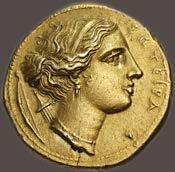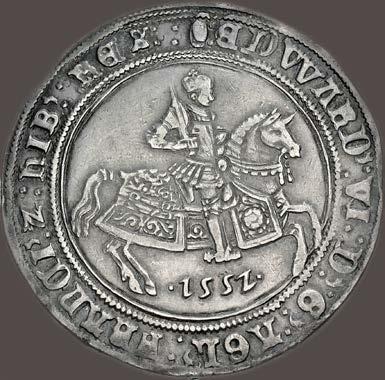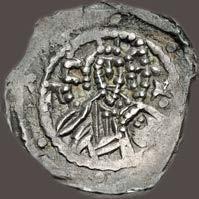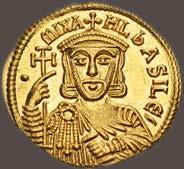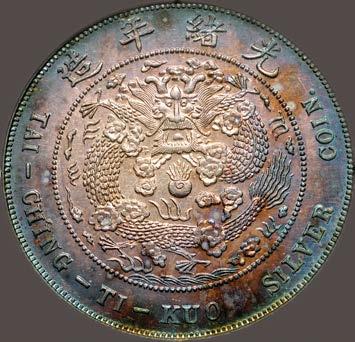September 23-24, 2025
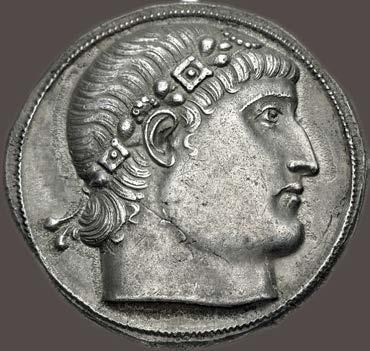
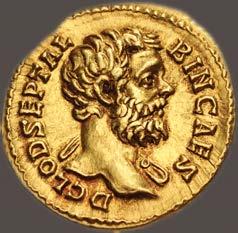
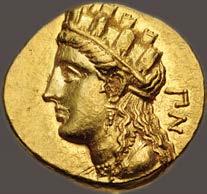

September 23-24, 2025



September 23–24, 2025
To Be Conducted Live Online at the CNG Lancaster Office
Featuring:
Ancient Greek and Roman Coins from the Plus 20 Collection
Coins of the Bar Kochba Revolt from an English Private Collection
Early Republican Aes Grave
The Michael Stolt Collection of Mesopotamian Drachms
Second Known Judaea Devicta Aureus of Vespasian
An Exceptional Clodius Albinus Aureus
Impressive Medallion of Constantine I
Byzantine Coins from the Wayne Scheible Collection
Published Constantine XI Stavraton
Further Selections of World, US, and British Coins from the Alexander Christopher and Drewry Family Collections
Famous 1907 Chinese Pattern AR Yuán – Dollar
A Selection of Italian Coins from the Dr. William Conte Collection
A Further Selection of US Vintage Ingots
Very Rare Anglo-Saxon Gold Thrymsas

Proof Polierte Platte
Mint State/Uncirculated Stempelglanz
Extremely Fine (EF) Vorzüglich
Very Fine (VF)
Sehr Schön
Flan Bruni Fondo Specchio
Fleur de Coin Fior di Conio
Superbe Splendido
Très Beau Bellissimo
Fine Schön Beau Molto Bello
Good/Fair Gut
AD Anno Domini
Bien
Bello
BE Bithynio-Pontic Era IY Indictional Year
Æ Bronze BI Billon MBS Mail Bid Sale
AE Actian Era CE Common Era mm Mintmark
AH Anno Hegirae Cf. Confer (compare) PB Lead
AR Silver c/m Countermark p. Page
AV Gold CY Civic Year (Era) pl. Plate
BBS Buy or Bid Sale EL Electrum RPE Roman Provincial Era
BC Before Christ FPL Fixed Price List RY Regnal Year
BCE Before the Common Era g Gram SE Seleukid Era
See Bibliography on our website, www.cngcoins.com, for a complete list of reference abbreviations.
Beneficiary: Classical Numismatic Group, LLC
US$ Account:
PNC Bank, N.A.
249 Fifth Ave., Pittsburgh PA 15222
Account Number: 5005069595
ABA Number: 031000053
BIC or SWIFT: PNCCUS33
€ Account:
HSBC Bank plc
60 Queen Victoria Street, London EC4N 4TR
Account Number: 84309198
Sort code: 40 12 76
IBAN: GB82HBUK40127684309198
BIC or SWIFT: HBUKGB4B
£ Account:
HSBC Bank plc
60 Queen Victoria Street, London EC4N 4TR
Account Number: 71170910
Sort code: 40 11 60
IBAN: GB45HBUK40116071170910
BIC or SWIFT: HBUKGB4B
Classical Numismatic Group, LLC is a United States limited company. Auction license number AY002406. United Kingdom Registration No. FC035702, Branch No. BR020787.
All lots in this auction were in the possession of CNG in CNG’s Lancaster, Pennsylvania office no later than 25 July 2025. This information is provided for the protection of buyers in the event that US import restrictions are introduced subsequent to that date on any of the types of coins that are included in this auction.
Coins that have been encapsulated (“slabbed”) by a grading and/or authentication service may not be returned for any reason, including authenticity, if they have been removed from the encapsulation (“slab”).
CNG would like to thank Jan Moens (jan.moens@bvdmc.com) for creating and providing the Numismatica Medievalis font used in this sale.
This is a public and Internet auction conducted by Classical Numismatic Group, LLC (CNG). Bidding in the auction constitutes acceptance of the following terms:
1. The property listed in this catalogue is offered for sale by CNG for itself and as agent for various owners and other consignors. We reserve the right to reject any bid, to determine the opening price, to set bidding increments, to vary the order of the auction, to reopen bidding in the case of a dispute, to withdraw any lot, to bid on behalf of CNG, to bid on behalf of the consignor, to permit the auctioneer to bid on his own behalf, and to permit the consignor, where reserves have been agreed, to bid on his own lots. CNG may loan or advance money to consignors or prospective bidders, and may have an interest other than commission charges in any lot. CNG may bid on its own account as an “insider” with information not available to the public.
2. A buyer’s fee will be charged to all successful bidders as follows on the hammer price:
A. 25% for written, fax, email, and telephone bids.
B. 22.5% for floor bids placed in person at the auction and electronic bids placed directly on www.cngcoins.com. All written bids, email bids, nonlive telephone bids, live internet bid registrations, and live telephone bid registrations must be received before 5PM Eastern time on the day before the auction begins. CNG reserves the right to change the format of www. cngcoins.com at any time.
3. All coins are guaranteed genuine. Attribution, date, condition, and other descriptions are the opinion of the cataloguer, and no warranty is expressed or implied. Please note that an auction sale is not an approval sale. Grading is subjective and the opinion of the cataloger. The photographs and videos (when available) of each coin provide additional information for the bidder and supplement the written description found in the catalog. It is the responsibility of the bidder to view photographs and videos and draw their own conclusion as to the quality of the coin they are bidding on. CNG expressly makes no guarantee that our grade and coin descriptions will match those provided by others. No refund will be provided due to grade or “adjectival” comments by a third-party grading service if a coin is submitted for grading after the sale. Any claim of lack of authenticity must be made in writing by the original purchaser immediately after discovery that an item is not authentic, and upon making such a claim the original purchaser must immediately return the lot to CNG in the same condition as at the time of the auction. Any coin returned as “not authentic” which CNG feels is genuine will be submitted to the International Association of Professional Numismatists Authentication Bureau (IBSCC) for final decision of authenticity. No refund shall be made on such coins until the IBSCC makes their determination. This includes coins that have been submitted to a third-party grading service after the auction. Coins that have been previously encapsulated (“slabbed”) by a grading and/or authentication service may not be returned for any reason, including authenticity, if they have been removed from the encapsulation (“slab”). If payment is made by credit card, rights of return are governed by these Auction Terms which supersede any rights of return promulgated by the card issuer. Estimates are intended as a guide only and not as a statement of opinion of value.
4. Invoices are due and payable immediately upon receipt. Interest and late fees of 2.0% per month, or at the highest rate permitted by law, whichever is less, from the date of the auction, shall be payable on invoices not settled within 30 days of the auction date. Payment may be made by check or bank wire. Credit cards (Visa or MasterCard) will be accepted; credit card payments will not be accepted more than 14 days after the sale date. Payment by credit card for printed sale auctions will be charged a 2.5% handling fee. Payment by check must be made in either US dollars ($) drawn on a US bank or British sterling (£) drawn on a British bank. All successful bidders outside North America and the United Kingdom will be charged an additional $20 fee for bank charges that are the result of international wire transfer fees; this fee will be deducted for credit card or check payment as described above. CNG may reduce or compromise any charge or fee at its discretion.
5. Bidders not known to us must provide us with satisfactory credit references or pay a deposit as determined at CNG’s discretion before bidding. Minors are not permitted to bid without written consent of a parent guaranteeing payment. CNG may require payment in full from any bidder prior to delivery of lots. Title does not pass until lots are paid in full. Upon receipt of lots, the buyer assumes full responsibility for loss or damage. Delivery to the buyer’s address of record shall constitute receipt by the buyer regardless of the identity of the person accepting delivery.
6. Estimates are in U.S. dollars ($US) and bids must be in even dollar ($) amounts. CNG will execute mail bids on behalf of mail bidders. Subject to reserves and opening prices, mail bids will be executed at one bidding increment (approximately 10%) over the next highest bid. In the case of identical bids, the earliest bid wins. A mail bid has priority over an identical floor bid. Bid by lot number. No lots will be broken. Bidders are responsible for errors in bidding. Check your bid sheet carefully.
7. All lots are subject to reserve unless otherwise indicated.
8. Bidders personally guarantee payment for their successful bids, including bidders executing commission bids from other parties and bidders representing corporations or other entities. Buyers accepting commission bids from other parties do so at their own risk and remain responsible for payment under these Auction Terms.
9. At the conclusion of bidding for each lot, the sale contract is concluded and the successful bidder becomes liable for immediate payment under these Auction Terms. In the event a successful bidder fails to make full payment within 30 days of the auction date, CNG reserves the right either: (a) to require payment as provided under these Auction Terms; or (b) to deem the sale incomplete and to re-auction the material, in which case the successful bidder agrees to pay for the reasonable cost of such a sale and also to pay any shortfall between the re-auction price and the successful bidder’s purchase price. CNG reserves all rights that it is entitled to under the Pennsylvania Uniform Commercial Code, including the right to offset any sums due from a successful bidder against any future consignment or purchase or monies or goods in possession of CNG.
10. Sales tax, postage, handling and insurance are the responsibility of the buyer and are added to all invoices where appropriate. For buyers in the United Kingdom, CNG may import lots into the United Kingdom prior to shipment and charge buyers the import Value Added Tax. On any tax not paid by the purchaser which should have been paid, even if not invoiced by CNG, the purchaser agrees to pay the same on demand together with any interest or penalty that may be assessed. It is the responsibility of the buyer to comply with foreign customs and other regulations.
11. Prices realized are published after the sale and are mailed with CNG’s next publication. Prices realized are also posted after the sale on CNG’s web site: www.cngcoins.com
12. Bidders hereby waive any claim for incidental, consequential or exemplary damages arising from this auction. The sole remedy that any participant in the auction shall have for any claim or controversy arising out of the auction shall be a refund, without interest, of all or part of the purchase price paid by the participant.
13. All rights granted by CNG or otherwise available to bidders and purchasers, under these Auction Terms or otherwise, are personal and may not be assigned or transferred to any other person or entity, whether by operation of law or otherwise. No third party may rely on any benefit or right conferred by these Auction Terms. Bidders acting as agents must disclose the agency in writing to CNG prior to the auction; otherwise rights are limited to the agent and are not transferable to the undisclosed principal.
14. Any dispute regarding this auction shall be governed by the laws of Pennsylvania and shall be adjudicated only by the Lancaster County Court of Common Pleas or the U.S. District Court for the Eastern District of Pennsylvania; all bidders submit themselves to the personal jurisdiction of these courts for this purpose, consent to service of process by registered or certified mail, and waive any contrary provisions of Articles 14 or 15 of the French Civil Code and any similar provisions in any jurisdiction. All bidders consent to the confidentiality of consignors’ identities and waive any right to require disclosure of the name of the consignor or owner of any auction lot, whether such right is based on New York GOL §5-701(a) or any other provision in any jurisdiction. In any dispute regarding this auction, the prevailing party shall be entitled to recover its reasonable costs and attorney fees.

Managing Director

Consulting Director


Steve Lloyd Numismatist Islamic Specialist

Manager Shows & Consignments

Consignments




Manager IT & Production


Consignments


Consignments
Consignments


Lance
Managing Numismatist Consignment Staff

Julian
Numismatist Consignments



Numismatist Consignments British & World Coinage















IT
Jeffrey B. Rill Auctioneer PA License No. AU006206
Brian
Auctioneer PA License No. AU005870
With the CNG Bidding Portal, you can:
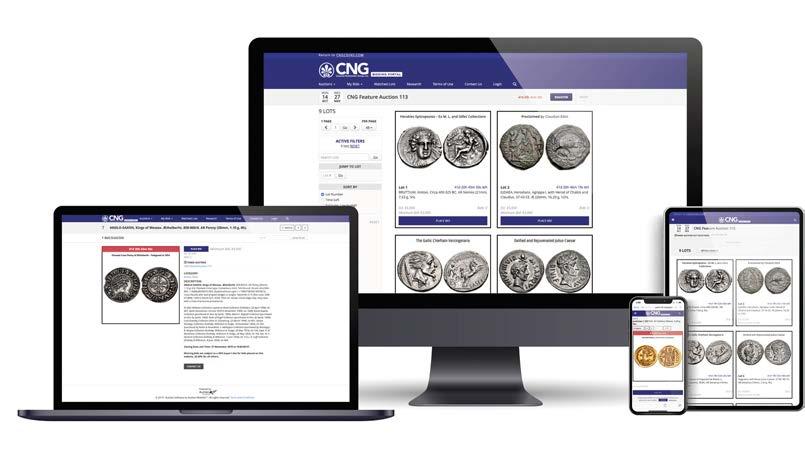
• Log on and bid at any time at auctions.cngcoins.com
• View the lots, follow the bidding, and see hammer prices as they are sold
• Hear and see the auctioneer live
• Enjoy all the advantages of an auction room bidder to win your favorite lots
To bid live in this Feature auction:
• Visit our new Bidding Portal before the auction at auctions.cngcoins.com
• Register online with your email address and a password
• Once approved, you may place pre-bids up until the moment the lot opens in the auction room
• On the auction day, login to join the auction and participate live
Please Note
• If you have not already registered for our bidding platform, you must create a new registration at auctions.cngcoins.com/register. Your old cngcoins.com handle and password will not allow you to log on or bid.
• You must register to bid before 5PM EST on Monday, September 22, 2025
• All lots won through the CNG Bidding Portal will be subject to a 22.5% buyer’s fee






Lancaster, PA
Auction lots may be viewed at our Lancaster Office from August 18 – September 22, 2025, by appointment only Lancaster Office Hours: 10 AM - 5 PM (Monday - Friday).
Enlargements of all single lots and selected multiple lots may be viewed on the internet at

We are sorry, but photographs of individual coins in multiple lots cannot be provided.
This sale will be conducted live online from our Lancaster, PA Office
Lots will be mailed from our Lancaster, PA office subsequent to the sale
Session One – Tuesday Morning – September 23 – 9:00 AM
Session Two – Tuesday Afternoon – September 23 – 2:00 PM
Session Three – Wednesday Morning – September 24 – 9:00 AM
Session 1 – Tuesday, September 23, 2025 — 9 AM
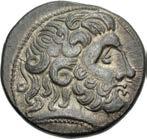


1. EASTERN EUROPE, Imitations of Philip II of Macedon. Early 2nd century BC. AR Tetradrachm (24mm, 11.47 g, 11h). ‘Zweigarm’ type. Mint in the Carpathian region. Head of Zeus Ammon right / Rider on horseback left, holding branch (or palm frond); wheel to left. OTA 291/1; Lanz 584; KMW 1207; CCCBM I 26. Deep cabinet toning with hints of iridescence. Good VF. ($750)

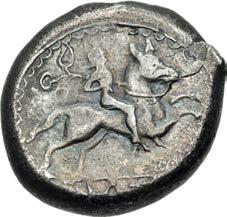

2. CENTRAL EUROPE, Boii. Biatec. Mid-late 1st century BC. AR Hexadrachm (23mm, 16.43 g, 4h). Bare male head right within scalloped border / Rider, holding branch, on griffin galloping right; below; all within scalloped border. Göbl, Hex. II/4; Paulsen 713; Lanz 71; KMW 607. Toned with hints of iridescence, flan crack, off center. Near VF. ($1500)
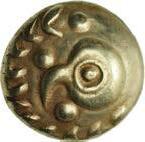



3. CENTRAL EUROPE, Vindelici. Early 1st century BC. AV Stater (16mm, 7.32 g, 4h). ‘Vogelkopf’ type. Head of bird left; pellet above and below beak; all within wreath-like torc / Four pellets within torc. Kellner Type II –; KMW –; Flesche –; CNG 129, lot 13 (same dies, hammer $2750). Toned with red deposits on reverse. Near EF. Very rare variety. ($1000)



4. GAUL, Northwest. Aulerci Cenomani. 2nd century BC. AV Stater (20mm, 7.27 g, 6h). Celticized head of Apollo left, [dolphin swimming downward before] / Celticized biga left, charioteer devolved into creature above, horse with human head; ‘vexillum’ to right; below, fallen male right, holding spear and dagger(?). Depeyrot, NC VIII, 82; D&T 2153 (Aulerci Diablintes). Lightly toned, edge splits, small flan crack. VF. ($750)
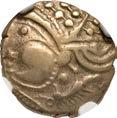
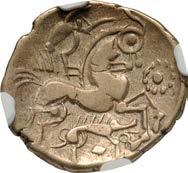

5. GAUL, Northwest. Aulerci Eburovices. 3rd century BC. AV Half Stater (17mm, 3.19 g, 11h). Celticized male head left, wearing diadem; inverted boar below / Celticized biga galloping right; birdlike charioteer above; to right, pellet in annulet; below, boar standing right. Scheers, Eburovices, Series Id, Class II, 34; Depeyrot, NC V, 136; D&T 2401. In NGC encapsulation 5872295-003, graded XF, Strike: 5/5, Surface: 4/5. ($500)

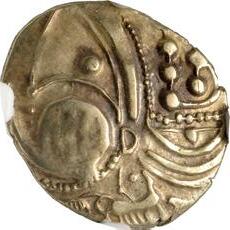
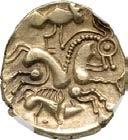
6. GAUL, Northwest. Aulerci Eburovices 3rd century BC. AV Half Stater (19mm, 3.30 g, 3h). Celticized male head left, wearing diadem; inverted boar below / Celticized biga galloping right; birdlike charioteer above; below, boar standing right. Scheers, Eburovices, Series Id, Class II, 34; Depeyrot, NC V, 136; D&T 2404. Lightly toned. In NGC encapsulation 5872295-011, graded Ch XF, Strike: 4/5, Surface: 4/5. ($500)
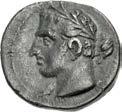


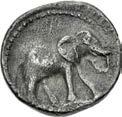
7. IBERIA, Punic Iberia. Circa 237-209 BC. AR Quarter Shekel (14mm, 1.65 g, 12h). Laureate male head left; club over far shoulder / Elephant advancing right. MHC 46–50 var. (O31/R– [unlisted rev. die]); ACIP 555. Find patina, slight roughness. VF. ($500)
Ex Wild Rose Collection (Classical Numismatic Group Electronic Auction 563, 5 June 2024), lot 5; G. Hirsch 165 (14 February 1990), lot 566.



8. IBERIA, Punic Iberia. Circa 237-209 BC. AR Shekel (21mm, 7.28 g, 1h). Bare head of male left / Horse standing right; palm tree in background. MHC – (dies 88/121 [unlisted die combination]); ACIP 603; SNG BM Spain 104–5; CNG 102, lot 1 (same rev. die). In NGC encapsulation 6559216-002, graded XF, Strike: 5/5, Surface: 2/5, edge chip. ($1000)
Ex Goldberg 133 (31 January 2023), lot 2153; David Karpeles Collection; Classical Numismatic Group 63 (21 May 2003), lot 33.
The male head on the obverse of this shekel type has variously been described as Melkart, an important Phoenician deity incorporating traits of the Greek demigod Herakles, or a portrait of the great Barcid general Hannibal. The type was introduced circa 237 BC, when Hannibal’s father Hamilcar commenced his conquest of the Iberian peninsula. An alternate portrait type depicts an older, bearded male head carrying a club over the far shoulder. E.S.G. Robinson, in Essays Mattingly, proposed that the bearded head represented Hamilcar in the guise of a Melkart, while the younger, beardless portrait was a similarly disguised portrait of Hannibal. The modern consensus tends to reject these attributions as speculative and conclude that the heads are simply mature and youthful images of Melkart.

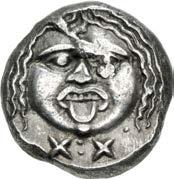

9. ETRURIA, Populonia. 3rd century BC. AR 20 Asses (19mm, 8.20 g). Diademed facing head of Metus; c / ≈ (mark of value) below / Blank. EC Group XII, Series 52.1–233 (O20); HN Italy 152; SNG ANS 77 (same dies); SNG Copenhagen 1 (same die). Old collection tone, minor scratches, die break on obverse (diagnostic for die). Near EF. ($750)
Ex Roma XVIII (29 September 2019), lot 470; Swiss Etruscologist Collection (Roma XVI, 26 September 2018), lot 35.
Like the Romans, the Etruscans of northern and central Italy were latecomers to the Greek concept of coinage. The origins of the Etruscans are still regarded as enigmatic, and their language survives only in the form of relatively short inscriptions. When they did begin striking coins in the mid 4th century BC, many of the distinct and whimsical qualities of their culture came through. Only five Etruscan cities struck coins in any quantities, with Fufluna, called Populonia by the Romans, by far the most prolific.
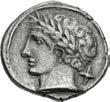


10. ETRURIA, Populonia. Circa 300-250 BC. AR 10 Asses (18mm, 3.11 g). Laureate head of Aplu left; c (mark of value) behind neck / Blank. EC Group XVI, Series 70.116 (O1 – this coin, illustrated); HN Italy 168; SNG ANS 26; SNG Copenhagen 38; SNG Lloyd 23 = Locker Lampson 2 = Weber 65; Bement 22; Dewing 74 = SNG Lockett 45; McClean 137 (all from the same die). Lightly toned, slight roughness, edge marks. VF. ($500)
Ex NAC Spring Sale 2020 (25 May 2020), lot 5 (conserved since); Swiss Etruscologist Collection (Roma XVI, 26 September 2018), lot 50; NAC R (17 May 2007), lot 1001.

11.
Cales. Circa 265-240
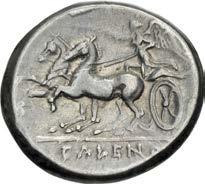
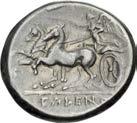
AR Nomos (22mm, 7.25 g, 6h). Helmeted head of Athena left / Nike, holding kentron and reins, driving fast biga left. Sambon 889; HN Italy 434. Lightly toned, traces of find patina, die rust, a few faint scratches. VF. ($750)
From the Doctore Collection.
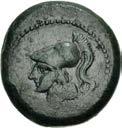


From the Kelly Ramage Collection. Reportedly ex S. Weintraub Collection.

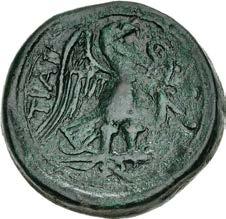
13. APULIA, Teate. Circa 225-200 BC. Æ Nummus (36mm, 37.69 g, 10h). Wreathed head of Zeus Dodona right / Eagle standing right on thunderbolt; @ to right. HN Italy 703; Weber 474. Dark green-brown patina, light roughness. VF. ($500)
From the Plus 20 Collection. Ex Artemide LIX (6 May 2023), lot 69 (hammer €1500); Münzen und Medaillen AG 76 (19 September 1991), lot 27.


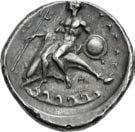
14. CALABRIA, Tarentum. Circa 344-340 BC. AR Nomos (22mm, 7.70 g, 12h). Warrior, wearing helmet, holding spear and shield, standing facing, head right, behind horse standing right; ^ to right / Phalanthos, holding trident and shield, on dolphin left; below, Å above waves. Fischer-Bossert Group 48, 678h (V259/R525 – this coin); Vlasto 516–7 (same dies); HN Italy 889; SNG ANS 963 (same dies); Pozzi (Boutin) 336-7 (same obv. die). Deep old cabinet tone, minor earthen deposits, slightly off center. VF. ($750)
Ex Maddalena Collection (Sambon & Canessa, 7 May 1903), lot 257.


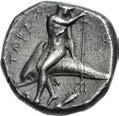
15. CALABRIA, Tarentum. Circa 340-335 BC. AR Nomos (20mm, 7.56 g, 10h). Horseman riding left, leading second horse in background; [˚ to left]; to right, Nike flying left, crowning horseman; f5 below / Phalanthos riding dolphin left, turning his torso back, attempting to spear tunny below with trident; ˚ to right, waves below. Fischer-Bossert Group 52, 708e (V265/R552) = Vlasto 402 (this coin); HN Italy 896; BMC 185 (same obv. die). Deep old cabinet tone, compact flan, slightly off center on obverse, edge mark. VF. ($1000)
Ex Peh Family Collection (Goldberg 136, 5 September 2023), lot 138 (hammer $2900); Goldberg 63 (31 May 2011), lot 2407; Michel Pandely Vlasto (†1936) Collection; Sir Hermann Weber Collection (not in published collection).
The city of Tarentum was founded in the late 8th century BC by Spartan colonists on the north coast of the gulf of the same name, on a rocky islet at the entrance to the only secure harbor. It was Sparta’s only colony and maintained close relations with its mother city. The official founder of the city was believed to be the Spartan leader Phalanthos. Ancient tradition, however, tells how Taras, the son of Poseidon and a local nymph, Satyra, was miraculously saved from a shipwreck by his father, who sent a dolphin on whose back he was carried to shore, at which spot he founded a city.
Blessed with fertile land, Tarentum became famous for olives and sheep. It possessed a fine harbor, great fisheries and profitable exports of wool, purple dye, and pottery. It adopted a democratic form of government circa 475 BC, and thereafter became the leading Greek city in southern Italy. Its success led to continual difficulties with its neighbor cities, though, and on four occasions Tarentum required expeditions from Greece to help overcome its aggressors. The last of these expeditions was led by the famed Epeirote, Pyrrhos. Following his withdrawal from the city, Tarentum was occupied by the Romans.
It was not until late in the 6th century that Tarentum felt the need to produce coinage. It did so by copying the broad, thin fabric with incuse reverse type already in use by Metapontum, Sybaris, Poseidonia, Kaulonia, and Kroton. Tarentum quickly grew in power and wealth. As with many cities that began coinage at the time, the types depicted relate to the city’s foundation, both in its historical and mythological forms. Taras’ prosperity is exemplified by its vast coinage, which was continuous from circa 510 BC until the end of the Second Punic War.

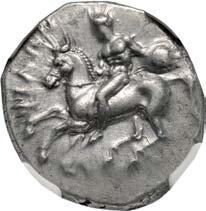
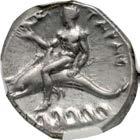
16. CALABRIA, Tarentum. Circa 280 BC. AR Nomos (19.5mm, 7.83 g, 7h). Youth, holding shield, on horse rearing left; Y5¬W@ (sic) to left, EU below / Phalanthos, holding Nike, who crowns him with wreath, riding dolphin left; waves below. Vlasto 683 (same obv. die); HN Italy 964. In NGC encapsulation 6625605-061, graded AU, Strike: 4/5, Surface: 5/5. ($500)
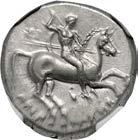


17. CALABRIA, Tarentum. Circa 280 BC. AR Nomos (20mm, 7.91 g, 12h). Warrior, holding two spears and shield, raising third spear overhead, on horse rearing right; s5 to left, dE5@o˚rÅt˙s below / Phalanthos, holding small dolphin, riding dolphin left. Vlasto 692–3; HN Italy 967. In NGC encapsulation 6625608-089, graded AU, Strike: 4/5, Surface: 4/5. ($500)
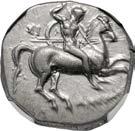
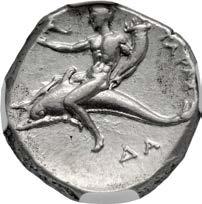

18. CALABRIA, Tarentum. Circa 280 BC. AR Nomos (20mm, 7.88 g, 8h). Warrior, holding two spears and shield, raising third spear overhead, on horse rearing right; s5 behind, dÅ˚5Âos below / Phalanthos, holding dolphin and cornucopia, riding dolphin left; dÅ below. Vlasto 696 corr. (letters on rev.); HN Italy 967. In NGC encapsulation 6625603-030, graded AU, Strike: 5/5, Surface: 4/5. ($500)




19. CALABRIA, Tarentum. Circa 240-228 BC. AR Nomos (21mm, 6.43 g, 2h). Reduced standard. Nude youth, holding filleted palm frond, on horse leaping right; 1 to left, År51t5ππ[o1] below / Phalanthos, holding kantharos, on dolphin left; N to right. Vlasto 947–8; HN Italy 1056. Irridescent tone, slightly off center. Good VF. ($750)
Ex Ealing Collection (Classical Numismatic Group 111, 29 May 2019), lot 11, purchased from Chris Martin, February 1996.

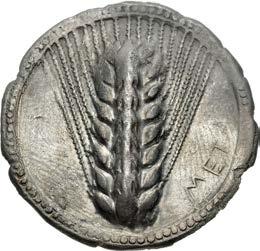

20. LUCANIA, Metapontion. Circa 540-510 BC. AR Nomos (28.5mm, 6.85 g, 12h). Ear of barley with eight grains / Incuse ear of barley with nine grains. Noe Class VI, 127 (same dies); Gorini 12; HN Italy 1479; SNG Ashmolean 652 (same dies); SNG Fitzwilliam 169 (same dies). Toned, area of light cleaning scratches on obverse, small mark on reverse. Near EF. ($1000)
Ex Ealing Collection (Classical Numismatic Group 111, 29 May 2019), lot 21, purchased from Chris Martin, February 1996.
Metapontion, originally named Sybaris, was an Achaian colony of very early foundation, though the precise details of its origin are shrouded in uncertainty. Following the destruction of its first foundation by the Samnites, it was refounded as Metapontion, early in the 7th century BC by settlers under the leadership of Leukippos, who was thereafter revered as the city founder. The great prosperity of the city — attested by the extent of its archaic silver coinage commencing in the mid 6th century BC — was based on agriculture. Situated on the Gulf of Tarentum, Metapontion occupied a plain of extraordinary fertility watered by the rivers Bradanos and Kasuentos. Its standard coin type is an ear of barley, a tribute to the source of Metapontine wealth.

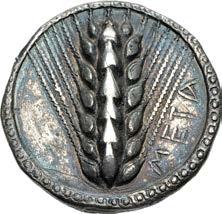
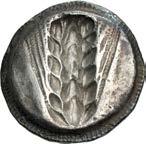
21. LUCANIA, Metapontion. Circa 510-470 BC. AR Nomos (24mm, 7.92 g, 12h). Ear of barley with seven grains / Incuse ear of barley with six grains. Noe Class IX, 182 (same dies); HN Italy 1482; SNG Ashmolean 656 (same dies). Iridescent tone, light cleaning scratches, minor edge marks. Good VF. ($750)
Ex Ealing Collection (Classical Numismatic Group 111, 29 May 2019), lot 21, purchased from Sidney Mygind, February 1998.
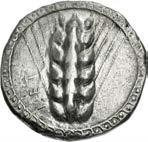


22. LUCANIA, Metapontion. Circa 510-470 BC. AR Nomos (24mm, 7.98 g, 12h). Ear of barley with six grains / Incuse ear of barley with six grains. Noe Class IX, 199 (same dies); HN Italy 1482. Lightly toned, a hint of granularity, hairlines. Good VF. ($750)
Purchased by the consignor from Pegasi Numismatics, 2010.
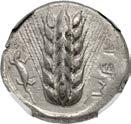
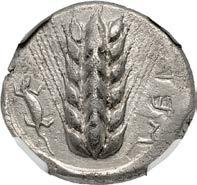
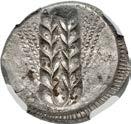
23. LUCANIA, Metapontion. Circa 510-470 BC. AR Nomos (21mm, 7.24 g, 12h). Ear of barley with six grains; lizard to left / Incuse ear of barley with six grains. Noe Class X, 219 var. (7 grain ear on obv.); HN Italy 1482. In NGC encapsulation 5745586-011, graded AU, Strike: 5/5, Surface: 3/5. ($750)
From the Deer Creek Collection. Ex Heritage 3085 (5 August 2020), lot 31007.

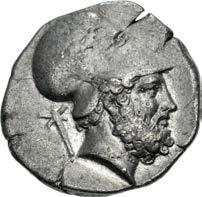

24. LUCANIA, Metapontion. Circa 340-330 BC. AR Nomos (21.5mm, 7.65 g, 7h). Helmeted and bearded head of Leukippos right; cross-torch to left / Barley ear with leaf to right; ^˙ above leaf. Johnston Class A, 5.3 (same dies); HN Italy 1555; SNG ANS 405–6 (same dies); SNG München 986 (same dies). Toned, edge splits, trace deposits, overstruck on uncertain type. Good VF. ($500)
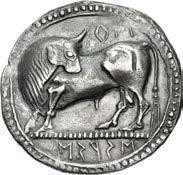


25. LUCANIA, Siris and Pyxous. Circa 540-510 BC. AR Nomos (28mm, 7.34 g, 12h). Bull standing left, head right; ø;-Nßrß; below and above / Incuse bull standing right, head left; c¨P in exergue. Mangieri, Sibari, Group A, 1 (same dies); Gorini 1 (same dies); HN Italy 1723; Basel 165 (same dies). Lightly toned, traces of find patina, crystallized, repaired. Near EF. Lovely archaic style. Very rare. ($7500)
Ex Numismatica Ars Classica 120 (6 October 2020), lot 227 (hammer 28,000 CHF).
Superficially resembling an incuse nomos of Lucanian Sybaris, this extremely rare issue is enigmatically inscribed with two different ethnics on opposing sides, both of them retrograde and in an archaic Italic script. Transliterated, the obverse exergual inscription reads “Sirinos” (“of the Sirinions?”) while the reverse simply reads “Pyx;” a few other examples have an expanded form of the reverse legend reading “Pyxoite.” Silver one-third nomoi, or drachms, are also known with these types and inscriptions. There is evidence cities with these or similar names existed in Lucania in the sixth-to-fifth centuries BC, though no archeological sites have been positively identified and the historical record is murky and problematic at best. “Pyx” may refer to the coastal town on top of the Italian “foot” originally called Pyxous or Pixous and now known as Policastro Bussentino, but historical accounts place its founding in 471 BC, decades following the destruction of Sybaris in 510 BC and well after the incuse coin fabric fell out of use. A town named Siris was reputedly located on the underside of the boot at the mouth of River Siris (now Sinni), but it was supposedly destroyed by an alliance of Metapontum, Kroton and Sybaris (!) circa 550 BC; it was never re-founded and no remains have ever been located. Neither possible site is particularly close to Sybaris, with Pyxous and Siris on opposing sides of the Italian peninsula, but a roughly equilateral triangle can be drawn linking the three cities. Coins having different civic names on opposite sides are usually described as “alliance issues,” although the nature of such alliances and the reasons for their striking are poorly understood. Such alliance issues on the incuse fabric were also struck for Sybaris and Pandosia, and for Kroton and Temesa. With this rare issue as evidence, it is plausible, if speculative, to suggest that the historical record on their founding and demise is faulty, and that the Lucanian cities of Pyxous and Siris, in the later sixth century BC, agreed to a military or trade alliance with Sybaris, and struck this type as a token of the agreement, with the bull of Sybaris standing in for a spelled-out ethnic.

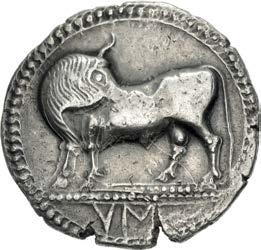
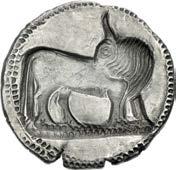
26. LUCANIA, Sybaris. Circa 550-510 BC. AR Nomos (28.5mm, 7.97 g, 12h). Bull standing left, head right / Incuse bull standing right, head left. S&S Class B, pl. 48, 4–8; Gorini 2; HN Italy 1729. Lightly toned. VF. Good metal. Choice for issue. ($750)
Ex CNG inventory 446612 (January 2017); Roma XII (29 September 2016), lot 32. Sybaris, located on the bottom of the Italian boot, was founded circa 720 BC and quickly amassed great wealth due to its fertile fields and active port. Descriptions of the city’s sumptuous festivals and luxurious dwellings abound in ancient literature, and “Sybarite” became a synonym for any lover of luxury and pleasure. The silver coinage of Sybaris follows the remarkable relief / incuse pattern employed by other cities of Greek southern Italy in the sixth and early fifth centuries BC, which required careful flan preparation and precise alignment of dies. The bull of Sybaris, with its reverted head, exerted a powerful influence on modern artists, including Picasso.
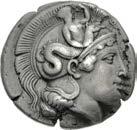
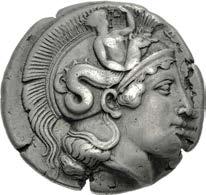

27. LUCANIA, Thourioi. Circa 400-350 BC. AR Nomos (22mm, 7.81 g, 4h). Head of Athena right, wearing helmet decorated with Skylla scanning; f above visor / Bull butting right; in exergue, fish right. HN Italy 1782; SNG ANS –; SNG Ashmolean –; SNG Lloyd –; SNG München –. Toned, minor doubling, slightly off center, a couple of light scratches on obverse. Good VF. Fine style. Very rare variety as a nomos, none in CoinArchives. ($1500)
Ex Edward J. Waddell inventory 51801; Athos and Dina Moretti Collection (Numismatica Ars Classica O, 13 May 2004), lot 1157.
In 446 BC, with the aid of Athens, the refugee population of the destroyed city of Sybaris returned to the location of their previous home, and founded a new city, giving it the name Thourioi. The new city quickly regained the prosperity enjoyed by its former incarnation, as evidenced by the extensive series of coins it issued over the following two centuries. Although its perennial rival had been Kroton, the new city grew close to its former enemy, and Tarentum as well. Good relations with the latter were probably responsible for the weakening of Thourioi’s historical connection to Athens, and she turned to Sparta during the Peloponnesian War. Although supported by Tarentum, the city suffered at the hands of the Lucanians and Brettians during the 4th century. In need of a more robust ally, the Thourians turned to Rome in 285 BC. Unlike many cities in southern Italy, Thourioi’s support of Rome was steadfast during both the time of Pyrrhos and Hannibal’s invasion, even though the Thourians suffered heavily at the hands of the latter. The coinage of Thourioi was diverse in both its denominations and metals. The primary types were the head of Athena, probably due to the city’s initial close relationship with Athens, and a standing or butting bull, which had been the civic type on the coins of Sybaris.


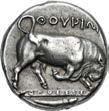
28. LUCANIA, Thourioi. Circa 400-350 BC. AR Nomos (18.5mm, 8.01 g, 2h). Head of Athena right, wearing crested Attic helmet decorated with Skylla scanning and M on neck guard / Bull butting right on thick exergual line inscribed µo¬ossos; in exergue, fish right. HN Italy 1784; SNG ANS 1027 corr. (letter on obv. not noted; same obv. die); Woodward 33 (this coin). Old cabinet tone, compact flan. Good VF. ($2000)
Ex Spink 46 (9 October 1985), lot 16; Sotheby (22 April 1970), lot 27; William Harrison Woodward Collection (Ars Classica XV, 2 July 1930), lot 202; Paul Mathey Collection (Feuardent Frères, 9 June 1913), lot 46.

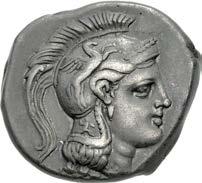
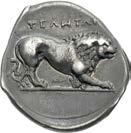
29. LUCANIA, Velia. Circa 300-280 BC. AR Nomos (22mm, 7.46 g, 11h). Transitional to Philistion group. Head of Athena right, wearing crested Attic helmet decorated with griffin; running figure on neck guard / Lion standing right; erasure mark below. Williams Period VII, 394 (O197/R278); HN Italy 1301; SNG ANS 1397; SNG Ashmolean 1392; McClean 1470 (all from the same dies). Old collection tone. VF. ($750)
Ex Classical Numismatic Group Electronic Auction 417 (28 March 2018), lot 11; Seaby Coin & Medal Bulletin 818 (March 1987), no. B34. Velia, situated on the Tyrrhenian coast of southern Italy south of Poseidonia, was founded circa 540 BC by colonists from Phokaia in western Asia Minor who had fled their homeland following the Persian conquest. Its coinage commenced soon after the city’s foundation and its types (forepart of lion devouring prey/incuse square) and denomination (Phokaian silver drachm) reflect the Asian origin of the early citizenry of Velia. Later, in the 5th century, the weight standard of the Velian coinage was assimilated to that of the Achaean cities of Magna Graecia producing a nomos of about 8 grams. The type of a lion, or a lion attacking its prey, remained popular at Velia throughout the two and a half centuries of its silver coinage, which ceased just prior to the city’s alliance with Rome negotiated circa 275 BC.

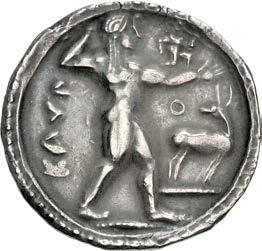

30. BRUTTIUM, Kaulonia. Circa 525-500 BC. AR Nomos (28.5mm, 7.69 g, 12h). Apollo advancing right, holding branch, small daimon running right on extended arm; to right, o above stag standing right, head reverted / Incuse of Apollo and stag, but stag’s antlers and o in linear outline, and no daimon. Noe, Caulonia, Group B, 27 (same obv. die); HN Italy 2036; Boston MFA 170 = Warren 136 (same obv. die). Toned, struck with worn obverse die, double struck and minor marks on reverse. VF. ($2000)
Ex Warden Numismatics inventory 4120J45016L55; Kirk Davis FPL 69 (Spring 2017), no. 4.
Kaulonia was founded in the 7th century BC by Achaean Greeks. The location, on the underside of Italy’s “toe,” has long since disappeared beneath the waves, but marine archaeologists have located more than 100 fluted columns, likely for a large shrine to Apollo, the deity depicted on the city’s beautiful coinage. On this exceptional piece, Apollo’s nude body is shown striding right, with a small winged daimon on his left arm; to his right stands a stag, sacred to both Apollo and his sister Artemis. The unusual fabric of this piece follows a style peculiar to Greek southern Italy in the archaic period: a broad, thin flan, obverse depicted in relief, the reverse repeating the obverse motif but incuse, and reversed. The reasons for the popularity of this fabric are poorly understood; some scholars have postulated a connection to the mathematician-philosopher Pythagoras, who was active in Italy during this period.
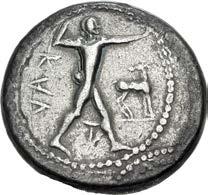

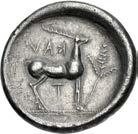
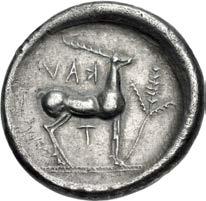
31. BRUTTIUM, Kaulonia. Circa 450s BC. Fourrée(?) Nomos (23mm, 8.45 g, 1h). Contemporary imitation. Apollo advancing right, holding [branch]; to right, stag standing right, head reverted; t between legs / Stag standing right; branch to right, t below. Noe, Caulonia P8 = Bement 26v8 (this coin, illustrated in both); cf. HN Italy 2046 (for prototype). Old cabinet tone, slight die shift, minor marks, edge scuffs and marks, die irregularity on obverse. VF. Extremely rare. ($1000)
Ex Ars Classica XVI (3 July 1933), lot 316; Clarence S. Bement Collection (Naville VI, 28 January 1923), lot 268.
In his study of the coinage of Kaulonia, Noe listed this issue under Plated Coins, but there does not appear to be any indication of this coin being a fourrée. Nonetheless, the general style, lack of the daimon on the obverse, and the additional control letters in the fields, as noted by Noe (p. 19), set this issue apart from the official coins struck at the mint. He also notes that this coin may prove to be of modern origin, but a close inspection of the coin strongly suggests this is not the case.
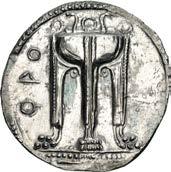
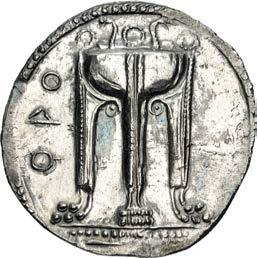
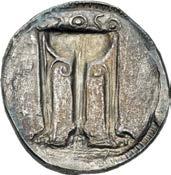
32. BRUTTIUM, Kroton. Circa 530-500 BC. AR Nomos (28mm, 8.94 g, 12h). Tripod, legs surmounted by wreaths and terminating in lion’s feet, two serpents rising from the bowl, set on basis of three lines, the center dotted / Incuse tripod as obverse. Attianese 5; HN Italy 2075. Iridescent tone, reflective surfaces on obverse, minor die flaws. EF. ($1000)
Ex CNG inventory 510507 (April 2019; conserved since); Roma E-Live 4 (29 November 2018), lot 49.
As with many cities in Magna Graecia, Kroton was established by colonists from mainland Greece. Myskellos, obeying a directive of the oracle of Delphi, led a group of Achaian settlers to the site and founded the city around 710 BC. This divine sanction is represented by the tripod of the oracle, which became the civic badge of Kroton and is featured on its coinage. Kroton was among the first cities to produce coinage in Italy, its earliest being of the incuse type struck on the Achaian standard. As evidenced by its bountiful coinage, Kroton was one of the most important and wealthy cities of southern Italy. Although its fortunes rose and fell over the centuries, it maintained its production of a wide array of denominations and metals until the Roman period.
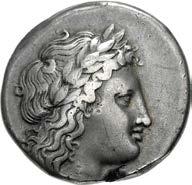
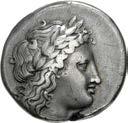


33. BRUTTIUM, Kroton. Circa 400-325 BC. AR Nomos (21mm, 7.30 g, 9h). Laureate head of Apollo right / Tripod with high neck surmounted by wreaths, legs terminating in lion’s feet; filleted laurel branch to right. Attianese 144 var. (orientation of ethnic); HN Italy 2177. Old cabinet tone, scratch on obverse, light scuff on reverse, some filing on edge. VF. ($1000)
Ex Frankfurter Münzhandlung 157 (3 November 2023), lot 44; Naville V (18 June 1923), lot 720.




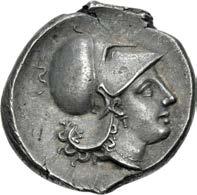
34. BRUTTIUM, Lokroi Epizephyrioi. Circa 344-318 BC. AR Nomos (20.5mm, 8.44 g, 4h). Time of Timoleon. Pegasos flying left; ¬o below / Helmeted head of Athena right; Â or s on neck guard. Spinelli Group I, 1b, 64 (same dies); Pegasi 8 corr. (no ethnic [belongs on Pegasi 7]); HN Italy 2338; SNG Fitzwilliam 818 (same dies). Old collection tone, with some iridescence around the devices. Near EF. ($1000)
Ex Diez and Martini Collections – Pedigreed to 1908

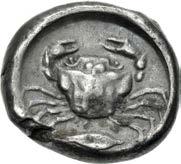

35. SICILY, Akragas. Circa 480/78-470 BC. AR Didrachm (19mm, 8.57 g, 10h). Sea eagle standing left / Crab; barley grain below; all within incuse circle. Westermark, Coinage, Period I, Group IV, 266 (O88/R181); HGC 2, 99; SNG Copenhagen 40 (same dies). Old cabinet tone, trace deposits. Good VF. ($750)
From the Kelly Ramage Collection. Ex Robert and Julius Diez Collection (Classical Numismatic Group Electronic Auction 294, 16 January 2013), lot 29; Ad. Martini Collection (R. Kube [3], 16 March 1908), lot 3227.
Akragas, Roman Agrigentum, was situated close to the southern coastline of Sicily midway between Gela and Selinos. Founded by colonists from Gela circa 580 BC, Akragas grew to become the second most important city on the island after Syracuse, deriving much of its wealth from the export of agricultural produce to Carthage, which lay about 200 miles to the west. Its coinage commenced in the closing years of the 6th century and principally consisted of silver didrachms down to about 440 BC, after which the tetradrachm became the principal denomination. The first series of tetradrachms, though, coincided with the last period of didrachms, with all featuring the same types that had persisted since the beginning of the city’s coinage: on the obverse, an eagle, sacred to Olympian Zeus, to whom the city dedicated an immense temple, and a reverse with an overhead view of a crab, harvested from the sea as a delicacy in the region. After 440 BC, as with many of the coinages of the great Sicilian cities, the designs became more complex and artistic, with one or two eagles shown devouring a hare on the obverse, and a galloping quadriga ultimately replacing the crab on the reverse. In the final decade of the 5th century, as the artistry of it coinage reached its zenith, Akragas suffered the same fate as many of the other Greek cities of Sicily when it was stormed and sacked by the invading Carthaginians (406 BC). Though its coinage continued thereafter, the scale and beauty of its 5th century series were never attained again.




36. SICILY, Akragas. Circa 465/0–445/0 BC. AR Tetradrachm (25.5mm, 17.44 g, 4h). Sea eagle standing left / Crab within shallow incuse circle. Westermark, Coinage, Period II, Group I, 337 (O8/R27); HGC 2, 94; SNG Ashmolean 1670 (same dies); SNG Fitzwilliam 893 (same dies); SNG Lloyd 800 (same dies); Gulbenkian 158 (same dies). Toned, a few minor die breaks and tiny flan flaws. Near EF. ($2000)
Ex Gerald F. Borrmann (Northern California Gentleman) Collection, purchased from Dr. Arnold Saslow, March 1985.



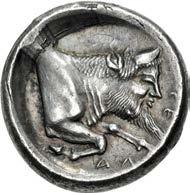
37. SICILY, Gela. Circa 490/85-480/75 BC. AR Didrachm (21mm, 8.54 g, 7h). Warrior, nude but for helmet, riding right, preparing to cast javelin / Forepart of man-headed bull right within incuse circle. Jenkins, Gela, Group Ib, 20.37 (O7/R8” – this coin); HGC 2, 363. Iridescent tone, minor double strike on obverse, a little off center on reverse. Near EF. ($2000)
Purchased by the consignor from Shanna Schmidt. Ex Graeculus Collection (Peus 427, 4 November 2020), lot 107; Kricheldorf IX (12 June 1961), lot 164.
Situated on the Gela river on the southern coast of Sicily, Gela was founded in 688 BC by Cretans and Rhodians. Although the city had a Creto-Rhodian foundation, the name of the river is of local Sikanian origin, meaning very cold, as the water runs from the Heraei mountains to the north. Its coinage is among the earliest in Sicily and began with a prolific series of didrachms. Gela had been known for its adept cavalry, and the obverse type is likely an allusion to that asset of the polis. On the reverse, the rather brutal half-length figure of the man-faced bull swimming right is based on the ‘father of all rivers,’ Acheloös, and is clearly identified by the ethnic Gelas as the personification of the river rushing to its mouth, where the city Gela stood. It was defined by Virgil (Aen. 3, 702) as ‘immanisque Gela fluvii cognomina dicta’ (and Gela called by the nickname of its monstrous stream).
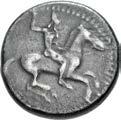


38. SICILY, Gela. Circa 490/85-480/75 BC. AR Didrachm (20mm, 8.66 g, 9h). Warrior, nude but for helmet, riding right, preparing to cast javelin / Forepart of man-headed bull right within incuse circle. Jenkins, Gela, Group Ib, 60 (O18/R26); HGC 2, 363; SNG ANS 10 (same obv. die); SNG Lockett 759 (same rev. die). Toned, struck with worn obverse die. VF. ($1500)
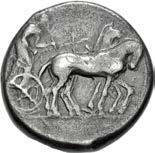
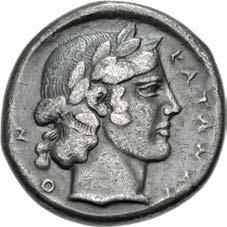
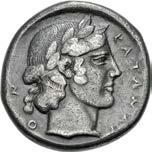
39. SICILY, Katane. Circa 450-445 BC. AR Tetradrachm (25mm, 16.98 g, 5h). Charioteer, holding kentron and reins, driving slow quadriga right / Head of Apollo right, wearing laurel wreath. Mirone 30–3; HGC 2, 566; SNG ANS 1245 (same dies); Rizzo pl. X, 1/2 (same obv./rev. dies). Old cabinet tone, light scratches and scuffs under tone on obverse. VF. Well centered and struck for issue. ($2000)
Ex Gerald F. Borrmann (Northern California Gentleman) Collection; CNG inventory 944835 (March 2013); Robert and Julius Diez Collection (Classical Numismatic Group Electronic Auction 294, 16 January 2013), lot 41; Gustav Philipsen Collection (Part I, J. Hirsch XV, 28 May 1906), lot 960.



40. SICILY, Messana (as Zankle). Circa 500-493 BC. AR Drachm (21mm, 5.19 g). Dolphin left within sickle-shaped harbor / Nine-part incuse square with scallop shell in center. Gielow Group 4, 62 (same obv. die); HGC 2, 766. Iridescent tone, traces of find patina, edge split, granular surfaces. VF. ($1500)
From the JTB Collection. Ex Gorny & Mosch 297B (10 October 2023), lot 1213.
The colony of Zankle was founded by Cumaean and Euboean settlers in the eighth century BC on the straits of Messina. Its name, meaning “sickle”, was taken from its important sickle-shaped harbor. The colony prospered and even founded its own colonies at Mylae and Himera. Zankle was soon overshadowed by Rhegion, though, whose tyrant, Anaxilas, seized the colony around 488 BC and renamed the city Messana, after Peloponnesian Messenia, whose colonists he settled in Zankle.


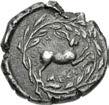
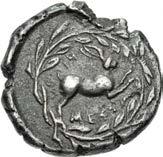
41. SICILY, Messana. 445-439 BC. AR Drachm (17mm, 3.97 g, 11h). Charioteer driving biga of mules right; above, Nike flying right, crowning horses; olive leaf and berry in exergue / Hare springing right within wreath. Caltabiano Series IX, 387 (D175/R169); HGC 2, 807; SNG ANS 347 (same dies); SNG Copenhagen 409 (same dies); BMC 32 (same dies); Hunterian 9 (same dies); Pozzi 486 (same dies). Old cabinet tone, minor porosity, a couple of shallow cuts on obverse. VF. ($1000)
From the Kelly Ramage Collection. Ex Robert and Julius Diez Collection (Classical Numismatic Group Electronic Auction 294, 16 January 2013), lot 57; Gustav Philipsen Collection (Part I, J. Hirsch XV, 28 May 1906), lot 1047.
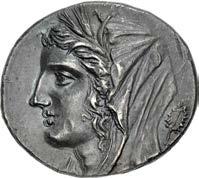
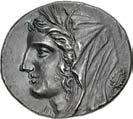


42. SICILY, Morgantina. The Sikeliotes. Circa 214-213 BC. AR 8 Litrai – Didrachm (21.5mm, 6.90 g, 9h). Wreathed head of Persephone left; leaf to right / Nike, wearing long chiton, holding kentron and reins, driving fast quadriga right; ` above. Erim & Jaunzems Group II; BAR Issue 3; Campana 12; HGC 2, 910. Deep old collection tone with some iridescence, slight doubling on obverse. EF. ($2000)
Ex New York Sale IV (17 January 2002), lot 69; Münzen und Medaillen AG 88 (17 May 1999), lot 85.
Persephone was known in cults as Kore, Greek for “maiden.” She was the daughter of Demeter, goddess of the harvest. The city of Morgantina was known for its fertility, hence the appropriateness of the depiction of Kore on its coins. In fact, during the Second Punic War, the Roman general Marcellus used Morgantina as a base to store corn for his troops while he was besieging Syracuse. The Sikeliote coinage was struck at Morgantina when it seemed that a native revolt, supported by the Carthaginians, would succeed in driving the Romans from the island. The revolt failed, Morgantina was sacked, and only a scattering of the coinage survived.



43. SICILY, Morgantina. The Sikeliotes. Circa 214-213 BC. AR 8 Litrai – Didrachm (22.5mm, 6.44 g, 8h). Wreathed head of Persephone left; leaf to right / Nike, wearing long chiton, holding kentron and reins, driving fast quadriga right; ` above. Erim & Jaunzems Group II; BAR Issue 3; Campana 12; HGC 2, 910. Toned, light scratches, a little die wear, trace deposits. EF. ($1500)
From the JTB Collection. Ex Classical Numismatic Group 121 (6 October 2022), lot 119; Cornelius C. Vermeule III Collection (Classical Numismatic Group 50, 23 June 1999), lot 483; Spink America (20 May 1995), lot 70.
Illustrated in Hurter


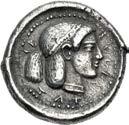
44. SICILY, Segesta. Circa 475/0-455/0 BC. AR Didrachm (20.5mm, 8.40 g, 8h). Hound scenting right / Head of Aigiste right. Hurter, Didrachmenprägung 40a (V12/R22 – this coin, illustrated); HGC 2, 1113. Lightly toned, porous, some smoothing in fields on obverse. VF. ($1500)
Ex Weise Collection (Classical Numismatic Group 124, 19 September 2023), lot 55; Tony Hardy Collection (Classical Numismatic Group 67, 22 September 2004), lot 322.

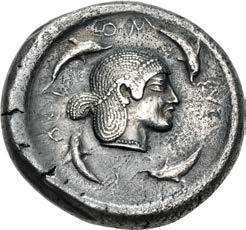
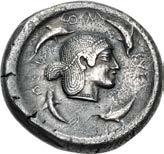
45. SICILY, Syracuse. Gelon I. 485-478 BC. AR Tetradrachm (26.5mm, 16.71 g, 10h). Struck circa 480-478 BC. Charioteer, holding kentron and reins, driving slow quadriga right; above, Nike flying right, crowning horses / Head of Arethousa right, wearing pearl tainia; four dolphins around. Boehringer Series VIa, 66 (V32/R44); HGC 2, 1306; Pozzi 554 (same dies). Toned, some blue iridescence, some die wear and minor flan flaw on obverse, light roughness on reverse. VF. ($1000)
Ex Comery Collection (Roma VI, 29 September 2013), lot 413.
Under the rule of Gelon I (485-478 BC), Syracuse not only began to be the dominant power in Sicily, but won a major international victory against the Carthaginians at Himera in 480 BC, supposedly on the same day that the Persians were defeated at Salamis. To achieve this success, the Syracusan mint greatly increased its output of coinage, mostly tetradrachms, to provide funds for war. These issues, however, were archaic in style, like this coin. However, the wealth and international renown that Syracuse gained following Himera created a long-term cultural benefit for the area, since mainland Greece saw it not as a western backwater, but as a bastion of Greek ideals against the barbarians. Scientists, poets, and artists, especially engravers, were now encouraged to emigrate to the city, bringing with them the experimental concepts then appearing in mainland Greece. Gelon’s victories provided the financial means for his successors to make use of these talented individuals to enhance the renown of Syracuse as one of the main cultural centers of the Greek world. Since the issuing of coinage was an important part of maintaining Syracusan power, it now also became the vehicle by which the city could demonstrate its importance as a center for new intellectual and cultural ideas. As the tetradrachm was the denomination that was used for large-scale payments and appeared to a wide audience of both Greeks and non-Greeks, it became the canvas upon which the new artistic concepts of classical art were tried. Syracuse’s success with classical style tetradrachms expanded to the city’s other denominations. Elsewhere in Sicily and Magna Graecia, cities wishing to keep in cultural step adopted the classical style for their coinages. Thus, by the beginning of the fourth century BC, the coinage of Syracuse and Sicily became recognized as masterpieces of Classical Greek numismatic art.

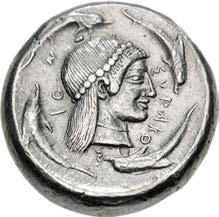

46. SICILY, Syracuse. Hieron I. 478-466 BC. AR Tetradrachm (24mm, 17.23 g, 8h). Struck circa 478-475 BC. Charioteer, holding kentron and reins, driving slow quadriga right; above, Nike flying right, crowning horses / Head of Arethousa right, wearing pearl tainia; four dolphins around. Boehringer Series VIIIa, 117 (V53/R42); HGC 2, 1306; SNG ANS 30 (same dies); BMC 26 (same dies); Boston MFA 344 = Warren 297 (same dies); Weber 1555 (same dies). Lightly toned, minor die wear, slightly off center on obverse. Good VF. ($1500)
Ex Stack’s Bowers Galleries (12 January 2017), lot 2011; Auctiones AG 27 (10 December 1996), lot 95; Auctiones AG 25 (19 June 1995), lot 205.
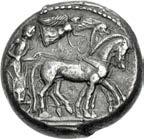

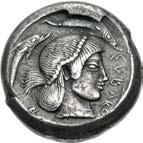
47. SICILY, Syracuse. Hieron I. 478-466 BC. AR Tetradrachm (23mm, 17.41 g, 5h). Struck circa 478-475 BC. Charioteer, holding kentron and reins, driving slow quadriga right; above, Nike flying right, crowning horses / Head of Arethousa right, wearing pearl tainia; four dolphins around. Boehringer Series XI, 242 (V109/R164); HGC 2, 1306; McClean 2610 (same dies). Old collection tone, compact flan, die break and flan flaw on reverse. VF. ($1000)
Ex Spink Smythe (16 January 2012), lot 1084.
Hieron I, assuming power after his brother, Gelon’s, death, expanded Syracuse’s influence onto the Italian mainland, where he won another signal victory over the Etruscans at Cumae in 474 BC. Like his brother, Hieron embellished Syracuse with amphitheaters, libraries, and other civic buildings, and was a liberal patrons of art and literature. On the other hand, Hieron employed a secret police force, the first in Greek history, to retain his grip on power. Though both Gelon and Hieron were addressed as “king” by some contemporaries, there is no evidence that they adopted the royal title, and their names never appear on Syracusan coins. A third Deinomenid brother, Thrasybolos, attempted to rule Syracuse after Hieron’s death in 466 BC but was quickly overthrown and replaced by a democratic government.


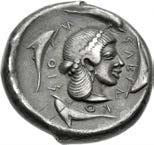

48. SICILY, Syracuse. Hieron I. 478-466 BC. AR Tetradrachm (25mm, 17.27 g, 10h). Struck circa 475-470 BC. Charioteer, holding kentron and reins, driving slow quadriga right; above, Nike flying right, crowning horses / Head of Arethousa right, wearing pearl tainia; four dolphins around. Boehringer Series XIId, 352 (V174/R247); HGC 2, 1307; Boston MFA 355 = Warren 303 (same dies). Old cabinet tone, trace earthen deposits, a touch off center, minor flan flaw on reverse. VF. ($1500)
Ex Zuzim inventory G.251; Private American Collection, reportedly purchased from Bernard Poindessault, 1970s–80s.




49. SICILY, Syracuse. Second Democracy. 466-405 BC. AR Tetradrachm (25mm, 17.27 g, 7h). Struck circa 466-460 BC. Charioteer, holding kentron and reins, driving slow quadriga right; above, Nike flying left, crowning charioteer; in exergue, ketos right / Head of Arethousa right, wearing pearl tainia (within centering circle); four dolphins around. Boehringer Series XIIIb, 436 (V233/R312); HGC 2, 1310; Weber 1566 (same dies). Toned, flan flaw on reverse. VF. Fine style. ($1500)
Ex Jonathan K. Kern Collection.
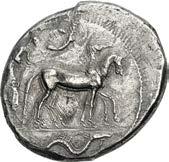
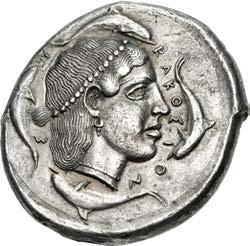

50. SICILY, Syracuse. Second Democracy. 466-405 BC. AR Tetradrachm (26.5mm, 17.16 g, 9h). Struck circa 460-450 BC. Charioteer, holding kentron and reins, driving slow quadriga right; above, Nike flying right, crowning horses; in exergue, ketos right / Head of Arethousa right, wearing pearl tainia; four dolphins around. Boehringer Series XIVa, 469 (V252/R338); HGC 2, 1311; SNG ANS 144–5 (same rev. die); SNG München 1008 (same dies); Dewing 787 (same obv. die); Gillet 560 (same dies); Jameson 761 (same obv. die); Pozzi 574 (same obv. die); Wallenbrock fig. 2.7. Lightly toned, a little off center and double struck on obverse. Good VF. ($5000)
Ex D.K. Collection (Triton XXVI, 10 January 2023), lot 56.


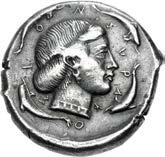

51. SICILY, Syracuse. Second Democracy. 466-405 BC. AR Tetradrachm (26mm, 17.38 g, 1h). Struck circa 450 BC. Charioteer, holding kentron and reins, driving slow quadriga right; above, Nike flying right, crowning horses; in exergue, ketos right / Head of Arethousa right, hair in thin band; four dolphins around. Boehringer Series XV, 538 (V274/R377); HGC 2, 1311; McClean 2659 (same dies). Deeply toned, numerous cleaning marks and scratches, die break on reverse. VF. ($1500)
Ex M. L. Collection of Coins of Magna Graecia and Sicily (Numismatica Ars Classica 82, 20 May 2015), lot 55, purchased from Numismatica Ars Classica, 1990.

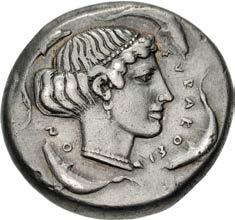

52. SICILY, Syracuse. Second Democracy. 466-405 BC. AR Tetradrachm (23mm, 16.97 g, 10h). Struck circa 450-440 BC. Charioteer, holding kentron and reins, driving slow quadriga right; above, Nike flying right, crowning horses; [in exergue, ketos right] / Head of Arethousa right, wearing pearl tainia; four dolphins around. Boehringer Series XVI, 563 (V284/R385E); HGC 2, 1311; SNG ANS 182 (same dies); BMC 97 (same dies). Lightly toned, minor marks. VF. ($2000)
Ex Triton XVII (7 January 2014), lot 66; Künker 174 (27 September 2010), lot 122; Peus 332 (23 October 1991), lot 75.



53. SICILY, Syracuse. Second Democracy. 466-405 BC. AR Tetradrachm (24mm, 16.74 g, 7h). Struck circa 430 BC. Charioteer, holding kentron and reins, driving quadriga right; above, Nike flying left, crowning charioteer / Head of Arethousa right, hair in ornate sakkos; four dolphins around. Boehringer Series XIX, 632 (V320/R434); HGC 2, 1316; Bement 490 (same dies). Toned, compact flan, edge marks. VF. ($1500)
Ex Vilmar Numismatics FPL V (Summer/Fall 2023), no. 7; Mark & Lottie Salton Collection (Stack’s Bowers Galleries, 13 January 2023), lot 26066.
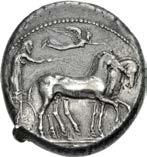


54. SICILY, Syracuse. Second Democracy. 466-405 BC. AR Tetradrachm (23mm, 17.34 g, 2h). Struck circa 430 BC. Charioteer, holding kentron and reins, driving slow quadriga right; above, Nike flying right, crowning horses / Head of Arethousa right, hair in ornate sakkos; four dolphins around. Boehringer Series XX, 641 (V326/R441); HGC 2, 1319; SNG Lockett 952 (same dies); Boston MFA 387–8 (same dies); McClean 2685–6 (same dies); Pozzi 596 (same dies). Toned, minor doubling, a little off center. Good VF. ($2000)
Ex Classical Numismatic Review XXXIX.2 (Summer 2014), no. 979785; Athos and Dina Moretti Collection (Numismatica Ars Classica Q, 6 April 2006), lot 1258.

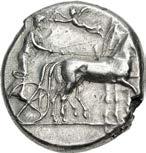

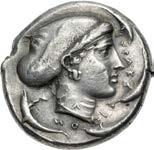
55. SICILY, Syracuse. Second Democracy. 466-405 BC. AR Tetradrachm (24mm, 17.31 g, 11h). Reverse die signed by the artist A–. Struck circa 425-420 BC. Charioteer, holding kentron and reins, driving slow quadriga right; above, Nike flying left, crowning charioteer / Head of Arethousa right, hair in ornate sakkos, Å on neck; four dolphins around. Boehringer Series XXIII, 707 (V346/R484); HGC 2, 1323. Light iridescent tone, some die wear. Good VF. Very rare. ($5000)
Ex Coin Galleries (14 July 1999), lot 29; Leu 74 (19 October 1998), lot 99; Santamaria (4 May 1961), lot 86.
The A on the neck of Arethousa on this late Boehringer issue is often overlooked, and while there is temptation to suggest it may be an identifier for the portrait as Arethousa, the fact that this same letter also appears on some obverse dies (see, e.g., Boehringer obverse die V347) makes it unlikely. Boehringer identifies this letter on a number of dies, and notes a strong similarity of style that makes it more likely that this letter is actually an artist’s signature (Boehringer pp. 64–5). The fact that Series XXIII is among the latest before the “signing artists” period studied by Tudeer, also supports the thought that this letter is likely a signature. Whose signature it is, though, remains a mystery.
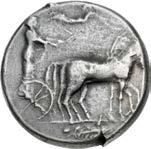

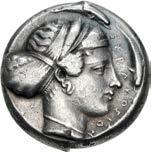
56. SICILY, Syracuse. Second Democracy. 466-405 BC. AR Tetradrachm (24mm, 16.36 g, 1h). Struck circa 420-415 BC. Charioteer, holding kentron and reins, driving slow quadriga right; above, Nike flying right, crowning horses; leaf with berry in exergue / Head of Arethousa right, hair in wide band; four dolphins around. Boehringer Series XXIV, 720 (V354/ R491); HGC 2, 1324; Bement 483 (same dies); Boston MFA 395 = Warren 345 (same dies). Light iridescent tone, a little off center, struck with worn obverse die, slight die wear on reverse. VF. ($1500)
Ex ArtCoins Roma E-Auction 22 (27 November 2014), lot 218.
American
Berlin, Lobbecke, and Virzi Collections – SNG ANS Plate Coin – Pedigreed to 1898

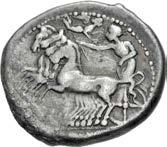

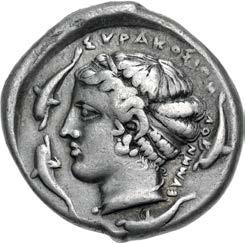
57. SICILY, Syracuse. Second Democracy. 466-405 BC. AR Tetradrachm (27mm, 17.00 g, 6h). Dies signed by Eumenes. Struck circa 415-409 BC. Charioteer, holding kentron and reins, driving fast quadriga left; above, Nike flying right, crowning charioteer; [E-¨]µ˙@[o¨] in exergue / Head of Arethousa left, hair in band; E¨µ˙@-o¨ behind neck, four dolphins swimming around. Fischer-Bossert, Coins 23j (V9/R16) = SNG ANS 258 = Bement 494 = Comte. A. Du Chastel de la Howardries, Syracuse, ses monnaies d’Argent et d’or au point de vue artistique. La coiffure antique et ses développements successifs (London, 1898), pl. 6, 68 (this coin); Tudeer 23; HGC 2, 1328; SNG Lloyd 1367; SNG Lockett 961; BMC 144; Boston MFA 400 = Warren 370; Dewing 841; Gillet 611; Jameson 792 (all from the same dies). Old collection tone, some roughness around lower periphery of obverse. VF. Attractive in hand, and possessing an excellent pedigree. ($3000)
Ex Gemini V (6 January 2009), lot 354; American Numismatic Society Collection, inventory 1967.152.516 (bequest of Mrs. Adra M. Newell, 1967); Edward T. Newell Collection; Clarence S. Bement Collection (Naville VI, 28 January 1923), lot 494; Doubletten des Königsliche Münzkabinett Berlin (J. Hirsch XXVI, 23 May 1910), lot 92; Arthur Löbbecke Collection; I. Virzi Collection.

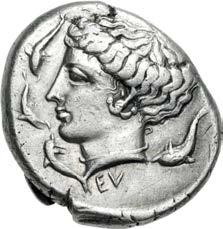

58. SICILY, Syracuse. Second Democracy. 466-405 BC. AR Tetradrachm (26mm, 17.08 g, 9h). Obverse die signed by Euainetos, reverse by Eu[kleidas]. Struck circa 415-409 BC. Charioteer, holding kentron and reins, driving fast quadriga right; above, Nike flying left, crowning charioteer; EUÅ5@Eto in tiny letters on exergue line (only a trace visible), wheel in exergue / Diademed head of Arethousa left; E¨ below, four dolphins around. Fischer-Bossert, Coins 35 (O12/R18); Tudeer 35; HGC 2, 1330; McClean 2711 (same dies); Jameson 1916 (same dies). Flan flaws, minor scratches. Good VF. Very rare die combination, only five examples noted by Fischer-Bossert. ($2000)
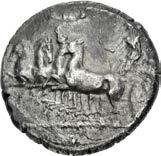


59. SICILY, Syracuse. Second Democracy. 466-405 BC. AR Tetradrachm (26mm, 17.02 g, 12h). Reverse die signed by Eukleidas. Struck circa 409-406 BC. Charioteer, holding flaming torch in right hand and reins in left, driving fast quadriga left; above, Nike flying right, crowning charioteer with open wreath held in both hands; in exergue, grain ear left / Head of Athena facing slightly left, wearing crested Attic helmet with cheek pieces raised, signed [E¨>˚]-¬E5d>Å across the bowl; [sUr-Å˚-os5W@] and four dolphins around. Fischer-Bossert, Coins 58 (O24/R36); Tudeer 58; HGC 2, 1337; Basel 464 (same dies); BMC 198–9 (same dies); de Luynes 1191 (same dies); Gillet 628 (same dies); Gulbenkian 282 (same dies); Kunstfreund 120 (same dies); Kraay & Hirmer 111 (same dies); Rizzo pl. XLIII, 22 (same dies). Rough find patina. VF. Very rare, only 20 examples noted by Fischer-Bossert, of which 11 are in public collections. ($6000)
Ex G. Hirsch 314 (23 September 2015), lot 2273.
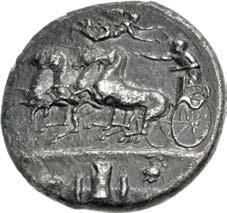
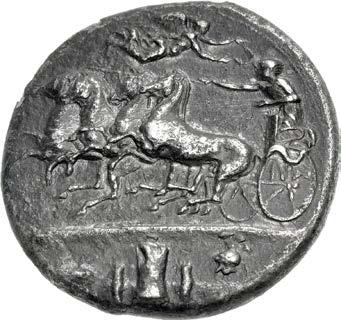

60. SICILY, Syracuse. Dionysios I. 405-367 BC. AR Dekadrachm (36.5mm, 40.85 g, 6h). Reverse die signed by Euainetos. Struck circa 405-390 BC. Charioteer, wearing long chiton, holding kentron in extended right hand and reins in left, driving fast quadriga left; above, Nike, wearing long chiton, flying right, crowning charioteer with wreath held in her extended hands; below heavy exergual line, [military harness], shield, greaves, cuirass, and crested Attic helmet, all connected by a horizontal spear; [ÅQ¬Å below] / Head of Arethousa left, wearing wreath of grain ears, triple-pendant earring, and pearl necklace; sU-rÅ-k-o-s5W@ behind hair, four dolphins swimming around, [EU-Å5@E along lower edge]. Gallatin dies R.III/C. II; Scavino 12 (D4/R9); HGC 2, 1299; SNG ANS 363 = Pozzi 615 (same dies); SNG Copenhagen 689 (same dies); SNG Fitzwilliam 1274 (same dies); SNG Manchester 471 (same dies); Boston MFA 421 = Warren 366 = Rizzo pl. LIV, 8 (same dies); Dewing 877 (same dies); de Luynes 1248 (same dies); Nanteuil 361 bis (same dies). Find patina, a little off center, some roughness, area of chipping on edge. VF. ($10,000)

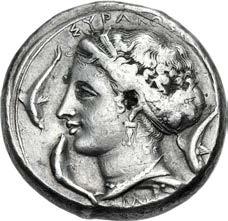
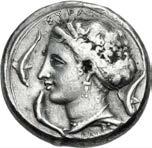
61. SICILY, Syracuse. Dionysios I. 405-367 BC. AR Tetradrachm (25mm, 17.31 g, 12h). Reverse die signed by Parmenides. Struck circa 405-400 BC. Charioteer, holding kentron and reins, driving fast quadriga left; above, Nike flying right, crowning charioteer; in exergue, grain ear left / Head of Arethousa left, hair in sphendone; πÅr[µE] below, four dolphins around. Kreutzer Parme Ia, 6 (this coin); Fischer-Bossert, Coins 71 (O25/R49); Tudeer 71; HGC 2, 1342; Nanteuil 366 (same dies); Pozzi 1280 (same dies). Toned, minor deposits. VF. ($3000)
Ex Numismatica Ars Classica & Spink Taisei 51 (1 June 1994), lot 46; Ceresio 3 (3 October 1992), lot 53; Numismatica Ars Classica A (28 February 1991), lot 1211.
Referenced by Fischer-Bossert


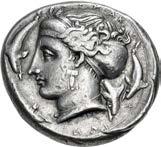
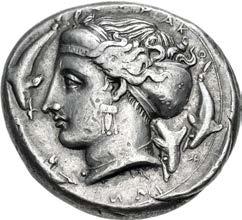
62. SICILY, Syracuse. Dionysios I. 405-367 BC. AR Tetradrachm (24mm, 17.28 g, 1h). Struck circa 405-400 BC. Charioteer, holding kentron and reins, driving fast quadriga left; above, Nike flying right, crowning charioteer; ivy leaf on vine below horses to left; in exergue, grain ear left / Head of Arethousa left, hair in ornate sphendone; four dolphins swimming around. Fischer-Bossert, Coins 83e (V30/R56 – this coin); Tudeer 83; HGC 2, 1342; SNG ANS 291 (same dies); SNG Fitzwilliam 1249 = Bement 521 (same dies); SNG Lockett 977 = Pozzi 619 (same dies); Dewing 850 (same dies); Jameson 823 (same dies). Lightly toned, a little die wear on obverse. VF. Well centered. ($5000)
Ex Classical Numismatic Group 123 (23 May 2023), lot 31; Classical Numismatic Auctions 7 (4 May 1989), lot 16.


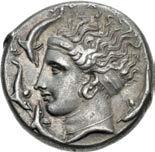
63. SICILY, Syracuse. Dionysios I. 405-367 BC. AR Tetradrachm (25mm, 17.21 g, 1h). Unsigned dies in the style of Eukleidas. Struck circa 400/395-390 BC. Charioteer, holding kentron and reins, driving fast quadriga left; above, Nike flying right, crowning charioteer; in exergue, dolphin left, its dorsal fin breaking the exergual line / Head of Arethousa left, hair in broad band and welling upwards in wavy locks; four dolphins around. Fischer-Bossert, Coins 92 (O33/R64); Tudeer 92; HGC 2, 1345; SNG ANS 297 (same dies); SNG Lockett 979 = Dewing 858 = Pozzi 624 (same dies); Dewing 857 (same dies); Jameson 808 (same dies); Nanteuil 364 (same dies). Toned, compact flan, usual die wear on obverse. Good VF. ($4000)
Ex Stack’s Bowers Galleries (9 January 2015), lot 34.
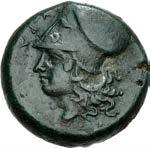



64. SICILY, Syracuse. Dionysios I. 405-367 BC. Æ Litra (16.5mm, 5.03 g, 4h). Head of Athena left, wearing Corinthian helmet with neck guard / Hippocamp left. Holloway, Further, Series 4, fig. 9; CNS 34; HGC 2, 1456; Virzi 1460 (this coin). Attractive dark green patina, compact flan, slight roughness. VF. ($500)
Ex Thomas Virzi Collection (Malloy XVII, 1 December 1980), lot 382; E. Bissen Collection (Ars Classica XII, 18 October 1926), lot 982 (part of). Lot includes old collection ticket noting “Napoli 1912 / Canessa.”

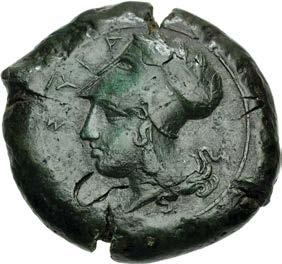

65. SICILY, Syracuse. Dionysios I. 405-367 BC. Æ Drachm (29.5mm, 28.58 g, 6h). Head of Athena left, wearing Corinthian helmet with neck guard and bowl decorated with wreath / Sea-star between two dolphins. CNS 62; HGC 2, 1436. Lovely olive green patina, trace deposits, minor edge splits, a couple of flan flaws on obverse. Good VF. ($1000)
From the Plus 20 Collection. Ex Numismatica Ars Classica 138 (18 May 2023), lot 349; Numismatica Ars Classica 29 (11 May 2005), lot 127; Athos and Dina Moretti Collection.
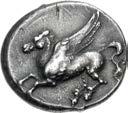

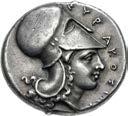
66. SICILY, Syracuse. Timoleon and the Third Democracy. 344-317 BC. AR Stater (20.5mm, 8.53 g, 7h). Struck under Timoleon, 344-339/8. Pegasos flying left / Head of Athena right, wearing Corinthian helmet. Pegasi 2; HGC 2, 1400. Deeply toned, some scratches, edge marks, die rust on obverse. Good VF. ($750)



67. SICILY, Syracuse. Timoleon and the Third Democracy. 344-317 BC. Æ Dilitron (27mm, 19.99 g, 4h). Timoleontic Symmachy coinage. 2nd series, circa 339/8-334 BC. Laureate head of Zeus Eleutherios left / Horse rearing left. Castrizio Series II, 1; CNS 80; HGC 2, 1439. Attractive olive green patina, minor die break on obverse. EF. ($1000)
From the Plus 20 Collection. Ex Goldberg 135 (18 June 2023), lot 1505; Roma XVIII (29 September 2019), lot 533.
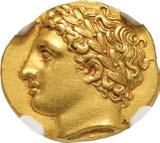



68. SICILY, Syracuse. Agathokles. 317-289 BC. AV Drachm – Hemistater (16mm, 4.29 g, 9h). Struck circa 317-310 BC. Head of Apollo left, wearing laurel wreath / Charioteer, holding kentron and reins, driving fast biga right; triskeles below. Bérend, l’or, pl. 9, 1; BAR Issue 1; HGC 2, 1276. In NGC encapsulation 8233036-003, graded Ch XF, Strike: 4/5, Surface: 3/5, Fine Style, brushed. ($3000)
Ex Stack’s Bowers Galleries (16 August 2021), lot 42057; Auctiones AG 13 (23 June 1983), lot 94.
Agathokles was born in Himera circa 361 BC, the son of a potter who moved the family to Syracuse in the 340s BC. Tiring of his father’s trade, Agathokles became a soldier and quickly established himself as an able leader. Agathokles seized power at the head of a mercenary army in a bloody coup in 317 BC. Over the next few years, he strengthened his army and created a formidable navy, and used them to expand his power base throughout Sicily. This inevitably led him into conflict with Carthage, which still controlled territory in western Sicily. The war lasted from 311-306 BC and only resulted in each side becoming more entrenched in their respective parts of Sicily, with the border between them established along the Halycus River. In 304 BC, imitating the famous Diadochs in the east, Agathokles declared himself king of Sicily, though his power only extended across the eastern part of the island. His later years were more concerned with the consolidation of his power than with expansion. Seeing that none of his progeny could effectively rule in his place, in 289 BC, upon his death bed, Agathokles restored the Syracusan democracy.
The coinage of Syracuse during Agathokles’ reign saw a flowering of new types and denominations. While he retained some of the traditional Syracusan types, such as the head of Arethousa surrounded by dolphins, many of his coins presented new types that were more in line with the royal issues throughout the Greek kingdoms to the east. Herakles, Apollo, and Athena were commonly found on his issues, and he even issued an unprecedented series of electrum, a metal that had not been used before at Syracuse. As would be expected, his final phase of coinage saw the royal title used for the first time on coins of Syracuse, a trend that continued on many issues under the city’s subsequent monarchs.

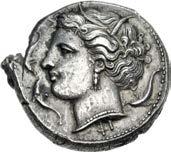
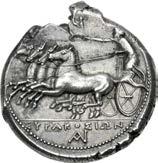
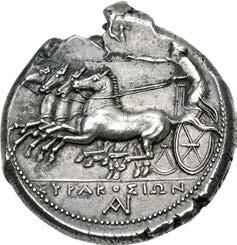


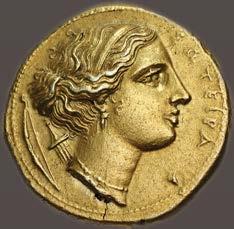

70. SICILY, Syracuse. Agathokles. 317-289 BC. EL 100 Litrai – Stater (18.5mm, 6.98 g, 9h). Struck circa 310-306/5 BC. Head of Apollo left, with long hair, wearing laurel wreath; sUrÅkos5W@ to left, bow to right / Head of Artemis right, wearing taenia, triple-pendant earring, and pearl necklace; quiver over shoulder, bow to left, sWtE5rÅ to right. Jenkins Group D, dies a/a; BAR Issue 13; HGC 2, 1293; SNG Lloyd 1433 (same dies); BMC 252 = GPCG pl. 26, 33 (same dies); Jameson 844 (same dies). Hairline flan crack. EF. Fine style. Well centered and struck. ($30,000)
Ex Classical Numismatic Group 108 (16 May 2018), lot 19; Palombo 12 (6 December 2013), lot 11.
During the course of Agathokles’ protracted struggle against Carthage, he launched a surprise invasion of Africa and struck terror in the heart of the Carthaginian heartland before the worsening situation in Sicily necessitated his return. It was likely in connection with the war against Carthage that a remarkable electrum coinage was produced by the Syracusan tyrant. Electrum was already established as the metal for the shekel-didrachms and fractional denominations of Carthage, and the production of his own currency in this metal would have facilitated Agathokles’ military activities in North Africa. The artistic style of this largest electrum denomination, valued at 100 litrai, is exceptional and truly in keeping with the great numismatic heritage of Syracuse. The coins make no reference to the tyrant himself and, indeed, due to their beautiful style, these issues have previously been attributed to much earlier periods in the 4th century. However, the present chronology, devised by G. K. Jenkins, seems reasonably secure and is supported by hoard evidence.


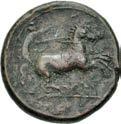
71. SICILY, Syracuse. Hiketas II. 287-278 BC. Æ (20mm, 6.72 g, 1h). Wreathed head of Kore left / Nike driving galloping biga right; [letter or monogram in exergue?]. CNS 127; BAR Issue 38; HGC 2, 1466; Virzi 1748 (this coin). Dark green-brown patina, deposits, roughness. VF. Fine style. ($500)
Ex Thomas Virzi Collection (Malloy XVII, 1 December 1980), lot 438; E. Bissen Collection (Ars Classica XII, 18 October 1926), lot 1010 (part of). Lot includes old collection ticket noting “Palermo 1907 / de Ciccio.”
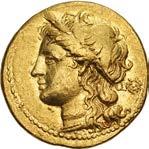



72. SICILY, Syracuse. Hieron II. 275-215 BC. AV Hemistater (16mm, 4.23 g, 1h). Struck 269-263 or 217-215 BC. Wreathed head of Persephone left; wreath to right / Nike, holding kentron and reins, driving fast biga right; Â5 above. Carroccio 94 (D42/R63); BAR Issue 55; HGC 2, 1542; Adams I 1294 (this coin); Gulbenkian 350 (same dies); Rhousopoulos 471 (same dies). Area of weak strike. VF. ($2000)
Ex Roma XX (29 October 2020), lot 89; Dr. Lawrence A. Adams Collection (Part I, Classical Numismatic Group 100, 7 October 2015), lot 1294.
Hieron II started life as the illegitimate son of a noble father, allegedly a distant descendant of the Syracusan tyrant Gelon I. Later legends claim Hieron was exposed as an infant, but swarms of bees fed him honey until his father, warned by an astrologer, came and rescued the boy. As a young man, he served as a mercenary soldier in the army of Pyrrhos of Epeiros. When his commander elected to abort his Sicilian expedition in 275 BC, Hieron stayed behind and convinced a cabal of fellow soldiers to choose him as leader and seize power in Syracuse. He went on to rule the city and much of Sicily, first as a military tyrant, later as an enlightened and successful king, for nearly 50 years. He is most famous as the king who patronized the brilliant polymath Archimedes in his “eureka!” discovery, the principle of displacement. Hieron’s coinage is widely varied, interesting, and in many ways inspired by that of his Hellenistic ally, the Ptolemaic Kingdom of Egypt.
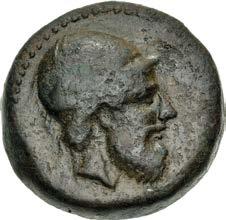

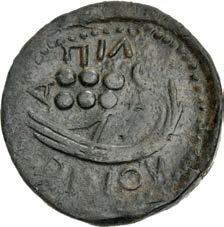
73. ISLANDS off SICILY, Lipara. Circa 440-420 BC. Æ Hemilitra – Hexonkion (36.5mm, 45.56 g, 11h). Head of Aiolos right, wearing pilos / Stern with aphlaston to right; six pellets (mark of value) above. Zagami 40; CNS 4; Buceti 4 (this coin illustrated); HGC 2, 1761; BMC 2 = BM inv. 1841,0726.405 (same dies). Green-brown patina, typical minor roughness. VF. ($2000)
Ex Alexandre de Barros Collection (Classical Numismatic Group 75, 23 May 2007), lot 94; Vecchi 16 (9 October 1999), lot 82.


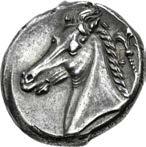

74. SICULO-PUNIC, “The Camp”. Circa 320/15-300 BC. AR Tetradrachm (24.5mm, 17.19 g, 6h). Possibly Entella mint. Wreathed head of Arethousa left; to left, dolphin above kerykeion / Head of horse left; palm tree to right, [MM (M = “People of the Camp” in abbreviated form, in Punic) below]. Jenkins, Punic, Series 3c, 227 (O69/R195 – this coin cited); CNP 264f; HGC 2, 289; de Luynes 1463 (same dies). Old collection tone, minor marks. Good VF. ($4000) Ex Southern Collector (Vilmar Numismatics FPL V, Summer/Fall 2023), no. 16, purchased from Vilmar Numismatics, 2019; Gorny & Mosch 232 (5 October 2015), lot 88; R. A. von Every Collection (Leu 15, 4 May 1976), lot 145; Hess-Leu [9] (2 April 1958), lot 114.




75. SICULO-PUNIC, “The Camp”. Circa 320/15-300 BC. AR Tetradrachm (24.5mm, 16.94 g, 8h). Possibly Entella mint. Wreathed head of Arethousa left; pellet below chin, four dolphins around / Head of horse left; palm tree to right, M (M = “People of the Camp” in abbreviated form, in Punic) below. Jenkins, Punic, Series 3d, 232 (O72’/R199); CNP 264b; HGC 2, 289; GPCG pl. 31, 21 (same dies). In NGC encapsulation 6369978-005, graded Ch AU, Strike: 5/5, Surface: 4/5. ($3000) Ex Stack’s Bowers Galleries (13 January 2023), lot 20022.
Referenced in Jenkins – Pedigreed to 1934
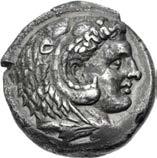

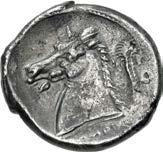
76. SICULO-PUNIC, “The Camp”. Circa 320/15-300 BC. AR Tetradrachm (25.5mm, 16.47 g, 3h). Possibly Entella mint. Head of Herakles right, wearing lion skin / Head of horse left; palm tree to right, [M]Bß∆[M] (MHSBM = “Paymasters” in Punic) below. Jenkins, Punic, Series 5b, 341 (O110/R279 – this coin referenced); CNP 272; HGC 2, 295. Deeply toned, remnants of find patina, a few scratches under tone, small delamination on obverse. VF. ($2000)
From the L.H. Collection. Ex Baranowsky FPL (1934), no. 4674.
In the final decade of the fifth century BC, the Carthaginians launched a series of invasions of Sicily, conquering much of the western half of the island and bringing devastation to many formerly flourishing Greek communities. The Punic presence lasted for a century and a half, until Rome’s victory in the First Punic War obliged the Carthaginians to withdraw. During their time of occupation, the Carthaginians struck an extensive coinage in Sicily for the purpose of financing their military operations and the maintenance of garrisons. The obverse and reverse types of the series are mostly influenced by Sicilian prototypes, particularly those of Syracuse, except for the later series with the head of Herakles on the obverse, which was obviously influenced by the well-recognized coinage of Alexander the Great. While a few of the series are struck at cities with established mints, such as Motya and Panormos, these are often viewed as minor or campaign mints that operated for a short duration. The location of the primary Punic mint (or mints) on Sicily, responsible for the large issues studied by G.K. Jenkins (‘Carthage’ series I-V), has been the subject of great debate.
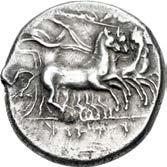

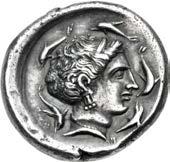
77. SICULO-PUNIC, “Cape of Melkart”. Circa 350-310 BC. AR Tetradrachm (27mm, 17.24 g, 4h). Probably Lilybaion mint. Charioteer, holding kentron and reins, driving fast quadriga right; above, Nike flying left, crowning charioteer; teQ¬Mße (RŠMLQRT = “Raš Melqart” in Punic) in exergue / Wreathed head of Arethousa right; five dolphins swimming around. Jenkins, Punic 10 corr. (O6/R8 – this coin cited; five, not four, dolphins); CNP 314; HGC 2, 731. Toned, some die wear, area of repair/tooling on reverse. VF. Very rare with five dolphins on reverse. ($2000)
Ex Grapevine Collection; Hess-Leu [15] (7 April 1960), lot 102 (with area of repair/tooling present).

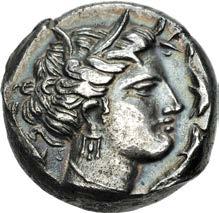

78. SICULO-PUNIC, “Cape of Melkart”. Circa 330-305 BC. AR Tetradrachm (23.5mm, 17.15 g, 8h). Probably Lilybaion mint. Charioteer, holding kentron and reins, driving fast quadriga right; above, Nike flying left, crowning charioteer; [teQ¬Mße (RŠMLQRT = “Raš Melqart” in Punic) in exergue] / Wreathed head of Kore-Persephone right; three dolphins swimming around. Jenkins, Punic 35 (O14/R26); CNP 308; BAR Issue 1; HGC 2, 741. Iridescent tone, compact flan, indications of overstriking on obverse. VF. ($1500)
Ex CNG inventory 505926 (February 2019).

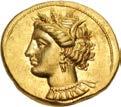
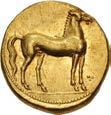

79. CARTHAGE. Circa 350-320 BC. AV Stater (18mm, 9.22 g, 10h). Carthage mint. Head of Tanit left, wearing wreath of grain ears, triple-pendant earring, and necklace with eleven pendants / Horse standing right on exergue line; three pellets to right of foreleg. Jenkins & Lewis Group IIIf, 31 (same dies); MAA 4; CNP 1.5f. Lustrous, slight die wear, a few minor scratches. Superb EF. Fine style. ($7500)
The Punic goddess Tanit and the horse were the standard types for Carthaginian coinage and for most of the city’s existence. Tanit was the primary deity of Carthage. A celestial divinity with some fertility aspects, she was the North African equivalent of Astarte. She is always depicted on the coinage wearing a wreath of grain, which may have been borrowed from Demeter and Persephone as the Carthaginians assimilated the Sicilian culture into their own during the various Punic excursions to the island. The use of the horse on the reverse is usually considered part of the foundation myth of Carthage. According to Virgil’s Aeneid, the Phoenician colonists who founded Carthage were told by Juno (or Tanit) to establish the new colony at the place where they discovered a horse’s head in the ground. Another theory is that the obverse head is actually Demeter or Persephone, whose worship was introduced to Carthage in 396 BC to make amends for the destruction of the goddesses’ temples outside Syracuse by the Carthaginian army.

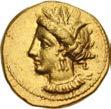


80. CARTHAGE. Circa 350-320 BC. AV Stater (19mm, 9.05 g, 3h). Carthage mint. Head of Tanit left, wearing wreath of grain ears, triple-pendant earring, and necklace with seven pendants / Horse standing right on exergue line; three pellets to right of foreleg. Jenkins & Lewis Group IIIh, 76–7 (same obv. die); CNP 1.5f; MAA 4. Lustrous, a few light scratches. Near EF. ($5000)


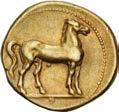
81. CARTHAGE. Circa 310-290 BC. EL Stater (19.5mm, 7.60 g, 12h). Carthage mint. Wreathed head of Tanit left, wearing necklace with nine pendants; pellet before neck / Horse standing right on exergue line; pellet below belly, three pellets in exergue. Jenkins & Lewis Group V, 280 (same dies); CNP 2.10e; MAA 10. Toned, some underlying luster, trace earthen deposits, graffito in field on reverse. VF. ($1500)
Purchased by the consignor from Pegasi Numismatics, 2015.


82. CARTHAGE. Circa 201-175 BC. Æ 15 Shekels (45mm, 94.03 g, 12h). Carthage mint. Wreathed head of Tanit left / Horse standing right; uraeus above, K (Punic alef) below. CNP 48 var. (unlisted Punic letter); MAA 104 var. (same); SNG Copenhagen (Africa) 399–400 var. (letter on rev.). Dark green-brown patina, a few flan flaws. Near VF. Unpublished with this Punic letter on the reverse. ($2000)
From the Plus 20 Collection. Ex Classical Numismatic Group 123 (23 May 2023), lot 34 (hammer $6000).
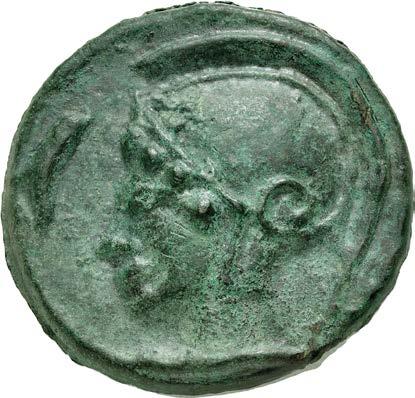

83. SKYTHIA, Olbia. Circa 450-440 BC. Cast Æ (69mm, 136.32 g). Paus(a)-, magistrate. Head of Athena left, wearing Attic helmet; to left, dolphin upward / Wheel with four spokes (‘solar disk’); πÅUs within quarters. Karyshkovskij p. 392, Таб. II=B, 1; Anokhin 164; cf. HGC 3, 1883 (smaller denomination). Green patina. VF. ($3000)
From the Plus 20 Collection. Ex D.K. Collection (Classical Numismatic Group 123, 23 May 2023), lot 35; Harlan J. Berk inventory cc96487; Triton XXIII (14 January 2020), lot 159.
The impressive cast bronzes of Olbia on the Black Sea in many ways presaged the development of the Aes Grave coinage in Italy, although the regions were separated by more than 1,000 miles. Olbia, a colony of Miletos located at the junction of the Hyspanis and Borysthenes rivers in the wilds of Skythia, grew prosperous on trade between the nomadic Skythians and the Greeks. It employed a unique form of coinage consisting of cast bronzes of various sizes and shapes. The smallest Olbian bronzes were made in the shape of dolphins; larger denominations were on circular flans and bore either a facing Gorgon’s head or, as seen here, a helmeted head of Athena in profile. The reverse is a fourspoked wheel, also interpreted as a solar disk. Like the early Romans, the Olbians apparently traded these pieces at “true” value, as opposed to token value, meaning the largest denominations were truly immense and heavy.


84. SKYTHIA, Olbia. Circa 450-440 BC. Cast Æ (71.5mm, 104.52 g). Paus(a)-, magistrate. Head of Athena left, wearing Attic helmet; to left, dolphin upward / Wheel with four spokes (‘solar disk’); πÅUs within quarters. Karyshkovskij p. 392, Таб. II=B, 1; Anokhin 164; cf. HGC 3, 1883 (smaller denomination). Dark green-brown patina, typical minor roughness in spots. Good VF. ($2000)
From the Plus 20 Collection. Ex Stack’s Bowers Galleries (14 August 2023), lot 50081.
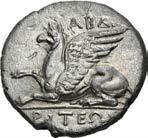

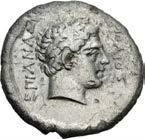
85. THRACE, Abdera. Circa 336-311 BC. AR Stater (24mm, 9.03 g, 11h). Anaxipolios, magistrate. Griffin couchant left / Laureate head of Apollo right. C-N 33–5 var. (D–/R4 [unlisted obv. die]); May, Abdera, Period IX, 531; CN Online Type 6325; HGC 3, 1211c. Lightly toned, hairline flan crack, some roughness, minor marks. VF. ($1500)
Ex Leu Numismatik AG Web Auction 26 (8 July 2023), lot 442.
Abdera has its mythological foundation in the Labors of Herakles, who founded the city in honor of his companion Abderos after the latter was killed by the mares of Diomedes. Historically, the first recorded settlement was a failed colonization effort by Klazomenaians under the leadership of Timesias in 656 BC, but neither of these events have left any concrete traces in the later history. It was in 541 BC that citizens of Teos, fleeing the Persian conquest of Ionia, established a long-lasting civic entity. The unchanging numismatic symbol of Abdera, the griffin, was adopted from the coinage of the lost home city, Teos, but turned to face left instead of right as at Teos. Abdera’s production of massive silver oktadrachms begins within a decade of the founding of the city, and reflects the reason for the success of this foundation as opposed to the earlier failure; at the beginning of the 6th century BC the prolific silver mines of Thrace started coming online, and trading cities such as Abdera and Thasos were well positioned to claim their portion of the wealth. While producing large quantities of silver coins, the city also introduced one of the earliest series of signed coinage by annual magistrates. While the obverse type was invariably a griffin, the reverses, once they evolved beyond the simple quadripartite square in the late 5th century, seem to have been left to the whim of the magistrates, who responded with a delightful repertoire of varied types, mythological and naturalistic, a number featuring visual puns on the magistrate’s name. This was the period of Abdera’s greatest achievements, of well known citizens such as Demokritos, the ‘laughing philosopher’, and Protagoras, the most celebrated of the sophists. The failed revolt against Athens in 411 BC proved only a slight hiatus in the city’s prosperity. However, the final end would come within a generation, as the production of the Thracian silver mines began to slow (or was diverted to the growing power of Macedon) and the Thracian tribes became increasingly restive. In 375 BC, the Abderan army was destroyed by the Triballoi, and only closer confederacy with Athens preserved the city. Its annual coinage issues ceased, and after this period little precious metal coinage was struck in Abdera. By the time of the coming of the Romans in the 2nd century BC, the great trading city of Abdera had sunk into permanent obscurity.


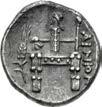
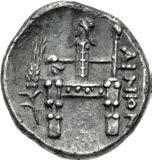
86. THRACE, Ainos. Circa 357-342/1 BC. AR Drachm (16.5mm, 3.79 g, 11h). Head of Hermes facing slightly right, wearing petasos / Cult statue of Hermes Perpheraios on throne; grain ear to left. May, Ainos, Group LXVII, 442–7 var. (unlisted dies); CN Online Type 3002; HGC 3, 1280; CNG E-468, lot 25 (same dies). Toned, much find patina, a little die rust on obverse, light scrape at edge on reverse. EF. Among the finest facing head drachms of Ainos. ($5000)
Ex Dr. Guy Sylvain Paul Bastin Collection (Künker 367, 6 April 2022), lot 7110 (hammer €7500); I. Vecchi 16 (9 October 1999), lot 131 and front cover.
The legendary founder of Ainos was said to be Ainios, a son of the god Apollo; the Roman poet Virgil apparently confused this name with that of the Trojan hero Aeneas and credits the city’s foundation to him. The main deity of the city was Hermes Perpheraios (”the wanderer”), and it is he who is depicted on the city’s early coinage. Here the messenger of the gods wears a tight-fitting wide-brimmed hat called a petasos and bears a particularly fierce expression.
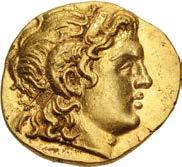

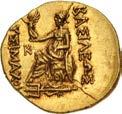

87. THRACE, Byzantion. Circa 190-175 BC. AV Stater (20mm, 8.51 g, 12h). In the name and types of Lysimachos. Diademed head of the deified Alexander right, with horn of Ammon / Athena Nikephoros seated left, left arm resting on shield, transverse spear in background; ! to inner left, ∫U below throne, ornate trident in exergue. Marinescu Issue 98, 237 var. (O92/R– [unlisted rev. die]); Müller 148; HGC 3, 1381. Underlying luster, trace deposits, die rust, die breaks on reverse. EF. ($2000)

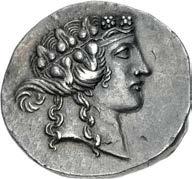

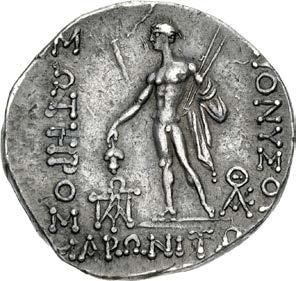
88. THRACE, Maroneia. Late 2nd-mid 1st centuries BC. AR Tetradrachm (31mm, 16.4 g, 1h). Wreathed head of young Dionysos right / Dionysos, nude, standing half-left, holding grapes and cradling narthex stalks; U to inner left, to inner right. Schönert-Geiss 1093.1 (V37/R107 – this coin); CN Online Type 2165; HGC 3, 1556. Attractive deep old cabinet tone, minor doubling on reverse. Good VF. ($1000)
Ex Leu Numismatik AG 15 (1 June 2024), lot 31; Hamburger 98 (3 April 1933), lot 528.
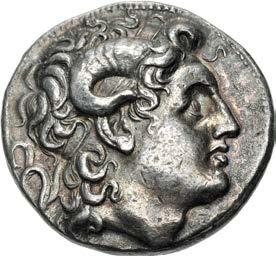
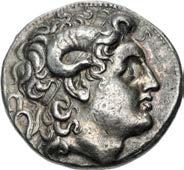
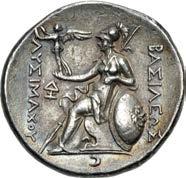
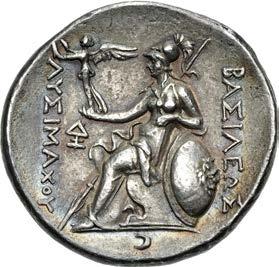
89. KINGS of THRACE, Macedonian. Lysimachos. 305-281 BC. AR Tetradrachm (29.5mm, 16.97 g, 12h). Lampsakos mint. Struck 297/6-282/1 BC. Diademed head of the deified Alexander right, with horn of Ammon / Athena Nikephoros seated left, left arm resting on shield, transverse spear in background; B to inner left, crescent in exergue. Thompson 49; Müller 399; HGC 3, 1750b. Deep iridescent tone. Good VF. ($1500)
Lysimachos, a Macedonian noble of great strength and stature, was born circa 360 BC and rose to prominence as a bodyguard for Alexander the Great, although he was a generation older than the young king. When Alexander’s territories were parceled out in 323 BC, Lysimachos was given control of Thrace, the Chersonese, and the intervening Black Sea coast. Much of this territory was claimed by various Thracian tribes, forcing him to spend decades in a largely fruitless effort to subdue them. By the time he assumed the royal title in 306/5 BC, his kingdom consisted of little more than the southern portions of Thrace. But he soon experienced a late-career revival as he plunged fully into the wars of the Diadochi, carving out an ever-expanding realm largely at the expense of his main rivals, Antigonos I Monophthalmos and his son Demetrios I Poliorketes. This territory was rich with both bullion and mint cities, enabling Lysimachos to begin striking a voluminous coinage on his behalf, initially patterned on the coins of Alexander, but with his own name and royal title. In 297 BC, he introduced a new type whose iconography would resound through the ages. The obverse was a portrait of the deified Alexander, diademed and bearing a ram’s horn sprouting from his temples, symbolic of the hybrid Greco-Egyptian god Ammon. This undoubtedly refers to one of the most famous episodes in Alexander’s legendary life: his visit to the shrine of Ammon in the Egyptian oasis of Siwa, in which the oracle greeted him as ‘my son.’ The reverse depicted Athena, Lysimachos’ patron goddess, seated on a massive throne and resting her arm on a shield. This vision of the seated warrior-goddess proved enduring and can still be seen as the figure of Britannia on modern coins. Dozens of mints produced Lysimachos types in both silver and gold and would continue to do so for decades after his own battlefield demise in 281 BC at the ripe age of 79. The range of styles varies greatly by mint, ranging from highly idealized to stunningly lifelike. G.K. Jenkins noted the power of the Alexander portrait in his commentary on the Gulbenkian Collection (vol. 2, p. 117): “[T]he best of the Alexander heads on Lysimachos’ coinage...have a power and brilliance of effect that is irresistible. It [is speculated] that these Alexander heads may have derived from an original gem carved by Pyrgoteles, an engraver prominent among the artists of Alexander’s court....” Regardless of the inspiration, part of the remarkable attraction of this coinage is its artistic variety, with each engraver creating his own fresh and distinctive portrayal of the world’s greatest conqueror.
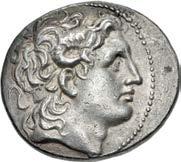
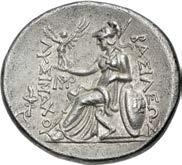
90. KINGS of THRACE, Macedonian. Lysimachos. 305-281 BC. AR Tetradrachm (29mm, 16.86 g, 12h). Magnesia on the Maeander mint. Struck circa 297/6-282/1 BC. Diademed head of the deified Alexander right, with horn of Ammon / Athena Nikephoros seated left, left arm resting on shield, transverse spear in background; filleted torch to outer left, Ì to inner left. Thompson 115 var. (monogram); Müller 443a var. (same); HGC 3, 1750e. Toned, with some peripheral iridescence, scattered marks and porosity, light scuffs and edge marks. VF. ($750)
From the Doctore Collection.
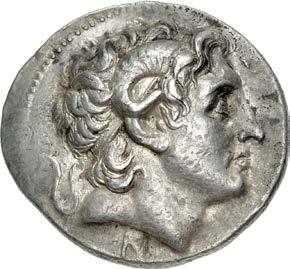

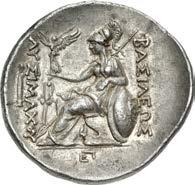
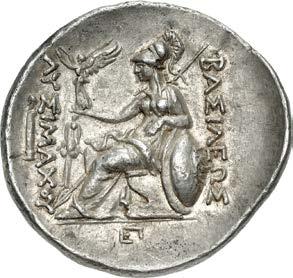
91. KINGS of THRACE, Macedonian. Lysimachos. 305-281 BC. AR Tetradrachm (31mm, 17.15 g, 12h). Pergamon mint. Struck circa 287/6-282 BC. Diademed head of the deified Alexander right, with horn of Ammon; ˚ below / Athena Nikephoros seated left, left arm resting on shield, transverse spear in background; herm to outer left, cult image to inner left, 2 in exergue. Arnold-Biucchi, Pergamene 58–61 var. (O10/R– [unlisted rev. die]); Thompson 224; Müller 287; HGC 3, 1750m. Toned, traces of find patina, a little die wear on obverse. Near EF. Beautiful style. ($1500)
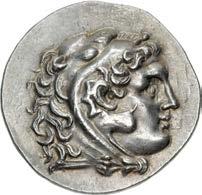
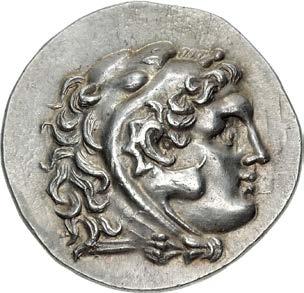

92. KINGS of THRACE, Celtic. Kavaros. Circa 230/25-218 BC. AR Tetradrachm (32.5mm, 16.78 g, 12h). In the name and types of Alexander III of Macedon. Kabyle mint. Head of Herakles right, wearing lion skin / Zeus Aëtophoros seated left; in left field, Artemis Phosphoros standing facing above A erased in die. Draganov 874–5 var. (O5/R– [unlisted rev. die]); Black Sea Hoard 6–17 (OA/R2); Price 883; Peykov F2010; HGC 3, 1355. Attractively toned, underlying luster, slight doubling on reverse. Near EF. ($500)
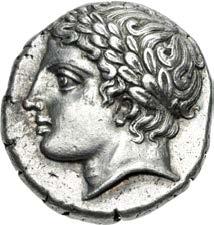



93. MACEDON, Chalkidian League. Circa 385 BC. AR Tetradrachm (23mm, 14.37 g, 9h). Olynthos mint. Laureate head of Apollo left / Kithara within incuse square. Robinson & Clement Group G, – (unlisted dies); AMNG III/2, 4; HGC 3, 497. Slight iridescent tone, underlying luster, trace deposits on obverse. EF. ($5000)
The Chalkidike is a three-fingered spit of land extending from eastern Macedon into the Aegean Sea. Wary of Athenian imperialism and the rising power of the Macedonian Kingdom, the free cities of the Chalkidike banded together in 432 BC to form a defensive coalition called the Chalkidian League, with its capital of Olynthos. The silver coinage struck at Olynthos was on the Macedonian standard, somewhat lighter than the Attic standard employed by most of Greece, and was legal tender at all cities belonging to the league. The standard design featured a head of Apollo, god of beauty, art and music, with a type of lyre called a kithara on the reverse. The Chalkidian League’s coinage came to an end with the capture and destruction of Olynthos by King Philip II of Macedon in 348 BC.

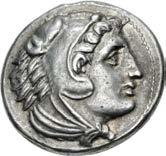


94. KINGS of MACEDON. Alexander III ‘the Great’. 336-323 BC. AR Tetradrachm (27mm, 17.22 g, 7h). Amphipolis mint. Struck under Antipater, circa 325-323/2 BC. Head of Herakles right, wearing lion skin / Zeus Aëtophoros seated left; to left, cock standing left. Price 79; Troxell, Studies, Issue E3. Toned, underlying luster, slight die shift on obverse, small flan flaw on reverse. Good VF. ($500)
From the GTP Collection. Ex Nomos 24 (22 May 2022), lot 67; Nomos 18 (5 May 2019), lot 78.

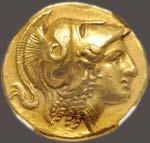

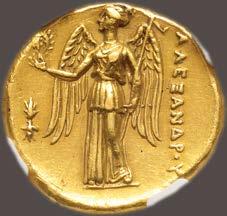
95. KINGS of MACEDON. Philip III Arrhidaios. 323-317 BC. AV Distater (22mm, 17.20 g). Amphipolis mint. Struck under Antipater or Polyperchon, circa 322-317 BC. Head of Athena right, wearing crested Corinthian helmet decorated with coiled serpent, single-pendant earring, and linear and pelleted necklaces / ŬE$Å@droU, Nike standing left, holding wreath in extended right hand and cradling stylis in left arm; vertical thunderbolt in left field. Price 163; Troxell, Studies, Group C, 545 (same dies). In NGC encapsulation 6158586-001, graded AU, Strike: 5/5, Surface: 2/5, ex-jewelry, scratches. Very rare posthumous Alexander III type distater issue. ($20,000)
Ex Dr. Hans Krähenbühl Collection (Leu Numismatik AG 8, 23 October 2021), lot 48; Münzen & Medaillen AG FPL 227 (November 1962), no. 434.
Troxell identified three separate groups of distater issues, the first two of which, Groups A and B, were either struck concurrently at different Macedonian mints, or sequentially at the primary Macedonian mint. Group C, she noted, was a later group, probably just after Alexander’s lifetime, that revived the markings from Group A, kantharos, trident, and fulmen. This group was only known to her from 17 coins, and, by virtue of die links, was obviously a very small, concentrated output that must have been undertaken for a very specific purpose.

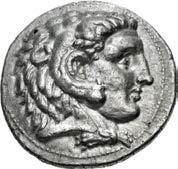


96. KINGS of MACEDON. Philip III Arrhidaios. 323-317 BC. AR Tetradrachm (29mm, 16.90 g, 6h). In the name and types of Alexander III. Tarsos mint. Struck under Philotas or Philoxenos. Head of Herakles right, wearing lion skin / Zeus Aëtophoros seated left; in left field, crowning Nike flying right above kerykeion; 2 below throne, Q in exergue. Price 3047; Newell, Tarsos 53, dies LVI/– (unlisted rev. die). Trace deposits, minor porosity, scratch on obverse. Good VF. ($500)
Born circa 359 BC, Arrhidaios was the illegitimate son of Philip II, king of Macedon, by a Thessalian dancer named Philinna. According to Plutarch, a poisoning attempt by Philip’s jealous wife, Olympias, left Arrhidaios mentally compromised and subject to epileptic fits. His halfbrother, Alexander III the Great, was quite fond of him and took him on all of his campaigns, although this was also a way of making sure he did not become a political pawn. When Alexander died in Babylon in June, 323 BC, a council of generals hammered out a compromise by which Arrhidaios was crowned as Philip III, to reign jointly with the infant son of the conqueror, Alexander IV. However, neither had any real power, this being held by a succession of regents. The new king proved as compliant and simple-minded as the generals had hoped, but in 320 BC, Arrhidaios married a niece of Philip II’s, Eurydike, who had enough ambition for the both of them. Eurydike plunged into the complex and deadly politics of the Diadochi. In 317 BC, she threw her support behind Kassander’s successful bid to become regent. Kassander left her and Arrhidaios in charge of Macedon while he went on campaign in Asia. However, Alexander’s mother Olympias raised her own army and invaded Macedon, capturing and ultimately executing the royal couple. The coinage of Philip III Arrhidaios is clearly based on that of Alexander, showing no innovations except for the name.


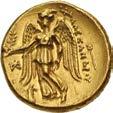
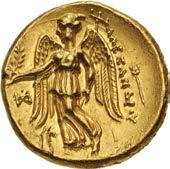
97. KINGS of MACEDON. Antigonos I Monophthalmos. As Strategos of Asia, 320-306/5 BC, or King, 306/5301 BC. AV Stater (18.5mm, 8.56 g, 12h). In the name and types of Alexander III. Abydos mint. Struck circa 310-301 BC. Helmeted head of Athena right / Nike standing left, holding wreath and stylis; ^ in left field; below left wing, head of griffin right; kerykeion to outer right. CNG 61, lot 440 (same dies); CNG 81, lot 334 = CNG 69, lot 171 (same dies); Roma E-Sale 82, lot 256 = CNG 99, lot 80 (same dies); otherwise unpublished, but same obv. die as ADM II Series XIX, 372b = illustration of Price 1557. Underlying luster, some light scratches and minor marks, bump at edge on obverse, slight die shift on reverse, edge marks. Near EF. Extremely rare, one of four known, all struck from the same die pair. ($3000)
Ex Numismatica Genevensis SA II (18 November 2002), lot 31.
After Perdikkas, Antigonos Monophthalmos was perhaps the most powerful of the Diadochs upon Alexander’s death. Having been entrusted with overseeing the Macedonian rule in Asia Minor, Antigonos was left in control of vast resources that enabled him to persevere through the wars of the Diadochs. At the height of his power, his territories stretched from the Hellespont to Babylon. While his military prowess was keen, so too were his diplomatic skills. In fact, it was his skill of using the other Diadochs against one another that was more attributable to his success in building his domains than his military victories. By 306 BC, Antigonos was so certain of his dominance that he proclaimed himself king, the first of the Diadochs to do so. It was this event, which he thought to be his triumphant moment, that proved his undoing. From that moment, the other Diadochs clearly saw Antigonos and his son, Demetrios Poliorketes, as their primary opponents. Putting aside their differences for the first time, all the other Diadochs – Ptolemy, Seleukos, Lysimachos, and Kassander – joined forces against Antigonos. For a year the allies pressured the Antigonid forces around the Aegaean. Finally, at the battle of Ipsos in 301 BC, Antigonos was defeated by the combined forces of Seleukos and Lysimachos. Antigonos was killed in the battle, but Demetrios was able to escape and continue fighting the others for years, though he never regained the sizeable territory that his father had once ruled.
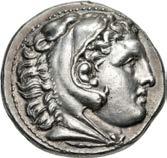
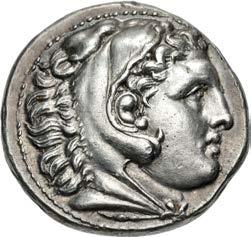

98. KINGS of MACEDON. Kassander. As regent, 317-305 BC. AR Tetradrachm (27mm, 17.22 g, 3h). In the name and types of Alexander III. Amphipolis mint. Struck circa 310-307 BC. Head of Herakles right, wearing lion skin / Zeus Aëtophoros seated left; in left field, ¬ above t above torch; E below throne. Price 440; Ehrhardt 20. Attractive light iridescent tone, some hairlines. Choice EF. ($1500)
Ex New York Sale LVII (10 January 2023), lot 31.
Kassander was the son of Alexander III’s regent in Macedon, Antipater. By the end of Alexander’s reign, Antipater had fallen under suspicion of treason, and thus the Macedonian king treated Kassander, who was with him in the East, disfavorably. Thankfully for Kassander, Alexander died before dealing with Antipater. At Triparadeisos, Kassander was named chiliarch, while his father remained regent in Macedon. Although Kassander wanted to succeed his father, when Antipater died, the regency was given to Polyperchon instead. In response, Kassander allied himself with the powerful Antigonos Monophthalmos, who supported him in establishing a power base in Piraios and the Peloponnesos. From these bases, Kassander launched invasions against Polyperchon, and eventually succeeded in overthrowing the regent in 317 BC. Kassander quickly established his firm dominion over Macedon, and had Alexander’s mother, Olympias, put to death. He also married Thessalonike, the daughter of Philip II, to ingratiate himself with the families who had long ties to Alexander’s father, and who exerted much power over the local countryside. His consolidation of power also included the murder of Alexander III’s wife, Roxane, and the young Alexander IV in 310 BC. His success in controlling Macedon, though, was seen as a threat by Antigonos, who still had the Macedonian throne as his own goal. In response to Kassander’s rise in Macedon, Antigonos proclaimed that the Greek cities were free from Macedonian control, an act that ingratiated him to them. Antigonos used their gratitude to foment dissent againt Kassander throughout Greece and Peloponnesos. Antigonos also allied himself to Polyperchon, who had sought refuge in the Peloponnesos, and now supported his attempts to overthow Kassander. Although he lost power in Greece, Kassander maintained his control of Macedon thoughout the Diadochi Wars. He died of dropsy in 298 BC.
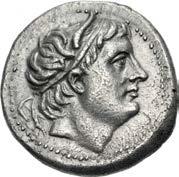
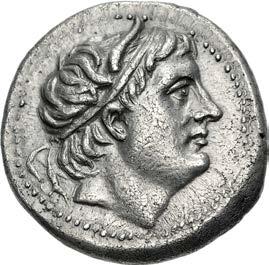

99. KINGS of MACEDON. Demetrios I Poliorketes. 306-283 BC. AR Tetradrachm (29mm, 16.83 g, 4h). Thebes mint. Struck circa 290 BC. Diademed and horned head right / Poseidon Pelagaios standing left, foot on globe, holding trident; between feet. Newell 139, dies CXXXIX/283; HGC 3, 1014d. Toned, granular surfaces, small scuff on obverse, edge marks. Good VF. Extremely rare issue, only one example known to Newell, none in CoinArchives. ($1500)
Demetrios I Poliorketes was the son of one of Alexander’s greatest generals, Antigonos I Monophthalmos. Antigonos was arguably the strongest of Alexander’s followers, the Diadochs, at one time ruling over all of Alexander’s eastern territories from Asia Minor to Baktria, except for Egypt. Antigonos’ success led him to be the first Diadoch to crown himself king, in 306 BC. By that time, Demetrios was an active participant in his father’s wars and was also crowned king along with his father. Fearing Antigonos’ growing power, the other Diadochs allied themselves against him, and finally defeated and killed him at the battle of Ipsos in 301 BC. Following Ipsos, Demetrios continued to battle the other Diadochs, and although he won numerous victories, he was usually unable to maintain his control over his conquests afterward. His epithet, Poliorketes (‘besieger of cities’) was earned following his siege of Rhodes. While that siege ultimately failed, it featured a number of elaborate siege engines which had become a hallmark of Demetrios’ style of warfare. Demetrios was eventually abandoned by his army, and he subsequently surrendered to Seleukos I of Syria in 288 BC. Demetrios died in captivity five years later


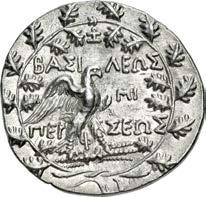
100. KINGS of MACEDON. Perseus. 179-168 BC. AR Tetradrachm (33mm, 16.82 g, 11h). Attic standard. Amphipolis mint. Struck circa 179-171 BC. Diademed head right / Eagle, wings spread, standing right on thunderbolt; g above, Â5 to right, f below; all within oak wreath; below, plow right. De Luca, Tetradrachms 112 (O27/R100); Mamroth, Perseus 8; HGC 3, 1091. Slight die wear and a couple of minor marks on reverse. Good VF. ($1000)
The last independent king of Macedon, Perseus was the eldest son of the dynamic but disastrous Philip V. Inheriting the throne in 179 BC, Perseus skillfully rebuilt the Macedonian army and a network of marriage alliances during the first years of his reign, which the Romans watched with rising alarm. In 172 BC the Romans sent a commission to Macedon and demanded that Perseus essentially end Macedonian independence and become a Roman vassal. Perseus angrily rebuffed their demands, sparking the outbreak of the Third Macedonian War in 171 BC. For a time, Perseus employed guerrilla tactics which gave him the initiative and kept the Romans on their heels. An initial battle at Kallinikos in Thessaly was a narrow Macedonian victory, leading Perseus to become overconfident of Macedonian arms and his own generalship. Like his father, Perseus chose to risk all in a single pitched battle at Pydna in 168 BC but lost badly to the Roman general Lucius Aemilius Paullus. With his army shattered, Perseus surrendered and was taken to Rome, where he was led in chains in Paullus’ triumph. Accounts of his remaining life differ; according to one account, he remained imprisoned until he died after two years of abuse and neglect. But another tradition holds that he was allowed to live in comfortable exile at Alba Fucens outside of Rome, where his son Alexander became a metalworker and a Roman public notary. The Macedonian Kingdom was divided into four theoretically autonomous Republics which were soon subsumed into direct Roman rule.
The coinage of Perseus is one of the more attractive of the Hellenistic series, with strong portraiture depicting Perseus as a determined ruler with a piercing gaze and a stubbly beard. The reverse depicts the Macedonian eagle on a thunderbolt. Two weight standards are recorded, with the weight of the tetradrachm being reduced by about 10% after the war with Rome commenced, likely to stretch the silver supply.


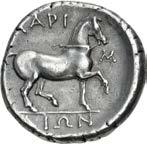
101. THESSALY, Larissa. Circa 356-342 BC. AR Stater (23.5mm, 12.26 g, 6h). Head of the nymph Larissa facing slightly left, hair in ampyx / Bridled horse prancing right. L-S Type II, Series A, dies O6/R4; Lorber, Hoard, 66 (same dies); BCD Thessaly I 1160 (same obv. die); HGC 4, 409. Toned, a little die wear on obverse, slight die shift on reverse. Good VF. ($2000)
The name Larissa likely derives from a pre-Greek word for “citadel” or “fortress.” One of the largest cities in Thessaly, Larissa produced a large and varied coinage beginning in the early-fifth century BC, mostly featuring the hero Thessalos wrestling a bull. Starting about 404 BC, inspired by Kimon’s Syracusan facing-head portrait of the spring nymph Arethousa, Larissa introduced a new design also featuring a facing female head, probably intended to represent a local spring nymph bearing the city’s name. The nymph heads feature on nearly all Larissan coinage, including bronzes, tiny fractions, silver drachms (by far the most numerous coins struck and surviving), and staters of two drachms. The larger staters, in particular, are closely modeled on Kimon’s Arethousa, lacking only the dolphins surrounding the portrait on the original.
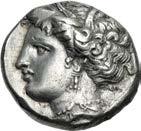


102. LOKRIS, Lokri Opuntii. Circa 370-360 BC. AR Stater (23mm, 11.98 g, 11h). Wreathed head of Persephone left / Ajax, nude but for crested Corinthian helmet, holding sword, shield decorated with coiled serpent on arm, advancing right on rocks; below, Phrygian helmet right. H&D Group 3, 16a (O1/R6 – this coin, illustrated); BCD Lokris 14; HGC 4, 989. Lightly toned, areas of roughness, marks, indications of overstriking on obverse. VF. ($1500)
Ex Classical Numismatic Group 51 (15 September 1999), lot 268; Numismatic Fine Arts XVI (2 December 1985), lot 162.



103. LOKRIS, Lokri Opuntii. Circa 370-360 BC. AR Stater (22mm, 11.68 g, 1h). Wreathed head of Persephone left / Ajax, nude but for crested Corinthian helmet, holding sword, shield decorated with coiled serpent on arm, advancing right on rocks; laurel wreath to upper left. H&D Group 7, 88a (O9/R21 – this coin, illustrated); BCD Lokris 19 (same rev. die); HGC 4, 989. Deep old collection tone, some roughness and delamination on obverse. Good VF. ($3000)
Ex Virgil M. Brand Collection (Part 5, Sotheby’s, 1 February 1984), lot 132; J. Hirsch XXXIII (17 November 1913), lot 704 (reportedly ex von Schennis per Brand catalog); Consul Eduard Friedrich Weber Collection (J. Hirsch XXI, 16 November 1908), lot 1496.



104. BOEOTIA, Thebes. Circa 425-400 BC. AR Stater (19mm, 12.45 g). Boeotian shield / Amphora; grape bunch on vine to left; all within incuse square. BCD Boiotia 397 var. (incuse circle); HGC 4, 1325. Light iridescent tone, underlying luster, irregular flan, a little die wear on obverse. Near EF. ($750)
Ex Heritage 3021 (6 January 2013), lot 21188; Heritage 3015 (7 September 2011), lot 23080.


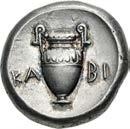

105. BOEOTIA, Thebes. Circa 368-364 BC. AR Stater (21mm, 12.29 g). Kabi–, magistrate. Boeotian shield / Amphora within concave circle. Hepworth 61; BCD Boiotia 539; HGC 4, 1333. Iridescent tone. Good VF. Attractive in hand. ($1000)
From the Kelly Ramage Collection. Ex Classical Numismatic Group 84 (5 May 2010), lot 438.
The staters of the Boiotian Confederacy of the 4th century are well known to numismatists. These staters, struck on the Aiginetic standard, bear on the obverse the usual Boiotian shield and on the reverse an amphora, with the addition of magistrate names and, on occasion, vines hanging from the handles or extra symbols around the amphora. Although the coins do not bear the mark of an issuing city, Thebes, as hegemon of the Boiotian Confederacy, was most likely responsible for their issuance. In his study of the series, “The 4th Century BC Magistrate Coinage of the Boiotian Confederacy,” Numismatica Khronika (1998), R. Hepworth has identified 44 different magistrates and 97 separate varieties. The series begins in the early years of the 4th century and ends at the Battle of Khaironeia in 338 BC.
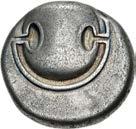

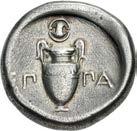
106. BOEOTIA, Thebes. Circa 364-362 BC. AR Stater (22mm, 11.85 g). Epa(minondas), magistrate. Boeotian shield / Amphora; Boeotian shield above, Eπ-πÅ across central field; all within concave circle. Hepworth, Epaminondas, pl. 3, 4; Hepworth 35; BCD Boiotia 542; HGC 4, 1333. Iridescent tone, granular surfaces, a little off center, a few faint scratches on reverse. VF. ($750)
From a New Zealand Collection. Ex Freeman & Sear 5 (14 May 1999), lot 249; Freeman & Sear 3 (10 December 1996), lot 242.
There are times when some of us wonder what the world would be like today if Alexander the Great had lived to a ripe old age. The same kind of “What if ...” thinking could be applied to Epaminondas. His premature death on the battlefield of Mantineia in 362 BC deprived Thebes of its greatest statesman and soldier, signalling the start of Thebes’ rapid decline into obscurity. If Epaminondas had lived to reap the benefits of his Mantineian victory, he would have undoubtedly proceeded to unite all Greece under his leadership. The next step would be to turn to the North and face Philip who, instead of finding a divided Greece ready for the taking, would think twice before attempting to invade Thessaly. Whether then there would be a clash between the two emerging superpowers or a truce between them, is anybody’s guess. Perhaps Philip would remember the years he spent as a hostage in Thebes and his respect for the Theban statesman would prevail. The conquest of Asia would then materialize sooner and in a more permanent manner. But, like many great soldiers, Epaminondas inspired his men by leading them into battle and, instead of capitalizing on his genius, Thebes paid the price for his bravery.
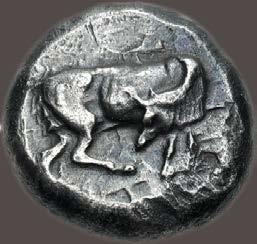

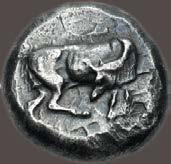
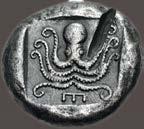

107. EUBOIA, Eretria. Circa 500-465 BC. AR Tetradrachm (23mm, 17.26 g, 6h). Cow standing right, head left, nibbling on small plant below; swallow standing right upon cow’s back / Octopus; horizontal E below; all within incuse square. BCD Euboia 309; HGC 4, 1502. Toned, some iridescence, struck with worn obverse die, some light smoothing on obverse, test cut on reverse. VF. Rare. ($7500)


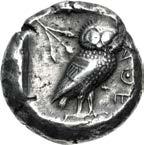
108. ATTICA, Athens. Circa 500/490-485/0 BC. AR Tetradrachm (23mm, 17.05 g, 11h). Helmeted head of Athena right, with frontal eye / Owl standing right, head facing; olive spray to left; all within incuse square. Seltman Group M or G (unlisted dies); HGC 4, 1590. Old cabinet toned, minor flan flaws and die wear on obverse, feathers tooled in wing on reverse. VF. ($3000)
Ex Ars Classica XII (18 October 1926), lot 1408 (with tooling present).
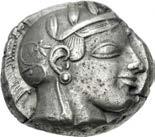
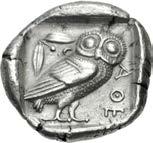
109. ATTICA, Athens. Circa 465/2-454 BC. AR Tetradrachm (25mm, 17.14 g, 7h). Helmeted head of Athena right, with frontal eye / Owl standing right, head facing, with spread tail feathers; olive spray and crescent to left; all within incuse square. Starr Group V.B, unlisted dies; HGC 4, 1596. Toned, areas of granularity, some die wear on reverse. Near EF. Well centered. ($1000)


110. ATTICA, Athens. Circa 454-404 BC. AR Tetradrachm (24mm, 17.20 g, 4h). Helmeted head of Athena right, with frontal eye / Owl standing right, head facing, closed tail feathers; olive spray and crescent to left; all within incuse square. Starr pl. XXIII, 1’–3’; Kroll 8; HGC 4, 1597; Dewing 1593; Gulbenkian 518. Edge split, slightly off center on reverse. Near EF. ($1000)
Certain elements of the style of this tetradrachm, particularly the palmette on Athena’s helmet and the stance of the owl, suggest that this coin was among the earliest issues in the ubiquitous “frontal eye”/classical tetradrachms of the mid-late 5th century at Athens, as these features more closely resemble those found on the later groups of early-mid 5th century issues analyzed by Chester Starr.


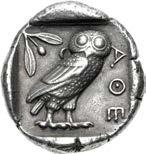
111. ATTICA, Athens. Circa 454-404 BC. AR Tetradrachm (24mm, 17.20 g, 2h). Helmeted head of Athena right, with frontal eye / Owl standing right, head facing, closed tail feathers; olive spray and crescent to left; all within incuse square. Kroll 8; HGC 4, 1597. Toned, die break on obverse, a couple of minor marks on reverse. Good VF. Attractive early style. ($1000)
Ex Classical Numismatic Group 105 (10 May 2017), lot 109.
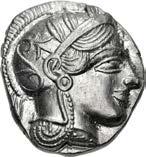


112. ATTICA, Athens. Circa 454-404 BC. AR Tetradrachm (24mm, 17.20 g, 4h). Helmeted head of Athena right, with frontal eye / Owl standing right, head facing, closed tail feathers; olive spray and crescent to left; all within incuse square. Kroll 8; HGC 4, 1597. Lustrous, a little die wear on obverse, minor doubling on reverse. Superb EF. ($1000)

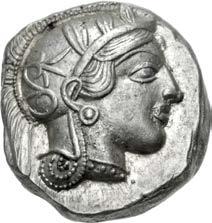

113. ATTICA, Athens. Circa 454-404 BC. AR Tetradrachm (22.5mm, 17.20 g, 8h). Helmeted head of Athena right, with frontal eye / Owl standing right, head facing, closed tail feathers; olive spray and crescent to left; all within incuse square. Kroll 8; HGC 4, 1597. Lightly toned, some die wear on obverse, a few tiny flan flaws on reverse. EF. ($1000)


114. ATTICA, Athens. Circa 454-404 BC. AR Tetradrachm (24mm, 17.20 g, 4h). Helmeted head of Athena right, with frontal eye / Owl standing right, head facing, closed tail feathers; olive spray and crescent to left; all within incuse square. Kroll 8; HGC 4, 1597. Faintly toned, underlying luster, minor die break in field on obverse. EF. ($750)

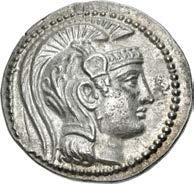
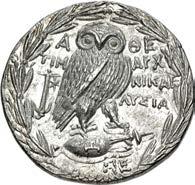

115. ATTICA, Athens. Circa 165-42 BC. AR Tetradrachm (31.5mm, 16.84 g, 12h). New Style coinage. Timarchos, Nikag–, and Lysia–, magistrates. Struck 134/3 BC. Helmeted head of Athena Parthenos right / Owl standing right, head facing, on amphora; magistrates’ names in fields, anchor and star to left, z on amphora, ÂE below; all within wreath. Thompson 364d (same obv. die); HGC 4, 1602. Light iridescent tone, underlying luster, trace deposits, some doubling on reverse. EF. ($1000)
Ex Heritage 311 (11 January 2003), lot 14214.

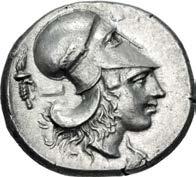

116. CORINTHIA, Corinth. Circa 400-350/45 BC. AR Stater (20.5mm, 8.46 g, 11h). Pegasos flying left / Helmeted head of Athena right; to left, hand left, holding torch; facing boukranion to lower right. Ravel Period IV, 401 (P198/T288); Pegasi 116; BCD Corinth –; HGC 4, 1833 corr. (illustration numbered 1834); SNG Fitzwilliam 3344 (same dies); Jameson 2499 (same dies). Toned, remnants of find patina, minor marks, some die wear. Near EF. ($750)
From the JTB Collection. Ex Leu Numismatik AG Web Auction 25 (11 March 2023), lot 506.

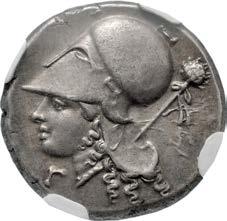

117. CORINTHIA, Corinth. Circa 350/45-285 BC. AR Stater (20mm, 8.53 g, 4h). Pegasos flying left / Helmeted head of Athena left; ˝ below chin, filleted thyrsos to right. Ravel Period V, 1025; Pegasi 416; BCD Corinth 109; HGC 4, 1848. In NGC encapsulation 4373046-006, graded AU★, Strike: 5/5, Surface: 5/5. ($1000)
Ex Dr. Michael Popoff Collection (Stack’s Bowers Galleries, 12 January 2017), lot 5071; NBD Bank Money Museum Collection (Craig A. Whitford [3], 30 November 1992), lot 81.
Located at the southern end of the isthmus bearing its name, the city of Corinth was served by two ports. Kenchreai, the eastern port, was located in the Saronic Gulf and served shipping from Athens and points east, while Lechaion was the city’s western port, located in the Gulf of Corinth.

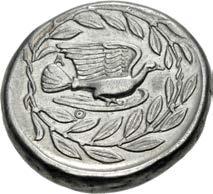
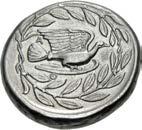
118. SIKYONIA, Sikyon. Circa 350-340 BC. AR Stater (23mm, 12.18 g, 6h). Chimaera standing right; wreath above, s5 below / Dove flying right; Å above tail, Q below; all within wreath. BCD Peloponnesos 222.4 (same dies); HGC 5, 198 (same dies as illustration). Lightly toned, with some iridescence, a little die wear and scratches on obverse. Good VF. Well centered. Extremely rare with types right. ($2000)
Ex Classical Numismatic Group 67 (22 September 2004), lot 593; Tkalec (18 February 2002), lot 49.



119. SIKYONIA, Sikyon. Circa 335-330 BC. AR Stater (24mm, 12.21 g, 9h). Chimaera standing left; wreath above, sE below / Dove flying left; @ to left; all within wreath. BCD Peloponnesos 218; HGC 5, 201. Lovely iridescent tone, underlying luster. EF. A wonderful coin in hand. ($3000)
Ex Künker 382 (16 March 2023), lot 119; Münzen und Medaillen AG 85 (11 April 1997), lot 92; Numismatica Ars Classica 8 (3 April 1995), lot 258.
Located in the northeast of the Peloponnesos, Sikyonia was a fertile territory stretching some sixteen miles. Sikyon, the area’s most important city and one of the Mediterranean’s most well-renowned artistic centers, was the site where legend holds that Prometheus famously deceived Zeus. The city joined Sparta during the Peloponnesian War and provided the bulk of the coinage used by the Peloponnesian League. In 303 BC, Demetrios Poliorketes re-founded Sikyon further inland, giving it the short-lived name of Demetrias. Sikyon’s output of coinage was large and uninterrupted from the 5th-1st centuries BC. The city’s status was diminished when Corinth was made a Roman colony and, aside from a small issue under Nero, Sikyon did not mint coins again until the reign of Septimius Severus.
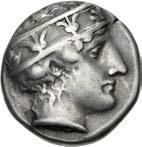

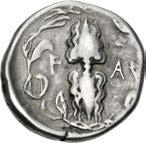
120. ELIS, Olympia. 94th Olympiad. 404 BC. AR Tetradrachm (23mm, 11.86 g, 4h). “Hera” mint. Head of Hera right, wearing stephane ornamented with three palmettes / Vertical flaming thunderbolt within olive wreath. Seltman, Temple 265b (dies EH/ηο) = Ward 538 (this coin, rev. illustrating the die in Seltman); BCD Olympia –; HGC 5, 351. Light iridescent tone, some weakness to strike, scratches and slightly off center on reverse, Ward collection number in ink on edge. Near VF. ($1500)
Ex New York Sale XVII (9 January 2008), lot 62; Morton & Eden 14 (25 May 2005), lot 1049; Metropolitan Museum of Art Collection (Part II, Sotheby’s Zurich, 4 April 1973), lot 447; John Ward Collection (publ. 1901).
Located on the northwest corner of the Peloponnesos, the sacred shrine of Olympia became established as the site of the most important Greek festival of athletics in the eighth century BC. The first Olympic Games were held in 776 BC, consisting solely of a foot race, or stadion, won in that year by Koroibus of Elis. As time went on, more events were added, including wrestling, boxing, long jump, javelin, discus, and chariot races. The contests became so important that Greek cities at war would declare a temporary truce to allow athletes to cross their lines. Soon a permanent complex was built to house the games, and a magnificent temple of Zeus containing a statue ranked as one of the Seven Wonders of the World was completed in 463 BC. The first coins of Olympia date to the games of 468 BC, and new types were issued at four year intervals (to coincide with the games) thereafter. Three basic types were struck, depicting a head of Zeus, Hera, or an eagle. The finest die engravers were employed in their production and coins of Olympia rank as some of the greatest masterpieces of Greek coinage.




121. ARKADIA, Stymphalos. Circa 350-340 BC. AR Obol (12mm, 0.89 g, 9h). Head of Herakles right, wearing lion skin / Head of water bird without crest right. BCD Peloponnesos 1697 (same rev. die); Traeger, Arkadien 605 (same rev. die); HGC 5, 1028. Faintly toned, trace deposits, light granularity, a little die wear on reverse. EF. ($1000)
Ex Roma XXII (7 October 2021), lot 198; Gorny & Mosch 265 (14 October 2019), lot 332.
Stymphalos produced a remarkable series of silver staters, hemidrachms, and obols during the mid 4th century BC. The staters must have been used for the building expenses of the new city, which replaced the till now undiscovered old city in the 360s; the obols would have been used to pay the workers involved. Very few of those pieces have managed to survive, most being in the BCD collection. While most of the obols suffer from poor striking or degraded dies, this piece is particularly fine.
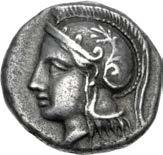
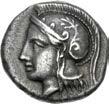

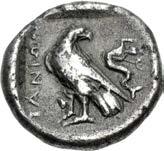
122. CRETE, Itanos. Circa 370-360 BC. AR Drachm (17.5mm, 5.16 g, 6h). Helmeted head of Athena left / Eagle standing left, head right; in right field, Triton upward, holding trident; all within incuse square. Puleo Period II, Series V; Svoronos, Numismatique 36; SNG Copenhagen 475. Deeply toned, remnants of find patina. VF. Well centered. ($750)
Purchased by the consignor from R. M. Smythe, 2002. Ex Apostolo Zeno (†1750) Collection (Part III, Dorotheum, 26 March 1957), lot 3872.

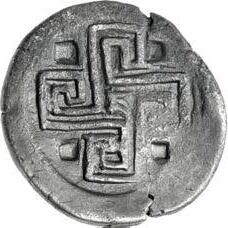
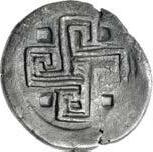
123. CRETE, Knossos. Circa 320-300 BC. AR Stater (24mm, 10.15 g, 8h). Head of female (Demeter or Persephone) left / Labyrinth in the form of a swastika, ˚ at center; four small incuse squares at corners; all within shallow incuse circle. Svoronos, Numismatique 40/41 (for obv. die/rev. type); Le Rider, Cretoises pl. VII, 1 (same obv. die) and pl. XXXII, 22 (same rev. die); SNG Copenhagen –. Deeply toned, flan crack, light roughness, area of weak strike, minor edge splits, graffiti in field on obverse. VF. ($3000)
Ex Davissons 40 (3 March 2021), lot 60; Stack’s Bowers Galleries (17 January 2020), lot 20034.
According to the Greek myth, Minos was the first king of Crete. Although he gave the island its first constitution, ordered the construction of the palace at Knossos, and was the first to build a navy, he was a cruel tyrant and imperialist. One of his subject cities was Athens. He demanded from its citizens as payment every nine years seven youths and seven virgins. Minos would feed them then to the Minotaur, a halfman, half-bull who was held in the Labyrinth, a large walled maze. To stop this brutal tribute, the Athenian hero, Theseus, had himself sent as part of the required tribute. With the assistance of Ariadne, the daughter of Minos, Theseus was able to navigate the Labyrinth successfully and kill the Minotaur.


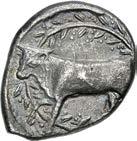
124. CRETE, Phaistos. Circa 330-320 BC. AR Stater (23.5mm, 10.66 g, 6h). Herakles, nude, standing facing, leaning on club and holding bow; lion skin to left, coiled serpent and laurel branch to right / Bull walking left within wreath. Svoronos, Numismatique 17; Le Rider, Crétoises, pl. III, 22 (same rev. die) and pl. XXI, 18 (same obv. die); SNG Copenhagen –. Deep iridescent tone, irregular flan, granular surfaces, flan flaw on obverse. VF. Rare. ($1000)
From the Kelly Ramage Collection. Ex Arnold Mallinson Collection (Spink 39, 6 December 1984), lot 51; Pilartz XVII (7 March 1968), lot 32.


125. CYCLADES, Melos. Circa 460-450 BC. Fourrée Stater (19mm, 10.30 g). Apple on stem with two leaves / Quadripartite incuse circle, pellets along periphery of quarters. For prototype: cf. Sheedy Series IV, 20–3; cf. HGC 6, 789. Lightly toned, breaks in plating exposing core. VF. Extremely rare, especially as a fourrée. ($1500)
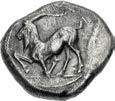
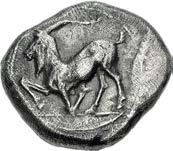

126. CYCLADES, Paros. Circa 485-480 BC. AR Drachm (19mm, 5.74 g). Goat kneeling left / Rough incuse square. Sheedy Class B, Group 2, 14 var. (O11/R– [unlisted rev. die]); HGC 6, 657; CH III, fig. 1, 10 (same obv. die). Toned, remnants of find patina, granular surfaces, a little off center and die break on obverse. Good VF. Very rare with type left and nonquadripartite incuse. ($1500)
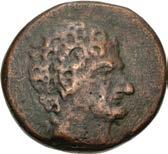


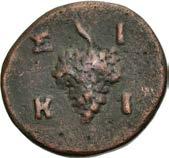
127. CYCLADES, Sikinos. 3rd century BC. Æ (18.5mm, 3.99 g, 1h). Bare head of male right / Grape bunch. HGC 6, 852 corr. (obv. type); Hunterian 1; BN Fonds général 385. Brown surfaces, trace green deposits, minor pitting, light cleaning scratches. VF. Extremely rare. ($500)
The references identify the obverse as the head of Dionysos, wearing ivy wreath, but no published examples clearly show a wreath due to their poor condition. The present coin, however, retains enough detail to doubt that a wreath is present on this type, so the identification of the portrait remains unknown.

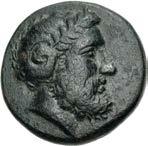

128. CYCLADES, Tenos. Circa 288-250 BC. Æ (16mm, 4.31 g, 1h). Head of Zeus-Ammon right / Grape bunch on vine. É&A-G 110, Type I, Group a, 2 (same obv. die); HGC 6, 744. Dark green-brown patina, slightly off center on reverse. VF. ($500)




129. CIMMERIAN BOSPOROS, The Sindoi. Circa 400 BC. AR Obol (8mm, 0.69 g, 7h). Gorgippa mint. Griffin seated right; barley grain to right / Head of horse right within incuse square. Cf. Frolova, frühe, Type V (unlisted denomination); cf. Anokhin 1200 (hemiobol); cf. MacDonald 84 (same); cf. HGC 7, 6 (same). Find patina, some roughness, cleaning marks on surface and edge. VF. Unpublished as an obol. ($500)
From the Kelly Ramage Collection.
Cited by Callataÿ


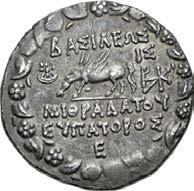

130. KINGS of PONTOS. Mithradates VI Eupator. Circa 120-63 BC. AR Tetradrachm (29.5mm, 16.56 g, 12h). Pergamon mint. Dated month 5, year 210 BE (February 87 BC). Diademed head right / Pegasos grazing left; star-in-crescent to left; to right, 5s (year) above Ú; E (month) in exergue; all within Dionysiac wreath of ivy and fruit. Callataÿ p. 12, dies D62/R2, b (this coin, incorrect weight recorded); HGC 7, 338; DCA2 555. Deep iridescent tone, a hint of porosity, small mark on obverse. Good VF. ($2000)
From the JTB Collection. Ex Leu Numismatik AG Web Auction 24 (3 December 2022), lot 71; Superior (13 August 1995), lot 1074; Giessener Münzhandlung 24 (14 March 1983), lot 34.
Soon after coming to power as king of the Black Sea backwater of Pontos, Mithradates VI showed signs of an ambition that the borders of his small kingdom could not contain. Frustrated that Rome controlled most of the territories he had marked out for conquest, he cannily observed the growing resentment that greedy Roman businessmen and magistrates were earning in Asia Minor and portrayed himself as the means by which the Greek world would gain its vengeance and freedom. He invaded Rome’s Asia province in 88 BC and precipitated the massacre of 80,000 Italian residents. He next invaded Greece proper, but was met there and defeated by Roman legions under Sulla. A revolution in Rome, however, forced Sulla to cut a quick deal with Mithradates and return to Italy. A decade later, Mithradates was at it again, attacking the Roman protectorate of Bithynia and drawing a response from the general Lucullus. Again, Mithradates suffered humiliating defeat and he slipped away to fight another day. The Third Mithradatic War (73-66 BC) was another brutal back-and-forth affair finally brought to an end by Pompey the Great. Yet again, Mithradates escaped and was planning another war when his own son, Pharnakes II, led a rebellion that trapped him in the citadel of Pantikapaion. Mithradates tried to take poison to avoid capture, only to find his attempts to immunize himself by taking small amounts of poison over the years had been all too successful. He finally induced a loyal Gallic swordsman to run him through instead.


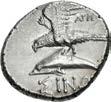

131. PAPHLAGONIA, Sinope. Circa 350/30-300 BC. AR Siglos or Drachm (18.5mm, 4.99 g, 6h). Persic standard. Agreos, magistrate. Head of nymph left, hair in sakkos / Sea-eagle standing left, wings spread, on dolphin left. RG 34; HGC 7, 399; SNG BM 1482 (same dies). Lightly toned, underlying luster, slight die shift, a little off center on reverse. EF. ($500)
Pedigreed to 1963




132. PAPHLAGONIA, Sinope. Circa 425-410 BC. AR Drachm (19mm, 6.12 g). Head of sea-eagle left; below, dolphin left / Quadripartite incuse square with two opposing quarters filled, d in one of the others. RG –; HGC 7, 388 var. (pellet in quarters); SNG BM Black Sea 1370 var. (letter on rev.). Attractive light toning, faint mark on reverse. Good VF. Extremely rare variety with this letter on reverse, one of only two in CoinArchives (the other: CNG E-563, lot 162). ($5000)
Ex Phillips Family Collection; Nomos 20 (10 July 2020), lot 167; Hess-Divo 329 (17 November 2015), lot 84; Numismatic Fine Arts XVIII (31 March 1987), lot 169; Richard A. van Every Collection (Leu 15, 4 May 1976), lot 272; Glendining (9 July 1963), lot 97.
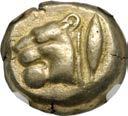


133. MYSIA, Kyzikos. Circa 550-450 BC. EL Stater (18mm, 16.06 g). Head of lion left; to right, tunny upward / Quadripartite incuse square. Von Fritze I 39; Greenwell 115; Boston MFA 1414 = Warren 1537; SNG BN 178. In NGC encapsulation 6766313-008, graded VF, Strike: 5/5, Surface: 4/5, edge tap. ($2000)
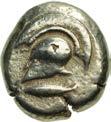
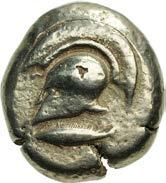

134. MYSIA, Kyzikos. Circa 550-450 BC. EL Stater (17mm, 16.07 g). Corinthian helmet with large crest to left; below, tunny left / Quadrapartite incuse square. Von Fritze I 81; Greenwell 171; Boston MFA –; SNG BN –. Minor edge splits, banker’s mark on obverse. VF. Very rare. ($2000)
Ex Classical Numismatic Group Electronic Auction 453 (2 October 2019), lot 90.


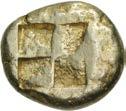
135. MYSIA, Kyzikos. Circa 550-450 BC. EL Stater (20mm, 16.09 g). Sow standing left on tunny left / Quadripartite incuse square. Von Fritze I 45; Greenwell 135; cf. Boston MFA 1465 (hekte); SNG BN 184. VF. ($3000)
From the Deer Creek Collection. Ex Siren Collection (Classical Numismatic Group 114, 13 May 2020), lot 228.

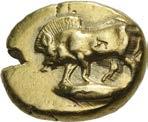

136. MYSIA, Kyzikos. Circa 550-450 BC. EL Hekte – Sixth Stater (12.5mm, 2.65 g). Boar standing left on tunny left / Quadripartite incuse square. Von Fritze I 90; Boston MFA 1465 = Warren 1561; SNG BN 225-6. Edge split, banker’s mark and a few light hairlines on obverse. Good VF. ($750)
From the Deer Creek Collection. Ex Windmill Collection (Classical Numismatic Group Electronic Auction 503, 3 November 2021), lot 4.

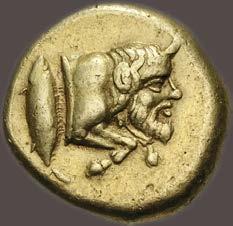

137. MYSIA, Kyzikos. Circa 550-450 BC. EL Stater (18mm, 16.10 g). Forepart of man-headed bull right; to left, tunny upward / Quadripartite incuse square. Von Fritze I 174; Greenwell 51; Boston MFA 1491 = Warren 1468; SNG BN 320. Lightly toned, a few minor marks. VF. Well centered and struck. Rare. ($10,000)
From the Deer Creek Collection. Ex Jonathan P. Rosen Collection (Triton XXV, 11 January 2022), lot 620; Gorny & Mosch 207 (15 October 2012), lot 266.
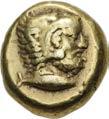
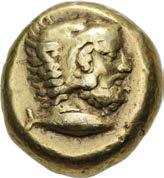

138. MYSIA, Kyzikos. Circa 450-330 BC. EL Stater (17mm, 15.96 g). Head of Herakles right, wearing lion skin; below, tunny right / Quadripartite incuse square. Von Fritze I 140; Greenwell 62; Boston MFA 1526 = Warren 1474; SNG BN 289. Lightly toned, trace deposits, light marks on obverse. VF. ($6000)
Ex Grapevine Collection; Classical Numismatic Group 84 (5 May 2010), lot 614; Goldberg 53 (25 May 2009), lot 1679; Berk BBS 112 (13 January 2000), lot 5; Münzen und Medaillen AG 41 (18 June 1970), lot 141.


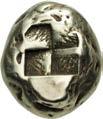
139. MYSIA, Kyzikos. Circa 450-330 BC. EL Stater (16.5mm, 16.01 g). The infant Herakles strangling the serpents of Hera, while his brother Iphikles cowers in the background to right; below, tunny left / Quadripartite incuse square. Von Fritze I 208; Greenwell 63; Boston MFA 1531 = Warren 1477; SNG BN 341. Lightly toned. Near VF. Well centered. ($5000)
Ex Grapevine Collection, purchased from Fred Shore.



140. MYSIA, Kyzikos. Circa 550-450 BC. EL Hemihekte – Twelfth Stater (8.5mm, 1.32 g). Laureate head of Zeus facing slightly right; below, tunny right / Quadripartite incuse square. Cf. Von Fritze I 182 (unlisted denomination); Boston MFA –; SNG BN –; Leu 57, lot 100 = Dix Noonan Webb A10, lot 1018; Nomos 35, lot 381. Some marks, slightly off center on obverse, light scratches on reverse. VF. Extremely rare, the third known hemihekte for this issue. ($750)

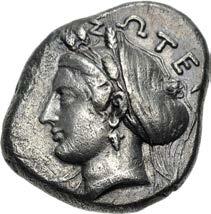
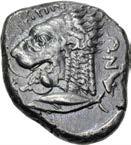
141. MYSIA, Kyzikos. Circa 410-390 BC. AR Tetradrachm (22mm, 14.68 g, 5h). Wreathed head of Kore Soteira left, hair in sphendone covered with veil / Head of lion left; below, tunny left; to lower right, dolphin downward. Pixodarus Type 1; SNG BN –; SNG Copenhagen –; SNG von Aulock –; Peus 396, lot 340. Darkly toned, minor porosity, double struck on reverse. VF. Extremely rare with dolphin symbol, one of only four in CoinArchives. ($1000)
Ex Classical Numismatic Group 82 (16 September 2009), lot 594.
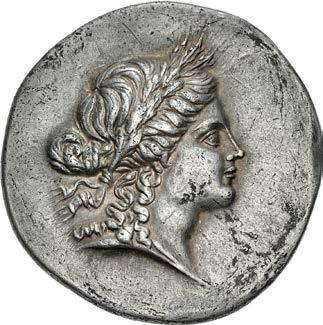
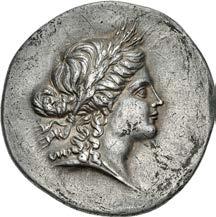
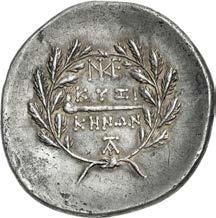

142. MYSIA, Kyzikos. Circa 170-150 BC. AR Tetradrachm (35mm, 16.87 g, 11h). Stephanophoric type. Wreathed head of Kore Soteira right / Club left; Ų above, ' below; all within oak wreath. Von Fritze II 33; SNG BN 449–51 var. (monograms); SNG von Aulock 1432 var. (same); BMC 146 var. (same); Gaziantep 215 var. (same); Leu 18, lot 174 var. (upper monogram). Lightly toned, with golden hues around the devices, traces of find patina, area of light porosity, some marks under tone. Good VF. Well centered and fine style. ($1500)


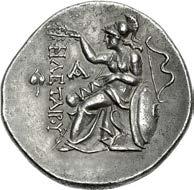
143. KINGS of PERGAMON. Eumenes I. 263-241 BC. AR Tetradrachm (31mm, 17.08 g, 12h). In the name of Philetairos. Pergamon mint. Struck circa 255/50-241 BC. Laureate head of Philetairos right / Athena enthroned left, elbow resting on shield to right, crowning dynastic name; transverse spear in background, ivy leaf to outer left, v to inner left, bow to right. Westermark Group IVA, obv. die L; SNG BN 1614–5. Lightly toned, trace deposits, spots of minor porosity on reverse. EF. ($1500)




144. TROAS, Larissa. 4th century BC. AR Triobol (11mm, 1.93 g, 11h). Head of nymph right / Amphora within incuse square. Unpublished. Toned, traces of find patina, a hint of porosity, minor marks. VF. Unique. ($500)
Until recently, the coins of Larissa Troas were believed to be from Larissa Phrikonis in Aeolis. Silver coins from this city are extremely rare, with only four published specimens, all of which are diobols (Traité II 2064; Winterthur 2767; F. Imhoof-Blumer, “Antike Griechishe Münzen” in SNR 19 (1913), 87; and W. Wroth, “Greek Coins acquired by the British Museum in 1901” in NC 1902, 26). Thus, this unique specimen is the largest silver coin known for Larissa.



145. TROAS, Sigeion. Circa 350-340 BC. AR Half Siglos (15mm, 2.50 g, 6h). Helmeted head of Athena facing slightly right / Owl standing right, head facing; crescent to left. Ellis-Evans, Memnon, dies O2/R3; SNG Lockett 2740 = Pozzi 2280 (same obv. die); SNG von Aulock 1569 (same dies); BMC 1 (same obv. die). Toned, rough surfaces, scratches, edge scrapes. VF. Well centered. Extremely rare, only five examples noted by Ellis-Evans. ($500)

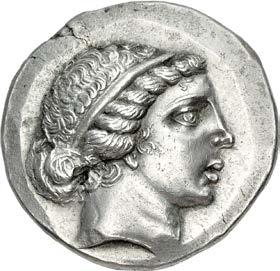

146. AEOLIS, Kyme. Circa 151/0-143/2 BC. AR Tetradrachm (30.5mm, 16.74 g, 1h). Stephanophoric type. Olympios, magistrate. Head of the Amazon Kyme right / Horse prancing right; one-handled cup below; all within wreath. E-E&E-Ö, Phase II, 9; Oakley obv. die 54; SNG Copenhagen. Lightly toned, trace deposits, a few light scratches. Near EF. ($500)
From the D. K. Collection.


147. LESBOS, Unattributed Koinon mint. Circa 525-513 BC. BI Stater (21.5mm, 13.13 g). Triform type: Lion recumbent facing, composed of the forepart of two lions confronted / Incuse square. Lazzarini, Contribution, Series II, Type A; HGC 6, 1063. Toned, traces of find patina, light porosity, some pitting. Near VF. Rare. ($1000)




148. LESBOS, Mytilene. Circa 521-478 BC. EL Hekte – Sixth Stater (10mm, 2.58 g, 12h). Forepart of bull left; Â to left / Incuse head of roaring lion left; rectangular punch behind. Bodenstedt Em. 1; HGC 6, 926 corr. (letter not noted). Faintly toned. Good VF. ($1000)




149. LESBOS, Mytilene. Circa 521-478 BC. EL Hekte – Sixth Stater (10mm, 2.62 g, 1h). Forepart of bull right / Incuse head of lion left; rectangular punch behind. Bodenstedt Em. 5; HGC 6, 929. Slight die wear on obverse, hairlines on reverse. Good VF. ($1000)
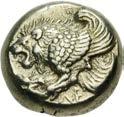



150. LESBOS, Mytilene. Circa 521-478 BC. EL Hekte – Sixth Stater (10.5mm, 2.45 g, 11h). Forepart of winged lion left; ¬E below / Incuse head of cock left; rectangular punch to right. Bodenstedt Em. 9.1 var. (no letters on obv.); HGC 6, 933 var. (same). Minor flan flaw on reverse. Near EF. Apparently unique variety, none in CoinArchives. ($1000)




151. LESBOS, Mytilene. Circa 521-478 BC. EL Hekte – Sixth Stater (11mm, 2.39 g, 6h). Forepart of winged boar right / Incuse head of roaring lion right; rectangular punch to left. Bodenstedt Em. 15; HGC 6, 940. Remnants of find patina, some marks. Near EF. ($1000)



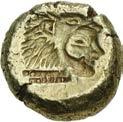
152. LESBOS, Mytilene. Circa 478-455 BC. EL Hekte – Sixth Stater (10.5mm, 2.63 g, 10h). Head of ram right; unclear symbol below / Incuse head of Herakles right, wearing lion skin headdress; rectangular punch below. Cf. Bodenstedt Em. 18; cf. HGC 6, 943. Good VF. ($750)
The usual symbol below the ram’s head is a cock standing left, but there is an extremely rare variety with the head of a hare right instead. However, what is visible on this example does not comport with either of those symbols, and may even be a legend.




153. LESBOS, Mytilene. Circa 454-428/7 BC. EL Hekte – Sixth Stater (11mm, 2.53 g, 6h). Head of Silenos facing slightly left / Head of lion right within incuse square. Bodenstedt Em. 38; HGC 6, 964. Tiny mark on obverse, struck with worn reverse die. VF. Well centered. ($1000)
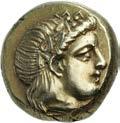



154. LESBOS,



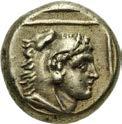




156. LESBOS, Mytilene. Circa 377-326 BC. EL Hekte – Sixth Stater (10.5mm, 2.55 g, 12h). Head of Apollo Karneios right, with horn of Ammon / Eagle standing right, head reverted, within linear square. Bodenstedt Em. 104; HGC 6, 1030. Attractively toned, a little die rust on obverse, slightly off center on reverse. Good VF. ($500)
Purchased by the consignor from Baldwin’s, 3 March 1998. Reportedly from the Baldwin’s basement, where it resided since 1967.
Cited in Karwiese
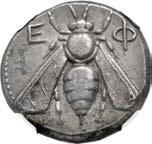

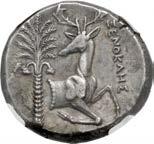
157. IONIA, Ephesos. Circa 390-325 BC. AR Tetradrachm (23mm, 15.08 g, 12h). Xenokles (I), magistrate. Class G, circa 350-340 BC. Bee with straight wings / Forepart of stag right, head left; palm tree to left. Karwiese II, Series 11.1, 443, dies O121/R1 (this coin referenced [but erroneously listed as ex Sternberg XI]); SNG Ashmolean 458 (same rev. die). In NGC encapsulation 6764694-002, graded Ch VF, Strike: 5/5, Surface: 4/5. Rare magistrate. ($2000)
Ex Sternberg [IX] (15 November 1979), lot 38.

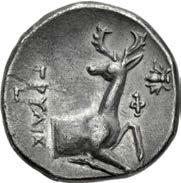

158. IONIA, Ephesos. Circa 245-202 BC. AR Didrachm (20mm, 6.29 g, 1h). Grylis, magistrate. Draped bust of Artemis right, wearing stephane; bow and quiver over shoulder / Forepart of stag right, head left; bee to right. SNG Copenhagen 270–5 var. (magistrate); BMC 94. Toned, hairline flan crack. EF. Very rare magistrate. ($750)
From the JTB Collection. Ex Michael Rogal Collection; Classical Numismatic Group 100 (7 October 2015), lot 1446.

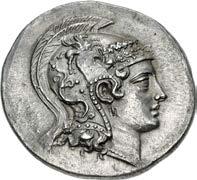

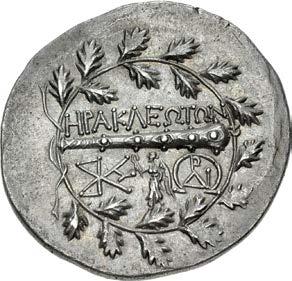
159. IONIA, Herakleia ad Latmon. Circa 140-135 BC. AR Tetradrachm (32mm, 17.11 g, 12h). Stephanophoric type. Helmeted head of Athena Parthenos right / Club; below, Nike walking left, holding wreath, flanked by ñ and V; all within oak wreath. Lavva, Silberprägung, Group II.B, – (unlisted dies); SNG Lockett 2823 = Pozzi 2452; Jameson 1503. Attractively toned, with traces of iridescence, minor deposits, typical slight weakness to strike at periphery. EF. ($1000)
From the GTP Collection. Ex Edward J. Waddell inventory 56886; Waddell 79 (10 December 2003), lot 42; Ariadne Galleries (with Galerie des Monnaies, 9 December 1981), lot 207.

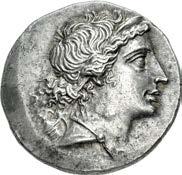


160. IONIA, Magnesia ad Maeandrum. Mid 140s BC. AR Tetradrachm (29.5mm, 16.91 g, 12h). Stephanophoric type. Antigenes, son of Anaxikrates, “magistrate.” Diademed and draped bust of Artemis right, bow and quiver over shoulder / Apollo standing left, resting on tall tripod to right, holding branch tied with fillet; maeander pattern below; all within laurel wreath. EllisEvans, Wreathed, dies 27/AnAn1; Jones obv. die 34. Attractively toned, minor die flaw on obverse. EF. Extremely rare, one of three known for this issue (the others: Roma XXVII, lot 244 and NFA [XIX] Winter MBS 1987, lot 326). ($1000)

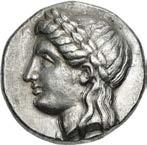
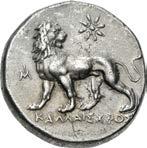

161. IONIA, Miletos. Circa 350-340 BC. AR Tetradrachm (23.5mm, 15.12 g, 12h). Kallaischros, magistrate. Laureate head of Apollo left / Lion standing left, head right; star above, s (civic monogram) to left. D-L Period I, Series I, 68–91 var. (unlisted magistrate for tetradrachms, but possibly obv. die 5); otherwise, unpublished. Lightly toned, minor doubling, some marks. Good VF. Apparently unique. ($2500)
Kallaischros is known on drachms of this period, but not tetradrachms.

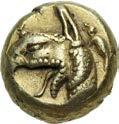

162. IONIA, Phokaia. Circa 625/0-522 BC. EL Hekte – Sixth Stater (10mm, 2.58 g). Head of griffin left; to right, small seal upward / Incuse square. Bodenstedt Em. 12. Toned, minor scratches on reverse. Near EF. ($750)



163. IONIA, Teos. Circa 450-425 BC. AR Stater (20.5mm, 11.99 g). Griffin seated right, raising left forepaw, on an ornamented ground line; to right, swan standing right / Quadripartite incuse square. Matzke Series Cb1; Balcer Group LII, 101 var. (A101/P– [unlisted rev. die]); Boston MFA 1939 = Warren 1135 (same obv. die). Toned, some die wear on obverse. VF. ($1000)
Ex Classical Numismatic Group 58 (19 September 2001), lot 583.
A member city of the Ionian Dodekapolis, Teos was a thriving seaport with two fine harbors. It was the birthplace of Anakreon the poet, Hekataios the historian, Protagoras the sophist, Skythinos the poet, Andron the geographer, and Apellikon, the preserver of the works of Aristotle. When the Persians under Cyrus invaded circa 540 BC, many Teans fled, resettling in Abdera. The griffin was the badge of the city of Teos, and is present on the coins of both cities.


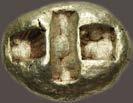

164. IONIA, Uncertain. Circa 650-600 BC. EL Stater (21mm, 14.00 g). Lydo-Milesian standard. Typeless, rough surface / Two incuse squares flanking central rectangular incuse. Weidauer 1 = SNG Ashmolean 1 (same rev. incuses); Boston MFA 1747 = Pozzi 2349. Minor edge splits, trace earthen deposits on reverse. As made. Among the earliest electrum staters. Extremely rare. ($20,000)
Other than the literary tradition ascribing the origin of coinage to the kings of Lydia, there is little evidence for a more exact chronology of early Greek coinage. The tradition, buttressed by limited archaeological studies, does confirm Asia Minor as the place of origin, most likely Lydia or Ionia, and a date somewhere around 650-625 BC. The alloy used was a mixture of gold and silver known to the Greeks as elektron Although ancient sources indicated that this alloy was a natural ore found in nugget form in many riverbeds in the region, recent studies have concluded that this was actually not the case, and that the electrum used in coinage was, in fact, man-made. The earliest coins were of a globular shape and without design; later, simple striated and punched patterns of squares, rectangles, and swastikas were included. The earliest true types may have developed from the use of personal seals, the most widely known being the stater of Ephesos with a stag bearing the inscription “I am a seal of Phanes”. These devices later took on the characteristics of civic symbols, although it would be dangerous to link a specific symbol to a particular city in this early period. The most secure form of classification has been by weight standard, based on two major, and several lesser-used, standards. The Milesian standard, with a stater of roughly 14 grams, saw circulation in Lydia and parts of Ionia. The Phokaic standard of roughly 16 grams was also used in Ionia as well as Mysia. Persic, Aeginetan, and Euboic standards saw scattered use in early coinage, limited in time and extent of circulation. The intrinsic value of the early electrum, even down to the 1/96 stater, was too high for use in everyday commerce, and early coinage must have been used only for the transfer of large sums of money, such as mercantile transactions, payment of government expenses (mercenaries, tribute and such), and donatives, either for services rendered to individuals or the state, or to religious foundations. The Artemision deposits, hoards of early electrum found at the site of the temple of Artemis at Ephesos, are examples of the latter.



IONIA, Uncertain. Circa 650-600 BC. EL Trite – Third Stater (12mm, 4.64 g). Lydo-Milesian standard. Globular surface with cluster of pellets / Two incuse squares. Weidauer –; Artemision –; Traité I 3; SNG Kayhan –; SNG von Aulock 7761. Minor doubling. As made. ($1000)
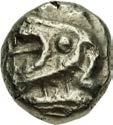


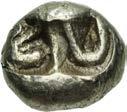
166. IONIA, Uncertain. Circa 600-550 BC. EL Hekte – Sixth Stater (10.5mm, 2.36 g). Lydo-Milesian standard. Two conjoined, stylized serpents’ or lions’(?) heads, with open jaws and lolling tongues / Two incuse punches with curved ornament within each. SNG Kayhan 1538–43. A little off center. Good VF. ($500)
Ex Berk BBS 144 (13 July 2005), lot 4.



167. IONIA, Uncertain. Circa 600-550 BC. EL Myshemihekte – Twenty-fourth Stater (7mm, 0.66 g). Lydo-Milesian standard. Bird (cock?) standing left / Incuse square punch. CNG 120, lot 352 = NAC 123, lot 706 = Triton XIV, lot 309; otherwise, unpublished in the standard references. Light earthen deposits. Good VF. Very rare. ($1000)




168. IONIA, Uncertain. 5th century BC. EL Hemihekte(?) – Twelfth Stater (8mm, 0.97 g, 3h). Uncertain standard. Siren standing right, right hand playing tympanon it holds in its left hand / Facing boukranion with fillet hanging from each horn. Weidauer –; Traité –; SNG Kayhan –; SNG von Aulock –; Elektron –; Rosen 369. A few hairlines on reverse. Good VF. Well centered. Extremely rare. ($1000)
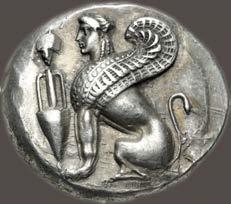
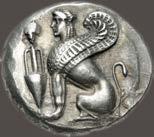

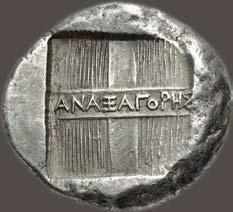
169. ISLANDS off IONIA, Chios. Circa 380-350 BC. AR Tetradrachm (25mm, 15.31 g, 12h). Anaxagores, magistrate. Sphinx seated left; to left, grape bunch above amphora; all on shallow convex surface / Quadripartite incuse square, with striated quarters and thick bands; Å@ÅxÅ˝or˙s on horizontal band. Cf. Mavrogordato 49 (unlisted magistrate); HGC 6, 1116 var. (unlisted magistrate). Attractively toned, underlying luster. Near EF. A beautiful coin. Extremely rare with this magistrate, none in CoinArchives. ($15,000)
The wine of Chios was famed throughout antiquity, and its distinctive amphoras, which feature so prominently on Chian coinage, have been found at ancient sites ranging from England to Egypt.



170. ISLANDS off IONIA, Chios. Circa 380-350 BC. AR Tetradrachm (22mm, 15.15 g, 3h). Oikles, magistrate. Sphinx seated left; to left, grape bunch above amphora; all on shallow convex surface / Quadripartite incuse square, with striated quarters and thick bands; o5˚¬˙s on horizontal band. Cf. Mavrogordato 49 (unlisted magistrate); HGC 6, 1116 var. (unlisted magistrate). Light iridescent tone, underlying luster. VF. Extremely rare with this magistrate, none in CoinArchives. ($5000)



171. KINGS of LYDIA. temp. Alyattes – Kroisos. Circa 620/10-550/39 BC. EL Trite – Third Stater (12.5mm, 4.73 g). Lydo-Milesian standard. Sardes mint. Head of roaring lion right; “sun” with multiple rays on forehead / Two incuse squares. Weidauer Group XVI, 89; Kurth G26; SNG Ashmolean 749–51. Minor marks, a couple of light scratches on obverse. VF. ($1000)



172. KINGS of LYDIA. Kroisos. Circa 564/53-550/39 BC. AR Stater (21.5mm, 10.41 g). Sardes mint. Confronted foreparts of lion and bull / Two incuse squares. Berk 20; Kurth S1; Traité I 407–8; SNG Ashmolean 760. Toned, typical granular surfaces, minor scrape on obverse. VF. ($1500)
From the JTB Collection, purchased from Wolfshead Gallery, 14 January 2002.
While the Lydian Kingdom in central Asia Minor had previously struck coins in electrum, an alloy of gold and silver, the accession of Kroisos to the Lydian throne circa 564/53 BC ushered in an important milestone in economics: the first true bimetallic coinage in gold and silver. The design chosen by Kroisos, confronting foreparts of a lion and bull, thought to symbolize the sun and the moon, but are also possibly dynastic in nature, with the lion referring to the previous king, Alyattes, and the bull representing his son and successor, Kroisos.
Perhaps because of his association with gold and silver, Kroisos became legendary for his wealth. There are several accounts of his interactions with another legendary Greek, the sage Solon of Athens, in which they discuss wealth and fortune. The most famous ancient account of Kroisos occurred when he questioned the Delphic Oracle as to whether he should make war on the rising Persian Kingdom of Cyrus the Great. The oracle answered, with typical ambiguity, that if he attacked the Persians, Kroisos would destroy a great empire. On this advice he attacked the Persians, and, after an inconclusive battle, was besieged and captured at his capital city of Sardes in 546 BC, thus destroying his own “great empire.” The ultimate fate of Kroisos is uncertain; though Herodotus reports that he continued as an advisor to Cyrus after the Persians absorbed Lydia and advised him concrning his fateful campaign against the Massagetae.



Ex Mercury Group Collection (Classical Numismatic Group 118, 13 September 2021), lot 297; Antiqua FPL X (2001), no. 72.




174. CARIA, Alabanda. Circa 167/6 BC. AR Tetradrachm (35.5mm, 16.75 g, 12h). Dated CY 1. Laureate head of Apollo right / Pegasos alighting right; & (date) below. Meadows, Alabanda, Series 4, 19 (A14/P18); Waggoner, New, Series 4; HN Online 451; DCA2 472. Faintly toned, trace deposits, light hammering around edge (likely to fit prior bezel). Good VF. ($3000)
Ex Baldwin’s 114 (7 March 2024), lot 37; Morton & Eden 104 (14 November 2019), lot 70; Lanz 20 (13 April 1981), lot 244.




175. CARIA, Chersonesos. Circa 480-450 BC. AR Drachm (17mm, 5.87 g, 6h). Forepart of lion roaring right / Head of bull right; Ec and olive branch below; all within incuse square. Cahn X16 var. (no ethnic and branch; same obv. die); HN Online –. Toned, granular surfaces. Near EF. An unrecorded variety, apparently unique. ($1500)
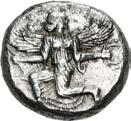


176. CARIA, Kaunos. Circa 410-390 BC. AR Stater (21mm, 11.61 g, 3h). Winged female figure in kneeling-running stance left, head right, holding kerykeion and wreath / Baetyl(?); ∂ ˝ (K B in Carian) across upper field; all within incuse square. Konuk Period V, Type 4, 101 (O42/R42); Konuk, Coin M26; HN Online 220. Lightly toned, trace deposits, minor die wear on reverse. Near EF. ($750)
Ex Nomos Obolos 18 (21 February 2021), lot 312; Trausnitz Collection (Nomos 19, 17 November 2019), lot 154; Athena 1 (8 October 1987), lot 115.



177. SATRAPS of CARIA. Pixodaros. Circa 341/0-336/5 BC. AR Didrachm (20mm, 6.64 g, 12h). Halikarnassos mint. Laureate head of Apollo facing slightly right, drapery around neck / Zeus Labraundos standing right. Konuk, Identities 30; Babelon, Perses 414–21; HN Online 241. Toned, much find patina remaining, light roughness. Near EF. ($750)
Ex Classical Numismatic Group 53 (15 March 2000), lot 514; Coin Galleries (22 July 1992), lot 130.
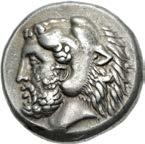


178. ISLANDS off CARIA, Kos. Circa 370/60-345 BC. AR Tetradrachm (23.5mm, 15.16 g, 11h). Theodotos, magistrate. Bearded head of Herakles left, wearing lion skin / Crab; club below; all in dotted square within incuse square. Ingvaldsen Issue VI, 31 (O13/R29) = Stefanaki Series IV, Issue 9, 246–8; HGC 6, 1302; Prospero 555 (same dies). Toned, hairlines, slight die wear on obverse, small flan flaw and light scuff at edge on reverse. Good VF. ($2000)
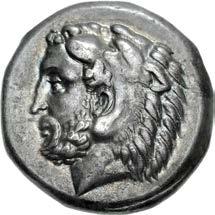


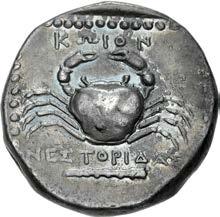
179. ISLANDS off CARIA, Kos. Circa 370/60-345 BC. AR Tetradrachm (23mm, 15.12 g, 5h). Nestoridas, magistrate. Bearded head of Herakles left, wearing lion skin / Crab; club below; all in dotted square within incuse square. Ingvaldsen Issue VI, 44 (O19/R40); Stefanaki Series IV, Issue 9, 289 (same dies); HN Online 348; HGC 6, 1302. Deep iridescent tone, traces of find patina. Good VF. Well centered. ($2000)



180. ISLANDS off CARIA, Kos. Circa 370/60-345 BC. AR Tetradrachm (22mm, 15.14 g, 5h). Alkimachos, magistrate. Bearded head of Herakles left, wearing lion skin / Crab; club below; all in dotted square within incuse square. Ingvaldsen Issue VI, 53 (O20/R47) = Stefanaki Series IV, Issue 9, 311; HGC 6, 1302. Lightly toned, slight die wear, a touch off center. Good VF. Attractive style. ($2000)




181. LYCIA, Araxa. Circa 400-390 BC. AR Twenty-fourth Stater (8mm, 0.26 g, 2h). Facing scalp of lion / Fish left. Müseler VII, 58; otherwise, unpublished in the standard references. Toned, edge split, weakly struck on obverse. Good VF. Extremely rare. ($500)
From an American Academic Collection.
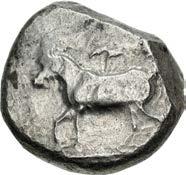


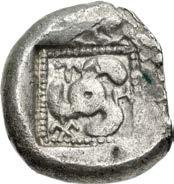
182. LYCIA, Limyra (as Zemuri). Circa 490/80-440/30 BC. AR Stater (20mm, 9.90 g). Goat advancing left; ì above / Triskeles; ì and zg (ZẼ in Lycian) around; all in dotted square within incuse square. Müseler III 55–7 (same dies); Falghera –; SNG Copenhagen Supp. 701 var. = SNG von Aulock 4117 var. (same rev. die, different symbol on obv.). Lightly toned, some weakness to strike, overstruck on uncertain type. Near VF. ($750)
From an American Academic Collection.


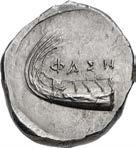

183. LYCIA, Phaselis. 4th century BC. AR Stater (22mm, 10.37 g, 11h). Prow of galley right / Stern of galley left. Heipp-Tamer Series 6, unlisted variety; CNG 99, lot 287 (same dies, hammer $5305). Toned, minor flan flaws, slight doubling on reverse. EF. ($1000)
From the Deer Creek Collection. Ex Asher D. Atchick Collection (Classical Numismatic Group Electronic Auction 459, 8 January 2020), lot 278; Classical Numismatic Group Electronic Auction 362 (28 October 2015), lot 180.


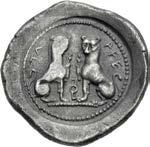
184. LYCIA, Tlos. temp. Vekhssere II. Circa 410/00-390/80 BC. AR Stater (25mm, 8.11 g, 3h). Facing scalp of lion / Two lions seated confronted, heads facing, each raising forepaw; diskeles between; all in dotted circle within incuse circle. Cf. Müseler VI, 22–3 (sixth staters); Falghera 189 (same dies); SNG Copenhagen Supp. –. Toned, granular surfaces, some weakness to strike, struck with worn obverse die. VF. Very rare. ($1500)
From an American Academic Collection.


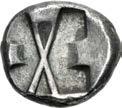
185. DYNASTS of LYCIA. Uncertain dynast. Circa 500-470/60 BC. AR Stater (19.5mm, 8.19 g). Forepart of boar left / Incuse square divided by large X-like device, with inward squared protuberances on three sides. Müseler II, 2 (this coin); Falghera 14–6; SNG Copenhagen Supp. 370. Toned, remnants of find patina, area of weak strike on obverse. Good VF. ($1000)
Ex Dr. Kaya Sayar (“Amadeus”) Collection (Giessener Münzhandlung 100, 20 November 1999), lot 184; Monetarium 39 (Spring 1983), no. 37; Monetarium 36 (Winter 1981/82), no. 63; Bonham’s & Vecchi 8 (11 October 1982), lot 387.



186. DYNASTS of LYCIA. Ãru or Urã. Circa 480-460 BC. AR Stater (16.5mm, 9.63 g). Forepart of roaring lion left / Triskeles; (Ãru or Urã [in Lycian]) around; all in dotted square within incuse square. Müseler III, 15 = Reuter 23 (same dies); otherwise, unpublished. Faintly toned, traces of find patina, double struck, light marks, scrapes and banker’s mark on reverse. VF. Extremely rare, apparently the second known. ($500)
From an American Academic Collection.

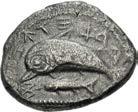


187. DYNASTS of LYCIA. Thap–. Circa 480-460 BC. AR Stater (22mm, 9.65 g). Phellos mint. Dolphin left above fish left; gᛩ (WAHNTEZẼ [= Phellos] in retrograde Lycian) above / Triskeles; t (ThAP in retrograde Lycian) around; all in dotted square within incuse square. Traité II 197, pl. XCIV, 7 (same dies); otherwise, unpublished. Toned, granular surfaces. Good VF. Well centered. The second known, and the only example in private hands (the other in the BN in Paris). ($1500)
From an American Academic Collection.
While this issue of Thap– showing the full mint name on the obverse is exceptionally rare, other issues that feature only the name of the dynast on the reverse, as here, are well known (see, e.g., SNG von Aulock 4112–3 and Müseler II 50–1).
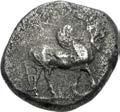



188. DYNASTS of LYCIA. Kuprilli. Circa 480-440 BC. AR Third Stater (13mm, 2.57 g). Uncertain mint. Winged man-headed bull standing right / Triskeles in dotted square within incuse square. Mørkholm & Zahle 90 (a35/p30) = SNG von Aulock 4149 (same dies); cf. Müseler IV 34 (stater); Falghera –; SNG Copenhagen Supp. 416 (same dies). Toned, granular surfaces, some weakness to strike. VF. Rare. ($500)
From an American Academic Collection.
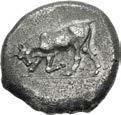
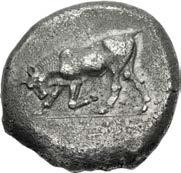

189. DYNASTS of LYCIA. Kuprilli. Circa 480-440 BC. AR Stater (20mm, 8.36 g). Uncertain mint. Bull butting left / Triskeles in dotted square within incuse square. Mørkholm & Zahle 105 (A28/P29) = Traité II 290 (same dies); Müseler –; Falghera 120 var. (bull not butting); SNG Copenhagen Supp. –. Toned, granular surfaces, light scuffs on obverse, double struck on reverse. Good VF. Very rare. ($1000)
From an American Academic Collection. Ex Lanz 40 (25 May 1987), lot 336.

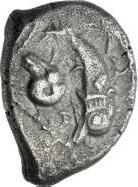


190. DYNASTS of LYCIA. Ite. Circa 480/60-440 BC. AR Third Stater (15mm, 2.82 g). Dolphin diving right above head of ram left / Triskeles in dotted square within incuse square. Cf. SNG von Aulock 4104–5 (for stater and twelfth stater of this dynast with similar types); otherwise, unpublished in the standard references. Toned, irregular flan, granular surfaces. Good VF. Extremely rare, possibly unique. ($1000)
From an American Academic Collection.
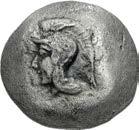


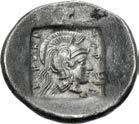
191. DYNASTS of LYCIA. Kheriga. Circa 440-395 BC. AR Quarter Stater (15.5mm, 1.95 g, 6h). Kandyba mint. Helmeted head of Athena left / Helmeted head of Athena right within incuse square. Mørkholm & Zahle II –; Müseler V, 52 corr. (mint; same dies); Falghera –; SNG Copenhagen Supp. –. Toned, remnants of find patina, granular surfaces. Near EF. Extremely rare, Müseler noted his example as unpublished, none in CoinArchives. ($500)
From an American Academic Collection.
The letters of the mint name behind Athena’s head are difficult to read, and rather than how they were interpreted by Müseler, it appears more likely that the letters read as reported on a stater in a hoard recently described by J. Kagan (I.12 in “Return in Xanthos: New Numismatic Light on the Harpagid Dynasty of Western Lycia” in A. Meadows & U. Wartenberg, eds. Presebus: Studies in Ancient Coinage Presented to Richard Ashton [New York, 2021]).

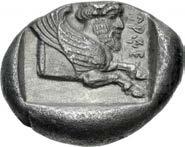

192. DYNASTS of LYCIA. Kherei. Circa 430/25-390/85 BC. AR Stater (16.5mm, 8.36 g, 3h). Xanthos(?) mint. Helmeted head of Athena right / Forepart of winged man-headed bull right within incuse square. Mørkholm & Zahle II –; Müseler VI, 17 = Reuter 81 (this coin); Falghera –; SNG Copenhagen Supp. 453 (same dies). Toned, granular surfaces, a little off center, struck with worn obverse die. VF. ($1000)
From the JTB Collection. Ex Jonathan H. Kagan Collection (Nomos 33, 9 June 2024), lot 1411; Reuter Collection (Peus 360, 27 April 1999), lot 81; Giessener Münzhandlung 46 (30 October 1989), lot 315.



193. DYNASTS of LYCIA. Kherei. Circa 430/25-390/85 BC. AR Stater (17mm, 8.58 g, 1h). Telmessos mint. Head of Athena right, wearing crested Attic helmet; [e]f ([K]H in Lycian) behind and on neck guard / Bearded head of Herakles right, wearing lion skin, within incuse square. Mørkholm & Zahle II 53; Müseler VI 61–3; Falghera –; SNG Copenhagen Supp. 451 (same obv. die). Toned, off center. Good VF. ($1000)
Ex Grapevine Collection, purchased from Numismatica Ars Classica.

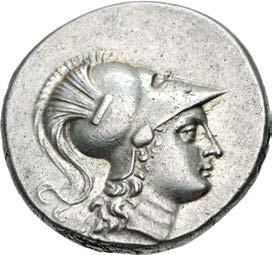

194. PAMPHYLIA, Side. Circa 205-100 BC. AR Tetradrachm (29.5mm, 16.92 g, 12h). Attic standard. Die–, magistrate. Helmeted head of Athena right / Nike advancing left, holding wreath; to left, pomegranate above @E. Seyrig, Side 12; SNG BN 670–3. Lightly toned, underlying luster, a few hairlines on reverse. EF. ($500)
Ex Baldwin’s 115 (29 May 2024), lot 59; Alfred Franklin Collection (Baldwin’s 99, 4 May 2016), lot 149.



195. CILICIA, Kelenderis. Circa 410-375 BC. AR Stater (23mm, 10.72 g, 11h). Nude youth, holding whip, dismounting from horse rearing right / Goat kneeling left, head right; ivy leaf above, π to left; all within shallow incuse circle. Casabonne Type 4; Celenderis Series IV, unlisted variety; SNG BN –; SNG Levante –; SNG von Aulock –; BMC 26. Minor die wear, spot of roughness on obverse, slight die shift on reverse. Near EF. ($750)
Ex Triton XXVI (10 January 2023), lot 300.

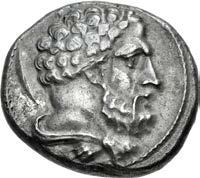

196. CILICIA, Mallos. Tiribazos. Satrap of Lydia, 388-380 BC. AR Stater (22mm, 10.04 g, 12h). Bearded head of Herakles right, lion skin tied around neck / Head right, wearing satrapal headdress. Casabonne Series 2, Group D; SNG BN 395. Toned, remnants of find patina, light roughness, some die wear on obverse. Good VF. ($500)
Reportedly ex Sydney Mygind inventory, May 1999.
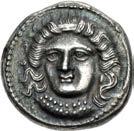
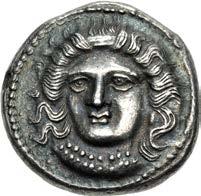

197. CILICIA, Tarsos. Tarkumuwa (Datames). Satrap of Cilicia and Cappadocia, 384-361/0 BC. AR Stater (21.5mm, 10.36 g, 11h). Struck circa 380 BC. Female head facing slightly left / Helmeted and bearded male head (Ares?) right. Casabonne Type 1; Moysey Issue 4; SNG BN 258-70; SNG Levante 79. Iridescent tone, struck from worn and re-engraved dies. Good VF. ($750) Ex Classical Numismatic Group Electronic Auction 457 (4 December 2019), lot 92; George Bernert Collection (Classical Numismatic Group 106, 13 September 2017), lot 445; Numismatica Ars Classica A (27 February 1991), lot 1461.




198. ASIA MINOR, Uncertain. 5th century BC. AR Obol(?) (10.5mm, 0.76 g, 10h). Helmeted head of Athena right / Facing head of lion within incuse square. Rosen 401; Weber 8584; Winterthur 6113. Toned. Choice EF. Exceptional for issue. ($500)
From an American Academic Collection.
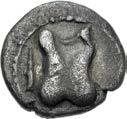


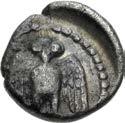
199. ASIA MINOR, Uncertain. Late 5th-4th centuries BC. AR Obol (10.5mm, 0.99 g, 8h). Astragalos; upright club to left / Owl standing facing with spread wings. CNG 64, lot 304 (Selge?); Nomos 26, lot 503 (Mallos?) = Münzen und Medaillen AG FPL 570, no. 62; otherwise, unpublished. Iridescent tone, some find patina, granular surfaces, a little off center. VF. Extremely rare, apparently the third known. ($500)
From the Kelly Ramage Collection.
The recent attribution of this issue to Mallos is predicated upon the astragalos, which appears as a subsidiary symbol at that mint, and the supposed reading of the letters M-A on an issue of this type (Meister & Sonntag 3, lot 58). However, the first letter on that coin is not clear, and neither the astragalos nor an owl appear as types on issues certainly struck at Mallos. Other possible mints could be Selge in Pisidia, Phaselis in Lycia, or Amisos in Pontos.
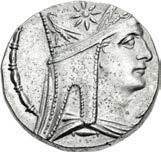
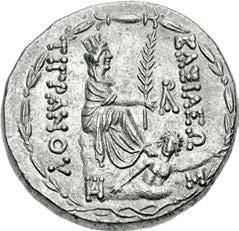
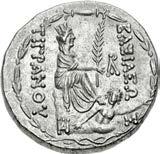
200. KINGS of ARMENIA. Tigranes II ‘the Great’. 95-56 BC. AR Tetradrachm (26mm, 15.87 g, 1h). Tigranocerta mint. Struck circa 80-68 BC. Diademed and draped bust right, wearing tiara decorated with star between two eagles / Tyche of Antioch seated right on rock, holding laurel branch; below, river-god Orontes swimming right; v to inner right, M on rock; all within wreath. SCADA Group 1, obv. die A5; Kovacs 74.1; M&D 2; CAA 17; AC 30. Faintly toned, a little porosity and slightly off center on obverse. Near EF. ($500)
Tigranes II won the epithet “The Great” by expanding the Artaxiad Armenian Kingdom to its greatest extent and claiming the title “King of Kings,” hitherto employed by the Achaemenid and Parthian rulers of Persia. The son of the Artaxiad king Artavasdes I (ruled 159-115 BC), Tigranes spent much of his youth as a hostage to his father’s loyalty in the Parthian court. Tigranes inherited the Armenian throne in 95 BC and began methodically turning his mountainous, feudal kingdom into a powerful, centralized Hellenistic state. At its peak his kingdom incorporated all of Seleukid Syria, Cilicia, Cappadocia, and large swaths of Parthia. Though a crafty and talented statesman, his success was due less to his own military prowess than the result of a power vacuum caused by internal strife within Parthia and the collapse of the Seleukid Kingdom, along with the turmoil caused by the titanic struggle between the Roman Republic and Mithridates VI of Pontus. Tigranes formed an alliance with Mithridates, but fared poorly against the Roman generals Lucullus and Pompey. He ultimately elected to formally submit to Rome, which allowed him to retain his core kingdom while giving up his conquests.


201. KINGS of ARMENIA. Tigranes II ‘the Great’. 95-56 BC. AR Tetradrachm (26mm, 15.74 g, 12h). Tigranocerta mint. Struck circa 80-68 BC. Diademed and draped bust right, wearing tiara decorated with star between two eagles / Tyche of Antioch seated right on rock, holding laurel branch; below, river-god Orontes swimming right; v to inner right, M on rock; all within wreath. SCADA Group 1, obv. die A10; Kovacs 74.1; M&D 2; CAA 17; AC 30. Light porosity. Near EF. ($500)

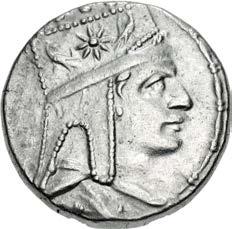

202. KINGS of ARMENIA. Tigranes II ‘the Great’. 95-56 BC. AR Tetradrachm (25mm, 15.84 g, 1h). Tigranocerta mint. Struck circa 80-68 BC. Diademed and draped bust right, wearing tiara decorated with star between two eagles / Tyche of Antioch seated right on rock, holding laurel branch; below, river-god Orontes swimming right; M on rock, small Q in right field; all within wreath. SCADA Group 2, obv. die A19; Kovacs 74.2; M&D 1; CAA 19; AC 30. Faintly toned, slight die wear on obverse. Near EF. ($500)


203. KINGS of ARMENIA. Tigranes II ‘the Great’. 95-56 BC. AR Tetradrachm (26.5mm, 15.70 g, 12h). Tigranocerta mint. Struck circa 80-68 BC. Diademed and draped bust right, wearing tiara decorated with star between two eagles / Tyche of Antioch seated right on rock, holding laurel branch; below, river-god Orontes swimming right; · on rock; all within wreath. SCADA Group 7, obv. die A57; Kovacs 75.2; M&D 9; CAA 33; AC 37. Faintly toned, slight porosity. Good VF. ($500)
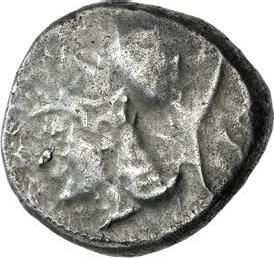

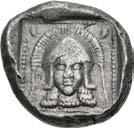
204. CYPRUS, Lapethos. Sidqmelek. Circa 450-425 BC. AR Stater (23mm, 10.91 g, 11h). Helmeted head of Athena left / Helmeted head of Athena facing in dotted square within incuse square. Zapiti & Michaelidou 2 var. (legend, helmet type on rev.; same obv. die); Tziambazis 48 var. (same); SNG Copenhagen –; CNG E-455, lot 173 (same dies). Toned, struck with heavily worn obverse die, some die wear on reverse. VF. Rare. ($500)
This coin is obverse die linked to an issue of Sidqmelek, also with the facing head Athena reverse type. However, those coins also have the name of the king on the reverse, which is not present on this issue. Thus, due to the die wear on the obverse, it is possible that this may be a coin of an unknown king who succeeded him.



205. CYPRUS, Salamis. Evagoras I. Circa 411-374/3 BC. AR Stater (21.5mm, 10.93 g, 11h). Bearded head of Herakles right, wearing lion skin / Ram couchant right; barley grain above; EY to right in exergue. MacGregor Group K.AR.II.a; cf. Zapiti & Michaelidou 5–8; cf. Tziambazis 113. Toned, compact flan, minor roughness on obverse, a little off center on reverse. Good VF. ($1000)

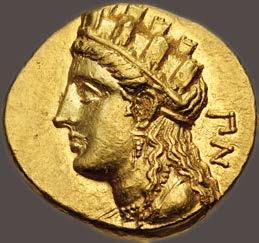
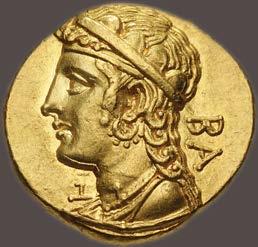

206. CYPRUS, Salamis. Pnytagoras. Circa 351/0-332/1 BC. AV Stater (17mm, 8.31 g, 12h). Draped bust of Aphrodite left, hair rolled above forehead and falling in long wavy strands to front and back of shoulder, wearing turreted crown, triplependant earring, and beaded necklace; π@ to right / Draped bust of male left, with long sideburn and hair in tight ringlets falling down back of neck, wearing crown decorated with semicircular plates, hoop earring with pendants, and torque; ∫Å to right. Markou, L’or 421 (D4/R8); Zapiti & Michaelidou 22; Tziambazis 132; Gulbenkian 813; Jameson 1631; Pozzi 2899. Underlying luster, minor marks, small patch of die rust on obverse, minor flan flaw on reverse. Near EF. Very rare. ($30,000)
Pnytagoras came to power following the deposition of his half-uncle Evagoras II, who was expelled by his subjects after refusing to support a revolt against the Persians. Following the revolt, the Persians mounted an invasion to retake Cyprus and supported Evagoras in his bid to regain his throne in Salamis. Soon, however, unknown accusations were made against Evagoras, which prompted the Persians to change their support to Pnytagoras, who subsequently submitted to the Persian king. After the battle of Ipsos, Pnytagoras allied himself with the Macedonians, and his fleet participated in the important siege of Tyre in 332 BC. Following the siege, Alexander rewarded Pnytagoras with the city of Tamassos, which had been a possession of Kition. Pnytagoras died later that same year and was succeeded by his son, Nikokreon. Pnytagoras’ gold staters feature the bust of Cypriote Aphrodite, as celebrated by her numerous cult centers on the island. Her turreted crown on the obverse of this coin shows her assimilation to Tyche as the protecting civic goddess for the whole of Cyprus.



207. SELEUKID EMPIRE. Seleukos I Nikator. Second satrapy and kingship, 312-281 BC. AR Fifth Tetradrachm (16mm, 3.00 g, 8h). Babylon I mint. Struck circa 311-300 BC. Head of Herakles right, wearing lion skin / Club and quiverover-bow; ü to left, ˙ to right. SC 84; Price 3705; A. Spaer, “A New Type of Alexander the Great?” in INJ 5 (1981), 1; HGC 9, 70. Minor marks, some roughness on obverse. VF. Extremely rare, two published, with three additional in CoinArchives (though one has the right field control off the flan, so may be a different issue). ($500)
Previous authors have noted the denomination of this rare issue as fifth tetradrachm based on the Macedonian standard used from Archelaos through Philip II. However, the weights of the two published pieces at the time did not comport well with this idea, and the fact that this type is only known in the eastern mint of Babylon made such a weight standard doubtful. As such, we had been calling these coins AR Units. Recently, though, examples from the various issues of this type have been found with very little wear, and their weights are compatible with a fifth tetradrachm on the Attic standard, which was used at Babylon on contemporary issues.
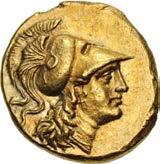


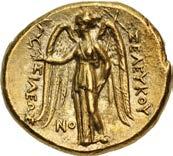
208. SELEUKID EMPIRE. Seleukos I Nikator. Second satrapy and kingship, 312-281 BC. AV Stater (18mm, 8.59 g, 10h). In the types of Alexander III of Macedon. Seleukeia on the Tigris mint I. Struck circa 300-296/5 BC. Head of Athena right, wearing single pendant earring, necklace, and triple-crested Corinthian helmet adorned with a coiled serpent / ∫Å-s5¬EWs sE¬EU˚oU, Nike standing left, holding wreath in extended right hand, cradling stylis in left arm; @o below left wing. Cf. SC 116.6a (for the tetradrachm of this issue); HGC 9, 4d; CNG 129, lot 306 (same dies; hammer $11,000). Toned, minor die wear. EF. Unpublished and apparently the second known. ($5000)



209. SELEUKID EMPIRE. Seleukos I Nikator Second satrapy and kingship, 312-281 BC. AR Stater (24mm, 15.71 g, 8h). Susa mint. Laureate head of Zeus right / Elephant advancing right; above, spearhead right; ì below. SC 187.2a; ESMS ElSt.7 var. (A4/P– [unlisted rev. die]); HGC 9, –; CSE 1031 (same obv. die). Rough dark find patina. VF. Extremely rare, one of only four of this variety (the others: CSE 1031; Roma E-Live 3, lot 342; and Leu Numismatik AG Web Auction 33, lot 1352). ($750)
From the D. K. Collection. Ex Leu Numismatik AG Web Auction 31 (7 September 2024), lot 635.
As at the great mint of Babylon, the mint of Susa struck coinage of both royal Seleukid type (on the Attic standard) and local native type (on a local standard). The native types mostly comprise the Ba’al/Lion types similar to those found at Babylon, but also this very rare Zeus/ Elephant type. Although the extant examples are well cataloged, very little is known about the circumstances of the issue. As with all the ‘native’ coinage, we can only assume that they were used for a special localized purpose. Newell hypothesized that they were a temple or local trade currency.



210. SELEUKID EMPIRE. Seleukos I Nikator. Second satrapy and kingship, 312-281 BC. AR Didrachm (19.5mm, 8.46 g, 6h). In the name and types of Alexander III of Macedon. Ekbatana mint. Struck circa 311-295/81 BC. Head of Herakles right, wearing lion skin / Zeus Aëtophoros seated left; in left field, é and a above horizontal anchor above forepart of horse grazing left, sW below throne. SC 206.4; Price 3933; HGC 9, 25. Lightly toned, light scratch on obverse, some marks at edge on reverse. VF. Exremely rare, only one in CoinArchives. ($1000) Unpublished




211. SELEUKID EMPIRE. Seleukos I Nikator. Second satrapy and kingship, 312-281 BC. AR Drachm (17.5mm, 4.24 g, 6h). In the types of Alexander III of Macedon. Ekbatana mint. Struck circa 295-281 BC. Head of Herakles right, wearing lion skin / Zeus Aëtophoros seated left; in left field, é above upright anchor above forepart of horse grazing left, ¨ below throne. SC 210 var. (unlisted controls); HGC 9, 29i. Lightly toned, off center on obverse, some doubling on reverse. Near EF. Unpublished and extremely rare. ($500)
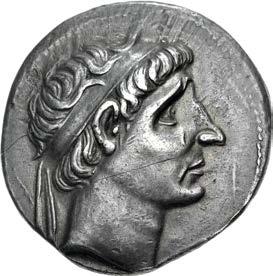
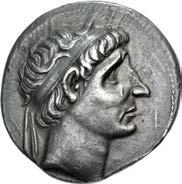


212. SELEUKID EMPIRE. Antiochos I Soter. 281-261 BC. AR Tetradrachm (30mm, 17.00 g, 8h). Seleukeia on the Tigris mint. Diademed head right / Apollo, testing arrow and resting hand on grounded bow, seated left on omphalos; ° to outer left, ¢ to outer right. SC 379.6a; ESM 162γ = Hermitage Sale II 1428 (this coin); HGC 9, 128g; Bement 1670 (same obv. die). Old collection tone, a couple old scratches under tone on obverse. Near EF. ($1500)
From the JTB Collection. Ex Triton XXVII (9 January 2024), lot 323; Mark & Lottie Salton Collection; Hermitage Museum Collection (Schlessinger 13, 4 February 1935), lot 1428.
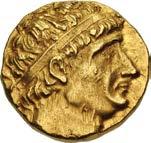



213. SELEUKID EMPIRE. Antiochos I Soter. 281-261 BC. AV Stater (16.5mm, 8.43 g, 6h). Aï Khanoum mint. Struck circa 266-261 BC. Diademed head right, with elderly features / Apollo, testing arrow and placing hand on grounded bow, seated left on omphalos; d to inner left above arrow. SC 435.3; SMAK A1SA-27 (A22/P24); ESM 703β = ANS inv. 1944.100.74359 (same dies); HGC 9, 122. Some die wear, a little off center on reverse. Good VF. ($5000)
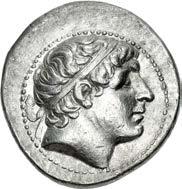
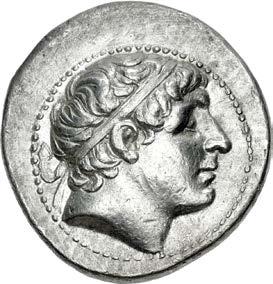

214. SELEUKID EMPIRE. Antiochos II Theos. 261-246 BC. AR Tetradrachm (29.5mm, 16.78 g, 11h). Myrina mint. Diademed head right / Herakles, holding club set on ground, seated left on rock draped with lion’s skin; amphora to outer left, ÷ to lower right. SC 500.1a; HGC 9, 241b. Some hairlines. Good VF. Struck on a broad flan. ($500)

Apparently Unique Variety

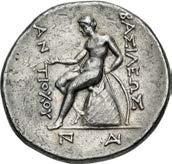

215. SELEUKID EMPIRE. Antiochos II Theos. 261-246 BC. AR Tetradrachm (27.5mm, 16.55 g, 1h). Sardes mint. Diademed head of Antiochos I right / Apollo, testing two arrows and resting hand on grounded bow, seated left on omphalos; D and 5 in exergue. SC 518d var. (one arrow); WSM 1387 var. (one arrow); HGC 9, 236f; Hunterian 27 var. (one arrow; same obv. die). Lightly toned. EF. High relief portrait. Apparently unique variety with two arrows. ($3000)
From the Deer Creek Collection. Ex MNL Collection (Classical Numismatic Group 114, 13 May 2020), lot 388, purchased from Gorny & Mosch, January 2012. Ex G. Hirsch 275 (22 September 2011), lot 3987; Giessener Münzhandlung 36 (8 April 1987), lot 272.
Of all the issues of SC 518, 518d is the only one recorded with Apollo testing only one arrow. However, the present piece clearly shows two arrows; apparently the only example known.

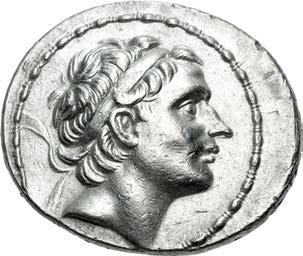
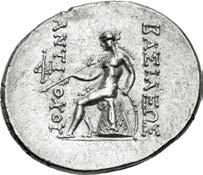
216. SELEUKID EMPIRE. Antiochos III ‘the Great’. 222-187 BC. AR Tetradrachm (33mm, 16.98 g, 12h). Antioch on the Orontes mint. Series 3, circa 204-197 BC. Diademed head (Type Cii) right / Apollo, testing arrow and resting hand on grounded bow, seated left on omphalos; ¬ to outer left. SC 1044.4a; Le Rider, Antioche, 112–25 (obv. die A8); HGC 9, 447u. Slight roughness on reverse. Near EF. Bold portrait. ($500)

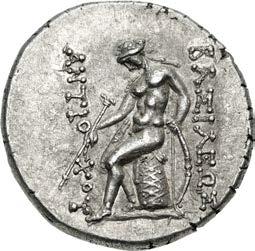

217. SELEUKID EMPIRE. Antiochos III ‘the Great’. 222-187 BC. AR Tetradrachm (27mm, 17.09 g, 12h). Antioch on the Orontes mint. Struck circa 197–192/0 BC. Diademed head (type D) right / Apollo, testing arrow and resting hand on grounded bow, seated left on omphalos; no control marks. SC 1045.5; Le Rider, Antioche, Series III-IV, 274–6 (obv. die A29); HGC 9, 447u. Lightly toned, slight die wear on obverse, tiny deposit on reverse. Near EF. ($500)
From the JTB Collection. Ex Leu Numismatik AG Web Auction 29 (24 February 2024), lot 1074.

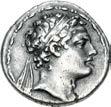
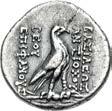
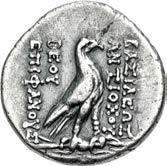
218. SELEUKID EMPIRE. Antiochos IV Epiphanes. 175-164 BC. AR Drachm (18mm, 4.00 g, 12h). Antioch on the Orontes mint. Stuck circa 169 BC. Diademed head right / Eagle standing right on thunderbolt. SC 1404; Le Rider, Antioche, Series II, 23 var. (A2/P– [unlisted rev. die]); HGC 9, 627. Lightly toned, hairline flan crack, faint cleaning scratches. VF. Extremely rare. ($1500)
Antiochos IV Epiphanes, third and youngest son of Antiochos the Great, was born about 215 BC. Following the battle of Magnesia in 189, the young prince was sent as a hostage to Rome and was thus unable to play an active role in Seleukid politics throughout the reign of his elder brother, Seleukos IV. In 175, Seleukos was murdered by his minister Heliodoros, who attempted to install on the Syrian throne Antiochos, the 5-year-old younger son of the late king. An elder son, Demetrios, had only recently been sent to Rome as a hostage in place of his uncle Antiochos, who was on his way back to Syria at the time of his brother’s murder. Antiochos now saw his opportunity to seize power in Syria, and he hastened to Antioch where he overthrew Heliodoros and ascended to the throne of his ancestors. The new king soon showed that he was no traditionalist, replacing the time-honored reverse type of seated Apollo on the Seleukid coinage with an enthroned figure of Zeus Nikephoros, and adopting the grandiose and provocative title “God Manifest.” Rome was forced to intervene when he led a series of invasions of Egypt between 170 and 168 BC, and Antiochos was obliged to withdraw, though he claimed a great victory. The following year he had to face a serious Jewish revolt led by Judas Maccabaeus, the result of a tactless policy of Hellenization. This issue was still unresolved at the time of his sudden death while on campaign in Persis during the winter of 165/4 BC.
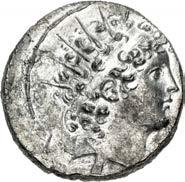

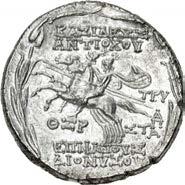
219. SELEUKID EMPIRE. Antiochos VI Dionysos. 144-142 BC. AR Tetradrachm (30mm, 14.63 g, 1h). Antioch mint. Dated SE 169 (144/3 BC). Radiate and diademed head right / The Dioskouroi on horseback riding left, holding couched lances; to right, trU, K, and %tÅ; O$r (date) below; all within wreath of lily, ivy, and grain ears. SC 2000.2b; HGC 9, 1032; DCA2 118. Lightly toned, some roughness and granularity, slightly off center. Near EF. ($1000)

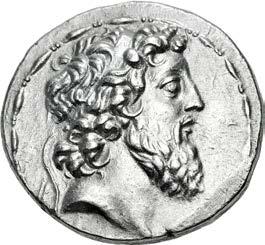

220. SELEUKID EMPIRE. Demetrios II Nikator. Second reign, 129-125 BC. AR Tetradrachm (29mm, 16.04 g, 12h). Tarsos mint, “Royal workshop.” Diademed head right within fillet border / Zeus Nikephoros seated left; to outer left, ± above ±. SC 2157.1; Houghton, Second, Group D, dies A5/P11; HGC 9, 1117a. Bright surfaces, remnants of horn silver, hairlines, a hint of porosity, graffito and a little off center on reverse. Good VF. ($500)
After establishing himself in power over the Seleukid Empire by rather brutal means, Demetrios II undertook to reclaim his eastern territories from the Parthians in 138 BC. At first successful, his forces were ambushed in the Iranian mountains and Demetrios was taken prisoner by the Parthian King Mithradates I. He remained in captivity for eight years, during which time Mithradates treated him honorably and even married him to a Parthian princess. He was released in 130 BC to sow discord within the ranks of the invading Seleukid army of his brother and successor, Antiochos VII. However, Antiochos was killed in the ensuing military debacle, leaving Demetrios II as sole ruler for the second time. His years among the Parthians had changed him visibly – he emerged with a long, flowing beard, much against Greek fashion of the day. His pro-Parthian policies made his countryman regard him suspiciously, leading to his overthrow in 125 BC. Despite his troubled regime, his coin portraits from the second reign are some of the best in the entire Seleukid series.

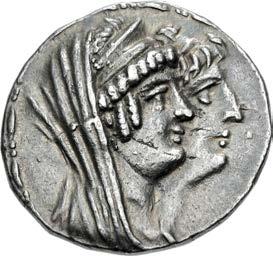
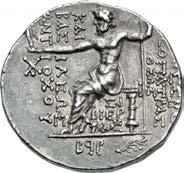
tone, a few flan flaws and some die wear on obverse. Good VF. Very rare. ($1000)
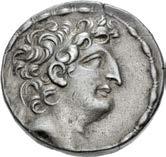
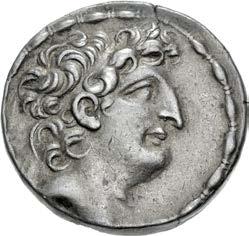

222. SELEUKID EMPIRE. Antiochos VIII Epiphanes (Grypos). 121/0-97/6 BC. AR Tetradrachm (27mm, 16.20 g, 12h). Antioch on the Orontes mint. Third reign at Antioch, circa 109-96 BC. Diademed head right / Zeus Nikephoros seated left; to outer left, Ÿ above `; @ below throne; all within laurel wreath. SC 2309.1d; HGC 9, 1200. Deeply toned, traces of find patina, flan crack. Good VF. ($500)
Ex Mark & Lottie Salton Collection (Stack’s Bowers Galleries, 13 January 2023), lot 26262; Salton-Schlessinger XXIII (22 November 1955), lot 717.
Lot includes photos of the coin used for the production of the 1955 catalog.

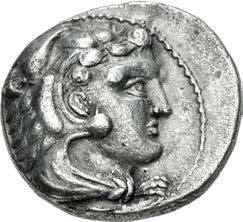

223. PHOENICIA, Byblos (Gebal). ‘Aynel (Enylos). Circa 350-316/5 BC. AR Tetradrachm (26mm, 16.65 g, 12h). In the name and types of Alexander III of Macedon. Byblos mint. Struck circa 332-323 BC. Head of Herakles right, wearing lion skin / Zeus Aëtophoros seated left; yo (‘AY in Phoenician) below throne. E&E-B p. 129, n. 168; Price 3421; ANS inv. 1947.98.296 = Demanhur 3586 (same obv. die). Faintly toned, granular surfaces, remnants of find patina on obverse, horn silver on reverse. VF. The second known example, only the Demanhur piece published and referenced; none in the ANS photofile, CoinArchives, nor the large Byblos hoard. ($500)
With the reattribution to Arados of all the other issues that Price assigned to Byblos, this issue, bearing the first letters of the name of ‘Aynel on the reverse, remains the sole issue of Alexander type at Byblos. With the appearance of the only example being the Demanhur specimen (1905), the present coin is the first to appear in over 100 years, and the only example in private hands.

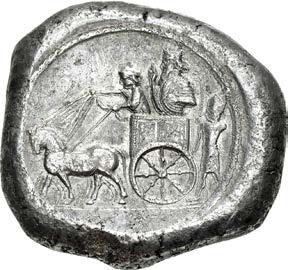

224. PHOENICIA, Sidon. Ba`alšillem (Sakton) II. Circa 401-365 BC. AR Dishekel (32mm, 27.74 g, 11h). Phoenician galley left; B (B in Phoenician) above, waves below / Persian king and driver in chariot left; behind, king of Sidon, in Egyptian style garments, holding cultic scepter and votive vase, walking left. E&E-S Group IV.1.1.a, 629 (D36/R49); Rouvier 1096; Betlyon 18; HGC 10, 236. Lightly toned, minor roughness. Good VF. Boldly struck on a broad flan. ($1500)
From the Plus 20 Collection. Ex Dr. Patrick H. C. Tan Collection (Triton XX, 10 January 2017), lot 356.
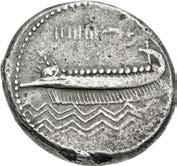

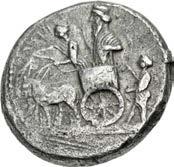
225. PHOENICIA, Sidon. Mazaios (Mazday). Satrap of Eber Nari, 353-333 BC. AR Dishekel (28mm, 25.55 g, 12h).
Dated RY 18 (336/5 BC). Phoenician galley left; [...]zzzzzzzz0b (B and 18 [date] in Phoenician) above, waves below / King of Persia and driver in chariot drawn by three horses left; behind, King of Sidon standing left, in Egyptian dress, holding cultic scepter and votive vase. E&E-S Group IV.6.1.k, 1984 (D21/R27 – this coin, illustrated); HGC 10, 264; DCA2 834. Toned, light roughness and porosity, a few marks. VF. ($750)
Ex Numismatic Fine Arts [XXI] (12 October 1988), lot 564.
Sidon (modern Saida) was an important commercial center located on the coast of Phoenicia. Archaeological evidence dates the earliest remains to the Palaeolithic era. In the 10th century BC, the Phoenicians freed the city from Egyptian control and developed it into a maritime power through trade with other settlements throughout the eastern Mediterranean. During this time, it is thought that Tyre was founded by colonists from Sidon. Over the next five centuries, the city fell under Assyrian, Babylonian, and, eventually, Persian control. In the latter period, Sidon became the most important city of Phoenicia, and it was the first to develop a local coinage. These coins were struck under the local Sidonian king, and typically consisted of iconography representing the king and his overlord, the Great King of Persia, as well as a galley, the source of Sidonian wealth and power.

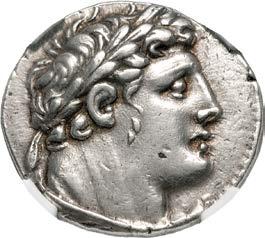

226. PHOENICIA, Tyre. 126/5 BC-AD 65/6. AR Shekel (28.5mm, 14.33 g, 1h). Dated CY 23 (104/3 BC). Laureate head of Melkart right, lion skin around neck / Eagle standing left on prow, palm frond in background; to left, ˝˚ (date) above club; Ò to right, Å (Phoenician A) between legs. DCA-Tyre 72 (this coin illustrated); HGC 10, 358; DCA2 946. In NGC encapsulation 4278088-005, graded Ch XF, Strike: 5/5, Surface: 4/5. ($1000)



227. PHOENICIA, Tyre. 126/5 BC-AD 65/6. AR Shekel (27mm, 13.97 g, 12h). Dated CY 30 (97/6 BC). Laureate head of Melkart right, lion skin around neck / Eagle standing left on prow, palm frond in background; to left, l¬ (date) above club; Ê to right, b (Phoenician B) between legs. DCA-Tyre 107; HGC 10, 357; DCA2 946. In NGC encapsulation 4277465-001, graded Ch XF, Strike: 5/5, Surface: 4/5. ($1000)

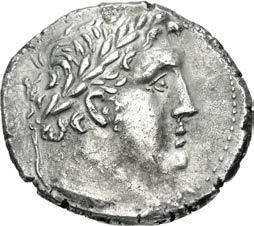
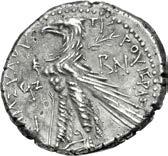
228. PHOENICIA, Tyre. 126/5 BC-AD 65/6. AR Shekel (27.5mm, 14.20 g, 12h). Dated CY 97 (30/29 BC). Laureate head of Melkart right, lion skin around neck / Eagle standing left on prow; palm frond in background; to left, rZ (date) above club; ∫@ to right, b (Phoenician B) between legs. DCA-Tyre 340 (same dies as illustration); HGC 10, 357; DCA2 946. Traces of horn silver, minor cleaning scratches, a couple pits on reverse. Good VF. Rare date. ($1000)
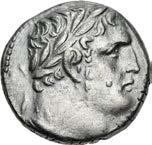

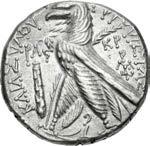
229. PHOENICIA, Tyre. 126/5 BC-AD 65/6. AR Shekel (25mm, 14.07 g, 1h). Lifetime of Christ issue. Dated CY 136 (AD 10/11). Laureate head of Melkart right, [lion skin around neck] / Eagle standing left on prow; palm frond in background; to left, r¬? (date) above club; to right, ˚r above …; b (Phoenician B) between legs. DCA-Tyre 486 (same obv. die as illustration); HGC 10, 357; DCA2 947. Traces of horn silver, hairlines, tiny die break on obverse. Good VF. ($750)
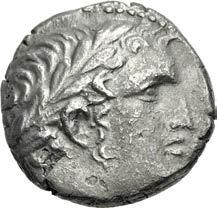
“Crucifixion Shekel”



230. PHOENICIA, Tyre. 126/5 BC-AD 65/6. AR Shekel (23.5mm, 13.93 g, 1h). Lifetime of Christ issue. Dated CY 159 (AD 33/4). Laureate head of Melkart right, [lion skin around neck] / Eagle standing left on prow; palm frond in background; to left, r@œ (date) above club; to right, ˚r above ); b (Phoenician B) between legs. DCA-Tyre 578 (same obv. die as illustration); HGC 10, 357; DCA2 947. Toned, compact flan, light roughness on obverse, minor flan flaw on reverse. Good VF. Clear date. ($3000)
According to the traditional chronology, this coin was struck in the year of Jesus’ crucifixion.
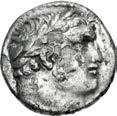


231. PHOENICIA, Tyre. 126/5 BC-AD 65/6. AR Half Shekel (19mm, 6.65 g, 12h). Dated CY 159 (AD 33/4). Laureate head of Melkart right, [lion skin around neck] / Eagle standing left on prow; palm frond in background; to left, r@œ (date) above club; to right, ˚r above O; a (Phoenician A) between legs. DCA-Tyre 876; HGC 10, 358; DCA2 949. Faintly toned, traces of find patina, roughness, delaminations, cleaning scratches. VF. Rare. ($1000)
According to the traditional chronology, this coin was struck in the year of Jesus’ crucifixion.
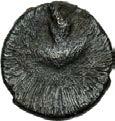



232. JUDAEA, Yehud (Achaemenid). Circa 350-333 BC. AR Hemiobol (7mm, 0.32 g, 7h). Attic standard. Sacrificial dove standing right on basin / Falcon flying upward, head right. GLF Type 15, dies O1/R1; Hendin 6062; Meshorer –. Toned, much find patina remaining, off center. VF. Rare. ($750)

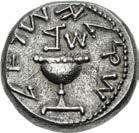

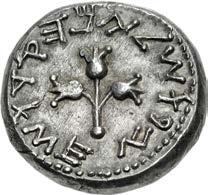
233. JUDAEA, Jewish War. 66-70 CE. AR Shekel (22.5mm, 14.17 g, 12h). Jerusalem mint. Dated year 2 (67/8 CE). Omer cup / Sprig of three pomegranates. Deutsch 4 (O1/R4); Kadman 8; Hendin 6388; Meshorer 193; Bromberg I 63 (same dies). Attractively toned, a couple of minor flan flaws, die break on obverse, minor scrape on reverse. EF. ($4000)
Property from an English Private Collection.
Struck during the Jewish War against Rome, which lasted for at least part of five calendar years, these silver Shekels demonstrate a separation from Roman authority. Unlike Roman coins, they bore no human portrait, in order to keep the commandment that “thou shalt not make a graven image.” Legends were written in the language of Jews, Hebrew; the lettering, however, is an archaic form known as “proto-Hebrew,” a form close to the Phoenician script from which it derived. Important religious imagery was the central design on either side; namely, the Omer cup, which held the “first fruits,” the measure of barley during Passover, and the sprig of three pomegranates, used as decoration on many religiously significant items.
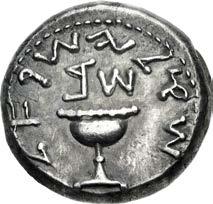
66-70

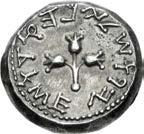

2
/ Sprig of three pomegranates. Deutsch 16 (O3/R14); Kadman 8; Hendin 6388; Meshorer 193; Bromberg I 63; Shoshana I 20202–3; Sofaer 7–8; Spaer 167–8. Toned, traces of find patina. Near EF.

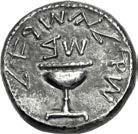

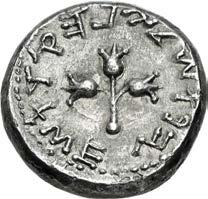
Property from an English Private Collection.


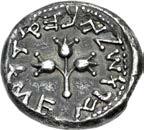
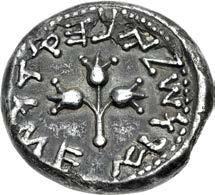
Property from an English Private Collection.







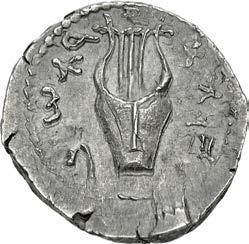


Though the full extent of its causes are debated, what is certain is that the Bar Kochba Revolt of 132-135 CE was bloody and devastating. Hadrian made a brief visit to Judaea circa 130 CE, during his second great provincial tour of 129-132 CE. Prior to his arrival, rumors spread among the Jews that he intended to rebuild Jerusalem and the great Temple, destroyed during the Jewish War of 66-73 CE, so he was at first warmly welcomed. However, according to the Roman historian Cassius Dio, Hadrian decided to rebuild the city as the Roman veteran colony of Aelia Capitolina, with a temple to Jupiter replacing the one once dedicated to YAHWEH. It is also claimed in the Historia Augusta that Hadrian made circumcision a capital offense, although Cassius Dio does not mention this law. A combination of one or both of these factors likely sparked the revolt, which decimated the province of Judaea and darkened Hadrian’s final years.
Led by the military leader Simon ben Kosiba (known as Simon bar Kochba [Son of the Star]), a brave and harshly meticulous general, Dio writes that the Judaean forces literally fought underground, “occupy[ing] the advantageous positions in the country and strengthen[ing] them with mines and walls so that they would have places of refuge when hard pressed and could communicate with one another unobserved underground; and they pierced these subterranean passages from above at intervals to let in air and light.” Though these tactics were effective in causing great expense to the Roman Empire, particularly as “many Romans ... perished in this war,” they were ultimately not enough to avert disaster. “Very few of [the Jews] in fact survived. Fifty of their most important outposts and nine hundred and eighty-five of their most famous villages were razed to the ground. Five hundred and eighty thousand men were slain in the various raids and battles, and the number of those that perished by famine, disease, and fire was past finding out.” Throughout the failed rebellion, the city remained under Roman control and served as a base of operations for the Sixth and Tenth Legions. Aelia Capitolina remained the city’s official name until 324 CE, although Christians and Jews continued to call it Jerusalem. Jews were banned from entering the city except for one day a year, Tisha B’Av, when they were allowed to mourn at the Western Wall. The mint of Aelia Capitolina produced bronze coins through the reign of Trajan Decius (251 CE).
As David Hendin notes, Bar Kochba’s historically important coins would mark an end to the minting of Jewish coins in antiquity. Though there was absolutely no financial incentive for the Jews to strike their own coins during the revolt as all of the Bar Kochba coinage was overstruck on a motley mix of coins already in circulation, Judaean coinage from this period played an integral role in the dissemination of political propaganda. As Meshorer notes: “Not only did [Bar Kochba] deface the portraits of despised emperors by this technique [of overstriking], he was also able to depict Jewish symbols and nationalistic inscriptions.” Coins were struck with hopeful slogans, such as: “Jerusalem” and “For the freedom of Jerusalem.” Though these coins were useful for the morale of the rebellion, they still marked a period of extreme economic chaos for the Jewish fighters. They “neither controlled an already established mint, nor possessed a city large enough to support a new one.” The lack of consistency this caused was evident, as “the difference in weight between coins that are ostensibly of the same denomination [could] reach 200%.” This resulted in coins of often unique variety, both material and historical.

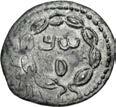
Legend in two lines within wreath / Palm frond. Mildenberg 29

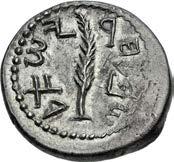
Hendin 6419; Meshorer
year 2
Toned, overstruck on uncertain type. Good VF. ($750)
Property from an English Private Collection.




Property from an English Private Collection.



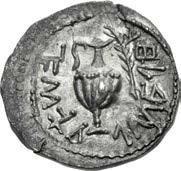
239. JUDAEA, Bar Kochba Revolt. 132-135 CE. AR Zuz – Denarius (19.5mm, 2.97 g, 7h). Dated year 2 (133/4 CE). Legend in two lines within wreath / Flagon with handle; palm frond to right. Mildenberg 34 (O5’/R22); Hendin 6420; Meshorer 250. Toned, overstruck on a Roman Arabian drachm (probably of Trajan). EF. ($1000)
Property from an English Private Collection.


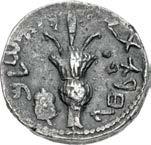
240. JUDAEA, Bar Kochba Revolt. 132-135 CE. AR Sela – Tetradrachm (24.5mm, 14.47 g, 12h). Undated, attributed to year 3 (134/5 CE). Façade of the Temple at Jerusalem; showbread table within, star above / Bundle of lulav; etrog to left. Mildenberg 79 (O12/R62); Meshorer 267; Hendin 6439; Bromberg 115 (same dies); Shoshana II 20211–2 (same dies); Sofaer 108 (same rev. die); Spaer 194 (same dies). Toned, much find patina, trace deposits, areas of weak strike. VF. ($2500)
Property from an English Private Collection.

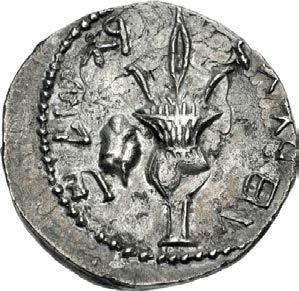
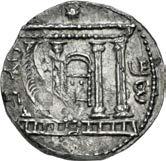


241. JUDAEA, Bar Kochba Revolt. 132-135 CE. AR Sela – Tetradrachm (27mm, 14.60 g, 12h). Undated, attributed to year 3 (134/5 CE). Façade of the Temple at Jerusalem; showbread table within, star above / Bundle of lulav; etrog to left. Mildenberg 80 (O12/R45); Meshorer 267; Hendin 6439; Bromberg 116 (same dies); Shoshana I 20350 (same obv. die); Sofaer 108; Spaer 194 (same obv. die). Toned, overstruck on a tetradrachm of Nero (his portrait and partial legend visible on the reverse). Near EF. ($5000)
From the Deer Creek Collection. Ex Triton XXV (11 January 2022), lot 440.


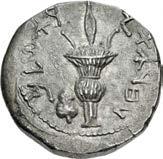

242. JUDAEA, Bar Kochba Revolt. 132-135 CE. AR Sela – Tetradrachm (26.5mm, 13.97 g, 1h). Undated, attributed to year 3 (134/5 CE). Façade of the Temple at Jerusalem; showbread table within, star above / Bundle of lulav; etrog to left. Mildenberg 83 (O12/R53); Meshorer 267; Hendin 6439; Shoshana I 20353 (this coin). Toned, slight roughness, minor doubling on reverse. Near EF. Very rare die combination, only two noted by Mildenberg, not in Bromberg, Sofaer, or Spaer collections. ($3000)
Property from an English Private Collection. Ex Shoshana Collection (Part I, Heritage 3003, 8 March 2012), lot 20353.
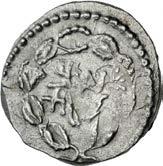
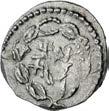


243. JUDAEA, Bar Kochba Revolt. 132-135 CE. AR Zuz – Denarius (18mm, 3.44 g, 12h). Undated, attributed to year 3 (134/5 CE). Legend in two lines within wreath / Palm frond. Mildenberg 63 (O14/R35); Meshorer 279b; Hendin 6443; Shoshana I 20374 (this coin). Areas of weak strike, overstruck on an uncertain Roman drachm or denarius. Good VF. ($750)
Property from an English Private Collection. Ex Shoshana Collection (Part I, Heritage 3003, 8 March 2012), lot 20374.
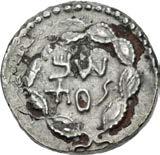



244. JUDAEA, Bar Kochba Revolt. 132-135 CE. AR Zuz – Denarius (17.5mm, 3.21 g, 12h). Undated, attributed to year 3 (134/5 CE). Legend in two lines within wreath / Palm frond. Mildenberg 65.8 (O14/R37) = Shoshana I 20377 (this coin); Meshorer 279b; Hendin 6443. Toned, deposits on obverse, overstruck on an uncertain Roman drachm or denarius. Good VF. ($750)
Property from an English Private Collection. Ex Shoshana Collection (Part I, Heritage 3003, 8 March 2012), lot 20377, purchased from Abraham Bromberg.
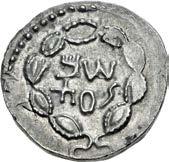


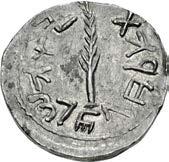
245. JUDAEA, Bar Kochba Revolt. 132-135 CE. AR Zuz – Denarius (18.5mm, 3.52 g, 12h). Undated, attributed to year 3 (134/5 CE). Legend in two lines within wreath / Palm frond. Mildenberg 65 (O14/R37); Meshorer 279b; Hendin 6443. Faintly toned, some light scratches, edge marks, slight die wear on obverse, overstruck on an uncertain Roman drachm or denarius. Good VF. ($750)
Property from an English Private Collection.
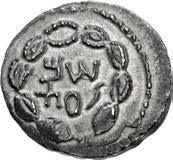


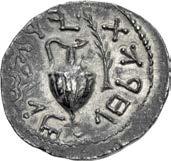
246. JUDAEA, Bar Kochba Revolt. 132-135 CE. AR Zuz – Denarius (19mm, 2.81 g, 12h). Undated, attributed to year 3 (134/5 CE). Legend in two lines within wreath / Flagon with handle; palm frond to right. Mildenberg 79 (O14/R51); Hendin 6445; Meshorer 283b corr. (illustration is retrograde; same obv. die as illustration). Toned, traces of undertype. Good VF. ($750)
Property from an English Private Collection.
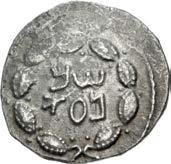
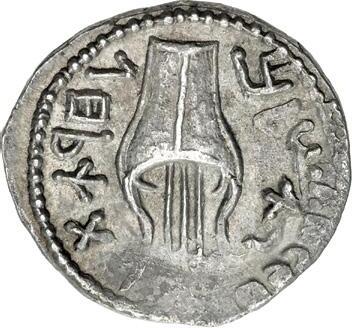


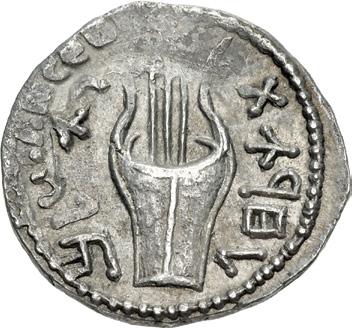
247. JUDAEA, Bar Kochba Revolt. 132-135 CE. AR Zuz – Denarius (18.5mm, 2.82 g, 1h). Undated, attributed to year 3 (134/5 CE). Legend in two lines within wreath / Elongated kithara. Mildenberg 101 (O16/R69); Hendin 6451; Meshorer 272b; Shoshana I 20413 (this coin). Toned, remnants of find patina, small area of weak strike, overstruck on a Roman Arabian drachm of Trajan (his silhouette visible on reverse). VF. ($750)
Property from an English Private Collection. Ex Shoshana Collection (Part I, Heritage 3003, 8 March 2012), lot 20413, purchased from Abraham Bromberg.




248. JUDAEA, Bar Kochba Revolt. 132-135 CE. AR Zuz – Denarius (18.5mm, 3.55 g, 1h). Undated, attributed to year 3 (134/5 CE). Legend in two lines within wreath / Fluted jug and branch. Mildenberg 104 (O16/R55); Hendin 6449; Meshorer 283a; Shoshana I 20402 (this coin). Toned, small area of weak strike, minor doubling, area of porosity on reverse, traces of undertype. Near EF. ($1000)
Property from an English Private Collection. Ex Shoshana Collection (Part I, Heritage 3003, 8 March 2012), lot 20402, purchased from Abraham Bromberg.



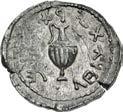
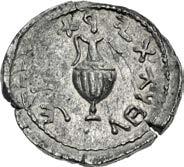
249. JUDAEA, Bar Kochba Revolt. 132-135 CE. AR Zuz – Denarius (20mm, 3.31 g, 12h). Undated, attributed to year 3 (134/5 CE). Legend in two lines within wreath / Flagon with handle. Mildenberg 128 (O19/R89); Hendin 6455; Meshorer 284. Toned, overstruck on a Roman Arabian drachm of Trajan (portions of his portrait visible on the obverse). Near EF. ($750)
Property from an English Private Collection, purchased from Paul Rynearson, February 1994.



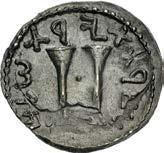
250. JUDAEA, Bar Kochba Revolt. 132-135 CE. AR Zuz – Denarius (18mm, 2.88 g, 12h). Undated, attributed to year 3 (134/5 CE). Legend in two lines within wreath / Two upright trumpets; pellet between. Mildenberg 131 (O19/R91); Hendin 6453; Meshorer 276 (same dies as illustration); Shoshana I 20420 (this coin). Toned, overstruck on an uncertain Roman denarius or drachm. EF. ($750)
Property from an English Private Collection. Ex Shoshana Collection (Part I, Heritage 3003, 8 March 2012), lot 20420.
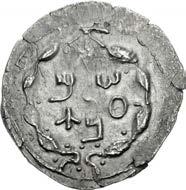


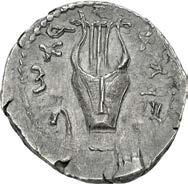
251. JUDAEA, Bar Kochba Revolt. 132-135 CE. AR Zuz – Denarius (20mm, 3.19 g, 12h). Undated, attributed to year 3 (134/5 CE). Legend in two lines within wreath / Elongated kithara. Mildenberg 137.6 (O19/R67) = Shoshana I 20435 (this coin, illustrated in both); Hendin 6456; Meshorer 272c. Toned, minor doubling on reverse, traces of undertype. EF. ($1000)
Property from an English Private Collection. Ex Shoshana Collection (Part I, Heritage 3003, 8 March 2012), lot 20435, purchased from Abraham Bromberg; El Fawar 1978 Hoard (Mildenberg no. 26).


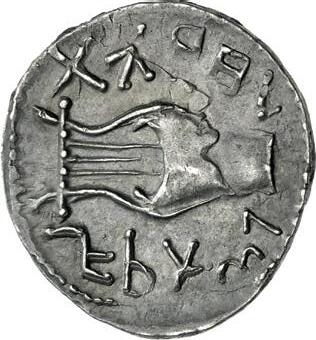


252. JUDAEA, Bar Kochba Revolt. 132-135 CE. AR Zuz – Denarius (18.5mm, 3.19 g, 7h). Undated, attributed to year 3 (134/5 CE). Grape bunch on vine tendril / Elongated kithara. Mildenberg 143 (O21/R98); Hendin 6462; Meshorer 275; Shoshana I 20469 (this coin). Toned, overstruck on an uncertain Roman denarius or drachm (part of portrait visible on the reverse). Near EF. ($750)
Property from an English Private Collection. Ex Shoshana Collection (Part I, Heritage 3003, 8 March 2012), lot 20469; Lanz 42 (23 November 1987), lot 328; Schweizerische Kreditanstalt FPL 50 (December 1986), no. 61.


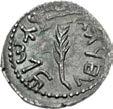

253. JUDAEA, Bar Kochba Revolt. 132-135 CE. AR Zuz – Denarius (18.5mm, 2.11 g, 6h). Undated, attributed to year 3 (134/5 CE). Grape bunch on vine tendril / Palm frond. Mildenberg 149 (O11/R102); Hendin 6457; Meshorer 281; Shoshana I 20438 (this coin). Toned, overstruck on a Roman Arabian drachm of Trajan (portions of his portrait visible on the obverse). Good VF. ($750)
Property from an English Private Collection. Ex Shoshana Collection (Part I, Heritage 3003, 8 March 2012), lot 20438.



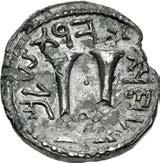
254. JUDAEA, Bar Kochba Revolt. 132-135 CE. AR Zuz – Denarius (18mm, 3.38 g, 7h). Undated, attributed to year 3 (134/5 CE). Grape bunch on vine tendril / Two upright trumpets. Mildenberg 154.4 (O11/R104) = Bromberg II 511 = Shoshana I 20446 (this coin); Hendin 6458; Meshorer 277. Toned, remnants of find patina, flan flaw on obverse, overstruck on an uncertain Roman issue (portrait is partially visible on the reverse, which is either that of Nerva or and early issue of Trajan). VF. ($750)
Property from an English Private Collection. Ex Shoshana Collection (Part I, Heritage 3003, 8 March 2012), lot 20446; Abraham Bromberg Collection (Part II, Superior, 10 December 1992), lot 511; Malter 4 (29 October 1978), lot 60; Galerie des Monnaies (9 June 1978), lot 1491.

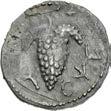
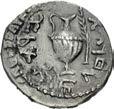
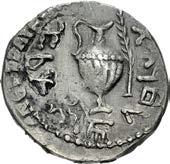
255. JUDAEA, Bar Kochba Revolt. 132-135 CE. AR Zuz – Denarius (18mm, 3.10 g, 7h). Undated, attributed to year 3 (134/5 CE). Grape bunch on vine tendril / Flagon with handle; palm frond to right. Mildenberg 157 (O11/R77); Hendin 6460; Meshorer 285; Shoshana I 20458 (this coin). Toned, remnants of find patina, overstruck on a Roman Arabian drachm of Trajan. VF. ($750)
Property from an English Private Collection. Ex Shoshana Collection (Part I, Heritage 3003, 8 March 2012), lot 20458, purchased from Abraham Bromberg.




256. JUDAEA, Bar Kochba Revolt. 132-135 CE. AR Zuz – Denarius (18mm, 3.26 g, 6h). Undated, attributed to year 3 (134/5 CE). Grape bunch on vine tendril / Flagon with handle; palm frond to right. Mildenberg 158 (O11/R52); Hendin 6460; Meshorer 285; Shoshana I 20459 (this coin). Light iridescent tone, minor deposits, overstruck on a Roman Arabian drachm of Trajan. Good VF. ($750)
Property from an English Private Collection. Ex Shoshana Collection (Part I, Heritage 3003, 8 March 2012), lot 20459, purchased from C. Kaufman.

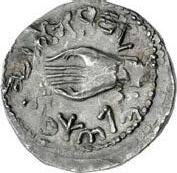

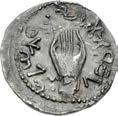
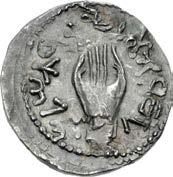
257. JUDAEA, Bar Kochba Revolt. 132-135 CE. AR Zuz – Denarius (19mm, 3.33 g, 6h). Undated, attributed to year 3 (134/5 CE). Grape bunch on vine tendril / Elongated kithara. Mildenberg 160 (O21/R98); Hendin 6462; Meshorer 275; Shoshana I 20472 (this coin). Toned, overstruck on an uncertain Roman denarius (with a Flavian style portrait visible on the reverse). Good VF. ($750)
Property from an English Private Collection. Ex Shoshana Collection (Part I, Heritage 3003, 8 March 2012), lot 20472.
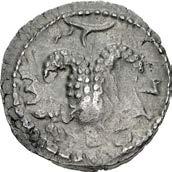



258. JUDAEA, Bar Kochba Revolt. 132-135 CE. AR Zuz – Denarius (19mm, 3.40 g, 6h). Undated, attributed to year 3 (134/5 CE). Grape bunch on vine tendril / Two upright trumpets. Mildenberg 200.3 (O24/R128) = Bromberg II 533 = Shoshana I 20448 (this coin); Hendin 6458; Meshorer 277. Toned, slightly off center on reverse, overstruck on a Roman Arabian drachm of Trajan. Good VF. ($750)
Property from an English Private Collection. Ex Shoshana Collection (Part I, Heritage 3003, 8 March 2012), lot 20448; Abraham Bromberg Collection (Part II, Superior, 10 December 1992), lot 533; Hess-Leu [22] (4 April 1963), lot J95. Reportedly ex Virgil Brand Collection.
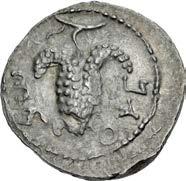

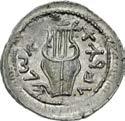

259. JUDAEA, Bar Kochba Revolt. 132-135 CE. AR Zuz – Denarius (20.5mm, 3.25 g, 7h). Undated, attributed to year 3 (134/5 CE). Grape bunch on vine tendril / Elongated kithara. Mildenberg 201 (O24/R129); Hendin 6462; Meshorer 275. Toned, overstruck on a Roman Arabian drachm of Trajan. Near EF. ($750)
Property from an English Private Collection.
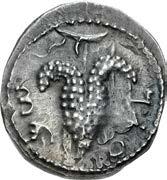
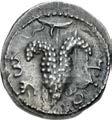

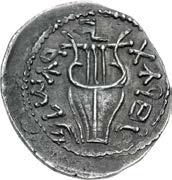
JUDAEA, Bar Kochba Revolt. 132-135 CE. AR Zuz – Denarius (18mm, 3.31 g, 6h). Undated, attributed to year 3 (134/5 CE). Grape bunch on vine tendril / Elongated kithara. Mildenberg 205 (O24/R133); Hendin 6462; Meshorer 275; Shoshana I 20487 (this coin). Toned, remnants of find patina, overstruck on an uncertain Roman denarius or drachm (with part of portrait visible on the reverse). Good VF. ($750)
Property from an English Private Collection. Ex Shoshana Collection (Part I, Heritage 3003, 8 March 2012), lot 20487, purchased from Abraham Bromberg.


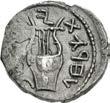

261. JUDAEA, Bar Kochba Revolt. 132-135 CE. AR Zuz – Denarius (17.5mm, 3.15 g, 6h). Undated, attributed to year 3 (134/5 CE). Grape bunch on vine tendril / Elongated kithara. Mildenberg 216 (O24/R139); Hendin 6462; Meshorer 275; Shoshana I 20497 (this coin). Toned, trace deposits, overstruck on uncertain type. VF. ($750)
Property from an English Private Collection. Ex Shoshana Collection (Part I, Heritage 3003, 8 March 2012), lot 20497.

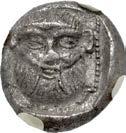

262. PHILISTIA (PALESTINE), Gaza (‘Azah). Mid 5th century-333 BC. AR Drachm (14mm, 3.92 g, 4h). Head of female right / Facing head of Bes in dotted square within incuse square. Gitler & Tal VI.14D; Fischer-Bossert, Notes 32. In NGC encapsulation 5783913-011, graded AU, Strike: 4/5, Surface: 3/5. ($1000)
Ex Heritage 61334 (13 August 2023), lot 22172.



263. NABATAEA. Malichos I. Circa 59/8-30 BC. AR Quarter Shekel – “Drachm” (16.5mm, 3.36 g, 12h). Petra mint. Dated RY 26 (35/4 BC). Diademed head right / Eagle standing left; palm frond to left; l ˚4 (date) to right. CN 10; Hoover & Barkay 15 = Barkay, Silver 1; Al-Qatanani 22; Meshorer, Nabataea 12 var. (no palm frond); HGC 10, 679; DCA2 1003. Toned, scratches under tone. Good VF. ($750)
Ex Classical Numismatic Group 123 (23 May 2023), lot 241 (hammer $1800).
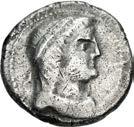
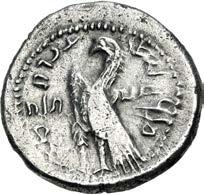
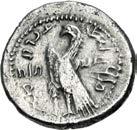
264. NABATAEA. Obodas II. Circa 30-9 BC. AR Half Shekel (22mm, 6.79 g, 12h). Pre-reform coinage. Petra mint. Dated RY 3 (28/7 BC). Diademed and draped bust right / Eagle standing left; tbt tn! (ŠNT TLT in Nabataean = year three [date]) across central field. CN 24; Barkay, King 5; Meshorer, Nabataea –; DCA2 1011. Toned, some find patina, minor pitting, scratches, some die wear. VF. Struck on an unusually broad flan. Very rare. ($1000)

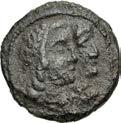


265. NABATAEA. Obodas II, with Hagaru I. Circa 30-9 BC. AR Sela’ (19.5mm, 4.61 g, 12h). Post-reform coinage. Petra mint. Dated RY 10 (21/0 BC). Jugate draped busts of Obodas, laureate, and Hagaru right / Laureate head of ZeusDushara(?) right; 0 tn! (ŠNT 10 in Nabataean = year 10 [date]) at end of legend to left. Unpublished, but cf. Barkay 54 for this obverse type, and Barkay 47 for an RY 10 issue with Zeus-Dushara as on this reverse. Rough, thick find patina, some cleaning marks, a little off center on reverse. VF. Apparently unique. ($1500)



266. PERSIA, Achaemenid Empire. temp Xerxes I to Darios II. Circa 485-420 BC. AV Daric (13.5mm, 8.33 g). LydoMilesian standard. Sardes mint. Persian king or hero, wearing kidaris and kandys, quiver over shoulder, in kneeling-running stance right, holding spear and bow / Incuse punch. Carradice Type IIIb, Group A/B (pl. XIII, 27); Meadows, Administration 321; BMC Arabia pl. XXIV, 26; Sunrise 24. A few minor marks on obverse. Near EF. ($1500)
During the Wars of the Delian League (477-449 BC), the Persians was beset by several internal problems. Among these were revolts that broke in various parts of their empire. Of particular importance was a revolt in Egypt led by the rebel Inaros (circa 460 BC). With Athenian aid, Inaros defeated and slew the Persian satrap Achaimenes at the Battle of Papremis (459 BC). Eventually, the Athenians were defeated and Inaros was captured and sent to Susa for execution.
Following the death of Artaxerxes I in 424 BC, the throne was challenged by two brothers – Xerxes II and Sogdianus – who together ruled for less than a year. Their illegitimate brother, Ochos, succeeded them as Darios II.

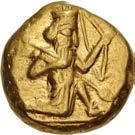

267. PERSIA, Achaemenid Empire. temp Xerxes I to Darios II. Circa 485-420 BC. AV Daric (14.5mm, 8.35 g). LydoMilesian standard. Sardes mint. Persian king or hero, wearing kidaris and kandys, quiver over shoulder, in kneeling-running stance right, holding spear and bow / Incuse punch. Carradice Type IIIb, Group A/B (pl. XIII, 27); Meadows, Administration 321; BMC Arabia pl. XXIV, 26; Sunrise 24. Slight die wear on obverse. Near EF. ($1500)
Ex Stack’s (7 March 2006), lot 512.
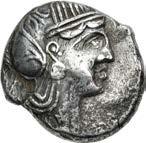


268. PERSIA, Alexandrine Empire. Mazakes. Satrap of Mesopotamia, circa 331-323/2 BC. AR Tetradrachm (24mm, 16.13 g, 9h). Imitating Athens. Helmeted head of Athena right / Owl standing right, head facing; olive spray and crescent to left, “Mazakes symbol” and kdzM (MZDK in retrograde Aramaic) to right. Le Rider, Alexander, pp. 214–9; Van Alfen, Owls, Group IIIa, 79 (same dies); Nicolet-Pierre, Monnaies, pl. 26, b–c. Toned, slight roughness, minor cleaning marks on obverse. VF. ($1000)
Mazakes is best known as the Persian satrap who took over Egypt after Sabakes fell in battle against Alexander the Great’s army at the Granicus, and later handed over the province peacefully to the Macedonian king. Imitative owls in the name of Mazakes have been known for some time, and all were originally attributed to his satrapy in Egypt. However, it was clear that stylistic elements separated the coinage into two general groups. More recent hoards, especially the 1973 Iraq hoard, have shown that one of the groups of imitative owls was certainly not struck in Egypt, but somewhere in the territory of modern day Iraq. In his analysis of the 1973 hoard, M. Price (“Circulation at Babylon in 323 B.C.” in W.E. Metcalf, ed., Mnemata: Papers in Memory of Nancy M. Waggoner [New York, 1991], pp. 63–72) changed the findspot from Iraq to the more specific site of Babylon, based on anecdotal evidence (p. 63), and gave the series of Mazakes’ owls to the city. However, such an assignment has forced numismatists to conduct mental gymnastics in order to rationalize the presence of Mazakes’ coins at Babylon (cf. Van Alfen, Owls, pp. 27–33, and Le Rider, Alexander, pp. 215–7, for a summary of the previous research). It is clear that the attribution of the owls to Babylon is almost certainly incorrect, and other find evidence suggests an attribution to somewhere further north, perhaps in the satrapy of Mesopotamia (cf. Le Rider, op. cit., p. 217–9). In any event, this coinage clarifies the historical record regarding the disposition of Mazakes following his hand-over of Egypt, upon which subject the literary evidence is silent. As noted by Le Rider (op. cit., p. 215), one can compare Mazakes to other Persians who peacefully welcomed Alexander to their domains: Mazaios, who handed over Cilicia, was later made satrap in Babylon, and Mithrenes, who surrendered Sardes, was made satrap in Armenia. Also, the Persian noble Amminapes, who met Alexander in Egypt with Mazakes, was later made satrap of Parthia and Hyrkania. Thus, one would expect Mazakes to receive similarly favorable treatment, appointment to some position of authority. Interestingly, Mesopotamia is the only satrapy that is not addressed in the literary evidence when Alexander is organizing his eastern territories. As these tetradrachms of Mazakes are found in that region, and date to the period after Alexander’s conquest, it is reasonable to suggest that Mazakes may have been appointed as satrap of Mesopotamia. It was also in the adjacent satrapy of Babylonia that Mazaios was allowed to strike a coinage in his name and types (influenced by his prior issues at Tarsos) for local use, and similar issues of local type and weight are known to have been issued at mints throughout the basin of the Tigris and Euphrates, from the time of Alexander to Seleukos I. Thus, these Athenian type tetradrachms likely constitute a local coinage of Mazakes, struck in the satrapy of Mesopotamia while he reigned there.


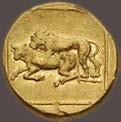

269. PERSIA, Alexandrine Empire. Mazaios. Satrap of Babylon, circa 331-328 BC. AV Double Daric (19.5mm, 17.07 g, 9h). Babylon(?) mint. Baal seated left, head and torso facing, holding scepter in right hand, grain ear and grape bunch on vine in left hand, upon which an eagle, wings folded, stands right / Lion left, grasping the back of a bull collapsing left, biting into its neck; all in linear square. F. Holt & O. Bopearachchi, The Alexander Medallion (2011), note 106; ibid. figs. 51–2 var. = Miho Museum, Treasures of Ancient Bactria (2002), 44 a–b var. (rev. type right); CNG 117, lot 322; Heritage 3073, lot 30206. For Mazaios’ Cilician silver prototype, cf. SNG Levante 100–6, and for similar local issues of the same type struck contemporaneously with this issue, cf. SNG BN 352–3. Slightly weak strike on high points, some minor marks. VF. Very rare. ($15,000)
From the Melinda Collection.
This extraordinary gold issue, unknown until the discovery of two examples in the Mir Zakah II deposit, bears the familiar types used by Mazaios as satrap of Cilicia for his silver staters, but without the usual legend and monograms. Mazaios was appointed satrap of Cilicia about 361 BC, and the region known as ‘Across the River’ (modern Syria, Lebanon, and Israel) was later added to his domain. In 331 BC, as Alexander marched into the heart of the Persian Empire, Mazaios at first led a spirited resistance, then abruptly surrendered Babylon to him and switched sides. Alexander rewarded Mazaios by retaining him as governor, a position he held until his death in 328 BC. Alexander made Babylon one of his most important mints, where a large quantity of regular ‘imperial’ coinage was struck. Babylon also produced a substantial group of local coinages, and it is among these that the present type is to be placed. Persian gold was routinely issued without legend, as were many of Mazaios’ standard double darics of the ‘running king’ type (MIG Type 14 = BMC Persia XX, 1). Perhaps it was an initial emergency issue that was later superseded, or perhaps it was a local variation for a special purpose.



270. PERSIA, Alexandrine Empire. temp Stamenes – Seleukos. Satraps of Babylon, circa 328/3-311 BC. AV Daric (12mm, 8.35 g). Babylon mint. Persian king or hero, wearing kidaris and kandys, quiver over shoulder, in kneeling-running stance right, holding spear in right hand, bow in left; to left, [f] above ¬ / Patterned incuse punch. Cf. Nicolet-Pierre 7 (double daric); cf. Babelon, Perses 119 = Traité II 761 = de Luynes 2817 (double daric); Triton IX, lot 1067 (same dies); CNG 112, lot 366; CNG 111, lot 409. Compact flan, trace deposits, off center on obverse, light mark on reverse. VF. Extremely rare, the fourth known of this issue. ($1500)
See B. Kritt, Andragoras, Double Darics, and the coinage of Alexandria on the Oxus (Lancaster, PA: Classical Numismatic Group, 2022), pp. 85–6, for a discussion of the connection of this extremely rare issue of darics to the double darics struck in Baktria.

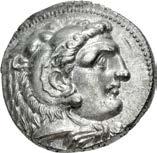
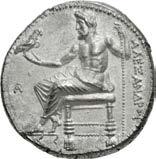

271. PTOLEMAIC KINGS of EGYPT. Ptolemy I Soter. As satrap, 323-305/4 BC. AR Tetradrachm (25.5mm, 16.94 g, 12h). In the name and types of Alexander III of Macedon. Arados mint. Struck circa 320/19-315 BC. Head of Herakles right, wearing lion skin / Zeus Aëtophoros seated left, legs crossed; 1 in left field. Price 3426 (Byblos mint); Taylor, Reattribution 229–33 (A45/P– [unlisted rev. die]); ANS inv. 1944.100.35056 (same obv. die). A hint of die wear on obverse. Superb EF. High relief. ($750)
Ptolemy I Soter, the son of a Macedonian nobleman, was a friend and intimate of Alexander III the Great from boyhood and accompanied him on his great career of conquest, from 333-323 BC. Upon Alexander’s death in 323 BC, Ptolemy was granted the prized satrapy of Egypt, the richest of the formerly Persian provinces. Alone among the Diadochi (“successors”), he was content with his sphere of influence and did not risk all to succeed Alexander. However, he was not above using the great conqueror’s image and reputation to secure his own position. He hijacked Alexander’s funeral cortege as it was proceeding back to Macedon and had his embalmed corpse formally interred at Memphis in Egypt; later the body was relocated to a splendid mausoleum in Alexandreia. Ptolemy declared his own kingship in 305/4 BC and was the only one of Alexander’s Successors to die peacefully, in his bed, in 282 BC, having founded a dynasty that would last three centuries.
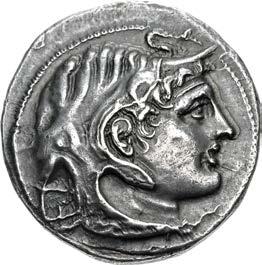



272. PTOLEMAIC KINGS of EGYPT. Ptolemy I Soter. As satrap, 323-305/4 BC, or king, 305/4-282 BC. AR Tetradrachm (28.5mm, 15.57 g, 1h). Ptolemaic standard. In the name of Alexander III of Macedon. Alexandreia mint. Struck circa 306-300 BC. Diademed head of the deified Alexander right, wearing elephant skin, aegis around neck / Athena Alkidemos advancing right, brandishing spear and wearing shield on arm; to right, helmet, », and eagle standing right on thunderbolt. CPE 63; Svoronos 168; Zervos Issue 24, dies 312/a; SNG Copenhagen 19. Deep old cabinet tone, minor doubling and some die wear on obverse. Good VF. ($1500)
Ex Sheik Saud Al Thani Collection (Part II, Numismatica Ars Classica 123, 9 May 2021), lot 890; Triton XIV (4 January 2011), lot 385.

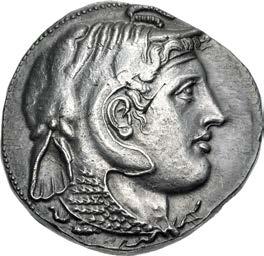
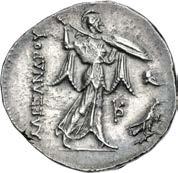
273. PTOLEMAIC KINGS of EGYPT. Ptolemy I Soter. As satrap, 323-305/4 BC, or king, 305/4-282 BC. AR Tetradrachm (29mm, 15.69 g, 12h). Ptolemaic standard. In the name of Alexander III of Macedon. Alexandreia mint. Struck circa 306-300 BC. Diademed head of the deified Alexander right, wearing elephant skin, aegis around neck with tiny d in scales / Athena Alkidemos advancing right, brandishing spear and wearing shield on arm; to right, ’, Corinthan helmet right, and eagle standing right on thunderbolt. CPE 70; Svoronos 164; Zervos Issue 29, dies 517/b; SNG Copenhagen –; Weber 8226 (same obv. die). Attractively toned, minor flan flaws on obverse, slight die wear on reverse. Near EF. Well centered, struck from artistic dies. ($1500)
From the Doctore Collection.
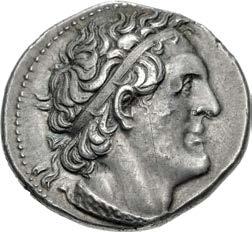


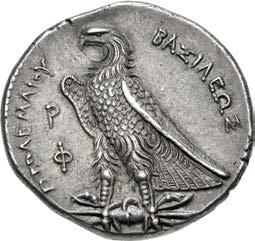
274. PTOLEMAIC KINGS of EGYPT. Ptolemy I Soter. 305/4-282 BC. AR Tetradrachm (27mm, 14.18 g, 12h). Alexandreia mint. Struck circa 294-285 BC. Diademed head right, wearing aegis around neck, tiny d behind ear / Eagle, with closed wings, standing left on thunderbolt; to left, r above f. CPE 151; Svoronos 263; SNG Copenhagen –. Toned, with slight iridescence, a few light scratches, a couple of minor knocks on obverse. Near EF ($1000)
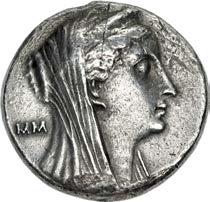
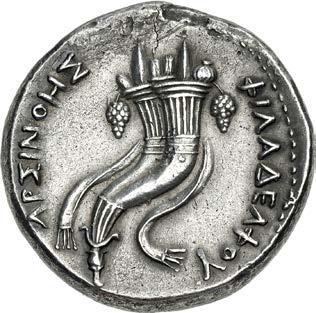

275. PTOLEMAIC KINGS of EGYPT. Arsinoe II Philadelphos. Died 270/268 BC. AR Dekadrachm (34mm, 33.35 g, 12h). Alexandreia mint. Struck under Ptolemy II, circa 253/2-250/49 BC. Head right, with ram’s horn, veiled and wearing stephane; lotus-tipped scepter in background, ÂÂ to left / Double cornucopia with grape bunches hanging at sides, bound with fillet. CPE 354 (same dies as illustration); Svoronos 947; Troxell, Arsinoe, Group 3, p. 44; SNG Copenhagen –. Attractively toned, hairline flan crack, some roughness, cleaning scratches. Good VF. ($5000)
Ex Spink 110 (4 October 1995), lot 62.
Arsinoe II, daughter of Ptolemy I and Berenike I, was born in 316 BC. Her early life saw her married off to Lysimachos of Thrace at the age of 15 and then to her half-brother, the brutal Ptolemy Keraunos. She conspired against the latter and was forced to flee circa 280 BC to the protection of Egypt, ruled by her younger full brother, Ptolemy II. Her beauty, charm and intelligence utterly captivated Ptolemy, and, after eliminating his previous wife with an accusation of treason, Arsinoe married her brother, probably about 276 BC. Sibling marriage was traditional among Egyptian royalty but among the Greeks it was known only among deities; thus their union advanced the concept of rulers being worshipped as divinities. Though unscrupulous, Arsinoe proved a capable queen and co-ruler, taking charge of Egypt’s foreign affairs. Her death in 270 or 268 BC was marked by her full deification and a huge outpouring of gold and silver coinage bearing her veiled portrait. The ram’s horn just visible emerging from the veil is a further symbol of her deification, reminiscent of the horn of Ammon on images of the deified Alexander.


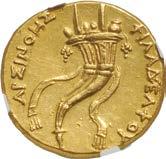
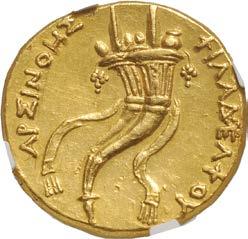
276. PTOLEMAIC KINGS of EGYPT. Arsinoe II Philadelphos. Died 270/268 BC. AV Mnaïeion – ‘Oktadrachm’ (27mm, 27.79 g, 11h). Alexandreia mint. Struck under Ptolemy II, circa 263/2 or 261/0-255/4 BC. Head right, with ram’s horn, veiled and wearing stephane; lotus-tipped scepter in background, no control letter to left / År%5@o˙% f5¬ÅdE¬foU, double cornucopia, grape bunches hanging at sides, bound with fillet. CPE 369; Svoronos 408; Olivier & Lorber unmarked dies 3/5; Troxell, Arsinoe, Group 2, p. 42, and pl. 3, 3 (same dies); SNG Copenhagen –; Noeske –. In NGC encapsulation 6057867-001, graded Ch AU, Strike: 5/5, Surface: 2/5, ex-jewelry. Very rare first (unmarked) issue of Arsinoe’s mnaïeia. ($10,000)
Ex Heritage 3094 (19 August 2021), lot 33028.
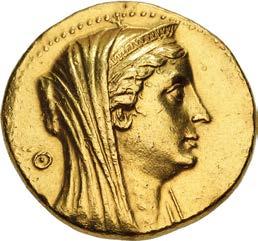


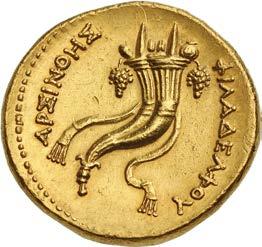
277. PTOLEMAIC KINGS of EGYPT. Arsinoe II Philadelphos. Died 270/268 BC. AV Mnaïeion – ‘Oktadrachm’ (28mm, 27.79 g, 12h). Alexandreia mint. Struck under Ptolemy II, circa 252/1-250/49 BC. Head right, with ram’s horn, veiled and wearing stephane; lotus-tipped scepter in background, Q to left / Double cornucopia, grape bunches hanging at sides, bound with fillet. CPE 388; Svoronos 460; Olivier & Lorber dies 1/22; SNG Copenhagen 134; Noeske 39; Hirsch 1808; Jameson 1811; Pozzi 3221–2 (all from same obv. die). Polished surfaces, minor scratches and marks, edge knock. Near EF. ($6000)
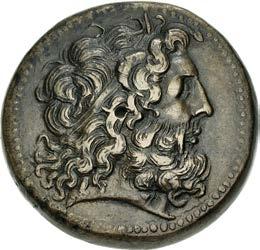

278. PTOLEMAIC KINGS of EGYPT. Ptolemy III Euergetes. 246-222 BC. Æ Drachm (42mm, 76.81 g, 12h). Alexandreia mint. Series 5B. Horned head of Zeus-Ammon right, wearing tainia with basileion / Eagle standing left on thunderbolt; cornucopia to left, ^ between legs. CPE B395; Svoronos 964; SNG Copenhagen 171–2. Attractive brown surfaces, gently smoothed. Near EF. An exceptionally attractive example. ($1500)
From the Plus 20 Collection. Ex Leu Numismatik AG Web Auction 17 (14 August 2021), lot 1446.


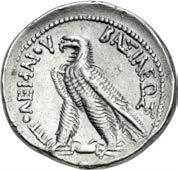
279. PTOLEMAIC KINGS of EGYPT. Ptolemy VI Philometor. 180-145 BC. AR Tetradrachm (29.5mm, 14.13 g, 12h). Alexandreia mint. Struck circa 174–155 BC. Diademed head of Ptolemy I right, wearing aegis around neck / Eagle standing left on thunderbolt; no control marks. CPE 1117; Svoronos 1489; Olivier 3675–4354 var. (obv. die unlisted); SNG Copenhagen 262–8. Minor marks, scuffs at edge, edge marks, a hint of die rust on obverse, slight doubling on reverse. Near EF. ($500)
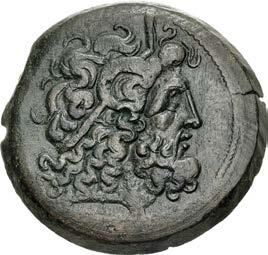

280. PTOLEMAIC KINGS of EGYPT. Ptolemy VIII Euergetes II (Physcon). As king of Kyrenaika, 163-145 BC. Æ Drachm (43mm, 40.53 g, 12h). Kyrene mint. Horned head of Zeus-Ammon right, wearing tainia with basileion / Eagle, with wings spread, standing right on thunderbolt; f to right. CPE B672; Svoronos 1641 (Alexandreia mint); Asolati 81; SNG Copenhagen 651. Even brown patina. Good VF. An exceptional example of a rare type. ($500)
Ex Leu Numismatik AG 7 (24 October 2020), lot 1392.


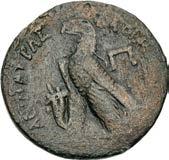
281. PTOLEMAIC KINGS of EGYPT. Kleopatra VII Thea Neotera. 51-30 BC. Æ Diobol – 80 Drachmai (27mm, 15.59 g, 12h). Alexandreia mint. Series 10, circa 47–30 BC. Diademed and draped bust right / Eagle standing left on thunderbolt; cornucopia to left, Π (mark of value) to right. CPE B825; Svoronos 1871; SNG Copenhagen 419–21. Brown surfaces with faint green tones, light deposits, typical slight roughness. Fine. ($500)



282. PTOLEMAIC KINGS of EGYPT. Kleopatra VII Thea Neotera. 51-30 BC. Æ (22mm, 9.69 g, 12h). Damaskos mint. Dated SE 280 (33/2 BC). Diademed and draped bust right / Tyche seated left on rock outcropping, extending hand and holding cornucopia; l∏% (date) to left; below, river-god Chrysorrhoas swimming right; all within laurel wreath. CPE B845; Svoronos 1893; HGC 9, 1462; DCA2 256; RPC I 4783. Green-brown surfaces, light deposits, scratches. Good VF. Pleasing portrait. ($500)
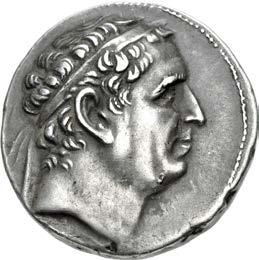



283. BAKTRIA, Greco-Baktrian Kingdom. Euthydemos I Theos Megas. Circa 225-200/195 BC. AR Tetradrachm (29.5mm, 16.32 g, 12h). Mint A (near Aï Khanoum). Struck circa 206-200 BC. Diademed head right, with elderly features / Herakles seated left on rock, holding club set on rocks; d to lower right. MPHB A Group III, 269 (O73/R201); Kritt A17; Bopearachchi 11A; SNG ANS 141 var. (monogram); HGC 12, 40. Deep iridescent toning. Good VF. ($1000)
From the Fellows Collection.
Euthydemos, the third Greco-Baktrian king, presents an interesting picture of a ruler. We know three things about him—he was bold, he was honest, and he was stubborn. We know he was bold because he took the initiative to overthrow his overlord, Diodotos II, and make himself king. We can say he was honest, as least as far as his appearance goes, because he is one of the few rulers who actually ages on his coins. His early coins depict him as a relatively smooth-faced young man. By the end of his reign, he is the aged, care-worn fellow we see on this remarkable coin portrait. As for stubborn, Euthydemos is mentioned by the second-century BC historian Polybius in his life of the Seleukid king Antiochos III the Great (222-187 BC). According to Polybius, Antiochos decided to march east and reconquer all the lands that had been lost by his forebears. In 208 BC, he arrived in Baktria, ruled by Euthydemos. The Baktrian ruler commanded a huge cavalry arm, more than 10,000 riders. But these were routed by the Seleukid army and Euthydemos took refuge in the city of Baktra, where he remained under siege for more than two years. Eventually, Antiochos wearied of the siege and cut a deal, allowing Euthydemos to retain power. His stubbornness had paid off.

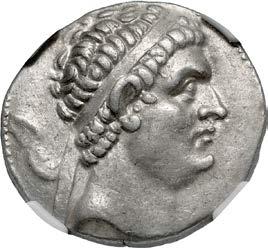
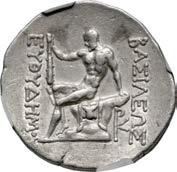
284. BAKTRIA, Greco-Baktrian Kingdom. Euthydemos I Theos Megas. Circa 225-200/195 BC. AR Tetradrachm (30mm, 16.54 g, 11h). Mint B (“Baktra”). Struck circa 210-206 BC. Diademed head right / Herakles seated left on rock, holding club set on knee; } to lower right. MPHB B Group IV and V, 335–50 var. (O95/R– [unlisted rev.die]); Kritt B14; Bopearachchi 9A; SNG ANS 136; HGC 12, 4. In NGC encapsulation 8211515-001, graded XF, Strike: 5/5, Surface: 4/5. ($1000)


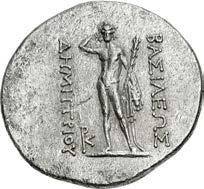
285. BAKTRIA, Greco-Baktrian Kingdom. Demetrios I Aniketos. Circa 200-185 BC. AR Tetradrachm (33mm, 16.18 g, 12h). Diademed and draped bust right, wearing elephant skin / Herakles standing facing, crowning himself, holding club and lion skin; } to inner left. MPHB Group IIIA, 167 (O46/R115); Bopearachchi 1C; SNG ANS 187; HGC 12, 63. Lightly toned, porosity/roughness, smoothing. Good VF. ($750)




286. BAKTRIA, Greco-Baktrian Kingdom. Eukratides I Megas. Circa 170-145 BC. AR Tetradrachm (32mm, 16.90 g, 12h). Diademed and draped bust right / The Dioskouroi, holding palm fronds and spears, on horses rearing right; } to lower right. Bopearachchi 1B; SNG ANS 431; HGC 12, 130. Light iridescent toning, light porosity, hairline die break on reverse. EF. ($1000)
True to his self-granted title, Eukratides Megas was perhaps the greatest of the Greco-Baktrian kings. His origins are obscure; he seems to have been the son of one Heliokles and a woman named Laodike, who may have been related to the Diodotid or Seleukid royal houses. This tincture of blue blood enabled him to attain a leading position in the army or civil service of the Greco-Baktrian realm, which had by circa 170 BC broken into several sub-kingdoms ruled by Antimachos I and II, Apollodotus I, and Demetrios II. Eukratides revolted against Demetrios and, despite being heavily outnumbered, succeeded in seizing his throne. Then, methodically, he defeated the other Baktrian rulers and annexed their realms, ultimately assuming the title Megas (“Great”). Only Menander I Soter, who controlled northern India, seems to have held out against him. Often depicted on his coins wearing a broad-brimmed helmet, his image spread far and wide, and the splendor of his reign was noticed by the Hellenistic states far to the west. The second century AD historian Justin wrote a brief, garbled account of his reign, noting that he “carried out several wars with great spirit,” but that he ultimately was murdered by one of his own sons while on campaign: “He was killed on his march by his son, with whom he had shared his throne, and who was so far from concealing the murder... he drove his chariot through his blood, and ordered his body to be cast out unburied.” Which of his three sons (Eukratides II, Plato and Heliokles I) carried out the patricide remains a mystery.
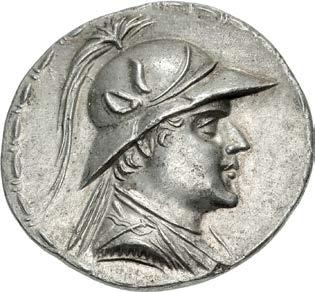


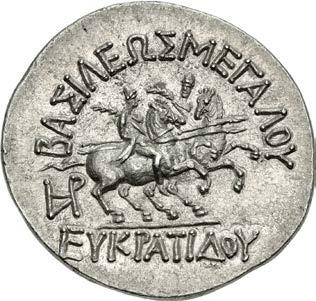
287. BAKTRIA, Greco-Baktrian Kingdom. Eukratides I Megas. Circa 170-145 BC. AR Tetradrachm (34mm, 16.96 g, 12h). Helmeted, diademed, draped, and cuirassed bust right / The Dioskouroi, holding palm fronds and spears, on horses rearing right; Î to lower left. Bopearachchi 6Z; SNG ANS 473; HGC 12, 131. Light iridescence. EF. ($1500)
From the GTP Collection. Ex Triton XXVI (10 January 2023), lot 478.



288. BAKTRIA, Greco-Baktrian Kingdom. Eukratides II Soter. Circa 145-140 BC. AR Tetradrachm (32mm, 16.79 g, 12h). Diademed and draped bust right / Apollo standing left, holding arrow and bow set on ground; kr to inner left. Bopearachchi 1A; SNG ANS –; HGC 12, 161. Light iridescent toning, traces of deposits, die rust, and double strike. Near EF. ($750)

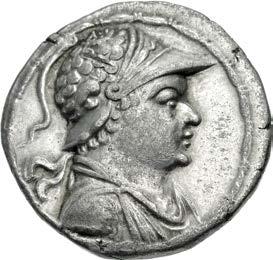

289. BAKTRIA, Greco-Baktrian Kingdom. Heliokles Dikaios. Circa 145-130 BC. AR Tetradrachm (30mm, 11.39 g, 12h). Diademed, draped, and cuirassed bust right, wearing crested helmet covered with pelt of scales and adorned with head of Gorgon and wing; all within bead-and-reel border / Zeus Nikephoros enthroned left; ; to inner left. Bopearachchi 3A; SNG ANS –; HGC 12, 170. Iridescent toning, deposits, light porosity, test cut, a couple of short scratches and slight doubling on reverse. Good VF. ($1500)
Ex Melinda Collection.



290. BAKTRIA, Indo-Greek Kingdom. Menander I Soter. Circa 155-130 BC. Æ Sixteen Unit (29x32mm, 41.02 g, 12h). Square module. Helmeted and draped bust of Athena right / Horse rearing right; e below. Bopearachchi Série 24 (monogram unlisted), but cf. 13E (AR drachm); Bopearachchi & Rahman – SNG ANS –; MIG –; Zeno –; HGC 12, 199; CNG 115, lot 408. Brown surfaces, roughness. VF. Extremely rare monogram for this denomination. ($750)
From the Plus 20 Collection. Ex Klaus Grigo Collection (Gorny & Mosch 297, 9 October 2023), lot 300.
Menander I Soter, known as Melinda in Indian lore, is likely the most famous Greek ruler of the far east, and is the only one whose reign left an indelible imprint on Indian historical traditions. His reign overlapped and extended beyond that of Eukratides I Megas in Baktria, apparently beginning circa 155 BC in the northern Punjab. His was reputedly born near Sagala (modern Sialkot, Pakistan) and later made that city his capital. How he rose to power is unrecorded, but he successfully resisted the efforts of Eukratides to invade and absorb this region in about 150 BC. When Eukratides was assassinated in 145 BC, Menander counter-invaded and seized all of that king’s Indian possessions. Ultimately he ruled a large swath of northern India that extended as far south as the Hindu holy city of Mathura. An enduring tradition paints Menander as a convert to Buddhism, and a long conversation between the king and a Buddhist sage named Nagasena is recorded in a text called the Melinda Panha (“Questions of Melinda”). He is described as “learned, eloquent, wise, and able, and a faithful observer... of all the various acts of devotion and ceremony” required by the faith. “Many were the arts and sciences he knew... as a disputant he was hard to equal, harder still to overcome.” It concludes, “as in wisdom so in strength of body, swiftness, and valour there was found none equal to Melinda in all India. He was rich too, mighty in wealth and prosperity, and the number of his armed hosts knew no end.”
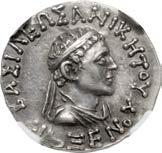
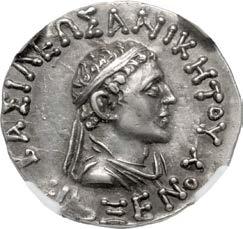

291. BAKTRIA, Indo-Greek Kingdom. Philoxenos Aniketos. Circa 125-110 BC. AR Tetradrachm (27mm, 9.95 g, 12h). Diademed and draped bust right / King right on horseback; N below. Bopearachchi 3G = MIG 338h = BM Inv. 1887,0604.8 (same dies, but later die state); SNG ANS –; HGC 12, 267. In NGC encapsulation 6763170-006, graded Choice XF★, Strike: 5/5, Surface: 4/5. The second recorded example and the only one not in a public collection (the other example in the British Museum). ($750)
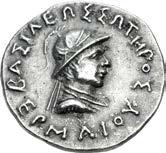
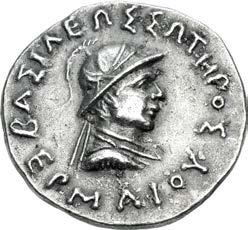

292. BAKTRIA, Indo-Greek Kingdom. Hermaios Soter. Circa 105-90 BC. AR Tetradrachm (27.5mm, 9.67 g, 11h). Diademed, draped, and cuirassed bust right, wearing crested helmet adorned with bull’s horn and ear / Radiate Zeus-Mithra enthroned facing slightly left, extending right hand in benediction and cradling long scepter in left arm; h to inner left. Senior, Hermaios H3aT; Bopearachchi 4A corr. (monogram); SNG ANS 1345/1330 (obv./rev.); HGC 12, 291. Iridescent toning, deposits, porosity. Good VF. Very rare. ($500)



293. BAKTRIA, Indo-Greek Kingdom. Hippostratos Soter. Circa 65-55 BC. AR Tetradrachm (30mm, 9.51 g, 12h). Diademed and draped bust right / Hippostratos, in military attire, on horse rearing right on ground line; m (mam in Kharosthi) to left; O to right; & (pri in Kharosthi) in exergue. Bopearachchi 5F; SNG ANS 1625; HGC 12, 450. In NGC encapsulation 6763613-009, graded Ch XF, Strike: 5/5, Surface: 4/5. ($750)

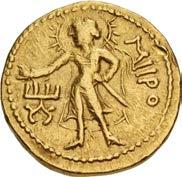

294. INDIA, Kushan Empire. Kanishka I. Circa AD 127-151. AV Dinar (20.5mm, 7.94 g, 12h). Main mint in Baktria (Balkh?). Late phase. Kanishka standing left, holding goad and scepter, sacrificing over altar to left; flame at shoulder / Miiro (Mithra) standing left, extending hand in benediction and holding hilt of sword; 9 to left. MK 64/6 = MACW 3061 (O7/ R19B); ANS Kushan 378; Donum Burns –. Toned, tiny scuffs on reverse and at edge. VF. ($750)




295. INDIA, Kushan Empire. Huvishka. Circa AD 151-190. AV Dinar (21mm, 7.93 g, 12h). Main mint in Baktria (Balkh?). Early phase. sao˜a˜osao o oIs˚i ˚Osa˜[O], diademed and crowned half-length bust left on clouds, holding mace-scepter and goad / c˚a˜Do/Åro ˚o M bizago, Skando-Komaro and Bizago, both nimbate, standing facing, heads vis-à-vis; Skando-Komaro holding spear in right hand, left hand on hilt; Bizago with right hand on hip, holding spear in left hand; 8 between. MK 156 (O1/R1); cf. ANS Kushan 723 (for type); Donum Burns –; CNG 100, lot 1673 (same dies). Lightly toned, trace of deposits, light scratches, some smoothing and tooling, ex jewelry. Good VF. Extremely rare. ($5000)
Ex Triton XXVI (10 January 2023), lot 512; Classical Numismatic Group 115 (16 September 2020), lot 414; Roma XIV (21 September 2017), lot 390.

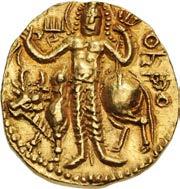

296. INDIA, Kushan Empire. Vasudeva II. Circa AD 267-300. AV Dinar (20mm, 7.87 g, 12h). Main mint in Mathura/ Gandhara. Vasudeva standing left, sacrificing over altar and holding filleted staff; filleted trident to left; rju in Brahmi to right of altar; gho in Brahmi between Vasudeva’s feet; tra in Brahmi to right of Vasudeva’s foot; rda in Brahmi to right / Ithyphallic Siva standing facing, holding a garland or diadem and trident; behind, the bull Nandi standing left; tamgha to upper left. MK 630/10 (Vasishka; O6/R– [rev. dies not numbered by Göbl for this series]); ANS Kushan 1650; Donum Burns 715 (same obv. die). Toned. Near EF. ($600)
From the JTB Collection. Ex Triton XXVII - Session 5 (17 January 2024), lot 5394.
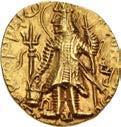
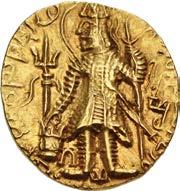

297. INDIA, Kushan Empire. Kanishka III. Circa AD 267-270. AV Dinar (20.5mm, 7.90 g, 12h). Main mint in Taxila. Nimbate Kanishka standing left, holding trident, sacrificing over altar to left; filleted trident to left; ga in Brahmi to right of altar; gho in Brahmi between legs; pri in Brahmi to right of scepter / Ithyphallic Siva standing facing, holding a garland or diadem and trident; behind, the bull Nandi standing left; pellet between legs; to upper left, trace of pellet above tamgha. MK 635 (O21/R–; unlisted rev. die); ANS Kushan 1645; Donum Burns –. Lightly toned, deposits in devices. Good VF. ($750)
From the JTB Collection. Ex Triton XXVII, Session 5 (17 January 2024), Lot 5396.
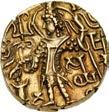


298. INDIA, Kushan Empire. Shaka. Circa AD 305-335. AV Dinar (18.5mm, 7.60 g, 12h). Uncertain mint. Shaka, standing left, sacrificing over altar and holding filleted staff; filleted trident to left; bha in Brahmi to right of altar, sayatha in Brahmi below arm, śaka to outer right / Ardoxsho enthroned facing, holding diadem in right hand and cradling cornucopia in left arm; tamgha to left. MK 594; ANS Kushan –; Donum Burns 781–2. Toned, hint of underlying luster. Near EF. ($500)
Ex Berk BBS 165 (28 July 2009), lot 84.

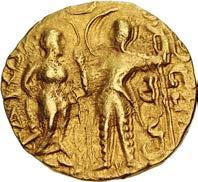
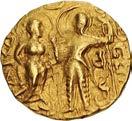
299. INDIA, Gupta Empire. First Dynasty. Chandragupta I. Circa AD 320-335. AV Dinar (21mm, 7.75 g, 12h). King-and-Queen type (Class I, Variety A.1). Chandragupta I, nimbate and holding standard, standing left, offering uncertain object to Kumaradevi, also nimbate, standing right; crescent visible above; CN5 (chandra in Brahmi) between Chandragupta and standard; GA (gupta in Brahmi) to right of standard / Lakshmi seated facing on lion recumbent right, feet on lotus, holding diadem and cornucopia; tamgha to left. Kumar Class I Variety A.1, 46; BKB 1 (Chandragupta); BMC Guptas p. 9,(Samudragupta); cf. Alketar p. 34, 4 (Chandragupta I); Bayana 6 (Chandragupta Ie). Lightly toned, struck with worn and rusty dies. VF. Extremely rare. ($2000)
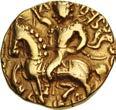
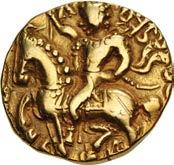

300. INDIA, Gupta Empire. First Dynasty. Kumaragupta I Mahendraditya. Circa AD 413-455. AV Dinar (19.5mm, 8.10 g, 12h). Horseman type (Class III, Variety B). Kumaragupta, left on horseback, sword hanging at side, holding holding bow with bowstring out / Lakshmi seated left on wicker stool, feeding peacock standing before and holding lotus. Kumar Class III Variety B, 667; BKB 166; BMC Guptas 226-230 and p. 76; Bayana 1538 = Altekar Class II, Variety B and pl. XI, 6. Toned, test cut on edge. VF. Extremely rare. ($1500)



301. SASANIAN KINGS. Vahrām (Bahram) II. AD 276-293. AV Dinar (22mm, 7.01 g, 3h). ‘HWPY/HRPY’ (Herat?) mint. Phase I. Bust right, wearing winged crown with korymbos / Fire altar; flanked by two attendants, the left wearing winged crown with korymbos, the right wearing mural crown. SNS type I(1)/1(1a), style I (unrecorded as a dinar); Göbl type I/1; Saaedi –; Sunrise –; Triton XXVII, lot 441 (same dies); Classical Numismatic Group 120, lot 604 (same rev. die); Zeno 163923 = New York Sale XXXVII, lot 422 (same dies); Triton XXIII, lot 569 (same dies); Zeno 229225 = Classical Numismatic Group 112, lot 414 (same dies); Zeno 172466 = Album 26, lot 59 (same dies). Toned, traces of deposits in devices, area of peripheral weakness on reverse, area of clipping. Near EF. ($2500)


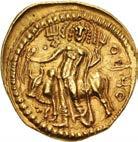
302. KUSHANO-SASANIANS. Ardaxšīr (Ardashir) (I–II). Circa AD 230-245. AV Dinar (23mm, 8.03 g, 12h). Imitating Kushan king Vasudeva I. Uncertain mint in Baktria. Early series. Vasudeva standing left, flames on shoulder, holding filleted standard, sacrificing over altar to left; filleted trident to left, ≥ to right of altar, o on altar, tamgha to right / Ithyphallic Siva standing facing, holding a garland or diadem and trident with o on shaft; behind, the bull Nandi standing left; • and tamgha to upper left, ≥ below Nandi’s head. MK 650; ANS Kushan –; Donum Burns –. Toned. Near EF. ($750)
From the JTB Collection.
End of Session 1
Session 2 – Tuesday, September 23, 2025 — 2 PM



303. IBERIA, Romula. Divus Augustus, with Julia Augusta (Livia). Died AD 14. Æ Dupondius (31mm, 24.15 g, 6h). Struck under Tiberius, AD 14-37. Radiate head of Divus Augustus right; star above, thunderbolt before / Head of Livia left, set on globe; crescent above. ACIP 3360; RPC I 73; Burgos 2014. Dark brown patina, light roughness, smoothing. VF. ($500)
From the Plus 20 Collection. Ex CLA Collection; CNG inventory 730556 (April 2002).
The style of the obverse is identical to an as struck in Rome, and dated to 15-16 AD (RIC I 72 [Tiberius]). The reverse demonstrates the development of the Julio-Claudian dynastic in the early years of Tiberius’ reign. The portrait of Livia, known as Julia Augusta by the dictates of Augustus’ will, demonstrates an increased divine association of the dowager empress; the crescent consciously parallels the star above the head of the Divus Augustus. The legend formula is apparently unknown elsewhere. The phrase genetrix orbis may allude to Venus Genetrix, the divine ancestress of the gens Iulia as well as mater or parens patriae, titles which the Senate bestowed upon Livia.
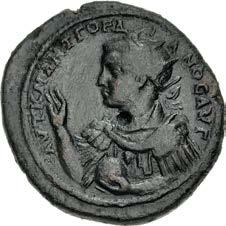

304. MOESIA INFERIOR, Odessus. Gordian III. AD 238-244. Æ (37mm, 31.79 g, 1h). Struck AD 242. Radiate, draped, and cuirassed bust left, decorated with gorgoneion, raising hand and holding globe / The great god Darzalas, standing facing, head left, sacrificing from patera over altar to left, and holding spear. CNO IV, XXIV.11.↔︎3; RPC VII.2 1496; Varbanov 4440. Dark brown patina, smoothing, minor edge flaws. VF. ($500)
Ex John Wright Collection, purchased from Nilus Coins, January 2007.
This obverse die was also used at Marcianopolis and Tomis.
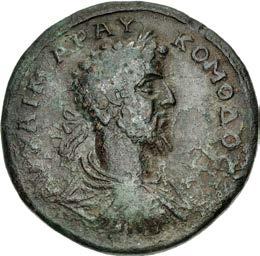
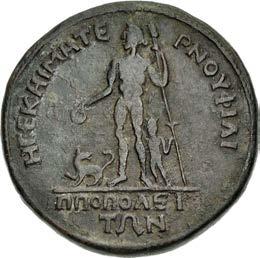
305. THRACE, Philippopolis. Commodus. AD 177-192. Æ Medallion (42mm, 46.98 g, 12h). Caecilius Maternus, legatus Augusti pro praetore provinciae Thraciae. Struck circa AD 187. Laureate, draped, and cuirassed bust right, seen from behind / Dionysus standing left, holding patera and thyrsus; to left, panther standing left, head right; to inner right, satyr standing facing. Cf. Varbanov, Philippopolis XI.30 (smaller module); cf. Moushmov, Philippopolis 175 (same); RPC IV.1 Online 25468.2 (this coin); cf. Varbanov 964 (same). Green and brown patina, minor deposits, some roughness. VF. Extremely rare as a medallion, only two recorded in RPC. ($1000)
From the Michael Stolt Collection.

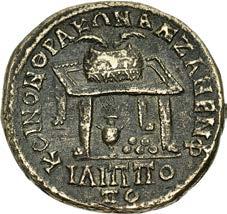
306. THRACE, Philippopolis. Caracalla. AD 198-217. Æ Medallion (36.5mm, 23.16 g, 6h). Pythian Games issue. Struck AD 215. Radiate, draped, and cuirassed bust right, seen from behind / Agonistic prize crown containing two palm fronds, inscribed ΠYΘIA, set on table with lion’s feet; below, amphora and five voting balls. Varbanov, Philippopolis XV.9.7 var. (O– [O1 of previous series]/R– [rev. die unrecorded]); Peter, Koinon 33 (V7/R33 – this coin cited); Mouchmov, Philippopolis 381; Varbanov 1487 var. (rev. legend). Yellow-brown surfaces, porosity. VF. ($500)
From the DWBG Collection. Ex Marcel Burstein Collection (Peus 366, 29 October 2000), lot 422; Peus 328 (2 May 1990), lot 422.
The reverse of this medallion is one of many similar types struck by Philippopolis to commemorate the Pythian Games (τὰ Πύθια), one of the four Greek Panhellenic Games that occurred in the second year of each four-year Olympic cycle. Held in honor of Apollo, the god of arts and “civilization,” these games featured competitions for athletics, music, and poetry, and were meant to evoke the best of Greco-Roman culture. This particular event in AD 215, coming as it did in during Caracalla’s march east to fight the Persians, must have invested the event with further significance: by situating the occurrence of the games at such a crucial moment, the gods had signaled their approval for Caracalla’s enterprise against the “barbarians.”
Ex Mabbott Collection – Pedigreed to 1969


307. THRACE, Serdica. Faustina Junior. Augusta, AD 147-175. Æ Medallion (38mm, 49.32 g, 12h). Claudius Appius Martialus, legatus Augusti pro praetore provinciae Thraciae. Struck under Marcus Aurelius and Lucius Verus, AD 166-169. Draped bust right / Nike driving slow biga right. H&J, Serdica 12.9.9.1 = RPC IV.1 7389.2 (this coin); Varbanov 10 (this coin illustrated); Ruzicka, Serdica 8. Red-brown patina, some roughness. Good Fine/Fair. Extremely rare, only two recorded in RPC. ($500)
Ex John F. Sullivan Collection (Classical Numismatic Group 70, 21 September 2005), lot 543; Philip DeVicci Collection (Classical Numismatic Group 55, 13 September 2000), lot 948; Classical Numismatic Auctions XIV (20 March 1991), lot 350; Thomas Ollive Mabbott Collection (H. Schulman, 6 June 1969), lot 528.


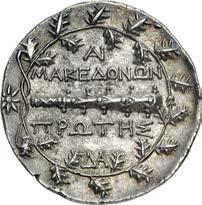
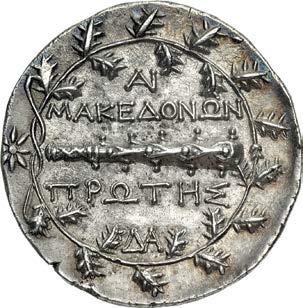
308. MACEDON, Republican period. First Meris. Circa 174/3-2nd half of 2nd century BC. AR Tetradrachm (33mm, 16.86 g, 11h). Amphipolis mint. Struck circa 174/3-158 BC. Diademed and draped bust of Artemis right, bow and quiver over shoulder, in the center of a Macedonian shield / Club; AI above, ΔA below; all within oak wreath, star to left. Prokopov, Silver, Group I.A, 52 (O13/R39b – this coin, illustrated); HGC 3, 1103. Iridescent tone, slight roughness. Good VF. Extremely rare variety. ($500)
Ex G. Hirsch 266 (11 February 2010), lot 1599; G. Hirsch 263 (24 September 2009), lot 2167; G. Hirsch 260 (12 February 2009), lot 1558.



309. ACHAEA, Fleet Coinage. Uncertain mint. Mark Antony, with Octavia. Late Summer-Autumn 38 BC. Æ Sestertius (35mm, 30.39 g, 10h). ‘Fleet coinage’ issue. Heavy series. Uncertain naval base mint (Piraeus?); M. Oppius Capito, propraetor and praefectus classis. Bare head of Mark Antony vis-à-vis draped bust of Octavia / Mark Antony and Octavia driving quadriga of hippocamps right; HS to left; Δ and astragalus below. Amandry, Bronze II, 1A, A4 (D1/R2); RPC I 1462.3 (this coin); CRI 285. Rough brown patina. Fair. Very rare. Four specimens cited by Amandry, five by RPC; all those illustrated are in similar condition. ($1500)
Ex J. S. Wagner Collection (Classical Numismatic Group Electronic Auction 169, 25 July 2007), lot 70; Sotheby’s (20 July 1983), lot 116.
M. Oppius Capito was probably Antony’s senior naval officer, stationed at the main naval base at Piraeus. His coins are found distributed around central Greece, and were most likely struck at Piraeus. His coins are found in two series, a heavy and a light (this coin is the former) and it has been suggested that some were struck at Tarentum where part of Antony’s fleet was based during the joint action against Sextus Pompey in 37-36 BC. However, both series are found exclusively in the east, and it appears that Oppius Capito may not have accompanied the fleet to Sicily, but retained overall command in the east while his associate Atratinus took charge of the western fleet.




310. BITHYNIA, Koinon of Bithynia. Hadrian. AD 117-138. AR Cistophorus (28mm, 10.34 g, 12h). Laureate head left / Bundle of five ears of grain. Metcalf, Cistophori B16, 38 (O28/R37); RPC III 961; Pinder 90; RSC 439a. Lightly toned, traces of find patina, minor marks and scratches. VF. Very rare. ($750)
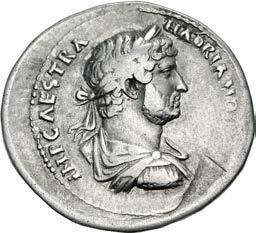


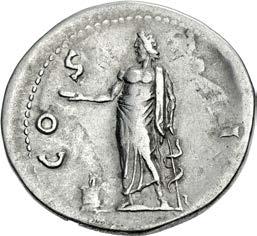
311. BITHYNIA, Koinon of Bithynia. Hadrian. AD 117-138. AR Cistophorus (27.5mm, 10.61 g, 6h). IMP CAES TRA HADRIANO [AVG P P], laureate, draped, and cuirassed bust right, seen from behind / COS III, Asclepius standing left, holding patera and leaning on serpent-entwined staff to right; to left, lighted altar. Metcalf, Cistophori –; RPC III –; Pinder –; RSC –. Lightly toned, minor marks and scratches, overstruck on an uncertain type. Near VF. Extremely rare and unpublished. ($500)
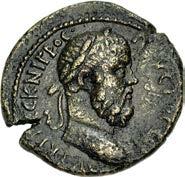
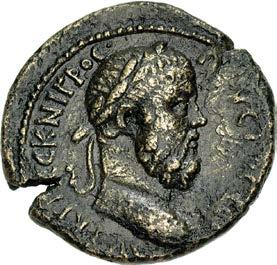
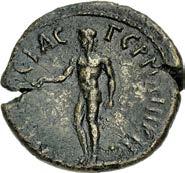
312. BITHYNIA, Caesarea Germanica. Pescennius Niger. AD 193-194. Æ (30mm, 14.15 g, 7h). Laureate head right / Apollo standing facing, head left, holding patera and laurel branch. RG –; RPC V.2 Online 69616 (this coin cited). Yellow brown surfaces, slight roughness, edge split. VF. Extremely rare. ($2000)
Ex Classical Numismatic Group 69 (8 June 2005), lot 979.
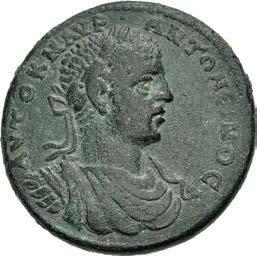


313. MYSIA, Pergamum. Elagabalus. AD 218-222. Æ Medallion (42mm, 40.37 g, 12h). Labor of Herakles type. Ti. Claudius Alexander, theologos and strategos. Laureate, draped, and cuirassed bust right, aegis on shoulder, seen from the front / Herakles advancing right, holding raised club and lion skin, fighting Amazon (Hippolyte) standing left and holding shield(?). Weisser 2138; RPC VI Online 4210.5 (this coin); SNG BN 2259 (same dies). Earthen green patina, minor deposits. VF. Extremely rare, only five known to RPC, this the finest specimen. ($2000)
From the Plus 20 Collection. Ex Classical Numismatic Group 123 (23 May 2023), lot 388.
At the request of Admete, Eurystheus’ daughter, Herakles as his Ninth Labor went to seize the golden girdle of Hippolyte, a garment that gave power and supremacy to the wearer. The daughter of Otrera and the god Ares, Hippolyte was the queen of the Amazons, an all female warrior race who lived near the slopes of the Caucasus. To carry out this Labor, Herakles organized an expedition, which included the Athenian hero Theseus. Upon the heroes’ arrival, the Amazon women greeted them warmly, while Hippolyte offered the girdle as a gift. Hera, on hearing this, took the form of an Amazon, spreading a rumor that Herakles had come to steal away their queen, and take her back with him to Greece. The female warriors, in protection of their queen, began fighting the heroes. In the melée that followed, Herakles slew Hippolyte, thinking she had betrayed him. Winning the battle, Herakles headed back for Mycenae.
RPC Online Feature Coin
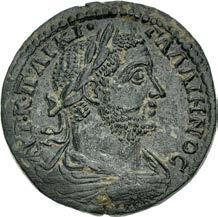

314. MYSIA, Pergamum. Gallienus. AD 253-268. Æ (36mm, 23.50 g, 6h). Sextus Claudius Silanus, magistrate. Laureate, draped, and cuirassed bust right, seen from behind / Wreath with OΛ/YMΠ/IΛ in three lines, flanked by two prize crowns, each containing a palm frond; all set on prize table seen in perspective; below, two purses and whips with vase between them; in upper field, A. Weisser 2533; RPC X Online 62141.3 (this coin); SNG BN 2299 (same dies). Dark brown patina with light earthen deposits, slight roughness, die shift on reverse. Near EF. Extremely rare, only three recorded in RPC. ($1000)
From the Plus 20 Collection. Ex collection of Major Anthony F. Milavic, USMC (Ret.); Leu 48 (10 May 1989), lot 406.
By the mid second century BC, Pergamum had become the most important center of sport and physical education in the Hellenistic east. Its Nikephoria games, held every three years, had nearly the prestige and appeal of great Panhellenic games, including the Olympics, upon which they were modeled. By the second century AD, the Olympic name had even been “franchised,” in a manner still poorly understood, for use at sporting contests far removed from the original quadrennial festival still held at the ancestral home of Olympia. The contests at Pergamum now honored the Roman emperors and bore the name Olympic, as attested by the reverse of this remarkable medallion, which shows the prizes awarded to the victors in the various athletic, equestrian and artistic contests, all arrayed on and around a table. The laurel wreath enclosing the name “Olympia” was likely for the winner of the premier event of the games, possibly the “stadion” foot race. The A in the upper field of this coin commemorates Pergamum as the first city to be honored as the first thrice neocorate.



315. TROAS, Abydus. Severus Alexander. AD 222-235. Æ (26mm, 7.96 g, 12h). Laureate, draped, and cuirassed bust right, seen from behind / Leander swimming right toward tower containing Hero standing left, who holds a lighted lamp. RPC VI Online 30990. Brown surfaces, some roughness. VF. Extremely rare, the second known. ($750)
The tragic love story of Hero and Leander was a popular theme with Classical and Renaissance poets and playwrights. Leander was a young man from Abydus, located on the Asian side of the Hellespont. Across the water in Sestus lived Hero, a virgin and priestess of Aphrodite. Enamored by Hero, Leander would swim each night two miles across the strait to woo her and would swim back to Abydus in the early morning. To guide him in this dangerous journey, Hero would climb a tower on the shore near Sestus with a lamp. One stormy night, however, Leander drowned when the rain extinguished the light. When Hero became aware of his death, she cast herself in despair from the tower into the waters below, and she too drowned.
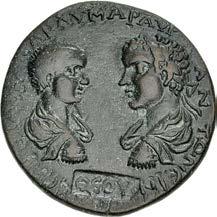


316. CARIA, Stratonicaea. Caracalla, with Geta as Caesar. AD 198-217. Æ (35.5mm, 23.77 g, 12h). Zosimos II, grandson of Posittos, prytanis. Struck under Septimius Severus, circa AD 198-202. Bareheaded, draped, and cuirassed bust of Geta, seen from behind vis-à-vis laureate, draped, and cuirassed bust of Caracalla, seen from behind; c/m: ΘEOY within rectangular incuse / Zeus Panamaros, draped, on horseback right, holding transverse scepter over shoulder; at feet to right, lighted altar. RPC V.2 Online 93819; BMC 68 var. (rev. legend); SNG von Aulock 2689 var. (same). For c/m: Howgego 536. Brown surfaces with light green highlights, slight porosity. VF. Extremely rare, only two recorded in RPC, and especially so that this coin has not suffered Caracalla’s damnatio memoriae of Geta applied after his murder in AD 211. ($500)
Upon Septimius’ passing in AD 211, his sons Caracalla and Geta assumed joint rule of the empire. Their joint rule was a failure: the Imperial Palace was separated into two sections and they threatened to divide the empire between them. During the Festival of Saturnalia, December AD 211, Caracalla tried unsuccessfully to have his brother assassinated. But a week later, at an arranged meeting in their mother’s quarters, Geta was murdered by Caracalla’s centurions.
Caracalla immediately ordered a damnatio memoriae of his brother’s image: statues were removed, paintings were destroyed, or, as with the Severan Tondo, the portrait of Geta was erased, and coins were recalled to have his image carved out. This damnatio was especially apparent on the provincial coinage of Pergamum in Mysia and Stratonicaea in Caria. It is estimated that approximately 95% of the dual bust types at Stratonicea have had the portrait of Geta erased, many of them having a countermark of Roma or Caracalla stamped over his bust, or as on this coin, ΘEOY, or God, as Caracalla believed himself to be a god among men.
This coin is among the rare surviving 5% which did not succumb to the damnatio; Geta’s portrait has been preserved. There is only one specimen in CoinArchives with an unaltered portrait.


317. CARIA, Stratonicaea. Caracalla, with Plautilla. AD 198-217. Æ (37.5mm, 27.06 g, 12h). Tiberius Claudius Dionysios, president of the college of the grammateis. Struck under Septimius Severus, AD 202-205. Laureate, draped, and cuirassed bust of Caracalla vis-à-vis draped bust of Plautilla; c/ms: helmeted head of Roma within circular incuse, and ΘEOY within rectangular incuse / Hecate standing facing, head left, wearing kalathos, holding patera and torch; at feet left, dog standing left, looking right. RPC V.2 Online 73628 (this coin cited); BMC 65; SNG von Aulock 2694. For c/ms: Howgego 188; 536. Dark brown patina with green highlights, minor marks and scratches, slight die shift on reverse. VF. ($750)
From the Plus 20 Collection.
Three Carian cities, Alinda, Alabanda, and Stratonicaea, commemorated the marriage between Caracalla and Plautilla by issuing coins with dual portraits proclaiming the young empress as “the new goddess Hera.” As Ken Harl notes (Civic Coins and Civic Politics in the Roman East: A.D. 180-275 [Berkeley, CA: University of California Press], p. 41): “By implication, Caracalla was envisioned as a youthful Zeus, so that the imperial marriage became a symbolic reenactment of the celestial one.”
Biga of Peacocks


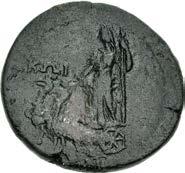
318. ISLANDS off CARIA, Cos. Antoninus Pius. AD 138-161. Æ (30mm, 17.37 g, 6h). Laureate head right / Hera standing left in biga drawn by peacocks, holding patera and long scepter. RPC IV.2 Online 877; SNG Copenhagen 705. Brown-green patina, some roughness. Near VF. Rare. ($500)
From an American Academic Collection.




319. ISLANDS off CARIA, Rhodos. Rhodes. Domitian. AD 81-96. AR Obol (12mm, 0.92 g, 12h). Radiate head right / Rose. Ashton, Early –; RPC II 1189A; SNG Keckman –. Toned with find patina, some delamination. Good VF. Extremely rare, only one recorded in RPC; the second known. ($500)


320. PHRYGIA, Laodicea ad Lycum. Caracalla. AD 198-217. Æ Medallion (43mm, 46.96 g, 6h). Lucius Aelius Pigres, Asiarch for the third time. Laureate, draped, and cuirassed bust right, seen from behind / Gaia standing right, holding cornucopia; to left, ears of grain at feet; to right, Thalassa standing left, holding rudder, dolphin at feet, right; between them, they hold a statue of Caracalla, standing left, in military dress, holding patera and long scepter; below, eagle standing facing, head left, with wreath in its beak, holding wreath in its talons. von Aulock, Phrygiens –; RPC V.2 Online 1069; BMC 226. Earthen green surfaces, minor red deposits. Good VF. Extremely rare. ($2000)
Gaia is the personification of mother earth while Thalassa is the goddess of the sea, seen here, raising Caracalla as ruler of both worlds.



321. PISIDIA, Antiochia. Caracalla. AD 198-217. Æ (33mm, 28.53 g, 6h). Struck AD 211-212. Laureate head right / Caracalla, in military dress, on horseback right, brandishing spear; below, enemy kneeling right, head left. Krzyźanowska dies XXX/– [rev. die unrecorded]; RPC V.3 Online 95093 (this coin cited); SNG BN –. Dark brown patina with earthen highlights. Near EF. Extremely rare. ($750)
Ex John Wright Collection; Berk BBS 213 (19 November 2020), lot 459; Leu Numismatik AG Web Auction 12 (30 May 2020), lot 860.
RPC Online Feature Coin
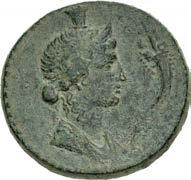

322. CILICIA, Aegeae. temp. Claudius. AD 41-54. Æ (31mm, 22.03 g, 12h). Atha–, magistrate. Dated CY 90 (AD 43/4). Draped bust of Isis right, wearing kalathos; to right, cornucopia / Athena Promachos advancing left, wearing Corinthian helmet, holding shield, preparing to hurl spear; ꟼ (date) to left. Haymann 12.2 = RPC I 4039.3 (this coin); SNG BN –; SNG Levante 1696. Light earthen green patina, small scrape on reverse. VF. Extremely rare, only three known to Haymann, two additional recorded in RPC. ($500)
From the Kelly Ramage Collection. Ex Gorny & Mosch 156 (6 March 2007), lot 1794.



323. CILICIA, Anazarbus. Maximinus I. AD 235-238. Æ (33.5mm, 15.06 g, 6h). Dated CY 254 (AD 235/6). Laureate, draped, and cuirassed bust right, seen from behind / Maximinus on horseback right, thrusting spear at fallen enemy; to right, Nike flying left, holding palm frond and crowning horse with wreath; ЄT •ΔNC• (date) in exergue. Ziegler 664 (Vs2/Rs5); RPC VI Online 7435; SNG BN 2099. Green-brown surfaces, red deposits, light porosity. Good VF. ($750)
Ex Steinberg Collection
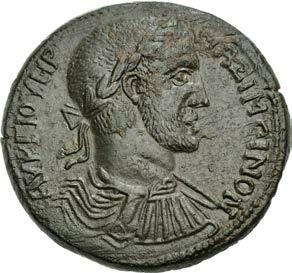
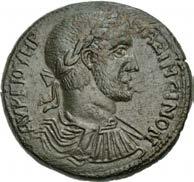
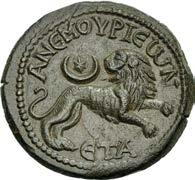
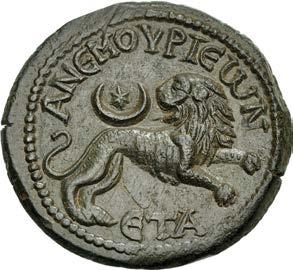
324. CILICIA, Anemurium. Maximinus I. AD 235-238. Æ (32mm, 16.23 g, 6h). Dated RY 1 (AD 235/6). Laureate, draped, and cuirassed bust right, seen from behind / Lion leaping right, head left with mouth open and tongue extended; above its hind quarters, star in crescent; ЄT A (date) in exergue. Köhler-Osbahr 74; RPC VI Online 7011.4 (this coin); SNG BN 711; SNG Levante –. Olive green patina, minor encrustation on obverse. EF. Exceptional for issue. ($1000)
From the Deer Creek Collection, purchased from Edward J. Waddell, Ltd. Ex Triton XIII (5 January 2010), lot 330; Gilbert Steinberg Collection (Numismatica Ars Classica/Spink Tasei, 16 November 1994), lot 879.
The reverse on this coin could refer to Cybele, known to the Romans as the Great Mother, an ancient Phrygian deity who embodied the Earth’s fertility, the rugged mountains and deep recesses, and wild animals. Her association with untamed and unrestrained nature is similar to Dionysos, and Cybele was often depicted with a lion (or biga drawn by lions). The presence of the star-in-crescent suggests that some otherwise unknown astronomical event may have occurred in relation to her worship.


325. CILICIA, Mopsus. Domitian, with Domitia. AD 81-96. Æ Diassarion (35mm, 19.81 g, 12h). Dated CY 162 (AD 94/5). Laureate head of Domitian left / Draped bust of Domitia right, wearing hair in elaborate coiffure with plait down back. von Aulock, Mopsus 29; RPC II 1743.7 (this coin); SNG BN —; SNG Levante 1331. Dark green patina, slight roughness, smoothed, details enhanced. VF. ($750)
Ex John Wright Collection; Triton X (9 January 2007), lot 606.
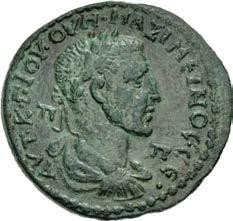
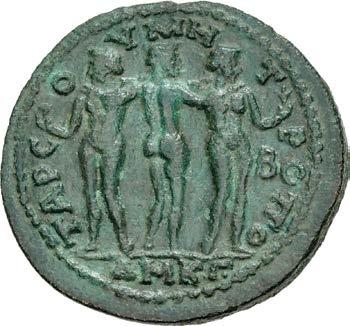
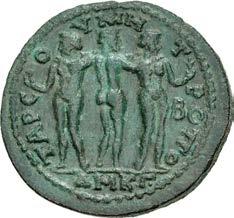
326. CILICIA, Tarsus. Maximinus I. AD 235-238. Æ (38mm, 24.55 g, 6h). Laureate, draped, and cuirassed bust right, seen from behind / The Three Graces (Charites) standing with arms around one another; central figure seen from behind, each holds a flower; B to right. RPC VI Online 7112.16 (this coin); SNG BN 1605 (same dies); SNG Levante 1096 var. (radiate bust & arrangement of rev. legend). Green patina, minor deposits on reverse. Good VF. ($750)
From the Plus 20 Collection. Ex D.K. Collection (Classical Numismatic Group 123, 23 May 2023), lot 401; Berk BBS 217 (30 November 2021), lot 426; Classical Numismatic Review XLV.1, (Winter 2020), no. 528365; Gorny & Mosch 265 (14 October 2019), lot 1103; Gorny & Mosch 176 (10 March 2009), lot 1727.
The Three Graces (or Charites) were goddesses of beauty, charm, and amusement, the embodiment of loveliness in all its aspects. Although their names varied from place to place, the most commonly encountered are Aglaea (“Beauty”), Euphrosyne (“Cheer”), and Thalia (“Flowering”). Over time an artistic convention of depicting the Graces developed: the three deities were shown undraped, each with one arm placed on the figure adjacent to them, the central figure standing facing the opposite direction as the others. This is the convention that one finds in numismatic depictions of the goddesses. With the representation of the Three Graces, the city of Tarsus emphasized its claim for beauty according to its status “Kalliste,” the most beautiful city
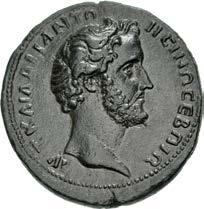


327. GALATIA, Ancyra. Antoninus Pius. AD 138-161. Æ (33mm, 19.19 g, 7h). Bare head right / Asclepius standing facing, head left, holding patera and leaning on serpent-entwined staff to right, gathering himation. Arslan B22; RPC IV.3 Online 5685; SNG BN 2448–9. Brown surfaces, reverse scrape. Good VF. Very rare, only three recorded in RPC, one in CoinArchives, this coin superior to all of them. ($750)
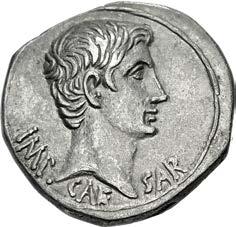
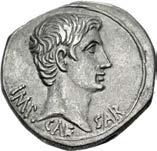
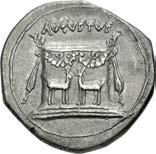
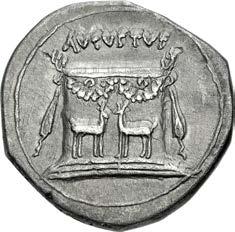
328. ASIA MINOR, Uncertain. Augustus. 27 BC-AD 14. AR Cistophorus (26mm, 11.89 g, 12h). Ephesus mint(?). Struck circa 25-20 BC. Bare head right / AVGVSTVS, garlanded and filleted altar decorated with stags standing vis-à-vis. Sutherland Group VIγ, – (unlisted dies); RPC I 2215 (Cistophoric Mint); RSC 33. Lightly toned, slight porosity, hairlines, doubling on reverse. Near EF. ($1000)
Ex Savoca 133 (15 May 2022), lot 169 .
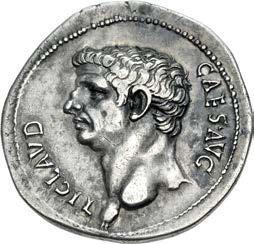


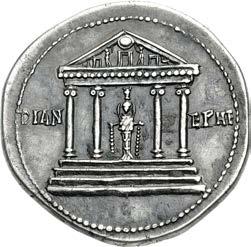
329. ASIA MINOR, Uncertain. Claudius. AD 41-54. AR Cistophorus (28mm, 10.89 g, 6h). Ephesus mint(?). Struck circa AD 41-42. Bare head left / DIAN EPHE across field, temple of Diana Ephesia: cult statue of Diana of Ephesus within tetrastyle temple, pediment decorated with figures flanking a central table with clipeus above, two tables and recumbent figures in angles. RPC I 2222 (Cistophoric mint); RSC 30. Toned, minor scratches and deposits. Good VF. Great portrait. ($5000)
Ex Classical Numismatic Group 103 (14 September 2016), lot 813; Gorny & Mosch 232 (5 October 2015), lot 332; Dieter Braun Collection (Künker 248, 14 March 2014), lot 7456.



330. ASIA MINOR, Uncertain. Hadrian. AD 117-138. AR Cistophorus (26mm, 10.90 g, 8h). Mint A. Laureate head right / Sabina, as Tyche, seated left, holding rudder in right hand and cornucopia in left. Metcalf, Cistophori –; RPC III 1405; Pinder –; RSC –. Lightly toned, minor marks and scratches, overstruck on an uncertain type. Near VF. Extremely rare, the second known. ($750)
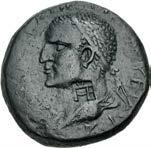


331. KINGS of ARMENIA MINOR. Aristobulus. 54-71/72 CE. Æ Oktachalkon (24.5mm, 11.76 g, 12h). Citing Titus as Caesar. Chalcis(?) mint. Dated RY 17 (70/71 CE). Diademed and draped bust of Aristobulus left; c/m: monogram on neck / TITΩ / OYECΠA/CIANΩ AY/TOKPATO/PI CEBAC/TΩ within laurel wreath. Kovacs 301; Meshorer 367a; Hendin 6287a; RPC II 1692. For countermark: Kovacs p. 79, 24; Howgego 722.1. Dark brown surfaces, porosity, flan adjustment marks. Coin: Near VF; c/m: VF. ($750)
From the D. K. Collection.
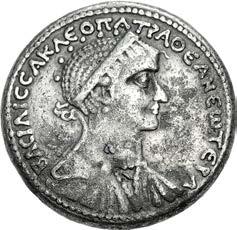

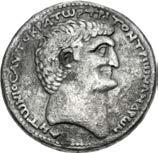

332. SELEUCIS and PIERIA, Antioch. Mark Antony & Cleopatra VII of Egypt. 36 BC. AR Tetradrachm (25.5mm, 14.15 g, 12h). Struck circa 36 BC. BACIΛICCA KΛЄOΠATPA ΘЄA NЄωTЄPA, diademed bust of Cleopatra right, wearing earring, necklace, and embroidered dress / ANTωNIOC AVTOKPATωP TPITON TPIωN ANΔPωN, bare head of Mark Antony right. McAlee 174; RPC I 4094; Prieur 27; HGC 9, 1361. Toned, some find patina, light porosity, some roughness on obverse. VF. Well centered with full legends, with two excellent and well detailed portraits. Struck from one of the rarest die pairs in the series, only two other specimens from this die pair in CoinArchives. ($5000)
These remarkable silver tetradrachms were probably struck at Antioch during the Parthian / Armenian campaign of 36-34 BC to honor perhaps the most famous “power couple” of all time. The talented die engraver has taken particular care to give Cleopatra a powerful, almost masculine profile to complement Antony’s pugnacious portrait. Ancient historians note that Cleopatra was not incomparably beautiful (although none suggest she was anything less than pleasing to gaze upon), but her remarkable mind, her musical voice, and the vast wealth of her kingdom made her irresistible to two of the most powerful men of the age: Julius Caesar and Mark Antony. The titles display Cleopatra’s dominance in the relationship, depicting her on the obverse and touting her as “Queen Cleopatra, new (or “young”) goddess,” while Antony remains only a mortal “victorious general and Triumvir.”


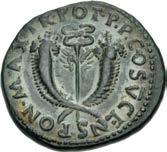
333. SELEUCIS and PIERIA, Antioch. Vespasian. AD 69-79. Æ Dupondius (27mm, 12.51 g, 6h). Rome mint, for circulation in Syria. Struck AD 74. Laureate head left / Winged caduceus between crossed cornucopias. McAlee 369; RPC II 1983. Earthen dark green patina, light cleaning marks. Good VF. An exceptional specimen. ($500)
Ex Classical Numismatic Group 84 (5 May 2010), lot 984.
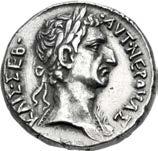
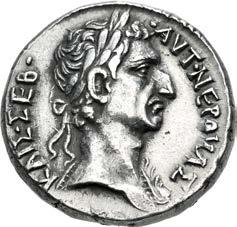
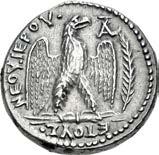
334. SELEUCIS and PIERIA, Antioch. Nerva. AD 96-98. AR Tetradrachm (26mm, 15.29 g, 11h). Dated “New Holy Year” 1 (AD 96/7). Laureate bust right, aegis at point of bust / Eagle standing right on thunderbolt, with wings displayed, palm frond to right; barred A (date) above wing. McAlee 419; RPC III 3476; Prieur 149. Toned, minor marks. Near EF. ($750)

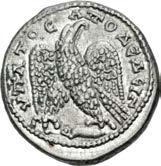
335. SELEUCIS and PIERIA, Antioch. Geta. As Caesar, AD 198-209. BI Tetradrachm (26mm, 12.33 g, 12h). Struck under Septimius Severus, AD 204. Bareheaded, draped, and cuirassed bust right, seen from behind / Eagle standing facing on leg and thigh of sacrificial animal, head and tail right, with wings displayed. McAlee 715; RPC V.3 Online 77328; Prieur 196. Lightly toned, minor porosity, a few marks. Near EF. Extremely rare, four known to Prieur, four in RPC and CoinArchives. ($500)
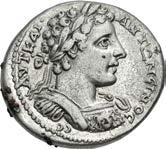
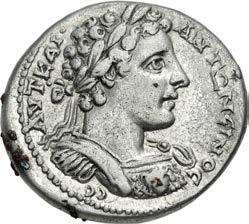
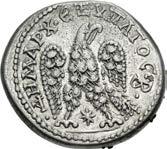
336. SELEUCIS and PIERIA, Laodicea ad Mare. Caracalla. AD 198-217. BI Tetradrachm (27mm, 13.28 g, 12h). Struck AD 205-207. Laureate and cuirassed bust right, seen from the front, gorgoneion on breastplate, slight drapery on left shoulder / Eagle standing facing, head and tail right, with wings displayed; star between legs. Prieur & Amandry Group II, 15; McAlee, Severan, Group 1, –; RPC V.3 Online 87296; Prieur 1129 (same dies). Lightly toned, hints of luster, trace deposits. Near EF. Extremely rare. Only one known to Prieur and RPC, two more in CoinArchives. ($750)


337. SELEUCIS and PIERIA, Laodicea ad Mare. Geta. As Caesar, AD 198-209. BI Tetradrachm (25mm, 13.59 g, 5h). Struck under Septimius Severus, AD 205-207. Bareheaded and cuirassed bust right, slight drapery on left shoulder / Eagle standing facing, head and tail right, with wings displayed; star between legs. Prieur & Amandry Group I, –; McAlee, Severan, Group I, 11; RPC V.3 Online 87310; Prieur 1135. Toned, minor marks. Good VF. Very rare. ($750)

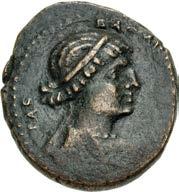

338. COELESYRIA, Chalcis ad Belum. Mark Antony and Cleopatra VII of Egypt. 32-31 BC. Æ (19.5mm, 6.50 g, 11h). Dated RY 21 (Egyptian) and 6 (Phoenician) of Cleopatra (32/1 BC). Diademed and draped bust of Cleopatra right / Bare head of Mark Antony right. RPC I 4771; Rouvier 440; Svoronos 1887; Sofaer 43. Red-brown surfaces, slight roughness. Good VF. Two excellent portraits. ($750)
Ex John Wright Collection, purchased from Jonathan Kern, July 1994.

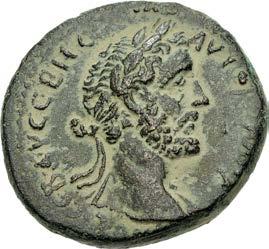

339. DECAPOLIS, Nysa-Scythopolis. Antoninus Pius. AD 138-161. Æ (29mm, 17.73 g, 12h). AYTOKP ANTωNINOC CЄB ЄV CЄB HC, laureate head right / Zeus seated left, holding Nike and scepter; at feet left, eagle; all within tetrastyle temple with central bay. Barkay 14 var. (obv legend); Spijkerman 13 (text and plates don’t match); RPC IV.3 6471 corr. (L. Verus, legends); Rosenberger 13 var. (same); Sofaer 14 var. (same). Earthen green patina. Good VF. Very rare variety. ($1000)

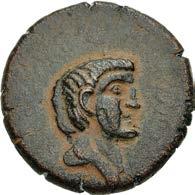

340. PHOENICIA, Aradus. Mark Antony. 38/7 BC. Æ (21mm, 8.27 g, 9h). Dated CY 222 (38/7 BC). Bare head of Antony right / Bull galloping left; CKB (date) below. RPC I 4466; Rouvier 383; BMC 355; DCA2 722. Earthen red surfaces. VF. Rare. ($750)


341. PHOENICIA, Tripolis. Caracalla. AD 198-217. Æ (32mm, 22.10 g, 12h). Dated CY 523 (AD 211/2). AY K M AY ANTωNINON CЄBA, laureate, draped, and cuirassed bust right, seen from behind / TPIΠ [O ΛI TωN], Temple of Astarte: Statue of Astarte right, wearing turreted crown, holding long scepter; crowned by Nike standing left on column to right; all within temple consisting of central archway with approaching steps and two pedimented wings with four columns each; ΓKΦ (date) below. Unpublished. Red-brown surfaces, light roughness. Good VF. Extremely rare. ($500)
From the DWBG Collection, purchased from Warden Numismatics, 2001.
This reverse type is common at Tripolis, first attested to a rare issue struck by Macrinus, then a much larger series by Elagabalus. This new Temple of Astarte type predates the Macrinus issue by six years.



342. JUDAEA, Herodians. Herod IV Philip, with Augustus. 4 BCE-34 CE. Æ (22mm, 9.95 g, 1h). Caesarea Philippi (Panias) mint. Dated RY 5 of Herod IV (1/2 CE). Bare head of Augustus right / Bare head of Herod Philip right; L E (date) across field. Meshorer 95; Hendin 6250; RPC I 4938; Sofaer 117. Red-brown surfaces, heavily smoothed and tooled. VF. Very rare. ($1000)
This issue was the first to carry the portrait of a Jewish King. David Hendin (5th ed. p. 257) notes: “Philip was able to immortalize his face on his coins largely because so few Jews lived in the territories over which he ruled. Jews would have taken this act as an insult and violation of the Mosaic Law against ‘graven images.’”



343. JUDAEA, Herodians. Herod IV Philip, with Tiberius and Livia. 4 BCE-34 CE. Æ (16mm, 3.59 g, 12h). Caesarea Panias (Caesarea Philippi) mint. Dated RY 34 of Herod IV (30/1 CE). Draped bust of Livia right / Hand holding three grain ears; L Λ Δ (date) across field. Meshorer 107; Hendin 6262; RPC I 4949; Sofaer 141. Earthen red-brown surfaces. VF. Very rare. ($500)
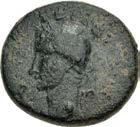

344. JUDAEA, Herodians. Agrippa I, with Gaius (Caligula). 37-43 CE. Æ (23mm, 11.19 g, 12h). Caesarea Panias (Caesarea Philippi) mint. Dated RY 5 of Agrippa I (40/1 CE). Laureate head of Gaius Caligula left / Germanicus in triumphal quadriga right, holding eagle-tipped scepter; L E (date) in exergue. Burnett, Agrippa 4976; Meshorer 116; Hendin 6270; RPC I 4976; Sofaer –. Dark green patina with earthen highlights, a few small deposits, slightly off center. Near VF. Rare. ($500)
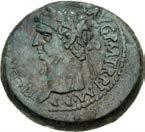

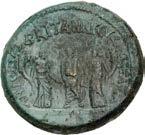
345. JUDAEA, Roman Administration. Claudius, with Britannicus, Antonia, and Octavia. 41-54 CE. Æ 8 Units (23.5mm, 12.72 g, 12h). Pre-royal issue of Agrippa II. Caesarea Panias (Caesarea Philippi) mint. Struck before 49 CE. Laureate head left / The children of Claudius: from left to right, Antonia, Britannicus, and Octavia, the daughters each holding a cornucopia. Meshorer 350; Hendin 6289; RPC I 4842; Rosenberger 11; Sofaer 83. Blue and brown surfaces, slight roughness and scratches, details lightly enhanced. VF. ($500)
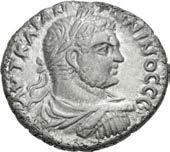

346. JUDAEA, Aelia Capitolina (Jerusalem). Caracalla. 198-217 CE. BI Tetradrachm (28mm, 11.84 g, 12h). Struck 215-217 CE. AYT KAI ANTωNINOC CЄ, laureate, draped, and cuirassed bust right, seen from behind / Eagle standing facing on filleted thyrsus, head and tail left, with wings displayed, holding wreath in beak; vine leaf between legs. RPC V.3 Online 1740 corr. (obv. legend, this coin cited); Meshorer, Aelia 94A/95 (for obv/rev); Prieur 1616/1617 (same); Sofaer –. Some luster, peripheral roughness. Good VF. Very rare. ($500)
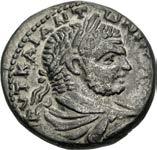

347. JUDAEA, Aelia Capitolina (Jerusalem). Caracalla. 198-217 CE. BI Tetradrachm (25mm, 13.75 g, 11h). Struck 215-217 CE. Laureate, draped, and cuirassed bust right, seen from behind / Eagle standing facing on filleted thyrsus, head and tail left, with wings displayed, holding wreath in beak; vine leaf between legs. RPC V.3 Online 1740 (this coin cited); Meshorer, Aelia 95; Prieur 1617; Sofaer 82-3. Toned, die shift on reverse. VF. ($500)



348. JUDAEA, Aelia Capitolina (Jerusalem). Caracalla. 198-217 CE. BI Tetradrachm (26mm, 12.79 g, 12h). Struck 215-217 CE. Laureate head right / Eagle standing facing on filleted thyrsus, head and tail left, with wings displayed, holding wreath in beak; wine jar between legs. RPC V.3 Online 1739 (this coin cited); Meshorer 89 var. (bust type); Prieur 1625; Sofaer –. Minor marks and scratches. VF. Extremely rare, only one known to Prieur, two in RPC. ($1000)

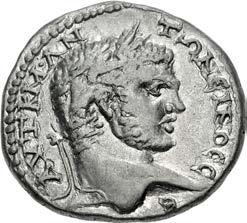
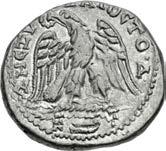
349. JUDAEA, Ascalon. Caracalla. AD 198-217. BI Tetradrachm (27mm, 13.85 g, 12h). Struck 215-217 CE. Laureate head right / Eagle standing facing on palm frond, head and tail left, with wings displayed, holding wreath in beak; in exergue, dove right with olive branch in beak flanked by H(?)T (date). RPC V.3 Online 91449 (this coin); Prieur 1654 var. (without HT); Sofaer 177 var. (same). Some luster, slight die shift on obverse. VF. Extremely rare. ($1000)


350. JUDAEA, Ascalon. Diadumenian. As Caesar, 217-218 CE. BI Tetradrachm (26mm, 12.78 g, 12h). Bareheaded and draped bust right, seen from the front / Eagle standing facing, head left, with wings displayed, holding wreath in beak, on palm branch; below, dove right, olive branch in its beak. RPC V.3 Online 79235 = Prieur 1656 (this coin); Sofaer –. Toned, some roughness, die flaw on reverse. Near VF. Extremely rare, only this coin known to Prieur, one more in RPC. ($2000)
Ex Andre Ronde Collection (Classical Numismatic Group 124, 19 September 2023), lot 459; Michel Prieur Collection.


351. JUDAEA, Gaza. Caracalla. 198-217 CE. BI Tetradrachm (25.5mm, 12.87 g, 6h). Struck 215-217 CE. Laureate, draped, and cuirassed bust right, seen from behind / Eagle standing facing, head and tail left, with wings displayed, holding wreath in beak; between legs, Marnas symbol. RPC V.3 Online 79359; Prieur 1691 corr. (obv. legend); Sofaer –. Toned, light porosity, traces of find patina. Near VF. Extremely rare, only one known to Prieur, four recorded in RPC. ($1000)


352. JUDAEA, Gaza. Caracalla. 198-217 CE. Æ (29mm, 14.55 g, 12h). Dated CY 260 (199/200 CE). Laureate, draped, and cuirassed bust right, seen from behind / Tyche, standing facing, turreted head left, holding long scepter and cornucopia; at her feet left, heifer standing left, Marnas symbol to left; ΞC (date) to right. RPC V.3 Online 93657.1 (this coin); Yashin 428 var. (obv. legend); Rosenberger –; Sofaer –. Dark green patina with earthen highlights. VF. Extremely rare, only this coin in RPC. ($750)




353. JUDAEA, Neapolis. Caracalla. 198-217 CE. BI Tetradrachm (25.5mm, 14.48 g, 12h). Struck 215-217 CE. Radiate and cuirassed bust right, seen from behind / Eagle standing facing, head and tail left, with wings displayed, holding wreath in beak; between legs, three-horned altar. RPC V.3 Online 91487 (this coin cited); Kropp –; Prieur 1310 (Byblus). Lustrous, minor marks. Good VF. Extremely rare, only one known to Prieur, two in RPC. ($1500)
Dr. Kropp has reattributed this series, by die study, from Byblus to Neapolis in Judaea (see Dr. Andreas Kropp, “A Roman altar on Mt. Gerizim: Rediscovering a civic icon on tetradrachms of Neapolis (Samaria)” in JRA 34 [2021]. pp. 220-236).
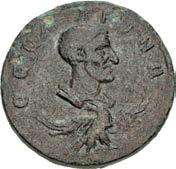

354. ARABIA, Philippopolis. Divus Julius Marinus. Died circa AD 246/7. Æ (29mm, 15.99 g, 6h). Antioch mint. Struck under Philip I, circa AD 247-249. Bareheaded and draped bust right, supported by eagle standing right, head and tail left, with wings displayed / Roma seated left, holding two figures of Philip’s parents standing on eagle left, and spear; shield at her side, S C across field. Butcher, Two, pl. 25, 10; Spijkerman 1; RPC VIII Online 2449; Sofaer 1. Dark brown surfaces, areas of corrosion, some details enhanced. VF. Rare. ($500)



355. EGYPT, Alexandria. Domitian. AD 81-96. Æ Hemidrachm (28mm, 13.78 g, 12h). Dated RY 11 (91/2 AD). Head right, wreathed in grain ears / Isis Pharia standing right, holding billowing sail in both hands; L IA (date) to left. Köln 391; Dattari (Savio) –; K&G 24.136; RPC II 2615; Emmett 268.11 (R3). Brown surfaces, die flaw at edge. Near VF. Extremely rare. ($750)
Ex Dattari Collection – RPC Online


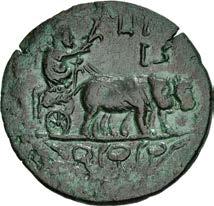
356. EGYPT, Alexandria. Trajan. AD 98-117. Æ Drachm (35mm, 24.52 g, 12h). Dated RY 13 (109/10 AD). Laureate, draped, and cuirassed bust right, seen from behind / Nilus, holding reed and reins, driving biga of hippopotami right; L IΓ (date) and Iς above; lotus flowers in exergue. Köln –; Dattari (Savio) 7132 = RPC II 4420.1.2 (this coin); K&G 27.257; Emmett 556.13 (R4). Green and red patina, light roughness, flan crack. Near VF. Extremely rare, only two recorded in RPC. ($500)
From the Plus 20 Collection. Ex Kölner Münzkabinett 119 (6 October 2023), lot 113; Elsen 155 (16 June 2023), lot 311; Giovanni Dattari (†1923) Collection.
Ex Wetterstrom Collection – Illustrated in K&G

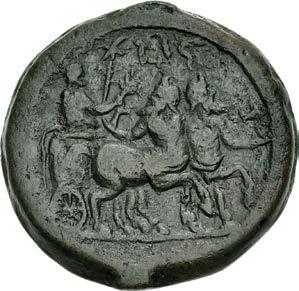

357. EGYPT, Alexandria. Trajan. AD 98-117. Æ Drachm (32mm, 19.89 g, 12h). Dated RY 16 (AD 112/3). Draped bust right, aegis on left shoulder / Trajan, laureate and togate, holding eagle-tipped scepter, driving biga of centaurs right, each centaur holds a Nike; L Iς (date) above. Köln 620; Dattari (Savio) –; K&G 27.484 (this coin illustrated); RPC III 4668; Emmett 464.16 (R5). Brown surfaces, slight roughness. Near VF. Extremely rare, only four recorded in RPC, none in CoinArchives. ($750)
From the CLA Collection. Ex Kerry K. Wetterstrom Collection (Classical Numismatic Auctions XII, 26 September 1990), lot 64; Empire Coins 8 (7 December 1987), lot 418.

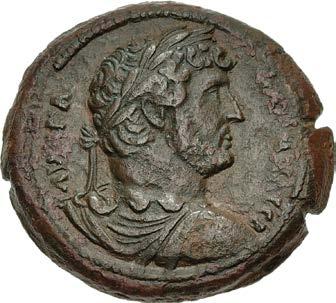
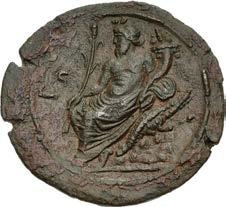
358. EGYPT, Alexandria. Hadrian. AD 117-138. Æ Drachm (37mm, 23.19 g, 12h). Dated RY 16 (AD 131/2). Laureate, draped, and cuirassed bust right, seen from behind / Nilus seated left on pile of rocks, holding reed in right hand and cornucopia in left; crocodile climbing pile of rocks below; L I ς (date) in left field. Köln 1056; Dattari (Savio) 7741; K&G 32.519; RPC III 5791; Emmett 1016.16. Red-brown patina, deposits. Good VF. ($1000)
Ex Roma E-Sale 70 (7 May 2020), lot 951; Roma E-Sale 57 (30 May 2019), lot 656; Rauch 107 (12 November 2018), lot 191.
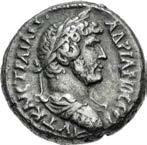

359. EGYPT, Alexandria. Hadrian, with Sabina. AD 117-138. BI Tetradrachm (24mm, 13.28 g, 12h). Dated RY 17 (AD 132/3). Laureate, draped, and cuirassed bust of Hadrian right, seen from behind / Draped bust of Sabina right, wearing stephane, seen from the front; L IZ (date) to lower right. Köln 1065 var. (obv. legend); Dattari (Savio) 1253; K&G 32.536; RPC III 5824; Emmett 886.17. Deep cabinet toning, old collection number 1359 in reverse field. Good VF. ($500)


360. EGYPT, Alexandria. Antoninus Pius. AD 138-161. Æ Drachm (34mm, 25.24 g, 12h). Dated RY 4 (AD 140/1). Laureate, draped, and cuirassed bust right, seen from behind / Ares standing facing, head left, wearing Corinthian helmet and short chiton, holding spear and parazonium; L T[Є]TAPTOV (date) around. Köln 1336 var. (bust); Dattari (Savio) 2459; K&G 35.86 = RPC IV.4 222.4 (this coin); Emmett 1463.4 (R5). Dark brown surfaces, slight roughness, patch of verdigris. VF. Extremely rare, only three others in RPC. ($500)
From the William C. Green Collection. Ex Kerry K. Wetterstrom Collection (Classical Numismatic Auctions XII, 26 September 1990), lot 170; Johns Hopkins University Collection (Part III, Numismatic Fine Arts/Bank Leu, 29 March 1985), lot 447 (part of); Walter Niggeler Collection (Part 2, Leu & Münzen und Medaillen AG, 21 October 1966), lot 728; Henry Platt Hall Collection (Part I, 19 July 1950), lot 351 (part of).
RPC notes that the representation of Ares found on this issue is similar to that of Onuris-Shu/Ares of the Sebennyte nome.
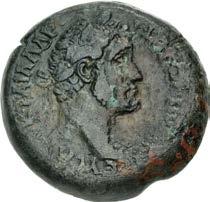


361. EGYPT, Alexandria. Antoninus Pius. AD 138-161. Æ Drachm (34mm, 23.78 g, 12h). Labor of Herakles type. Dated RY 4 (AD 140/1). Laureate head right / Herakles standing left, lion skin over shoulder, holding club overhead in and grasping the right arm-tentacle of the anthropomorphized Lernaean Hydra; L TЄTA PTOV (date) around. Köln 1347; Dattari (Savio) 8487 = RPC IV.4 249.2 (this coin); K&G 35.89; Emmett 1545.4 (R4). Brown surfaces with red and green deposits, some roughness, some smoothing and tooling. Near VF. Extremely rare, only two recorded in RPC. ($2000)
Ex Künker 347 (22 March 2021), lot 158; Günther Schlüter Collection (Chairman of the German Numismatic Society, 1975-1977), purchased December 1996; Kölner Münzkabinett 9 (1 February 1972), lot 318; Giovanni Dattari (†1923) Collection.
For his second labor, Herakles had to kill the Lernaean Hydra, the offspring of Typhon and Echidna, and the sibling of the Nemean Lion, the Chimaera, and Kerberos. Inhabiting the swamp near Lake Lerna in the Argolid, the creature possessed numerous mortal and one immortal head on its single body; should one head be removed, two more would grow in its place. When Herakles reached the swamp where the Hydra dwelt, he drew it out of its lair near the spring of Amymone. Thereupon, wielding a harvesting sickle, he attempted to decapitate the creature. When this proved unsuccessful, because of the Hydra’s regenerative ability, Herakles enlisted the assistance of his nephew Iolaos, who devised a plan: once Herakles had cut off one of the creature’s heads, Iolaos would cauterize the stump with a burning firebrand. The plan succeeded, and the Hydra was destroyed. Herakles placed its one immortal head under a large rock on the sacred way between Lerna and Elaius and dipped his arrows in its poisonous blood.
On this rare Alexandrian type, Hydra is anthropomorphized as a giantess, which as been interpreted in the past as “the giantess Echidna raising her son Hydra against Herakles in defense.” It is a mystery as to why the engravers at the Alexandrian mint chose this unusual interpretation for the Lernaean Hydra, especially when other provincial mints that struck coins for the various labors used the more traditional representation.

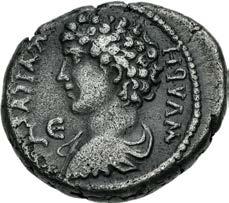
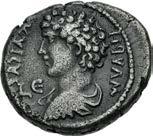
362. EGYPT, Alexandria. Antoninus Pius, with Marcus Aurelius as Caesar. AD 138-161. BI Tetradrachm (25mm, 12.81 g, 12h). Dated RY 5 (AD 141/2). Laureate, draped, and cuirassed bust of Antoninus Pius right, seen from behind / Bareheaded, draped, and cuirassed bust of Marcus Aurelius left, seen from behind; L Є (date) to left. Köln 1373; Dattari (Savio) 2111; K&G 35.132; RPC IV.4 387; Emmett 1407.5 (R3). Toned, light porosity. VF. Extremely rare, the third known. ($750)
From the Deer Creek Collection. Ex Dr. Thomas E. Beniak Collection (Triton XXVII, 9 January 2024), lot 530, purchased from Holyland Numismatics, 8 January 2010.



363. EGYPT, Alexandria. Antoninus Pius. AD 138-161. Æ Drachm (34mm, 26.95 g, 11h). Zodiac series. Dated RY 8 (AD 144/5). Laureate head right / Jupiter in Pisces – Bust of Zeus (Jupiter) right, wearing taenia and draped on left shoulder, transverse scepter across right shoulder; star of eight rays before; fish right and left below; L H (date) across field. Köln –; Dattari (Savio) 2981; K&G 35.260; RPC IV.4 837; Emmett 1692.8. Earthen green patina, short flan crack. Near VF. ($750)
From the Plus 20 Collection.
The Great Sothic Cycle was a calendrical cycle based on the heliacal rising in July of the star Sirius (known to the Greeks as Sothis) and lasting approximately 1460 years. According to ancient Egyptian mythology, in a Golden Age, the beginning of the flooding of the Nile coincided exactly with the rising of Sirius, which was reckoned as the New Year. Only once every 1460 years did Sirius rise at exactly the same time. Thus, the coincidence of this along with the concurrent beginning of the flooding of the Nile gave the event major cosmological significance by heralding not just the beginning of a new year, but the beginning of a new eon. This event also was thought to herald the appearance of the phoenix, a mythological bird which was reborn every 500 to 1000 years out of its own ashes. According to one version of the myth, each new phoenix embalmed its old ashes in an egg of myrrh, which it then deposited in the Egyptian city of Heliopolis. So important was the advent of the new Great Sothic Cycle, both to the realignment of the heavens and its signaling of the annual flooding of the Nile, that the Egyptians celebrated it in a five-day festival, which emphasized the important cosmological significance.
In the third year of the reign of Antoninus Pius (AD 139/40), a new Great Sothic Cycle began. To mark this event, the mint of Alexandria struck an extensive series of coinage, especially in large bronze drachms, each related in some astrological way to the reordering of the heavens during the advent of the new Great Sothic Cycle. This celebration would continue throughout Pius’ reign, with an immense output of coinage during the eighth year of his reign in Egypt, which included this coin type, part of the Zodiac series.



364. EGYPT, Alexandria. Antoninus Pius. AD 138-161. Æ Drachm (34mm, 24.48 g, 12h). Labor of Herakles type. Dated RY 10 (AD 146/7). Laureate head right / Herakles and Hippolyte’s Girdle – Herakles standing right, nude but for lion skin draped over his shoulder, holding club and seizing the “Golden Girdle” from the prostrate Hippolyte on her fallen horse which lies left; L ΔЄKATOY (date) around. Köln 1539; Dattari (Savio) –; K&G 35.345; RPC IV.4 14888; Emmett 1540.10 (R4). Brown patina, slight roughness, edge split. Fine. Very rare. ($750) Ex Naville Numismatics 81 (7 May 2023), lot 330.



365. EGYPT, Alexandria. Marcus Aurelius. AD 161-180. Æ Drachm (32mm, 18.24 g, 12h). Dated RY 3 (AD 162/3). Laureate, draped, and cuirassed bust left, seen from behind / Tyche reclining left on lectisternium (couch), wearing kalathos, holding rudder, resting elbow on pile of pillows and propping head on hand; L Γ (date) above. Köln 2017; Dattari (Savio) 9324; K&G 37.175; RPC IV.4 2460; Emmett 2195.3. Dark brown surfaces, a few edge splits and flan cracks, slight roughness, light scuffs at edge. Good VF. An excellent portrait. ($500)
From the Deer Creek Collection. Ex Naville Numismatics 84 (8 October 2023), lot 275.
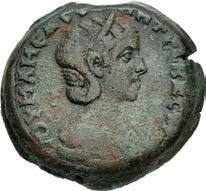
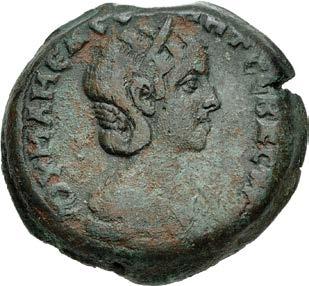

366. EGYPT, Alexandria. Julia Mamaea. Augusta, AD 222-235. Æ Drachm (33mm, 28.87 g, 12h). Dated RY 10 of Severus Alexander (AD 230/231). Draped bust right, wearing stephane / Eagle standing right, head left, with wings folded, holding wreath in beak; palm frond to left, L I (date) to right. Köln 2514; Dattari (Savio) 4560 = RPC VI Online 10480.1 = Figari & Mosconi 1315 (this coin); K&G 64.38; Emmett 3243.10 (R5). Mottled dark green, brown, and red patina, minor roughness, edge split. VF. Extremely rare, one of two known. ($1000)
From the Plus 20 Collection. Ex Stein A. Evensen Collection (Classical Numismatic Group 115, 16 September 2020), lot 520; Collection CR (Classical Numismatic Group 85, 15 September 2010), lot 730; Giovanni Dattari (†1923) Collection.
The Michael Stolt Collection features a selection of rare Mesopotamian drachms from the Antonine Era. These types all imitate contemporary imperial denominations circulating in the eastern provinces. All are quite rare and most have been illustrated in RPC as feature coins.
A note from the collector: “How this little niche collection came to be, was purely by coincidence. A few years ago, my focus was mainly with coins of the empress Lucilla. One day, I stumbled upon an uncleaned specimen for sale of a coin with her, minted at Edessa, that I acquired. While researching the type further, I also came into contact with other types from Edessa and Carrhae, and they caught my interest. Over the past few years, I have been carefully assembling this group of drachms, which has not been an easy task, considering the great rarity of most known types, and surely, there are still more awaiting to be discovered. It has been a pleasing journey, where I have learned a lot about these eastern mints, and hopefully these coins will go into collections where they can be appreciated once more. Finally, I would like to send many thanks to Michel Amandry, who helped me with research, and also adding multiple new types to RPC.”

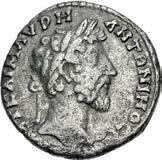

367. MESOPOTAMIA, Carrhae. Marcus Aurelius. AD 161-180. AR Drachm (18mm, 3.27 g, 11h). Struck by Ma’nu VIII Philoromaios, AD 167-179. Laureate head right / Clementia standing facing, head left, holding patera and ornamented long scepter. RPC IV.3 Online 25346.1 (this coin). Lightly toned, minor roughness. Near VF. Unique. ($500)
This coinage was struck during the joint rule of Marcus Aurelius and Lucius Verus by the Osrhoene king Ma’nu VIII Philoromaios. The reverse legend translates to “for the victory of the lords augusti.”



368. MESOPOTAMIA, Carrhae. Marcus Aurelius. AD 161-180. AR Drachm (17mm, 2.46 g, 12h). Struck by Ma’nu VIII Philoromaios, AD 167-179. Laureate head right / Two clasped hands, holding caduceus and two ears of grain. RPC IV.3 Online 25493.1 (this coin). Toned, light porosity. VF. Unique. ($500)

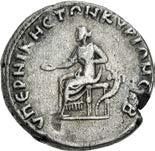

369. MESOPOTAMIA, Carrhae. Marcus Aurelius. AD 161-180. AR Drachm (17mm, 2.80 g, 12h). Struck by Ma’nu VIII Philoromaios, AD 167-179. Laureate head right / Concordia seated left, holding patera and resting elbow on cornucopia. RPC IV.3 Online 25445.1 (this coin). Toned, light porosity, small delamination flaw on reverse, edge split. VF. Unique. ($500)


370. MESOPOTAMIA, Carrhae. Marcus Aurelius. AD 161-180. AR Drachm (17mm, 2.79 g, 6h). Struck by Ma’nu VIII Philoromaios, AD 167-179. Laureate head right / Salus standing facing, head left, feeding serpent from patera rising from altar to left, holding short scepter. RPC IV.3 9919.3 (this coin); SNG Copenhagen 189 (Edessa). Deeply toned, find patina. VF. Extremely rare, only three recorded in RPC. ($500)

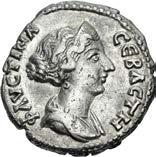
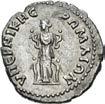
371. MESOPOTAMIA, Carrhae. Faustina Junior. Augusta, AD 147-175. AR Drachm (17mm, 2.97 g, 6h). Struck by Ma’nu VIII Philoromaios, AD 167-175. Draped bust right, wearing stephane / Fecunditas standing facing, head left, holding two children in her arms, two more children standing on either side. RPC IV.3 Online 25321.2 (this coin). Lightly toned, lustrous, surface cracks, delamination on reverse. Good VF. Unique. ($2000) Ex Künker eLive 417 (31 October 2024), lot 3342 (hammer €6250); Hauck & Aufhäuser 14 (6 October 1998), lot 355.


372. MESOPOTAMIA, Carrhae. Faustina Junior. Augusta, AD 147-175. AR Drachm (17mm, 2.96 g, 12h). Struck by Ma’nu VIII Philoromaios, AD 167-175. Draped bust right, wearing stephane / Fides standing facing, head right, holding grain ears and basket of fruit. RPC IV.3 Online 25465.1 (this coin). Toned, roughness, patches of find patina. Near VF. Unique. ($500)
From the Michael Stolt Collection.



373. MESOPOTAMIA, Carrhae. Faustina Junior. Augusta, AD 147-175. AR Drachm (18mm, 2.90 g, 11h). Struck by Ma’nu VIII Philoromaios, AD 167-175. Draped bust right, wearing stephane / Salus standing facing, head left, feeding serpent from patera rising from altar to left, holding short scepter. RPC IV.3 Online 10753. Toned, light porosity, slightly off center on obverse. Near VF. Extremely rare, only one recorded in RPC. ($500)

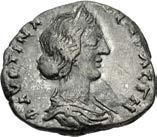

374. MESOPOTAMIA, Carrhae. Faustina Junior. Augusta, AD 147-175. AR Drachm (17mm, 2.59 g, 12h). Struck by Ma’nu VIII Philoromaios, AD 167-175. Draped bust right, wearing stephane / Providentia standing facing, head left, holding globe and cornucopia. RPC IV.3 Online 10749. Toned, underlying luster, slight roughness, scrapes. Near VF. Extremely rare, only two recorded in RPC. ($500)



375. MESOPOTAMIA, Carrhae. Lucius Verus. AD 161-169. AR Drachm (17mm, 2.77 g, 11h). Struck by Ma’nu VIII Philoromaios, AD 167-169. Laureate head right / Salus standing facing, head left, feeding serpent from patera rising from altar to left, and holding short scepter. RPC IV.3 Online 25343.1 (this coin). Toned, with hints of iridescence, light porosity, flan crack, traces of find patina. Near VF. Unique. ($500)

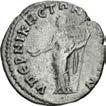
376. MESOPOTAMIA, Carrhae. Lucilla. Augusta, AD 164-182. AR Drachm (17mm, 2.20 g, 12h). Struck by Ma’nu VIII Philoromaios, AD 167-179. Draped bust right / Juno standing facing, head left, holding patera and long scepter. RPC IV.3 Online 10707.2 (this coin). Lightly toned, scrape on obverse, traces of find patina. Near VF. Extremely rare, one of two recorded in RPC. ($500)


377. MESOPOTAMIA, Carrhae. Lucilla. Augusta, AD 164-182. AR Drachm (18.5mm, 2.58 g, 12h). Struck by Ma’nu VIII Philoromaios, AD 167-179. Draped bust right / Providentia standing facing, head left, holding globe and cornucopia. RPC IV.3 Online 8036.2 (this coin). Toned, traces of find patina, some roughness and porosity, minor marks. Near VF. Extremely rare, one of two recorded in RPC. ($500)



378. MESOPOTAMIA, Edessa. Lucius Verus. AD 161-169. AR Drachm (18mm, 2.97 g, 7h). Struck by Ma’nu VIII Philoromaios, AD 167-169. Bareheaded bust right, slight drapery on left shoulder / Providentia standing facing, head left, holding globe and cornucopia. RPC IV.3 Online 25324.1 (this coin). Toned, slight porosity. VF. Extremely rare. The only example cited in RPC. ($500)



379. MESOPOTAMIA, Edessa. Lucilla. Augusta, AD 164-182. AR Drachm (18mm, 3.09 g, 6h). Struck by Ma’nu
VIII Philoromaios, AD 167-179. Draped bust right / Demeter seated left, holding poppy, grain ears, and long torch. RPC IV.3
Online 6489.8 (this coin); BMC 9; SNG Copenhagen 190. Lightly toned, minor marks and scratches. VF. Rare. ($500)


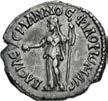
380. MESOPOTAMIA, Edessa. Lucilla. Augusta, AD 164-182. AR Drachm (17.5mm, 2.99 g, 12h). Struck by Ma’nu
VIII Philoromaios, AD 167-179. Draped bust right / Juno standing facing, head left, holding patera and long scepter. RPC IV.3
Online 8628.3 (this coin). Deeply toned, small edge split. Good VF. Extremely rare. ($750)
Ex Astarte Web Auction 2 (9 December 2023), lot 241.


381. MESOPOTAMIA, Edessa. Lucilla. Augusta, AD 164-182. AR Drachm (17mm, 2.65 g, 12h). Struck by Ma’nu
VIII Philoromaios, AD 167-179. Draped bust right / Juno standing facing, head left, holding patera and long scepter. RPC IV.3
Online 8628.4 (this coin). Lightly toned, flan crack, small edge split. VF. Extremely rare. ($500)


382. MESOPOTAMIA, Edessa. Lucilla. Augusta, AD 164-182. AR Drachm (18mm, 2.92 g, 6h). Struck by Ma’nu
VIII Philoromaios, AD 167-179. Draped bust right / Salus seated left, feeding serpent from patera rising from altar to left and holding cornucopia. RPC IV.3 Online 17203.4 (this coin). Iridescent tone, surface cracks, flan flaw on reverse. VF. Very rare. An attractive reverse composition. ($500)

383. Anonymous. 6th-4th centuries BC. Æ Aes Formatum (134x58mm, 526 g). Aes Premonetale. Axe-head shaped ingot, hollow / ICC –; Haeberlin p. 4, pl. 3, nos. 4-6. Enchanting green patina, with superficial spots of corrosion. EF. Intact and complete. A superb example in excellent condition. ($500)
From the Plus 20 Collection.
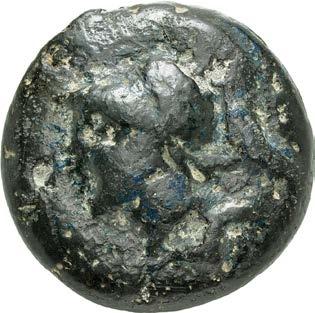
Anonymous.
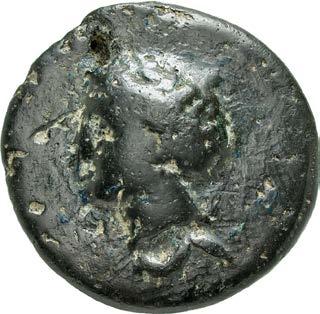
From the Plus 20 Collection. Ex Ramrodivs Collection (Triton XXVII, 9 January 2024), lot 561; Numismatica Ars Classica 7 (2 March 1994), lot 326.
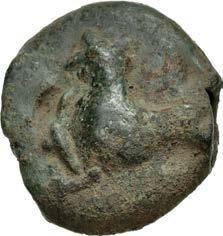
Anonymous.
From the Plus 20 Collection. Ex Artemide LIX (6 May 2023), lot 116.

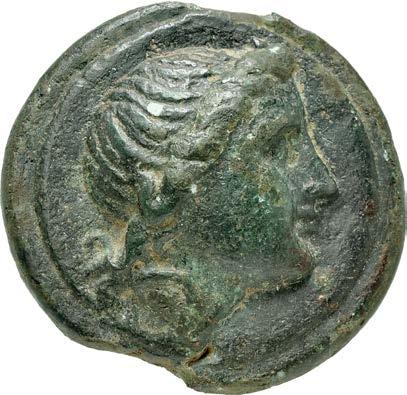

386. Anonymous. Circa 270 BC. Æ Aes Grave As (67mm, 293.50 g, 12h). Rome mint. Diademed head of Apollo right; i (mark of value) above; all on raised disk / Diademed head of Apollo left; i (mark of value) above; all on raised disk. Crawford 18/1; ICC 33; HN Italy 279; RBW 20. Dark green patina, trace deposits, casting flaws, a few chips in the patina. Near EF. High relief portraits. ($3000)
From the Plus 20 Collection. Ex Artemide LX (28 October 2023), lot 310.
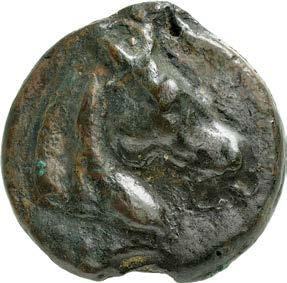

387. Anonymous. Circa 270 BC. Æ Aes Grave Triens (47mm, 106.65 g, 12h). Rome mint. Head of horse right; •••[•] (mark of value) below / Head of horse left; •••• (mark of value) below. Crawford 18/3; ICC 35; Sydenham 17; HN Italy 281; RBW –. Brown patina, light smoothing, casting voids. VF. Impressive cast in high relief. ($1500)
From the Plus 20 Collection. Ex Ramrodivs Collection (Triton XXVII, 9 January 2024), lot 563, purchased from James Beach; Coin Galleries (24 September 1981), lot 240.
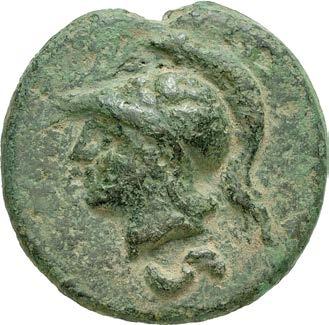

388. Anonymous. Circa 240 BC. Æ Aes Grave Semis (54mm, 140.10 g, 12h). Sickle series. Rome mint. Head of Minerva left, wearing crested Corinthian helmet; s (mark of value) below / Female head left; sickle behind; s (mark of value) below. Crawford 25/5; ICC 49; HN Italy 301; RBW 42. Earthen green patina, slight roughness, flan void on edge. Good VF. Cast in high relief. ($1500)
From the Plus 20 Collection. Ex Artemide LIX (6 May 2023), lot 296.

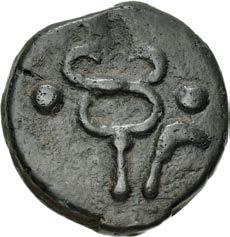
Anonymous.
From the Plus 20 Collection. Ex Numismatica Ars Classica 138 (18 May 2023), lot 326; Künker 124
May 1995), lot 335.
March 2007), lot 8215; Lanz 72




Ex Shanna Schmidt inventory rr1256 (ND). Reportedly ex Bourgey inventory, 1980.


391. Anonymous. Circa 235 BC. Æ Aes Grave As (67mm, 289.00 g, 12h). Rome mint. Head of Roma right, wearing Phrygian helmet; club to left / Head of Roma left, wearing Phrygian helmet; club to right. Crawford 27/5; ICC 58; HN Italy 318; RBW 55. Dark green patina, light earthen highlights, a few voids in flan. Near EF. An exceptional specimen, finer than any examples in CoinArchives. Very rare. ($7500)
From the Plus 20 Collection. Ex Artemide LIX (6 May 2023), lot 301.
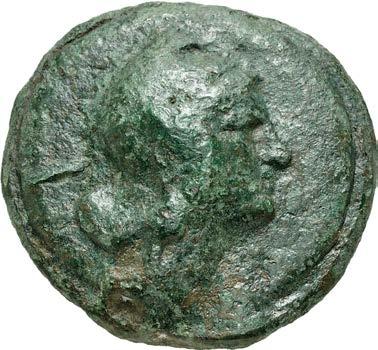
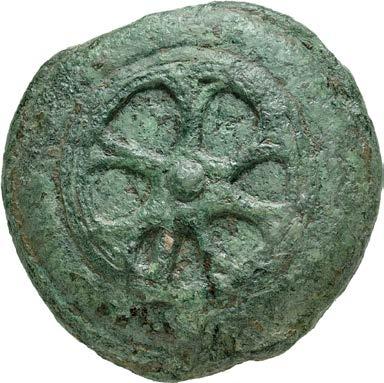
392. Anonymous. Circa 230 BC. Æ Aes Grave As (63mm, 299.0 g, 12h). Rome mint. Head of Roma right, wearing Phrygian helmet; i (mark of value) to left / Wheel of six spokes; i (mark of value) between spokes. Crawford 24/3; ICC 66; HN Italy 326; RBW 33. Green patina, light roughness, minor deposits, tiny scrape on reverse. VF. ($2500)
From the Plus 20 Collection. Ex D.K. Collection (Classical Numismatic Group 123, 23 May 2023), lot 447; Bertolami Fine Arts 87 (14 December 2020), lot 119.

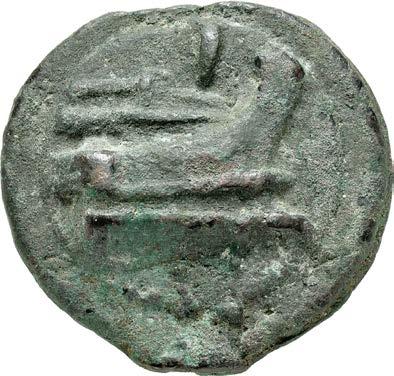
393. Anonymous. Circa 225-217 BC. Æ Aes Grave As (65mm, 257.00 g, 12h). Rome mint. Head of bearded Janus; –(mark of value) below; all on a raised disk / Prow of galley right; i (mark of value) above; all on a raised disk. Crawford 35/1; ICC 74; Sydenham 71; HN Italy 337; RBW 83. Brown and green patina with earthen green highlights, minor porosity, casting voids. Good VF. ($1500)
From the Plus 20 Collection. Ex Lawrence Feinberg Collection (Coin Galleries, 28 April 2010), lot 342.

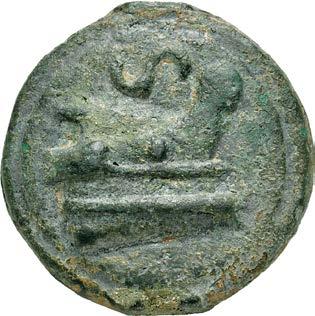
394. Anonymous. Circa 225-217 BC. Æ Aes Grave Semis (52mm, 140.12 g, 12h). Rome mint. Laureate head of Saturn left; s (mark of value) below; all on raised disk / Prow of galley right; s (mark of value) above; all on raised disk. Crawford 35/2; ICC 76; Sydenham 73; HN Italy 338; RBW 86. Earthen green patina, voids in flan. Good VF. ($1000)
From the Plus 20 Collection. Ex Astarte Web Auction 1 (31 September 2023), lot 1; Sternberg XVI (24 May 1984), lot 189.


395. Anonymous. Circa 225-217 BC. Æ Aes Grave Semis (46mm, 113.00 g, 12h). Rome mint. Laureate head of Saturn left; s (mark of value) below; all on raised disk / Prow of galley right; Í (mark of value) above; all on raised disk. Crawford 35/2; ICC 76; Sydenham 73; HN Italy 338; RBW 86. Even brown surfaces, edge chipped. VF. ($500)
From the Plus 20 Collection. Ex D.K. Collection (Classical Numismatic Group Electronic Auction 531, 26 January 2023), lot 742.
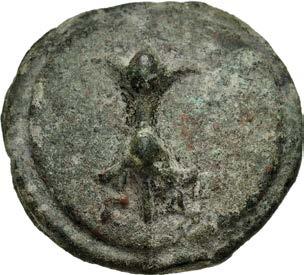

396. Anonymous. Circa 225-217 BC. Æ Aes Grave Quatrunx (47mm, 110.40 g, 12h). Luceria mint. Thunderbolt on raised disk / Club downward; •••• (mark of value) to right; all on raised disk. Crawford –; ICC 339; HN Italy 671; RBW –. Earthen light green patina, red and green deposits, slight roughness. Good VF. Very rare, and one of the finest known. ($500)
From the Plus 20 Collection. Ex Artemide LIX (6 May 2023), lot 12.


397. Anonymous. Circa 225-217 BC. Æ Aes Grave Teruncius (43mm, 87.60 g, 12h). Luceria mint. Star of six rays / Dolphin left; ••• (mark of value) below. Crawford –; ICC 340; Sydenham –; RBW –; HN Italy 672. Earthen green patina, light scratches, typical casting voids. VF. Very rare. ($750)
From the Plus 20 Collection. Ex Artemide LIX (6 May 2023), lot 13.


398. Anonymous. Circa 225-217 BC. Æ Aes Grave Quincunx (48mm, 104.90 g, 12h). Luceria mint. Four wheel spokes / Four wheel spokes; ••••• (mark of value) below. Crawford –; ICC 337; Sydenham 124; HN Italy 670; RBW –. Green-brown patina with light earthen highlights, minor porosity and flan voids. VF. Extremely rare. ($1500)
From the Plus 20 Collection. Ex Artemide LIX (6 May 2023), lot 11.

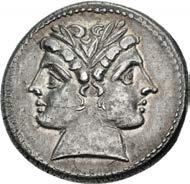

399. Anonymous. Circa 225-212 BC. AR Didrachm – Quadrigatus (21mm, 6.69 g, 9h). Rome mint. Laureate head of Janus; slightly curved truncation / Jupiter, hurling thunderbolt and holding scepter, in galloping quadriga driven right by Victory; rOÂA in relief within a linear frame in exergue. Crawford 28/3; Sydenham 65; RSC 24; RBW 68 var. (flat truncation). Iridescent toning, light marks and scrape, delamination. Good VF. ($500)
From the DWBG Collection, purchased from William Warden, 1997.

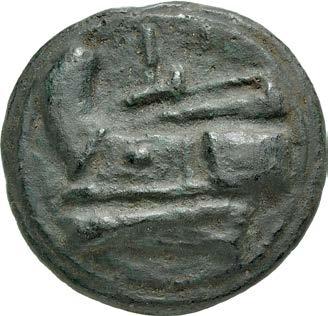
400. Anonymous. Circa 217-215 BC. Æ Aes Grave As (54mm, 145.50 g, 12h). Rome mint. Head of bearded Janus on a raised disk / Prow of galley left; i (mark of value) above; all on a raised disk. Crawford 38/1; ICC 93; Sydenham 89; RBW 94. Dark green patina with light earthen highlights. Good VF. ($1000)
From the Plus 20 Collection. Ex Artemide LIX (6 May 2023), lot 310.


401. Anonymous. Circa 217-215 BC. Æ Triens (37mm, 50.06 g, 1h). Rome mint. Head of Juno right, wearing diadem decorated with crest of helmet; •••• (mark of value) to left / Hercules standing right, holding club with which he is about to strike a centaur, whom he grasps by the hair of his head; •••• (mark of value) to right and below foreleg of horse. Crawford 39/1; Sydenham 93; RBW 104. Earthen green patina, some roughness. VF. ($750)
From the Plus 20 Collection. Ex Artemide LIX (6 May 2023), lot 315.
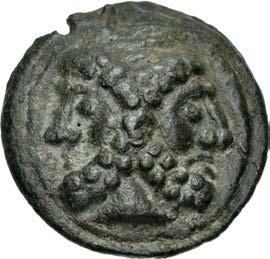
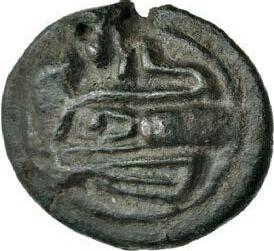
402. Anonymous. Circa 215-212 BC. Æ Aes Grave As (43mm, 42.50 g, 1h). Rome mint. Head of bearded Janus on a raised disk / Prow of galley left; i (mark of value) above; all on a raised disk. Crawford 41/5a; ICC 105; Sydenham 101; RBW 112–4. Earthen green patina, a few casting voids. EF. ($600)
From the Plus 20 Collection. Ex Artemide LIX (6 May 2023), lot 319.

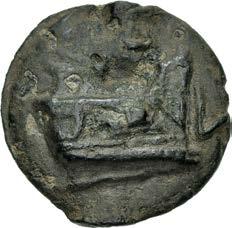
403. Anonymous. Circa 214-212 BC. Æ Aes Grave Semis (37mm, 46.20 g, 12h). Luceria L series. Luceria mint. Laureate head of Saturn right / Prow of galley right; Í (mark of value) above, 6 to right. Crawford 43/2a; ICC 114; Sydenham 123; RBW 151. Earthen green patina, casting voids. VF. Very rare. ($500)
From the Plus 20 Collection. Ex Artemide LIX (6 May 2023), lot 32; Giessener Münzhandlung 48 (2 April 1990), lot 668.
Ex RBW Collection

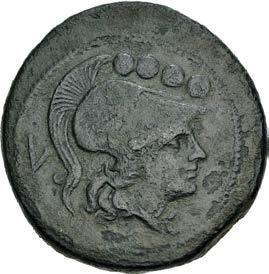

404. Anonymous. Circa 214-212 BC. Æ Triens (29mm, 23.09 g, 7h). Luceria L series. Luceria mint. Helmeted head of Minerva right; •••• (mark of value) above, 6 to left / Prow of galley right; •••• (mark of value) below. Crawford 43/3a; Sydenham 125; RBW 152 (this coin). Green patina, slight roughness, delamination flaws. VF. ($500)
From the Plus 20 Collection. Ex Artemide LIX (6 May 2023), lot 37; RBW Collection (Part 1, Numismatica Ars Classica 61, 5 October 2011), lot 157, purchased from J. Cappello, January 2005.




405. Anonymous. 211-208 BC. AV 60 Asses (15mm, 3.36 g, 8h). Rome mint. Helmeted head of Mars right; çc (mark of value) to left / Eagle standing right on thunderbolt, with wings spread. Crawford 44/2; Sydenham 226; Bahrfeldt 4a; Biaggi 3; RBW 160–1. In NGC encapsulation 6062408-004, graded AU★, Strike: 5/5, Surface: 4/5. ($7500)
Ex Triton XXVII (9 January 2024), lot 575; Ed’s Treasures Collection (Heritage 61238, 5 December 2021), lot 99069; CNG inventory 863493 (February 2010); Stack’s (11 January 2010), lot 312; Sternberg XXIX (30 October 1995), lot 409; Numismatic Fine Arts XXXIII (3 May 1994), lot 1468.



406. C. Renius. 138 BC. AR Denarius (18mm, 3.91 g, 11h). Rome mint. Helmeted head of Roma right; x (mark of value) to left / Juno Caprotina, holding whip, reins, and scepter, driving biga of goats right. Crawford 231/1; Sydenham 432; Renia 1; RBW 961. Minor marks, short edge splits. EF. ($500)
From the Deer Creek Collection. Ex Artemide LVII (30 April 2022), lot 313.
Juno, the queen of the Roman gods and wife of Jupiter, is seen here as Juno Caprotina, the Goddess of Fertility. Her festival, Nonae Caprotinae, was celebrated on the seventh day of July and was exclusively attended by women, even slaves were allowed to attend. Juno Caprotina was the patron goddess of Lanuvium, the ancestral home of the Renius family.
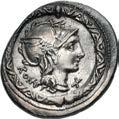
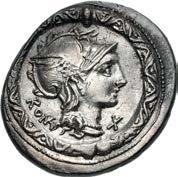
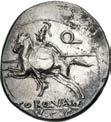
407. L. Torquatus. 113-112 BC. AR Denarius (19.5mm, 3.97 g, 5h). Helmeted head of Roma right; x (mark of value) below chin; all within decorated torque / Warrior, holding spear and shield, on horseback galloping left. Crawford 295/1; Sydenham 545; Manlia 2; RBW 135. Lightly toned, find patina, minor marks, reverse flan flaw at edge. Near EF. Wonderful portrait of Roma. ($500)
From the Doctore Collection.
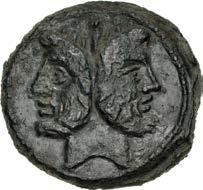

408. C. Fabius C.f. Hadrianus. 102 BC. Æ As (33mm, 25.90 g, 5h). Rome mint. Laureate head of bearded Janus; i (mark of value) above / Prow of galley right; to right; bird (stork, heron, or flamingo) standing right on rostrum. Crawford 322/2; Sydenham 591; RBW 1178. Dark green patina, roughness, some smoothing, minor doubling on reverse. Good VF. Extremely rare. ($750)
From the Plus 20 Collection. Ex Artemide LIX (6 May 2023), lot 404.

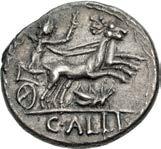

409. C. Allius Bala. 92 BC. AR Denarius (17.5mm, 3.89 g, 12h). Rome mint. Diademed head of female (Diana?) right; D below chin / Diana, holding spear, reins, and torch driving galloping biga of stags right; grasshopper below; all within laurel wreath. Crawford 336/1b; Sydenham 595; Aelia 4; RBW 1228 var. (control). Toned, with light iridescence, traces of horn silver, minor marks and scratches. Near EF. ($500)
From the Doctore Collection.



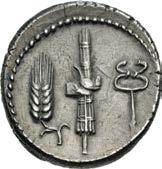
410. C. Norbanus. 83 BC. AR Denarius (18mm, 4.02 g, 12h). Rome mint. Diademed head of Venus right; CLxxxxuiii to left / Fasces between grain ear on left and caduceus on right. Crawford 357/1b; Sydenham 739; Norbana 2; RBW 1363 var. (control). Toned, with light iridescence, flan crack, die breaks on reverse. Near EF. ($500)
From the Doctore Collection.
The reverse of this coin likely pays tribute to the moneyer’s father, who played a significant role in the Social War by gathering troops, raising a fleet, and providing provisions for the town of Rhegium. The coinage was a large emission with numbers recorded from I to CCXXVIIII.



411. L. Sulla and L. Manlius Torquatus. 82 BC. AR Denarius (17mm, 3.96 g, 10h). Military mint moving with Sulla. Helmeted head of Roma right / Sulla, holding branch and reins, driving triumphal quadriga right; above, Victory flying left, crowning him with laurel wreath. Crawford 367/5; Sydenham 757; Manlia 4; RBW 1386 corr. (Cr. 367/3). Iridescent tone over lustrous surfaces. Near EF. ($500)
From the GTP Collection. Ex Elsen 155 (16 June 2023), lot 831; Elsen 59 (18 September 1999), lot 371.
As consul for the year 88 BC, Sulla was awarded the coveted assignment of suppressing the revolt of Mithradates VI of Pontus, but political maneuvers resulted in this assignment being transferred to Marius. In response, Sulla turned his army on Rome, captured it, and reclaimed his command against Mithradates. His prosecution of the first Mithradatic War was successful, but he spared the Pontic king for personal gain. In 83 BC, Sulla returned to Italy as an outlaw, but he was able to win the support of many of the leading Romans. Within a year he fought his way to Rome, where he was elected dictator. It was during this campaign to Rome that this denarius was struck. The reverse shows Sulla enjoying the highest military honor to which a Roman could aspire, the celebration of a triumph at Rome.



412. C. Naevius Balbus. 79 BC. AR Serrate Denarius (19mm, 3.74 g, 5h). Rome mint. Diademed head of Venus right / Victory driving galloping triga right, holding reins; Cxxxuiiii above. Crawford 382/1b; Sydenham 769b; Naevia 6; RBW 1410 var. (control). Toned with light iridescence, minor marks, tiny flan crack. EF. ($500)
From the Doctore Collection.


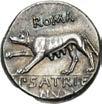
413. P. Satrienus. 77 BC. AR Denarius (17mm, 3.87 g, 5h). Rome mint. Helmeted head of young Mars right; uiii to left / She-wolf standing left with paw raised. Crawford 388/1b; Sydenham 781a; Satriena 1; RBW 1422 var. (control). Lightly toned, underlying luster. EF. Well struck. ($750)
Ex Classical Numismatic Review XLV.2 (Summer 2020), no. 511978; Artemide LI (27 April 2019), lot 226.
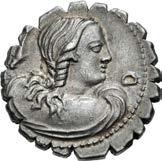

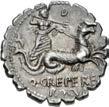

414. Q. Creperius M.f. Rocus. 69 BC. AR Serrate Denarius (18mm, 3.77 g, 6h). Rome mint. Draped bust of Amphitrite right, seen from behind; dolphin downward to left, D upward to right / Neptune, brandishing trident and holding reins, driving sea-chariot drawn by two hippocamps right; D above. Crawford 399/1a; Sydenham 796; Crepereia 1; RBW 1440. Lightly toned. Good VF. ($2000)
From the Deer Creek Collection. Ex Vogelberg Collection, formed circa 1960–1985.


415. Q. Fufius Calenus and Mucius Cordus. 68 BC. AR Serrate Denarius (20mm, 3.81 g, 5h). Rome mint. Jugate heads right of Honos, laureate, and Virtus, wearing crested helmet / Italia standing right, holding cornucopia and clasping hands with Roma standing left, with right foot on globe, holding scepter; winged caduceus to left. Crawford 403/1; Sydenham 797; Fufia 1; RBW 1445. Toned, lustrous, traces of horn silver. EF. ($500)




416. C. Piso L.f. Frugi. 61 BC. AR Denarius (18mm, 3.70 g, 6h). Rome mint. Head of Apollo right, wearing taenia; lizard to left / Horseman galloping right, holding reins; ¬ below. Crawford 408/1b; Hersh, Piso 144 (O48/R53); Sydenham 841f; Calpurnia 24; RBW –. Lightly toned, remnants of horn silver, minor marks, slightly off center. EF. ($500)
From the Deer Creek Collection. Ex Artemide LV (24 April 2021), lot 329.
417. M. Plaetorius M.f. Cestianus. 57 BC. AR Denarius (18.5mm, 3.98 g, 6h). Rome mint. Draped female bust (Ceres?) right; lizard to left / Upright winged caduceus. Crawford 405/3b; Sydenham 805; Plaetoria 6; RBW 1450. Iridescent tone, some find patina. Near EF. ($500)
From the Doctore Collection.


418. Q. Pomponius Musa. 56 BC. AR Denarius (17mm, 3.95 g, 5h). Rome mint. Laureate head of Apollo right; wreath tied with fillet to left / Polyhymnia, the Muse of Divine Hymns and Sacred Poetry, standing facing, her head bound with wreath. Crawford 410/10a; Sydenham 817; Pomponia 15; RBW –. Iridescent tone, trace deposits, minor marks. Good VF. ($750)
From the Doctore Collection.
Polyhymnia was the muse who inspired the voices of the greatest poets, bards, and orators of ancient Greece. Her influence extended beyond song and speech to include geometry and other intellectual pursuits, illustrating the interconnectedness of artistic and scientific endeavors in Greco-Roman thought. She is said to have had the gift of prophecy and to have invented the lyre.
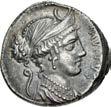
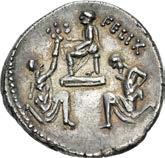
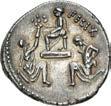
419. Faustus Cornelius Sulla. 56 BC. AR Denarius (18mm, 4.08 g, 3h). Rome mint. Diademed and draped bust of Diana right; crescent above, lituus to left / Sulla seated left on raised seat; to left, Bocchus, king of Mauretania, kneels right, offering an olive branch; to right, Jugurtha, king of Numidia, kneeling left, his hands tied behind him. Crawford 426/1; Sydenham 879; Cornelia 59; RBW 1525. Toned, reverse with brilliant iridescence, slight porosity. EF. ($1000)
Ex Classical Numismatic Review XLV.1 (Winter 2020), no. 525594; Nomisma 18 (11 April 2001), lot 65.
Faustus was the son of Lucius Cornelius Sulla, the famous general and dictator of Rome (138-78 BC). The coin portrays Sulla’s first great victory, in which he ended the Jugurthine War. Jugurtha, grandson of Massinissa of Numidia, had claimed the entire kingdom of Numidia and divided it between several members of the royal family, in defiance of Roman decrees. Rome declared war on Jugurtha in 111 BC, but for five years the wily king frustrated all efforts to bring him to heel. Finally, in 106 the popular general Marius was assigned command, with Sulla as quaestor in charge of cavalry. Before Marius could take to the field against the enemy, however, Sulla arranged with his ally Bocchus of Mauretania to have Jugurtha ambushed and captured. Sulla was acclaimed for the bloodless end of the war, gaining his first victory and the eternal enmity of Marius.
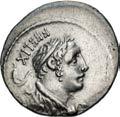

420. Faustus Cornelius Sulla. 56 BC. AR Denarius (20mm, 3.54 g, 3h). Rome mint. Diademed bust of young Hercules right, wearing lion skin headdress tied around his neck / Diana driving galloping biga right, holding reins and lituus; crescent above her head; two stars above, two stars below horses. Crawford 426/2; Sydenham 880; Cornelia 60; RBW 1527. Lightly toned, slightly off center, die flaw on obverse. Good VF. ($500)
From the Doctore Collection.

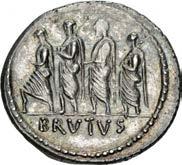
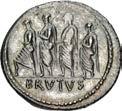
421. Q. Servilius Caepio (M. Junius) Brutus. 54 BC. AR Denarius (20mm, 3.77 g, 5h). Rome mint. Head of Libertas right, no jewels in hair / The consul L. Junius Brutus walking left between two lictors, each carrying axe over shoulder, preceded by an accensus. Crawford 433/1; Sydenham 906a; Junia 31a; RBW 1542. Iridescent toning, minor marks, small scrape and minor weakness on reverse. EF. ($750)
Ex Numismatica Ars Classica 4 (27 February 1991), lot 256; Numismatica Ars Classica 2 (21 February 1990), lot 426.
This early coin of Marcus Junius Brutus, later known as Q. Servilius Caepio Brutus, refers to the illustrious ancestry of the clan, which included one of the legendary first consuls of the nascent Roman Republic, L. Junius Brutus. Because of his name and reputation for integrity, Brutus was recruited by conspirators against Julius Caesar and became the figurehead leader of the assassins.
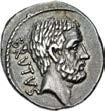
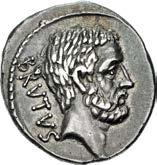
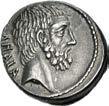
422. Q. Servilius Caepio (M. Junius) Brutus. 54 BC. AR Denarius (17mm, 3.74 g, 7h). Rome mint. Bare head of L. Junius Brutus right / Bare head of C. Servilius Ahala right. Crawford 433/2; Sydenham 907; Junia 30; RBW 1543. Attractive cabinet toning, a few hairlines under tone, small die breaks on reverse. Near EF. ($750)
Ex Peus 374 (23 April 2003), lot 466; Banti Collection (Peus 322, 1 November 1988), lot 508.


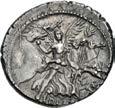
423. Moneyer issues of Imperatorial Rome. L. Plautius Plancus. 47 BC. AR Denarius (19mm, 3.93 g, 6h). Rome mint. Facing mask of Medusa with disheveled hair, without serpents / Victory (or winged Aurora) flying right, head slightly left, holding reins and conducting four rearing horses of the sun. Crawford 453/1c; CRI 29a; Sydenham 959b; Plautia 14; RBW 1585. Toned with hints of iridescence, scratch and banker’s mark on obverse. Good VF. Well centered. ($500)
From the Doctore Collection.
The reverse theme can be tied to a specific ancient work of art, a painting by the 4th century BC artist Nikomachos of Thebes, apparently in the possession of the Munatii and possibly the personal property of the moneyer, L. Plautius Plancus. Plautius was the brother of Lucius Munatius Plancus, who famously survived the precarious times by constantly switching sides. When the Second Triumvirate was formed in 43 BC, he reputedly demonstrated his loyalty by offering up his brother Plautius for proscription and execution. Munatius apparently inherited the painting, as it is recorded that he dedicated it to the Capitol at his Gallic Triumph of the same year, raising the question of his motivation in surrendering his brother’s life.



424. Moneyer issues of Imperatorial Rome. T. Carisius. 46 BC. AR Denarius (17.5mm, 4.06 g, 9h). Rome mint. Head of Sibyl Herophile right / Sphinx seated right. Crawford 464/1; CRI 69; Sydenham 983a; Carisia 11; RBW 1613. Toned, minor marks, light iridescence on reverse. VF. ($500)
Ex Roma E-Sale 84 (16 June 2021), lot 1343; W. F. Stoecklin (†1975) Collection (Nomos Obolos 9, 25 March 2018), lot 99; H. C. Hoskier Collection (A. Hess, 15 February 1934), lot 564; Ernst Justus Haeberlin Collection (Cahn [83], with A. Hess Nachf., 17 July 1933), lot 2780.
This evocative type demonstrates that Roman moneyers were quite familiar with the legends and coin types of obscure Greek cities. The city of Gergis in Troas, near the site of ancient Troy, was said to be the birthplace of the Sibyl Herophile, a priestess with prophetic powers. Coins of the city struck circa 350-300 BC depict a head of the Sibyl on the obverse and a seated sphinx, a symbol of prophecy, on the reverse. The types are repeated here, surely intended as a nod to the Trojan origins of Julius Caesar’s gens.


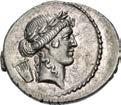

425. Moneyer issues of Imperatorial Rome. P. Clodius M.f. Turrinus. 42 BC. AR Denarius (17mm, 3.95 g, 3h). Rome mint. Radiate head of Sol right; quiver to left / Crescent moon and five stars. Crawford 494/21; CRI 182; Sydenham 1115; Claudia 17; RBW 1726. Lightly toned, with hints of iridescence, hairlines. Near EF. ($500)
From the Doctore Collection.
426. Moneyer issues of Imperatorial Rome. P. Clodius M.f. Turrinus. 42 BC. AR Denarius (20mm, 3.65 g, 12h). Rome mint. Laureate head of Apollo right; lyre to left / Diana Lucifera standing right, bow and quiver over her shoulder, holding torches. Crawford 494/23; CRI 184; Sydenham 1117; Claudia 15; RBW 1727. Lightly toned and lustrous, hairlines, slightly off center. Choice EF. ($500)
Ex Heritage 3073 (25 April 2019), lot 32222.
P. Clodius Turrinus was part of the quattuorvirate, a group of four moneyers appointed by the Second Triumvirate (Antony, Octavian, and Lepidus) to oversee the regular production of gold coins at the mint of Rome. Little is known of him outside of the coinage struck in his name which typically included themes of Apollo and Diana Lucifera. The other members of the quattuorvirate were: L. Livineius Regulus, L. Mussidius Longus, and C. Vibius Varus.
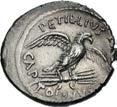
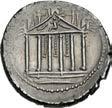
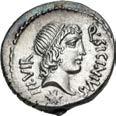
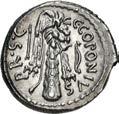
427. Moneyer issues of Imperatorial Rome. Petillius Capitolinus. 41 BC. AR Denarius (19mm, 3.81 g, 5h). Rome mint. Eagle with wings spread standing facing, head right, on thunderbolt / The Temple of Jupiter Capitolinus: richly decorated hexastyle temple with three garlands hanging between columns; the pediment ornamented with armed figures; in the tympanum is a seated figure of Jupiter between two other figures. Crawford 487/2a; CRI 174; Sydenham 1150; Petillia 2; RBW 1704. Toned with iridescence, minor marks, slightly off center. Good VF. ($500)
From the Doctore Collection.
Petillius Capitolinus was one of the last moneyers to strike an independent senatorial coinage prior to the Triumvirs seizing control of the minting process in 41 BC. The types he chose – including this type with a façade of the Temple of Jupiter Capitolinus on the reverse – are doubtless a play on his name. It is possible, though not certain, that he was the same Petillius Capitolinus who was later accused of peculation and acquitted. Horace mentions him in his Satires; a later Roman commentator embellished the tale, claiming that Capitolinus was custodian of the Capitoline temple, and was accused of stealing the golden crown from the statue of Jupiter. His acquittal was supposedly due to his close friendship with Augustus.
428. The Pompeians. Q. Sicinius and C. Coponius. 49 BC. AR Denarius (19mm, 3.84 g, 3h). Military mint in the East, moving with Pompey; C. Coponius, praetor. Diademed head of Apollo right; star below / Club of Hercules surmounted by lion skin, scalp in profile to right; arrow to left, bow to right. Crawford 444/1a; CRI 3; Sydenham 939; Sicinia 1; RBW 1558. Iridescent toning, lustrous, hairlines, graffito on obverse. EF. ($500)
From the Doctore Collection.
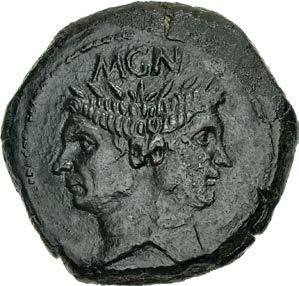
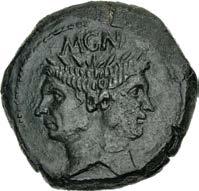

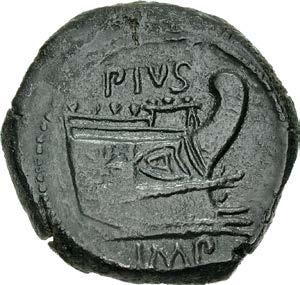
429. The Pompeians. Sextus Pompey. 42-38 BC. Æ As (32.5mm, 26.66 g, 12h). Uncertain Sicilian mint. Laureate Janiform head of Pompey the Great / Prow of galley right. Crawford 479/1; Martini, Sextus, Emission III, Group 1, Series A; CRI 336; Sydenham 1044a; RBW 1676. Glossy brown patina, light roughness, scratch on obverse. Near EF. In fine style, exceptional. ($1500)
From the Plus 20 Collection. Ex D.K. Collection (Classical Numismatic Group 123, 23 May 2023), lot 481.

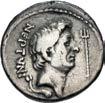
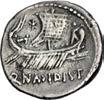

430. The Pompeians. Sextus Pompey. 42-38 BC. AR Denarius (17mm, 2.92 g, 11h). Massilia (Marseilles) mint; Q. Nasidius, commander of the fleet. Bare head of Pompey the Great right; trident to right; below, dolphin right / Galley with bank of rowers right, under full sail, helmsman steering rudder, hortator standing on prow; star to upper left. Crawford 483/2; CRI 235; Sydenham 1350; RSC 20 (Pompey the Great); RBW 1698. Toned, traces of find patina, minor marks, scrape on obverse. VF. ($750)
From the Doctore Collection.
Sextus Pompey came of age during the ascendancy of his father, Gnaeus Pompeius Magnus (Pompey the Great), as the leading general of Rome and the most powerful man in the Republic. After Pompey’s defeat by Julius Caesar at Pharsalus in August of 48 BC, and his treacherous murder in Egypt later that year, Sextus joined the Pompeian resistance to Caesar in Spain. Caesar’s assassination on March 15, 44 BC brought a brief revival of Senatorial control, during which Sextus relocated to Massalia in southern Gaul. In April of 43 BC, the Senate appointed him commander of the Roman fleet. Although the promotion was rescinded three months later, Sextus wasted no time in seizing Sicily and spent the next months building an impregnable power base on the island even as Rome fell under the sway of Caesar’s political heirs, the Triumvirs Antony, Octavian and Lepidus.
This denarius belongs to the brief interval between Caesar’s murder and Sextus’ appointment as Praefect of the Fleet, during his sojourn at the Gallic port city of Massilia. The obverse portrait is clearly recognizable as Pompey the Great, although the legend identifies him as “son of Neptune” (an epithet won by Magnus after his defeat of the Cilician Pirates, and later claimed by Sextus himself) and provides him appropriate attributes - a dolphin and trident. The warship on the reverse appears to be a hemiola, a fast ramming vessel with two banks of oars totaling 52 a side. Interestingly, Sextus himself is not named; instead the moneyer is identified as Quintus Nasidius, a loyal Pompeian commander of naval forces who backed Sextus in his early career, only to later defect to Mark Antony.
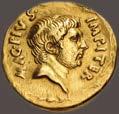


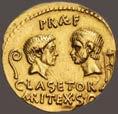
431. The Pompeians. Sextus Pompey. 37/6 BC. AV Aureus (19.5mm, 8.09 g, 7h). Uncertain Sicilian mint. Bare head of Sextus Pompey right; ÂAg • piuÍ • iÂp • iTer around; all within oak wreath / Bare heads of Pompey the Great right vis-àvis Gnaeus Pompey Junior left; lituus to left, tripod to right; pr‰F above; CLAÍ • eT • Or‰/ºiT • ex • Í • C in two lines below. Crawford 511/1; Evans O1/R2; CRI 332; Sydenham 1346; Bahrfeldt 87; Calicó 71a; Biaggi 48; RBW 1783. Light scratches, filing on edge, ex mount. VF. ($25,000)
Ex Burgan (26 January 2024), lot 379.
Sextus Pompey, the younger son of Pompey the Great, inherited his father’s vast influence and personal following. He first established himself in Spain in 44 BC as the successful leader of the anti-Caesarian forces and following the death of Caesar, the Senate, believing itself freed from the domination of the Caesarians, bestowed on Sextus the title of praefectus classis et orae maritimae (Commander-in-Chief of the Fleet and of the Sea Coasts). However, four months later the Senate was forced by Octavian and the second triumvirate to rescind this title, and Sextus was proscribed. Upon receiving word of the Senate’s abrogation of his commission and seeing the hostilities the Caesarians were exacting on the leading figures in Rome, Sextus set sail from Massilia in Gaul and headed for Sicily. Here he established a powerful base from which he could blockade Italy and provide a safe haven for those fleeing the proscriptions. Alarmed at the developments, Octavian sent a naval squadron under the command of Salvidienus Rufus to handle the situation, but Salvidienus was defeated off the coast of Rhegium. Following this battle, Sextus took the title of imperator iterum. Sextus would continue the Republican struggle against the Second Triumvirate until his death in 36 BC. This remarkable dynastic aureus provides us with the most life-like portraits of Pompey’s two sons and records many of the events of 43-42 BC. The oak wreath (corona civica) and the title IMP ITER on the obverse commemorate Sextus’ defeat of Salvidienus, while the reverse legend records the title bestowed on him by the Senate in 43 BC. The lituus behind Pompey’s head signifies Pompey’s membership in the college of augurs, while the tripod behind Gnaeus’ head represents his affiliation with the quindecimviri sacris faciundis



432. The Caesarians. Julius Caesar. April-August 49 BC. AR Denarius (18mm, 3.95 g, 1h). Military mint traveling with Caesar. Elephant advancing right, trampling on horned serpent / Emblems of the pontificate: simpulum, aspergillum, securis, and apex. Crawford 443/1; CRI 9; Sydenham 1006; RSC 49; RBW 1557. Deep cabinet tone with some iridescence, small die break on obverse. Good VF. ($1000)
Ex UBS 53 (29 January 2002), lot 103.
Julius Caesar and his armies assembled on the banks of the Rubicon River on 10 January 49 BC, ready to invade Italy. Since large quantities of denarii were necessary to pay Caesar’s military expenses, the mint traveled with them. This issue was ordered, not by a moneyer, as was usual, but by Julius Caesar himself. The obverse clearly depicts the triumph of good over evil, numismatic propaganda designed to encourage Caesar’s soldiers during the long, intense campaign. The reverse, depicting priestly emblems, tells of Caesar’s office as Pontifex Maximus, high priest. In all likelihood, this type was used by Caesar’s military forces at least until the decisive battle of Pharsalus.
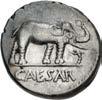
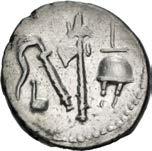

433. The Caesarians. Julius Caesar. April-August 49 BC. AR Denarius (17mm, 3.96 g, 2h). Military mint traveling with Caesar. Elephant advancing right, trampling on horned serpent / Emblems of the pontificate: simpulum, aspergillum, securis, and apex. Crawford 443/1; CRI 9; Sydenham 1006; RSC 49; RBW 1557. Toned, with light iridescence, traces of find patina, scratches. Good VF. ($1000)
From the Doctore Collection.




434. The Caesarians. Julius Caesar. Late spring-early summer 48 BC. AR Denarius (21mm, 3.89 g, 4h). Military mint traveling with Caesar. Diademed female head (Clementia?) right, wearing oak wreath; %ii (= 52, Caesar’s age) to left / Gallic trophy, holding oval shield and carnyx surmonted by wolf’s head; securis to right. Crawford 452/2; CRI 11; Sydenham 1009; RSC 18; DCA 937; RBW –. Toned with light iridescence, edge split, die rust, scratches under tone, double struck on reverse. Good VF. ($750)
From the DWBG Collection, purchased from William Warden, 1987.
The letters behind the female head have long been recognized as representing Caesar’s age, thereby placing this issue firmly within the year 48 BC. Caesar’s fifty-second birthday was on 13 July 48 BC; the battle at Pharsalus, the final major conflict between the Caesarian and Pompeian forces, occurred one month later.
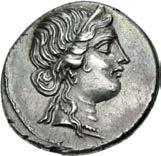



435. The Caesarians. Julius Caesar. Late 48-47 BC. AR Denarius (17.5mm, 3.81 g, 7h). Military mint traveling with Caesar in North Africa. Diademed head of Venus right / Aeneas advancing left, holding palladium and bearing Anchises on his shoulder. Crawford 458/1; CRI 55; Sydenham 1013; RSC 12; RBW 1600. Attractively toned, scratches. Superb EF. Exceptional reverse. ($1000)
Ex Gorny & Mosch 125 (13 October 2003), lot 356; Lanz 34 (25 November 1985), lot 410.
Julius Caesar traced his descent all the way back to the Trojan hero Aeneas, legendary founder of the Romans. Aeneas, in turn, was the product of a liaison between the goddess Venus and Anchises, a herdsman who was related to the Trojan royal family. In a scene recounted by Virgil in the Aeneid, when the Greeks torched Troy, Aeneas escaped from the burning city carrying the aged Anchises on his shoulder and the sacred Palladium, a cult statue of Pallas Athena rescued from the household shrine. The scene is depicted on the reverse of this denarius of Caesar, struck in 48-47 BC, at least two decades before the Aeneid was composed. Venus, the mother of Aeneas (and thus the divine antecedent of Caesar) appears on the obverse.


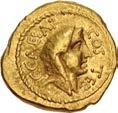
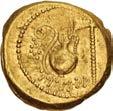

436. The Caesarians. Julius Caesar. Early 46 BC. AV Aureus (19mm, 8.04 g, 5h). Rome mint; A. Hirtius, praetor. Veiled head of female (Vesta or Pietas?) right; C • CAeÍAr COÍ Ter around / Emblems of the augurate and pontificate: lituus, capis, and securis; A • hirTiuÍ • pr around from lower left. Crawford 466/1; Molinari – (D23/R220 [unrecorded die pair]); CRI 56; Sydenham 1018; Calicó 37; Biaggi –; RBW 1636. Minor marks and scratches. Near VF. ($4000)
Aulus Hirtius, friend and confidant of Julius Caesar, was praetor in 46 BC and consequently tasked with the distribution of the first truly large issue of Roman gold coins to date. The aurei were for distribution to the general’s successful troops after their final victory over the Pompeians in Africa at Thapsus. Each legionary received 5000 denarii (200 aurei), centurions twice that. Since Caesar had at least 40,000 legionnaires at Thapsus, the amount of coin needed was immense. But the amount of booty collected from Caesar’s many campaigns was also colossal, and Hirtius seems to have been able to supply the need. Hirtius later finished the dictator’s memoirs after his assassination and was himself killed at the Battle of Mutina in 43 BC.

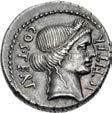


437. The Caesarians. Julius Caesar. January-April 46 BC. AR Denarius (18.5mm, 3.85 g, 12h). Uncertain mint, possibly Utica. Head of Ceres right, wearing wreath of grain / Emblems of the augurate and pontificate: simpulum, aspergillum, guttus, and lituus; D (donativvm = gift) to right. Crawford 467/1; CRI 57; Sydenham 1023; RSC 1a; RBW 1637. Deeply toned, with hints of iridescence, light hairlines under tone. Near EF. ($500)
From the DWBG Collection, purchased from William Warden, 1988.
A parallel issue contains an “M” (mvnvs = largess) in place of the “D.” Both types were struck to pay Caesar’s successful legions after the battle of Thapsus, 6 April 4 BC. Ceres is emblematic of Africa and its grain producing wealth.
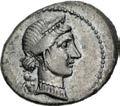
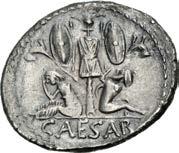

438. The Caesarians. Julius Caesar. Late 46-early 45 BC. AR Denarius (19.5mm, 3.68 g, 7h). Military mint traveling with Caesar in Spain. Diademed head of Venus right, with Cupid over her shoulder / Trophy of Gallic arms, composed of helmet and cuirass, oval shield and carnyx in each hand; two seated captives at base, the one on left a female in attitude of dejection, the one on right a bearded male with hands bound behind him. Crawford 468/1; CRI 58; Sydenham 1014; RSC 13; RBW 1639. Iridescent toning, scratches, some weakness on reverse, scrapes on edge. Good VF. ($500)
From the GTP Collection. Ex Gorny & Mosch 297 (9 October 2023), lot 1493.
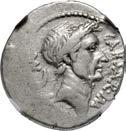
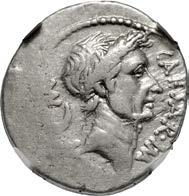

439. The Caesarians. Julius Caesar. January-February 44 BC. AR Denarius (20mm, 4.01 g, 5h). Lifetime issue. Rome mint; L. Aemilius Buca, moneyer. Laureate head right; large crescent dividing p  to left / Venus Victrix standing left, holding Victory and scepter. Crawford 480/4; Alföldi Type IV, 136 (A21/R– [unrecorded rev. die); CRI 102; Sydenham 1060; RSC 22; RBW –. In NGC encapsulation 6842181-113, graded Ch VF, Strike: 3/5, Surface: 4/5. ($2000)
Before 44 BC, Roman coin portraiture had been confined to various deities and historic figures of renown, these usually ancestors of the moneyers appointed each year to strike coins. The very few portraits of living Romans were reserved for coins minted and circulating outside of Italy. But early in 44 BC, the Senate granted Julius Caesar, recently appointed dictator for the fourth time, the honor of having his portrait placed on silver coinage struck in Rome. The break with tradition was sudden, startling and, as it turned out, enduring, for Caesar’s successors (and even his assassins!) soon adopted the practice. Shortly thereafter, Caesar was named Dictator Perpetuo, “Dictator in Perpetuity.” Though Caesar would bear the title for only a month before his assassination on the Ides of March (15 March) 44 BC.

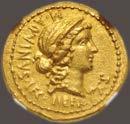
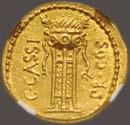
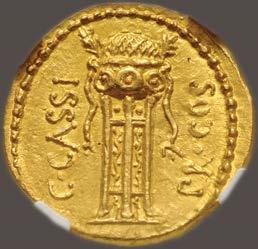
440. The Republicans. C. Cassius Longinus. Spring 42 BC. AV Aureus (19mm, 8.05 g, 12h). Military mint (Smyrna?); M. Aquinus, legatus. Diademed head of Libertas right;  • AœuiNuÍ • Leg • LiBer ëÍ around / Tripod surmounted by the cortina and two laurel-branches; fillet on each side, C • CAÍÍi upward to left, pr • COÍ upward to right. Crawford 498/1; CRI 217; Sydenham 1302; Calicó 63; Biaggi –; RBW 1759. In NGC encapsulation 6831189-002, graded AU, Strike: 4/5, Surface: 2/5, Brushed, edge bend. Very rare variety. ($15,000)
Ex Oslo Myntgalleri 38 (4 May 2024), lot 813; Gorny & Mosch 159 (8 October 2007), lot 345.
Born into a senatorial family but lacking any talent for politics, Gaius Cassius Longinus found soldiering more to his liking and joined the triumvir Crassus on his doomed expedition against the Parthians in 53 BC. Cassius managed to rescue himself and a handful of others from the massacre and escaped to Roman Syria, where he remained for another two years ably defending the province from Parthian attack. He returned to Rome as a war hero in 51 BC and fell in with the Pompeian faction, serving as commander of Pompey’s fleet during the civil war of 49-48 BC. After Pompey’s defeat and death, Cassius accepted a pardon from Caesar and loyally served him for the next four years. Cassius perhaps hoped to attain supreme power once Caesar retired, but it soon became apparent the dictator had no intention of stepping down. Thus, Cassius suborned his close friend Marcus Junius Brutus and several other senators into a conspiracy, and he was one of the first to plunge his dagger into Caesar on the Ides of March, 44 BC. After fleeing Rome with the other conspirators, Cassius returned to Syria and commandeered several legions and a fleet, which he used to attack and pillage the wealthy island of Rhodes in order to procure gold for the approaching civil war. He joined forces with Brutus in 42 BC and the two marched into Thrace to meet the pro-Caesarian legions led by Mark Antony and Octavian. Though their army outnumbered the Caesarians, Cassius and Brutus seemed oddly fatalistic and made a suicide pact should either meet defeat or capture. At the first clash at Philippi in early October, Cassius suffered a loss and rashly fell on his sword before he could be told that Brutus had counterattacked and saved the day. Demoralized by his friend’s death, Brutus was easily defeated three weeks later and took his own life.




441. The Republicans. C. Cassius Longinus. Spring 42 BC. AR Denarius (18mm, 3.47 g, 6h). Military mint, probably at Smyrna; P. Cornelius Lentulus Spinther, legatus. Tripod surmounted by cortina and two laurel branches, fillet hanging on either side / Capis and lituus. Crawford 500/1; CRI 219; Sydenham 1308; RSC 7; RBW 1761. Lustrous, small die breaks on reverse. EF. ($1000)
Ex Peter Bowe Collection; Randy Haviland Collection (Gemini X, 13 January 2013), lot 340, purchased from Harlan J. Berk, April 2007.
The obverse of this denarius closely copies the reverse of the aureus struck by M. Aquinius, and was probably minted on the occasion of the meeting in Smyrna between Cassius and Brutus. The capis and lituus, symbols of the pontificate, recall Spinther’s election to that college in 57 BC.
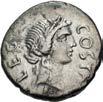

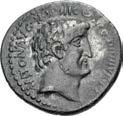
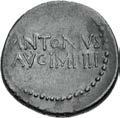
442. The Republicans. Brutus. Late summer-autumn 42 BC. AR Denarius (17mm, 3.79 g, 12h). Military mint traveling with Brutus and Cassius in western Asia Minor or northern Greece; Pedanius Costa, legatus. Laureate head of Apollo right / Trophy composed of cuirass, crested helmet, oval shield with incurved sides, and two crossed spears. Crawford 506/2; CRI 209; Sydenham 1296; RSC 4; RBW 1778. Lightly toned, traces of find patina, minor porosity and scratches. VF. ($500)
From the Doctore Collection.
Brutus is best known for his role in the assassination of Julius Caesar on March 15, 44 BC. This action, while often thought as an attempt to save liberty and justice, was actually meant to try to preserve aristocracy and privilege. Brutus and the other conspirators wanted to restore power to the Senate, comprised of the wealthiest and most powerful of Roman citizens. This brought him in conflict with Julius Caesar, who wanted to break the old power holds in the Senate, populating it with men of lower rank and birth. In a way, Julius Caesar could be seen as promoting a dictatorship with some flavor of a democracy, whereas Brutus and the other conspirators were attempting to save the aristocracy.
After their assassination of Julius Caesar, Brutus and Cassius occupied Rome but had to flee when a funeral oration delivered by Caesar’s protégé, Marc Antony, turned public opinion against them. Brutus and Cassius went their separate ways but met again in early 42 BC in Smyrna, Ionia, where they began preparations for the inevitable conflict that would ensue between them and Marc Antony and Octavian, Caesar’s grandnephew. They began using their armies to conquer cities, for which this series of coins was undoubtedly issued. The title IMP on the reverse shows that Brutus still styled himself the savior of the Republic, as that was a title only the Senate could award.
443. The Triumvirs. Mark Antony. Summer 32 BC. AR Denarius (20mm, 3.54 g, 10h). Athens mint. Bare head right; small p (signature) in hair below ear / ANTONiuÍ/Aug • iÂp • iii in two lines. Crawford 542/2; CRI 347; Sydenham 1209; RSC 2; RBW 1831. Find patina, trace deposits, banker’s mark on obverse. Good VF. Good portrait. ($500)
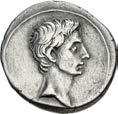
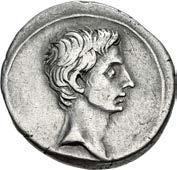

444. The Triumvirs. Octavian. Autumn 32-summer 31 BC. AR Denarius (19mm, 3.53 g, 9h). Uncertain mint in Italy (Rome?). Bare head right / Venus standing right, seen from back, holding transverse scepter and helmet, resting on column to left; to left, shield with star motif set on ground, leaning against column. CRI 395; RIC I 250a; RSC 62. Lightly toned, light scratches. VF. ($1000)
Ex Classical Numismatic Group Electronic Auction 544 (16 August 2023), lot 510.
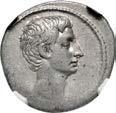


445. The Triumvirs. Octavian. Autumn 32-summer 31 BC. AR Denarius (19mm, 3.45 g, 3h). Uncertain mint in Italy (Rome?). Bare head right / Pax standing left, holding olive branch and cornucopia. CRI 399; RIC I 252; RSC 69. In NGC encapsulation 4883649-012, graded XF, Strike: 4/5, Surface: 3/5, graffito. ($750)
Ex Heritage 3073 (25 April 2019), lot 32229.

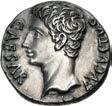


446. Augustus. 27 BC-AD 14. AR Denarius (18mm, 3.83 g, 6h). Uncertain Spanish mint (Colonia Patricia?). Struck 19-18 BC. Bare head left / OB/ CIVIS/ SERVATOS in three lines within oak wreath with wreath ties drawn upward. RIC I 77b; RSC 209a. Deep iridescent cabinet tone, hairlines, minor deposits. EF. High-relief portrait. Rare with head left. ($1000)
From the Doctore Collection.

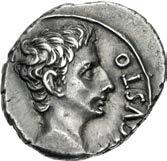

447. Augustus. 27 BC-AD 14. AR Denarius (18mm, 3.94 g, 7h). Uncertain Spanish mint (Colonia Patricia?). Struck circa July 18-17/16 BC. Bare head right / Mars standing left, holding vexillum and parazonium. RIC I 150a; RSC 325. Superb cabinet tone, a few minor marks, struck off center on obverse. Good VF. ($500)
Ex Classical Numismatic Group 78 (14 May 2008), lot 1680; Schweizerischer Bankverein 33 (20 September 1993), lot 627.


448. Augustus. 27 BC-AD 14. Æ Sestertius (32.5mm, 25.73 g, 6h). Lugdunum (Lyon) mint. Struck AD 10-14. Laureate head right / The Altar of Lugdunum: altar enclosure with panels decorated with corona civica flanked by figures holding laurel branches; decoration along roofline; altar flanked by columns surmounted by statues of Victory standing vis-à-vis, each holding palm frond in left hand over left shoulder and wreath in right hand. RIC I 231a; Lyon 95; Elkins, Monuments, Figure 66. Dark green and brown patina, some porosity, smoothed, holed and plugged. VF. Rare. ($750)
Ex John Wright Collection, purchased from Jonathan Kern, 1999.
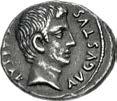
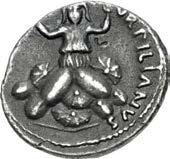

449. Augustus. 27 BC-AD 14. AR Denarius (19mm, 3.59 g, 12h). Rome mint; P. Petronius Turpilianus, moneyer. Struck 19-18 BC. Bare head right / Tarpeia standing facing, raising both hands, buried to her waist under shields; broken spear below. RIC I 299; RSC 494. Attractive, old cabinet toning, slightly off center, minor roughness, small banker’s mark on reverse. VF. Excellent portrait. ($500)
Ex Münzhandlung Basel 6 (18 March 1936), lot 1538.
In the story of the abduction of the Sabine women, Tarpeia was a Vestal Virgin who betrayed the city of Rome to the Sabines when they were attempting to rescue their wives and daughters. Her price for betraying Rome was what the Sabine soldiers wore on their left arms, meaning their gold bracelets, but the Sabines were so offended by Tarpeia’s reprehensible greed and treason that they took her request literally. She met her death under the crushing weight of the soldiers’ shields.

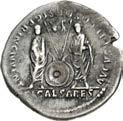
450. Augustus. 27 BC-AD 14. AR Denarius (20.5mm, 3.18 g, 10h). Restitution issue. Rome mint. Struck under Hadrian, circa AD 117-138. Laureate head right / Gaius and Lucius Caesar standing facing, each resting hand shield set on ground; behind the shields, two crossed spears; above, on left, a simpulum left, and on right, lituus right. Woytek & Blet-Lemarquand 12 (dies III/4); cf. RIC I 208; cf. Lyon 82 var. (simpulum and lituus turned inward). Toned, deposits, hairline flan crack, edge split. VF. Very rare. ($1000)
The style and fabric of this coin suggest that it belongs to an anonymous restitution issue, likely of Hadrian. The restitution issues of Trajan are well known since the coins are marked with Trajanic legends. The fact that this coin retains its original legend without any mention of the issuer suggests that it is not part of the great restitution series of Trajan, but part of a later anonymous issue. Apart from style, on all known specimens the lituus has a split base and is turned to the right, and the simpulum is large, rather bulbous and turned to the left, features not seen on the issues of Augustus.



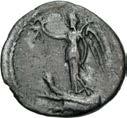
From the Doctore Collection.



452. Tiberius. As Caesar, AD 4-14. Æ Sestertius (33mm, 24.70 g, 11h). Lugdunum (Lyon) mint. Struck under Augustus, AD 13-14. Laureate head of Tiberius right / The Altar of Lugdunum: altar enclosure with panels decorated with corona civica flanked by figures holding laurel branches; decoration along roofline; altar flanked by columns surmounted by statues of Victory standing vis-à-vis, each holding palm frond in left hand over left shoulder and wreath in right hand. RIC I 248a (Augustus); Lyon 111 (Augustus); cf. Elkins, Monuments, Figure 66 (for rev. type). Brown patina, areas of roughness. VF. Rare. ($750)
Ex John Wright Collection, purchased from Tom Cederlind, January 1999.



453. Gaius (Caligula), with Divus Augustus. AD 37-41. AR Denarius (18.5mm, 3.62 g, 6h). Lugdunum (Lyon) mint. 1st emission, after 18 March AD 37. Bare head of Gaius (Caligula) right / Radiate head of Divus Augustus right [between two stars]. RIC I 2; Lyon 157/19 (D33/R33); RSC 11 (Caligula and Augustus). Toned, porosity, scratches, hairlines. Fine. ($1000)
Ex Triton XXVII, Session 6 (18 January 2024), lot 6033; Classical Numismatic Group Electronic Auction 92 (23 June 2004), lot 103.
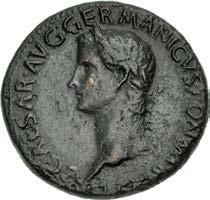

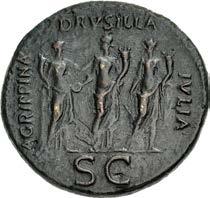
454. Gaius (Caligula). AD 37-41. Æ Sestertius (33.5mm, 22.64 g, 6h). Rome mint. Struck AD 37-38. Laureate head left / Gaius’ three sisters standing facing: Agrippina (as Securitas), head right, holding cornucopia and leaning on column, placing hand on shoulder of Drusilla (as Concordia), head left, holding patera and cornucopia; on right, Julia (as Fortuna), head left, holding rudder and cornucopia. RIC I 33. Brown surfaces, smoothing. VF. ($1000)
On this popular and beautiful reverse, the three sisters of Gaius “Caligula”–Drusilla, Julia Livilla, and Agrippina the Younger–are honored and portrayed as goddesses. All three were deeply involved in deadly Julio-Claudian politics. Caligula’s hostile biographers depict him as excessively and unnaturally fond of his sisters, Drusilla in particular, whom he named as his primary heir in AD 37, while he was suffering from a near-fatal illness. Drusilla herself died of a virulent plague in AD 38 at the age of 22, plunging Caligula into violent grief. He gave her a state funeral befitting an Augusta and ordered the Senate to deify her. In his depression, Caligula’s affections for his remaining sisters cooled and they took to plotting against him, for which he ultimately banished them to the Pontian Islands. After Caligula’s assassination in AD 41, the new emperor, his uncle Claudius, rescinded his nieces’ exile. Julia Livilla soon fell afoul of Claudius’ wife Messalina, who had her imprisoned and starved to death in AD 42. Messalina herself overreached and was executed in AD 48. The following year, Claudius married his surviving niece Agrippina and she quickly became the most powerful woman the Roman Empire had yet seen.
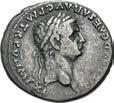

455. Claudius. AD 41-54. AR Denarius (18mm, 3.48 g, 12h). Rome mint. Struck AD 46-47. Laureate head right / S P Q R/ P P/ OB C S in three lines within oak wreath. RIC I 41; von Kaenel Type 26, – (V–/R494 [unlisted obv. die]); RSC 87. Toned, slightly granular surfaces. VF. ($750)

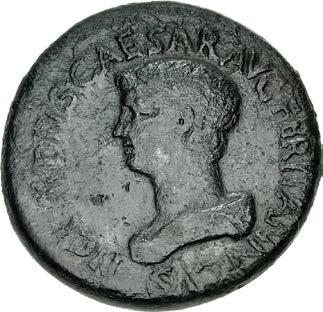

456. Britannicus. AD 41-55. Æ Sestertius (34mm, 26.07 g, 6h). Uncertain Balkan/Thracian mint. Struck under Claudius, AD 50-54. Bareheaded and draped bust left / Mars advancing left, holding spear and shield. RIC I p. 130 note; von Kaenel, Thrakien Type B, B4-8 (same obv. die). Dark green-brown patina, smoothing. Good Fine. Rare. ($3000)
Ex John Wright Collection, purchased from Herakles Numismatics, January 2009.
The attribution of Britannicus’ sestertii has been a matter of some controversy. In earlier scholarship, the issue had been attributed to Rome around the end of Claudius’ reign when Britannicus adopted the toga virilis. Mattingly demonstrated that such an attribution was problematic, as the Roman mint was not producing aes at that time, and he assigned the type instead to the early years of Titus, when many restoration and commemorative issues were being struck. More recently, substantial numbers of Latin coins (sestertii and dupondii) in the name of Britannicus, Agrippina Jr., Nero Caesar, and Nero Augustus have been found localized in the Balkan region, and von Kaenel argued for a Thracian origin for the series. Von Kaenel’s analysis must be correct, for the style and fabric of the coins, as well as the find spots, indicate a Thracian mint, and there is nothing in the types or legends to suggest that any of these coins are posthumous. These local issues would have been struck for use by the legions servicing the border.


457. Nero. As Caesar, AD 50-54. Æ Sestertius (34.5mm, 20.66 g, 6h). Uncertain Balkan/Thracian mint. Struck under Claudius, AD 51-54. Bareheaded and draped bust right / EQVESTER/ OR DO/ PRINCIPI/ IVVENT in four lines on shield with vertical spear behind. RIC I 108 (Claudius); von Kaenel, Thrakien, Type A, N3 and Tafel 25, 37. Green-brown patina, smoothed. Good Fine. Rare. ($1000)
Ex John Wright Collection; Gemini V (6 January 2009), lot 800.


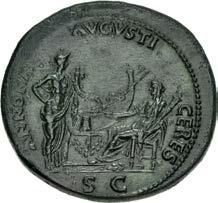
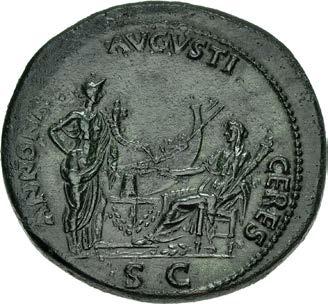
458. Nero. AD 54-68. Æ Sestertius (35mm, 26.74 g, 6h). Lugdunum (Lyon) mint. Struck circa AD 64. Laureate bust right, wearing aegis, globe at point of bust / Annona standing right, holding cornucopia, facing Ceres seated left, holding grain ears and torch; between them, modius on garlanded altar, ship’s stern in background. RIC I 372; WCN 402; Lyon 44 (unlisted dies). Glossy dark green patina. EF. ($2000)
From the Plus 20 Collection. Ex Wayne Scheible Collection (Triton XXVII, 9 January 2024), lot 688; Berk BBS 94 (16 January 1997), lot 712.
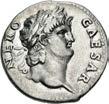

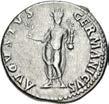
459. Nero. AD 54-68. AR Denarius (17.5mm, 3.31 g, 6h). Rome mint. Struck circa AD 64-65. Laureate head right / Nero standing facing, radiate and togate, holding branch and Victory on globe. RIC I 47; RSC 45. Lightly toned, minor marks. Good VF. Bold portrait. ($750)
Ex Heritage 232316 (20 April 2023), lot 63131.


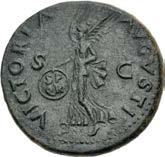
460. Vitellius. AD 69. Æ As (27mm, 10.72 g, 6h). Spanish (Tarraco?) mint. Struck circa January-June. Laureate head left, globe at point of neck / Victory advancing left, holding shield inscribed SP/QR in two lines. RIC I 46; CSB 53. Green-brown surfaces, minor roughness, light smoothing. Near EF. ($500)
Ex Stack’s (11 January 2010), lot 367.
The last of Nero’s immediate three successors, Vitellius was declared emperor by his troops while campaigning in lower Germania in January, AD 69. His reign was short lived however, as Vespasian was hailed emperor in Judaea only a few months later. Vitellius’ troops gave little resistance as Vespasian entered Italy. As Vespasian’s army approached Rome, Vitellius attempted to abdicate but was prevented by the Praetorians and his backers, who rioted and burned down the Temple of Jupiter. Vitellius was ultimately dragged out of his hiding place and brutally murdered, his body thrown down the Gemonian Stairs.



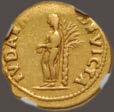

461. Vespasian. AD 69-79. AV Aureus (18mm, 7.20 g, 7h). “Judaea Devicta” commemorative. Lugdunum (Lyon) mint. Struck AD 71. IMP CAESAR VESPASIANVS AVG TR P, laureate head right / IVDAEA DEVICTA, Judaea, draped, standing left, head bowed, hands tied in front of her; to right, palm tree. RIC II.1 1119 (R3); Lyon –; Hendin 6502; Calicó 647; BMCRE 388 note; BN –; Biaggi 326. In NGC encapsulation 6555639-002, graded VF, Strike: 4/5, Surface: 4/5. Extremely rare, only the second known example. All references cite the same coin originally in the V.J.E. Ryan Collection. ($50,000)
Ex Pinewood Collection.
This extremely rare and desirable issue is known from only two examples:
1) Künker 280 (26 September 2016), lot 541 (hammer €300,000); Leo Biaggi de Blasys Collection; V.J.E. Ryan Collection (Glendining, 20 February 1951), lot 1684.
2) The present example.

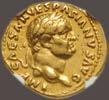
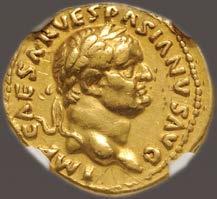


462. Vespasian. AD 69-79. AV Aureus (19mm, 7.33 g, 7h). “Judaea Capta” commemorative. Rome mint. Struck circa 21 December AD 69-early 70. IMP CAESAR VESPASIANVS AVG, laureate head right / IVDAEA in exergue, trophy; to right, Judaea, veiled and draped, seated right on ground in attitude of mourning, knees drawn up, head resting on left hand, which is propped on knees, right arm on lap. RIC II.1 1; Hendin 6492; Calicó 643; BMCRE 31–4; BN 20–2; Biaggi 324. In NGC encapsulation 5770518-001, graded XF, Strike: 5/5, Surface: 2/5, graffiti, marks. ($20,000)
The main Judaea Capta coinage was a series of imperial issues struck in gold, silver, and bronze, and provincial issues struck in silver and bronze, to celebrate the Roman defeat of Judaea, the capture of Jerusalem, and the destruction of the Jewish Second Temple during the First Jewish War (66-73 CE). Generally, the reverse of this coinage shows a Jewish female seated in an attitude of mourning beneath a palm tree. Sometimes a bound male captive, or the figure of the victorious emperor or Victory, is found standing on the other side amid weapons, shields, and helmets. While some gold and silver coins bear no legend on the reverse, most issues are inscribed IVDAEA CAPTA, IVDAEA DEVICTA, or simply IVDAEA. The imperial coins were struck for only Vespasian and Titus. Provincial drachms were minted in Asia Minor for Titus (who oversaw the capture of Jerusalem and the destruction of the Temple). The provincial bronze coinage for Titus and Domitian (who did not participate in any of the actions, but was included by familial association) was struck in Judaea by the Roman administration at Caesarea Maritima and even by the Romanized Jewish ruler, Agrippa II, who was a friend of Titus and his supporter during the war.
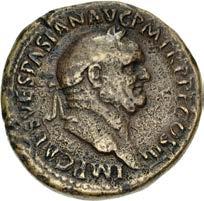
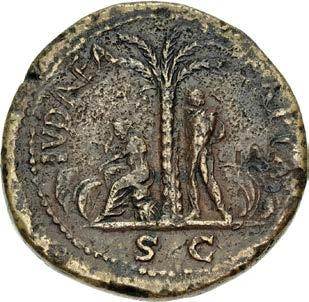
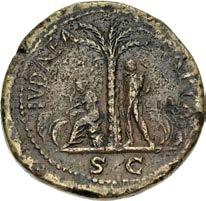
463. Vespasian. AD 69-79. Æ Sestertius (32.5mm, 25.31 g, 6h). “Judaea Capta” commemorative. Rome mint. Struck AD 71. Laureate head right / IVDAEA CAPTA, S C in exergue, palm tree; to left, Judaea seated left on cuirass in attitude of mourning; to right, male captive standing left; both figures surrounded by arms. RIC II.1 165; Hendin 6532. Brown surfaces, moderate porosity, marks. VF. ($1000)
Property from an English Private Collection.


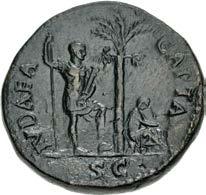
464. Vespasian. AD 69-79. Æ Sestertius (33mm, 24.88 g, 6h). “Judaea Capta” commemorative. Rome mint. Struck AD 71. Laureate head right / IVDAEA CAPTA, S C in exergue, palm tree; to left, Vespasian standing right, with left foot on helmet, holding spear and parazonium; to right, Judaea seated right on cuirass, in attitude of mourning. RIC II.1 167; Hendin 6534. Brown patina, some pitting, minor smoothing. VF. ($1000)
Property from an English Private Collection.
“Judaea



465. Vespasian. AD 69-79. Æ Sestertius (34mm, 26.42 g, 6h). “Judaea Capta” commemorative. Rome mint. Struck AD 71. Laureate bust right, slight drapery / Victory standing right, left foot on helmet, inscribing OB/ CIV/ SE in three lines on shield set on palm tree; on right, Judaea seated right, in attitude of mourning. RIC II.1 222 (R2); Hendin 6538a. Brown patina, area of roughness on obverse, doubling and scratches on reverse, edge marks. Good VF. Very rare with slight drapery. ($2000)
Ex John Wright Collection, purchased from Ponterio Associates, August 2007; Goldberg 41 (27 May 2007), lot 2804; Marian A. Sinton Collection (Triton III, 30 November 1999), lot 1036.
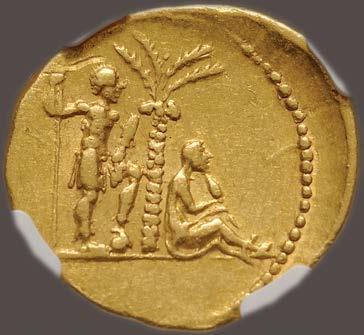

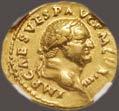
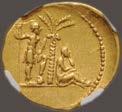

466. Vespasian. AD 69-79. AV Aureus (19.5mm, 7.28 g, 5h). “Judaea Capta” commemorative. Rome mint. Struck AD 72-73. IMP CAES VESP AVG P M COS IIII, laureate head right / Palm tree; to left, Vespasian standing right, with left foot on helmet, holding spear in right hand and parazonium in left; to right, Judaea seated right in attitude of mourning, head resting on left hand, left arm propped on knee. RIC II.1 363 (same rev. die as illustration); Hendin 6494; Calicó 587 (same rev. die as illustration); BMCRE 78 (same rev. die); BN 64; Biaggi 348 (same rev. die); Mazzini 644 (same rev. die). In NGC encapsulation 6555639-003, graded XF, Strike: 4/5, Surface: 3/5, lt. graffito. The finest example of the type in CoinArchives. ($30,000)
Ex Pinewood Collection.
The Roman Empire used coins to convey powerful messages. The anepigraphic reverse on this coin depicts Judaea in captivity. “So fell Jerusalem in the second year of Vespasian’s reign, on the 8th September, captured five times before and now for the second time laid utterly waste.... There was no one left for the soldiers to kill or plunder” (Josephus, The Jewish War, 21, 22). “And her gates shall lament and mourn; ravaged, she shall sit upon the ground” (Isaiah 3:26).

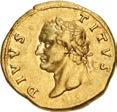


467. Divus Titus. Died AD 81. AV Aureus (19mm, 7.37 g, 6h). Restitution issue. Rome mint. Struck under Trajan, circa AD 112/113. DIVVS • TITVS, laureate head left / IMP CAES TRAIAN • AVG GER • DAC • P • P • REST, pulvinar (throne) of Jupiter and Juno: square seat, draped and surmounted by horizontal winged thunderbolt. RIC II 833 (Trajan); Woytek 8701 (same dies); Komnick Type 70.0, 3 (V2/R2); Calicó 802; BMCRE 705 (Trajan; same dies); BN 484/486 (Trajan; for obv./rev. dies); Biaggi 392; Jameson 75 (same rev. die); Mazzini 403. Lustrous. Good VF. Very rare. ($10,000)
Ex Roma XXII (7 October 2021), lot 719.
The primary purpose of restored coins was to provide substitutes in circulation for coin types that had become familiar, but that the emperor was calling in, melting down, and restriking, because the originals were worn out and sometimes also because they contained more precious metal than current coins, so the emperor could make a profit. When selecting the types for the restored coins, however, a secondary purpose kicked in: to present a full picture of earlier Roman coinage, and to honor worthy earlier emperors, even if the earlier coins in question were not actually being called in and restruck, either because they were so old that they were no longer in circulation, or because they were so recent that they were still in excellent condition and contained no more bullion than the mint’s current production. This secondary purpose explains Trajan’s restoration of both a Republican didrachm, though such didrachms were certainly no longer in circulation, and of aurei of Nerva and Divus Nerva, though Nerva’s aurei were only a decade old so didn’t need restriking because of wear. It explains why Trajan Decius’ restored antoniniani included coins for Divus Augustus, whose original denarii had long since disappeared from circulation. And finally it explains why Titus’ restored bronzes included coins for Galba, whose original bronzes were also only a dozen years old.
As Mattingly wrote regarding Titus’ selection of emperors for restoration: “The list of persons whose coins were to be restored was evidently drawn up with deliberate care. Tiberius, Claudius, and Galba were included, Caligula, Nero, Otho, and Vitellius omitted. The list is something like a roll of honour of the early Empire, preserving all memories that deserved to be remembered” (BMC II, p. lxxviii).
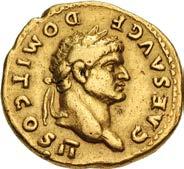
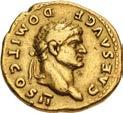
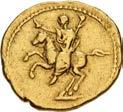

468. Domitian. As Caesar, AD 69-81. AV Aureus (20mm, 7.28 g, 6h). Rome mint. Struck under Vespasian, AD 73. Laureate head right / Domitian on horse rearing left, hand raised and holding scepter. RIC II.1 540 (Vespasian); Calicó 811a. Marks, test cut on edge, edge marks, possibly ex jewelry. VF. ($2000)
Ex Bruce R. Brace Collection (Classical Numismatic Group 90, 23 May 2012), lot 1509; purchased from B.A. Seaby, February 1958.


469. Domitian. AD 81-96. Æ Sestertius (33.5mm, 24.44 g, 6h). Rome mint. Struck AD 85. Laureate bust right, wearing aegis / Domitian standing right, clasping hands over altar with officer standing left; to right, soldier standing left. RIC II.1 359. Dark green surfaces, smoothing, light roughness. Good VF. ($750)
From the Plus 20 Collection. Ex Wayne Scheible Collection (Triton XXVII, Session 6, 18 January 2024), lot 6105; Cederlind 125 (1 July 2002), lot 167.

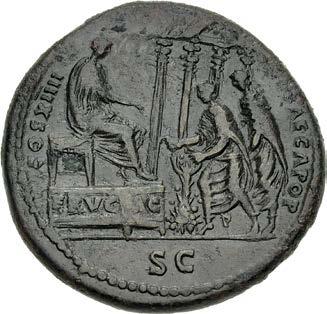

470. Domitian. AD 81-96. Æ Sestertius (34.5mm, 25.37 g, 6h). Ludi Saeculares (Secular Games) issue. Rome mint. Struck 14 September-31 December AD 88. Laureate head right / Domitian seated right on platform inscribed FRVG AC, approached by two citizens with open sacks; in background, tetrastyle temple. RIC II.1 606; Elkins, Monuments Figure 101. Brown patina. Good VF. ($1000)
Honoring the original system for the celebration of the games, Domitian held the Ludi Saeculares in October AD 88, coming close to the traditional 110-year standard.




471. Domitia. Augusta, AD 82-96. AR Denarius (19.5mm, 3.23 g, 5h). Rome mint. Struck under Domitian, AD 82-83. Draped bust right / Peacock standing right. RIC II.1 151 (Domitian); RSC 2. Toned, rough surfaces, flan crack. Good VF. ($1000)
Ex Künker 377 (20 October 2022), lot 5783; J. Hirsch XXXIV (5 May 1914), lot 1045; Joachim Scheyer Collection (A. Hess 147, 1 December 1913), lot 501; J. Schulman [99] (19 December 1910), lot 544.



472. Nerva. AD 96-98. Æ Sestertius (33mm, 25.40 g, 6h). Rome mint. Struck AD 97. Laureate head right / Libertas standing left, holding pileus and vindicta. RIC II 100; Banti 34. Attractive green patina. Good VF. ($1500)
Ex John Wright Collection, purchased from Nilus Coins, January 2012.
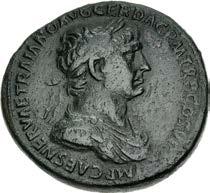
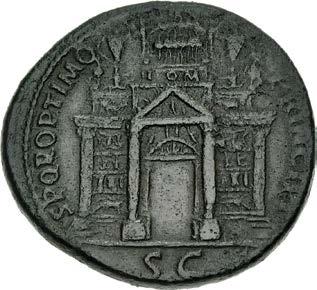
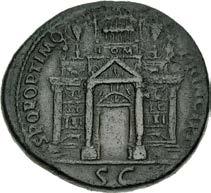
473. Trajan. AD 98-117. Æ Sestertius (34mm, 23.45 g, 6h). Rome mint. Struck circa AD 103-104. Laureate, draped, and cuirassed bust right / Monumental votive arch/gateway; on the sides, from top to bottom, are the following reliefs: biga driven by Victory, aegis, Gigantomachy, arms, and she-wolf suckling twins; the second tier surmounted by a trophy and giant to either side, gateway spandrels with Victories, pediment with Jupiter between two seated figures, panel above pediment inscribed I O M (= Iovi Optimo Maximo), the whole surmounted by six-horse chariot driven by Jupiter and flanked by Victories. RIC II 573; Woytek 187h (this coin, cited and illustrated); Banti 282 (this coin, illustrated); cf. Elkins, Monuments, Figure 113 (for rev. type). Green patina, areas of slight roughness. VF. ($4000)
Ex Triton VII (13 January 2004), lot 913; Sternberg XI (20 November 1981), lot 627.
Elkins agrees with Kleiner that the arch depicted on this coin is “an otherwise unattested monumental archway constructed by Trajan in the Area Capitolina.” The inclusion of the I O M inscription shows that the monument was likely dedicated to Jupiter Optimus Maximus, because according to Pliny the Younger (Panegyricus), the god himself came to the Area Capitolina and openly announced to the Romans that Trajan was destined to be the next emperor.



474. Trajan. AD 98-117. Æ Sestertius (33mm, 25.30 g, 6h). Rome mint. Struck circa mid AD 107-110. Laureate bust right, slight drapery / Arched, single-span bridge with seven posts across river; single-bay arches at either end; boat sailing left in river below. RIC II 569; Woytek 314bD; Banti 262; cf. Elkins, Monuments, Figure 117 (for rev. type). Green-brown surfaces, marks, smoothing, minor chipping along edge, tooling. VF. ($750)
From the DWBG Collection.
The bridge on the reverse of this coin is generally thought to be that constructed across the Danube by Trajan’s architect, Apollodorus of Damascus, in AD 104. There is good circumstantial evidence for this. The date range for this coin’s issue is closely contemporary with the date of the bridge’s construction and would fit in well programmatically with those war-related issues of the same time frame.
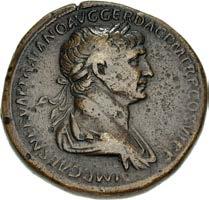

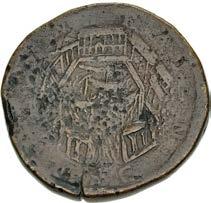
475. Trajan. AD 98-117. Æ Sestertius (33mm, 27.01 g, 6h). Rome mint. Struck circa AD 112-summer 114. Laureate and draped bust right / [PORTV]M TRA[IA]NI, S C in exergue, basin of Trajan’s harbor, surrounded by warehouses and ships in center. RIC II 632; Morello – (O–/R6 [unlisted obv. die]); Woytek 470v; Banti 84/A; cf. Elkins, Monuments, Figure 124 (for rev. type). Brown surfaces, moderate porosity. Near VF. A clear view of the port. ($1000)
From the Doctore Collection.
Documentation in ancient sources is plentiful concerning the Port of Trajan (cf. Pliny, Ep. 6.31, letter to Cornelianus); however, the exact location of the port is uncertain. In Untersuchungen zur Römischen Reichsprägung des Zweiten Jahrhunderts, teil 1, Die Reichsprägung zur Zeit des Traian, pp. 212-3, Strack claims that it is the harbor of Trajan at Ostia as opposed to that at Centumcellae. Mattingly, in the introduction to BMCRE, Vol. II, p. civ, questions Strack’s conclusion. Perhaps future archaeological fieldwork will determine the precise location of the port depicted on this issue.

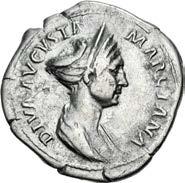

476. Diva Marciana. Died AD 112/4. AR Denarius (20mm, 3.12 g, 6h). Consecration issue. Rome mint. Struck under Trajan, September AD 112-117. Draped bust right, wearing stephane upright on head, in front of which her hair is built up in three tiers, the hair is massed at top and back of head in a coil / Carpentum drawn left by two mules, the top is ornamented with fleurettes, the front with figures, the side with figures and two wreaths. RIC II 746 (Trajan); Woytek 7232 (same dies); RSC 10. Minor flan flaws. VF. Rare. ($1000)
There is very little in the historical record of Ulpia Marciana, Trajan’s sister. Unlike many other imperial relatives during the Empire, she is reputed to have been of very high character. During Trajan’s reign, Marciana lived as a widow and did not take another husband. She was a close friend of Trajan’s wife, Plotina, and both jointly accepted the title of Augusta in AD 105 (which they had both rejected in AD 98). The date of her death is debatable, and although some scholars believe she died in the year she was hailed Augusta, her death is commonly placed in AD 112 or 114.
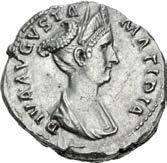


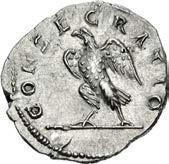
477. Diva Matidia. Died AD 119. AR Denarius (18mm, 3.36 g, 6h). Consecration issue. Rome mint. Struck under Hadrian, AD 119-120 (and later). Draped bust right, wearing hair coiled and piled on top of head above double stephane / Eagle standing left on scepter. RIC II.3 2462; RSC 6. Small flan flaw on obverse. Near EF. Rare. Excellent portrait. ($2000)
Matidia, daughter of Marciana and niece of Trajan, proved to be the lynchpin that held together the imperial succession for the next three generations. Matidia was married three times in succession to important Roman Senators, all of whom predeceased her. Vibia Sabina, her daughter by her first husband, was married to the future emperor Hadrian. By her third husband, she bore Rupilia Faustina, who went on to become mother to Faustina the Elder, future wife of Antoninus Pius; she was also the grandmother of Marcus Aurelius and also his wife Faustina the Younger, and thus great-grandmother (on both sides) to Commodus. Matidia died in AD 119; her son-in-law Hadrian delivered the funeral oration and arranged for her deification.
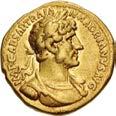


478. Hadrian. AD 117-138. AV Aureus (19mm, 7.41 g, 6h). Rome mint. Struck AD 119-circa mid 120. Laureate and cuirassed bust right, wearing balteus / Bonus Eventus standing left, holding patera and grain ears. RIC II.3 200; Calicó 1328a. Some luster in protected areas, light scratches. VF. ($2000)
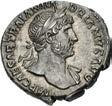
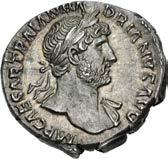

479. Hadrian. AD 117-138. AR Denarius (18mm, 3.48 g, 7h). Rome mint. Struck AD 119-circa mid 120. Laureate bust with bare chest right, slight drapery / Felicitas standing left, holding caduceus and cornucopia. RIC II.3 221; RSC 1143. Attractive iridescent toning, underlying luster. Superb EF. Well struck with fresh dies. ($500)
Ex InAsta 100 (24 June 2022), lot 227.

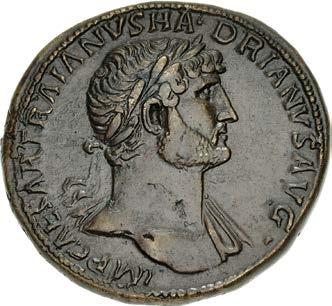
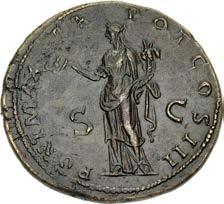
480. Hadrian. AD 117-138. Æ Sestertius (35.5mm, 27.27 g, 6h). Rome mint. Struck AD 119-circa mid 120. Laureate bust with bare chest right, slight drapery / Felicitas standing left, holding caduceus and cornucopia. RIC II.3 244; Banti 610 var. (breaks in legends). Brown patina, areas of smoothing, minor pitting, slight doubling on reverse. Good VF. Struck on a broad, round flan. ($500)
Ex John Wright Collection, purchased from John Twente, October 1993; H. Otto Collection (A. Hess 207, 1 December 1931), lot 1089.



481. Hadrian. AD 117-138. Æ Sestertius (36mm, 29.87 g, 6h). Rome mint. Struck late AD 121-123. Laureate, draped, and cuirassed bust right / Minerva standing left, dropping incense on candelabrum to left, and holding vertical spear; a round shield, on which a snake coils, rests against her left side. RIC II.3 668; Banti 583 var. (obv. legend break). Brown patina with some verdigris, flan crack, minor smoothing. Good VF. Wonderful portrait. ($1500)
From the Plus 20 Collection. Ex Wayne Scheible Collection (Triton XXVII, 9 January 2024), lot 754, purchased from Münzen und Medallien AG; M. L. Vierordt Collection (J. Schulman [139], 5 March 1923), lot 1351.
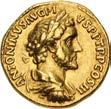


482. Antoninus Pius. AD 138-161. AV Aureus (18mm, 6.78 g, 6h). Rome mint. Struck circa AD 141-143. Laureate, draped and cuirassed bust right / Jupiter, naked, standing facing, holding vertical scepter and thunderbolt. RIC III 72c; Calicó 1552 (same dies as illustration); Biaggi –. Small lamination flaw on reverse. Good VF. Very rare. ($2000)


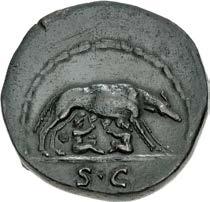
483. Antoninus Pius. AD 138-161. Æ Sestertius (33.5mm, 28.89 g, 6h). Rome mint. Struck circa AD 141-143. Laureate head right / She-wolf standing right, suckling the twins Remus and Romulus in a cave. RIC III 631; Banti 381 var. (break in obv. legend). Dark green-brown patina, areas of minor smoothing, scratches, area of roughness on obverse. VF. ($500)
Ex Walter Niggeler Collection (Part 3, Bank Leu/Münzen und Medaillen AG, 2 November 1967), lot 1300.


484. Antoninus Pius. AD 138-161. Æ Sestertius (31mm, 21.93 g, 12h). Rome mint. Struck AD 157-159. Laureate head right / Antoninus Pius, veiled and togate, standing left, holding volumen and dropping incense onto lighted tripod to left. RIC III 794; Banti 528. Brown surfaces. Near EF. ($500)
From the Plus 20 Collection. Ex Artemide LIX (6 May 2023), lot 600; Semenzato (29 November 1980), lot 325.

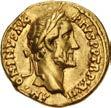
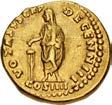

485. Antoninus Pius. AD 138-161. AV Aureus (19mm, 7.13 g, 6h). Rome mint. Struck AD 158-159. Laureate head right / Antoninus Pius, veiled and togate, standing left, holding volumen and dropping incense onto lighted tripod to left. RIC III 294ad; Calicó 1714. A few die breaks, traces of deposits. Good VF. ($2000)
Ex Numismatica Ars Classica Spring Sale (25 May 2020), lot 1058.

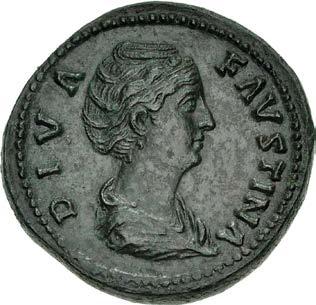

486. Diva Faustina Senior Died AD 140/1. Æ Sestertius (34.5mm, 26.19 g, 11h). Rome mint. Struck under Antoninus Pius, circa AD 150-late 150s. Draped bust right, wearing hair bound in pearls on top of her head / Aeternitas seated left, holding phoenix on globe and scepter. RIC III 1103A (Pius); Banti 7 var. (arrangement of obv. legend). Dark brown and green patina, smoothing in fields. Near EF. ($500)
From the Plus 20 Collection. Ex Classical Numismatic Group 124 (19 September 2023), lot 654; Triton IV (5 December 2000), lot 570; Leu 20 (25 April 1978), lot 327.
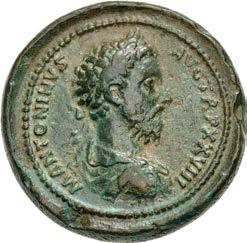


487. Marcus Aurelius. AD 161-180. Æ Medallion (39.5mm, 54.03 g, 12h). Rome mint. Struck AD 173. M ANTONINVS AVG TRP XXVIII, laureate, draped, and cuirassed bust right / IMP VI COS III above, ADVENTVS AVG in exergue, Marcus Aurelius, in military dress, holding transverse spear in right hand and trophy in left hand over left shoulder, advancing right toward a triumphal arch which is surmounted by a quadriga of elephants; in front of him walk two soldiers side by side, the one in the foreground carrying an aquila, the one in the background a signum; behind him is Victory placing a wreath upon his head; behind Victory, a lighted altar; in the background, the Temple of Jupiter Capitolinus and the Parthian Arch of Nero to right. Gnecchi II, p. 27, 3 (same obv. die as pl. 60, 2 / same rev. die as pl. 59, 5); cf. MIR 18, 1054 (for rev. type); Banti 7 (illustrated with a line drawing). Green and tan brown patina, minor roughness on obverse, area of roughness along edge on reverse. VF. Extremely rare. Perhaps the second known after the example reportedly in Paris. Reverse die executed by a skilled artist. ($3000)
Sold with proceeds to benefit the American Numismatic Society.
The reverse of this medallion may commemorate a brief visit of the emperor to Rome, immediately before the opening of the winter campaign so strikingly terminated by the memorable battle fought on the ice of the frozen Danube in December 173, during the war against the Quadi (G. Macdonald, NC 1906, p. 98) and (Dio Cassius, lxxi, 7). Regardless of the specific event, this ADVENTVS reverse certainly commemorates the return of Aurelius from his long Germanic campaigns.
Vaillant in his 1695 Selectiora Numismata in Æ R E Maximi Moduli E Museo detailed that on this medallion Marcus Aurelius passes by an altar before the Temple of Jupiter Capitolinus with the arch that the Senate commissioned for Nero’s Parthian ‘victory’ to the right. The arch in the background on this medallion is consequently the same as that on Nero’s Sestertii (RIC I 143-150) but seen from a different angle. Given that the arch did not survive to the present day, this medallion features another rare look at this impressive Roman architectural feature in addition to the arch in the foreground and the view of the Temple in the background.



488. Marcus Aurelius & Lucius Verus. AD 161-169. Æ Medallion (40mm, 51.08 g, 12h). Rome mint. Struck AD 161-165. IMP ANTONINVS AVG COS III IMP VERVS AVG COS II, confronted bareheaded busts of Marcus Aurelius right and Lucius Verus left, both with slight drapery / Jupiter, half-nude and draped to the waist, seated facing on a high-backed throne, holding a thunderbolt in his right hand and a long scepter in his left; on his left, Juno seated facing holding short scepter with her left hand and offering a patera to Jupiter with her right; on his right, Minerva seated facing, holding scepter with her left hand and raising her right to adjust her helmet. Gnecchi II 7, pl. 71, 5; MIR 18, 1009-2/12-22; Banti 7. In NGC encapsulation 6708806-009, graded Ch VF, Strike: 5/5, Surface: 2/5, Fine Style, smoothing. Extremely rare. An impressive medallion showing the Capitoline Triad. ($7500)
Ex Triton XXVI (10 January 2023), lot 774; Nomos 23 (30 November 2021), lot 224.
The Capitoline Triad was a group of three deities; namely, Jupiter, Juno, and Minerva. They were worshiped within the Capitolium, the temple on the Capitoline Hill that was devoted to this sacred Triad. Though appearing together infrequently upon Roman coinage, the Triad remained an important part the Roman pantheon and was often celebrated on medallions such as this one, struck jointly by Marcus Aurelius and Lucius Verus, as a handout to loyal officers, dignitaries, and high officials.
Pedigreed to 1931

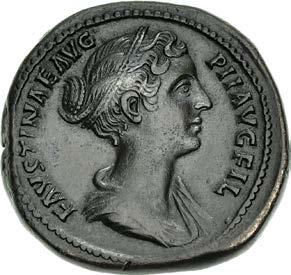

489. Faustina Junior Augusta, AD 147-175. Æ Sestertius (31mm, 25.00 g, 12h). Rome mint. Struck under Antoninus Pius, circa AD 147-150. Draped bust right, wearing double band of pearls around head / Venus standing left, holding apple and anchor, around which a dolphin is coiled. RIC 1388c (Pius); Banti 137. Dark brown patina, smoothed, some roughness on reverse. Good VF. Charming portrait from dies of artistic merit. ($1000)
From the Plus 20 Collection. Ex Wild Rose Collection (Classical Numismatic Group 126, 28 May 2024), lot 800; Classical Numismatic Review XLV.1 (Winter 2021), no. 563143; Hess-Divo 339 (22 October 2020), lot 111; Leu 10 (29 May 1974), lot 183; Helbing 63 (29 April 1931), lot 812.
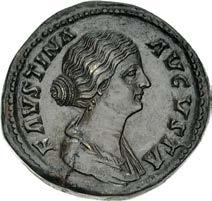


490. Faustina Junior. Augusta, AD 147-175. Æ Sestertius (34mm, 28.81 g, 12h). Rome mint. Struck under Marcus Aurelius and Lucius Verus, circa AD 161. Draped bust right, chignon adorned with pearls / Fecunditas standing left, holding two infants in her arms between two girls standing facing her with hands raised. RIC III 1635 (Aurelius); MIR 18, 10-6a; Banti 56. Brown and green patina, minor edge split and edge knock. EF. Gorgeous portrait. ($1500)
Ex John Wright Collection; Classical Numismatic Group 78 (14 May 2008), lot 1794; Classical Numismatic Group 69 (8 June 2005), lot 1638. As is often the case, the location of the edge knock on this coin suggests that it was applied in the mint for the purpose of closing the flan crack.



491. Lucius Verus. AD 161-169. Æ Sestertius (33mm, 25.31 g, 11h). Rome mint. Struck under Marcus Aurelius and Lucius Verus, AD 162. Laureate head right / Lucius Verus and Marcus Aurelius standing vis-à-vis, clasping right hands. RIC III 1309 (Aurelius); MIR 18, 30-16/30; Banti 32. Green patina, minor roughness, areas of light smoothing. Near EF. ($1000)
Ex John Wright Collection, purchased from Heritage, April 2012.
Hadrian, childless and without either a successor or heir, chose Lucius Ceionius Commodus as his adopted son in AD 136 and renamed him Lucius Aelius Caesar. Aelius was sent to the Roman province of Pannonia to serve as governor, where he unexpectedly died in AD 138. Hadrian now made his second choice for his heir, Titus Aurelius Fulvus Boionius Antoninus. Hadrian actually wanted Marcus Aurelius to succeed him on the throne but realized that Aurelius was far too young, so instead he went with the highly respected Antoninus. As a condition of his adoption, and to ensure an orderly line of succession, Antoninus Pius adopted both his nephew, Marcus Aurelius, and Aelius Caesar’s son, Lucius. The relatively young Lucius would change his name to Lucius Aelius Aurelius Commodus, but he would later drop Commodus and add Verus after ascending to the throne, along with his adoptive brother and co-ruler Marcus Aurelius.

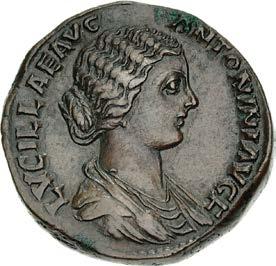

492. Lucilla. Augusta, AD 164-169. Æ Sestertius (29mm, 22.99 g, 12h). Rome mint. Struck under Marcus Aurelius and Lucius Verus, AD 163. Draped bust right / Concordia seated left, holding patera and cornucopia. RIC III 1732 (Aurelius); MIR 18, 2-6b; Banti 6. Attractive brown patina, a few spots of minor green encrustation. VF. ($500)
Ex John Wright Collection; Classical Numismatic Group 67 (22 September 2004), lot 1587.
The second of six daughters born to Marcus Aurelius and Faustina Junior, Lucilla grew up as an imperial princess, with the strange mix of power and helplessness such a position entailed in ancient Rome. In AD 161, at the age of 12, she was betrothed to Lucius Verus, her father’s co-emperor, who was 18 years her senior and had many years earlier actually been betrothed to her mother. This lovely aureus was likely struck shortly after her marriage to Verus in AD 164, with a longer form of obverse legend identifying her as “daughter of Antoninus Augustus” (Marcus Aurelius). Later coins shorten this to simply “Lucilla Augusta.” Lucilla lost the title of Augusta after the sudden death of Verus in AD 169 and her subsequent forced marriage to the elderly senator Tiberius Claudius Pompeianus. This loss of status led her into an unsuccessful plot against Commodus in AD 182, with fatal results.




493. Commodus. As Caesar, AD 166-177. AV Aureus (20.5mm, 7.22 g, 6h). Rome mint. Struck under Marcus Aurelius and Commodus, AD 175-176. COMMODO CAES AVG FIL GERM SARM, bareheaded, draped, and cuirassed bust right / ADVENTVS • CAES, Commodus, in military dress, on horseback riding right, raising right arm. RIC III 604 (Aurelius) corr. (obv. legend and bust type); MIR 18, 334-12/13; Calicó 2220 (same dies as illustration); BMCRE 641 (same dies); Biaggi 981 (same dies); Mazzini 1 (same dies). Minor edge marks. VF. Very rare. Three examples in CoinArchives. ($10,000)
Having traveled East to quash Avidius Cassius’ rebellion and visit the provinces, this coin commemorates Commodus’ return to Rome in AD 176, with his father. Interestingly, ADVENTVS coins were not minted with Marcus Aurelius’ visage showing his desire to promote his son, who he was giving increasingly more power to and in order to show that Commodus was to be his successor.


494. Commodus. AD 177-192. Æ Sestertius (30mm, 26.33 g, 6h). Rome mint. Struck AD 181. Laureate head right / Felicitas standing left, holding caduceus and scepter. RIC III 308a; MIR 18, 508-6/30; Banti 50. Dark green and brown patina, smoothed. Near EF. ($750)
Ex John Wright Collection; Classical Numismatic Group Electronic Auction 158 (14 February 2007), lot 245.


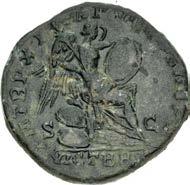
495. Commodus. AD 177-192. Æ Sestertius (30.5mm, 19.94 g, 11h). British Victory issue. Rome mint. Struck AD 185. Laureate head right / VICT BRIT in exergue, Victory seated right on heap of stones, holding long stylus, and placing hand on shield set on knee; two shields on ground to left. RIC III 452; MIR 18, 665-6/30 var. (VIC BRIT); Banti 486; SCBC 648. Attractive dark green patina. Good VF. ($750)
Ex Dr. Malcolm Lyne Collection (Classical Numismatic Group 126, 28 May 2024), lot 806, purchased from Baldwin’s, 8 May 2015.

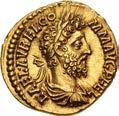


496. Commodus. AD 177-192. AV Aureus (19.5mm, 7.28 g, 6h). Rome mint. Struck AD 192. L • AEL • AVREL • CO MM AVG P FEL, laureate, draped, and cuirassed bust right / PROVID EN TIAE AVG, Commodus, as Hercules, standing left, naked, right knee bent, right foot on prow, holding club on tree trunk in left hand, clasping right hands over grain ears with Africa, who stands right before him: she is draped, wears elephant-skin headdress, and holds sistrum in left hand; at her feet to right, lion just seen to right. RIC 259e; MIR 18, 861-2/37; Calicó 2318 (same obv. die as illustration); BMCRE p. 755, note 355; Biaggi 1009 (same obv. die); Mazzini 642 v. (same obv. die). Toned, underlying luster, traces of deposits. Near EF. Very rare. Two examples in CoinArchives. ($7500)

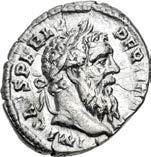

497. Pertinax. AD 193. AR Denarius (17mm, 3.18 g, 6h). Rome mint. 2nd emission. Laureate head right / Laetitia standing left, holding wreath and scepter. RIC IV 4a; Lempereur Type 8, 327 (D113/R187); RSC 20. Bright, granular surfaces, a few hairline flan cracks. VF. ($500)
As the Senate’s choice to replace the dissolute Commodus, the elderly Pertinax immediately launched into a program of reform intended to restore faith in the Roman Empire’s government and finances. Among these was a reform of the silver coinage, which had been seriously debased under Commodus. The silver denarii issued by Pertinax show a marked increase in both weight and fineness over the last issues of Commodus. The portraiture was likewise of a high standard, showing the emperor as a distinguished and heavily bearded senior statesman. However it was not to last: Pertinax was slain by the Praetorians after a reign of less than three months, and the debasement of Rome’s coinage soon resumed and accelerated.

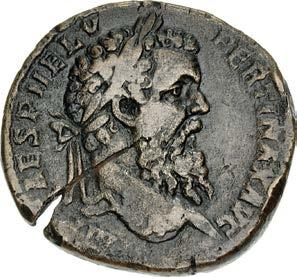

498. Pertinax. AD 193. Æ Sestertius (31.5mm, 22.67 g, 6h). Rome mint. 2nd emission. Laureate head right / Laetitia standing left, holding wreath and scepter. RIC IV 17; Lempereur Type 8, 749 (D275/R384); Banti 11 (same dies as illustration). Brown patina, edge split and flan crack. Near VF. Powerful portrait. ($750)
Ex John Wright Collection, purchased from James Beach, January 2009.



499. Didius Julianus. AD 193. AR Denarius (18mm, 3.00 g, 6h). Rome mint. Laureate head right / Didius Julianus standing left, holding globe and volumen. RIC IV 3; RSC 15. Toned, hairlines. VF. ($750)
Didius Julianus was born to a wealthy family in AD 137, probably in Milan. He had a prominent government career, including several provincial governorships, in the reigns of Marcus Aurelius and Commodus. Though successful, he did not earn the respect of his fellow senators, who regarded him as a sensualist and a spendthrift. When the Emperor Pertinax was killed by the Praetorians after only a threemonth reign on March 28, AD 193, no ready successor was at hand. Pertinax’s father-in-law, Flavius Sulpicianus, entered the Praetorian camp and tried to get the troops to proclaim him emperor, but he was met with little enthusiasm. Sensing an opportunity, Didius Julianus rushed to the camp and began to make cash promises to the soldiers from outside the wall. Soon the scene became an auction, with Sulpicianus and Julianus striving to outbid each other for the favor of the troops. When Sulpicianus reached 20,000 sesterces per soldier, Didius Julianus upped the bid by a whopping 5,000 sesterces, signaling with hand gestures. The emperorship was sold. Julianus was allowed into the camp and the Praetorians proclaimed him emperor. Confronted by the Praetorian swords, the Senate approved his elevation, but could not hide its disgust. Disturbances broke out throughout the city, and a crowd at the Colosseum loudly called for Pescennius Niger, governor of Syria, to march on Rome. Niger was not the only alternative. Two other provincial governors also declared themselves emperor: Clodius Albinus in Britain, and Septimius Severus in Pannonia. Severus, closest to Rome, immediately marshaled his troops and invaded Italy. Julianus at first tried negotiations, then sent assassins to kill Severus, to no avail. Julianus next tried to fortify Rome but the results were ineffective and ludicrous. With Julianus’ authority in Rome rapidly deteriorating, Severus sent messages to the Praetorians, who renounced their allegiance to Julianus. Seeing their cue, the Senators proclaimed Severus emperor and passed a death sentence on Julianus. On June 1, AD 193, a Praetorian officer found the cringing Julianus hiding in the palace and dispatched him, ending his pathetic 65-day reign.
The reverse of this attractive silver denarius depicts Julianus with the grandiose title “Rector Orbis,” or ruler of the world. In reality, his authority never extended far beyond the immediate environs of Rome.


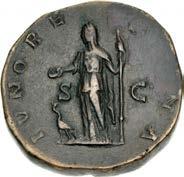
500. Manlia Scantilla. Augusta, AD 193. Æ Sestertius (29mm, 25.20 g, 12h). Rome mint. Struck under Didius Julianus. Draped bust right / Juno standing left, holding patera and vertical scepter; at feet to left, peacock standing left, head right. RIC IV 18a (Didius); Woodward, Didius, dies 4/N; Banti 2/B. Attractive brown patina, areas of smoothing, shallow scratches. VF. Charming portrait. ($3000)
Ex John Wright Collection; Michael Weller Collection (Triton VIII, 11 January 2005), lot 1037; Leu 75 (25 October 1999), lot 1541.
Little is known for certain about Manlia Scantilla, the wife of the brief-reigning Didius Julianus. Her name suggests a connection to the prestigious Manlia gens. After securing the throne via the infamous “auction of empire” by the Praetorian Guard in March of AD 193, Didius Julianus granted the title of Augusta to both his wife Scantilla and their daughter, Didia Clara, a renowned beauty. Scantilla, in contrast, is called “the most deformed of women” by numismatic historian Seth W. Stephenson, probably based upon her sometimes unflattering coin portraits. This harsh verdict is not borne out on this sestertius, where she appears as a pleasant-featured matron.
Scantilla had little time to enjoy her new status as Augusta, since her husband reigned only 66 days. On 1 June AD 193, he was murdered in the palace by his own Praetorians upon the approach of Septimius Severus, whom the Senate proclaimed Augustus in his stead. Julianus was declared a usurper, although he had been approved, however reluctantly, by the Senate. Scantilla and Clara fared marginally better: they were spared but stripped of their titles and inheritance. Severus gave them the body of Julianus for burial in the family crypt. Scantilla reportedly died in obscurity only a month later. The coinage of Manlia Scantilla in all metals is accordingly quite scarce due to the brevity of the reign.



501. Didia Clara. Augusta, AD 193. AR Denarius (18.5mm, 3.07 g, 6h). Rome mint. Struck under Didius Julianus. Draped bust right / Hilaritas standing left, holding long palm frond and cornucopia. RIC IV 10 (Julianus); RSC 3. Toned. VF. ($1000)
Ex Ball VI (9 February 1932), lot 1769.
Didia Clara, the daughter of the brief-reigning emperor Didius Julianus, was reputedly one of the most beautiful women in Rome (in which case, as the historian S. W. Stephenson notes drily, “her coins do her no justice”). After securing the throne, Julianus granted the title of Augusta to both his wife, Manlia Scantilla, and their daughter, Didia Clara. He also quickly had Clara married off to Cornelius Repentius, a man from an influential Senatorial family, who was then made Prefect of Rome and placed in charge of the city’s garrison. However, this would only be temporary as Julianus’ reign was cut short by Septimius Severus. Clara and Scantilla’s lives were spared, but they stripped of their titles and inheritance. While her mother died shortly thereafter, Didia Clara’s fate is unknown.



502. Pescennius Niger. AD 193-194. AR Denarius (18mm, 2.57 g, 11h). Antioch mint. Laureate head right / Justitia standing left, holding scales and cornucopia. RIC IV 47c; RSC 47c. Lightly toned, minor marks. VF. Struck on a broad flan. ($750)
Following the death of Pertinax in AD 193, and the “sale” of the Roman throne by the Praetorian Guard to Didius Julianus, the legions of Syria hailed their governor, Pescennius Niger, as emperor. Septimius Severus, who had been proclaimed emperor by the Danubian legions at about the same time, first secured his power by subduing Rome, then marched to encounter Niger. In the ensuing battles, Severus proved to be the stronger adversary, and Niger was overtaken as he attempted escape to Parthia. He was executed, and his head was sent to Severus, who then ruthlessly slaughtered the rest of Niger’s family.

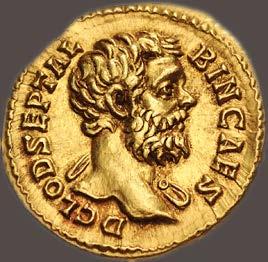
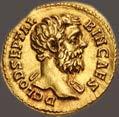
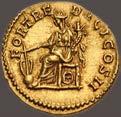

503. Clodius Albinus. As Caesar, AD 193-195. AV Aureus (19.5mm, 7.32 g, 12h). Rome mint. Struck AD 194-195. D CLOD SEPT AL BIN CAES, bareheaded bust right, slight drapery / FORT RE DVCI COS II, Fortuna, draped, seated left on low seat, holding rudder on globe in right hand and cornucopia in left; wheel below seat. RIC IV 5b; Calicó 2415 (same obv. die as illustration); BMCRE 93 (same obv. die); Biaggi 1057 (same obv. die); Jameson 160 (same dies); Mazzini 29 (same dies). Toned, underlying luster. In NGC encapsulation 8557535-001, graded Ch XF★, Strike: 5/5, Surface: 5/5. Very rare, and fine style. ($200,000)
In AD 193, shortly after hearing of the assassination of Pertinax and subsequent elevation of Didius Julianus, Clodius Albinus, who was then governor of Britain, began preparations to seize the throne for himself. At the same time, Septimius Severus, the governor of Upper Pannonia, had been declared emperor by his troops and was preparing to march on Rome. Upon hearing of Albinus’ plans, Septimius offered him the rank of Caesar and heir to the throne should Albinus join him. Albinus must have sensed that Septimius had stronger support than himself and prudently agreed. Septimius marched on Rome and entered the city without resistance soon after Julianus was killed on 1 June.
After securing the capital, Septimius proceeded to issue a series of coins from Rome, including an issue for his Caesar, Albinus. That short issue was superseded by a second issue beginning in January, AD 194, when Albinus and Septimius jointly served as consul, each for the second time.
The harmony between the two was short-lived. Both had different ambitions, Clodius to become emperor himself, Septimius to establish his family as the ruling house, and the arrangement seemed only necessary insofar as to give each the time to prepare to accomplish their own goal. While Septimius was away in the east fighting Pescinnius Niger, he learned of Albinus’ machinations against him and responded by breaking their arrangement and elevating his own son, Caracalla, to the rank of Caesar. Albinus responded by declaring himself Augustus, rallying his troops in Britain, and began marching on Rome. His forces were stalled by resistance in Gaul as Septimius moved west. Eventually the two armies, comprising over 100,000 men, met on the fields outside Lugdunum (Lyon) on 19 February AD 197. After making initial gains, Albinus’ army was routed, and he committed suicide when he became trapped in a house near the Rhône.
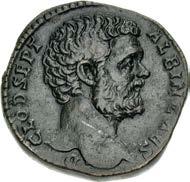
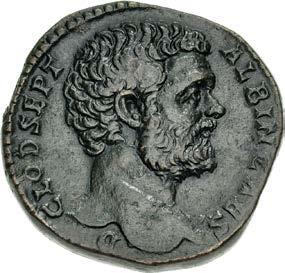

504. Clodius Albinus. As Caesar, AD 193-195. Æ Sestertius (30mm, 26.32 g, 12h). Rome mint. Struck AD 194-195. Bare head right / Minerva standing left, holding olive branch and shield set on ground, spear leaning against left arm. RIC IV 54a; Banti 18. Dark green-brown patina, some encrustation on reverse. VF. ($750)
Ex John Wright Collection; Robert Schonwalter Collection (Triton V, 15 January 2002), lot 2013; Münzen und Medaillen AG 79 (28 February 1994), lot 567; R. Laughlin Collection (A. Hess, 18 December 1933), lot 701.



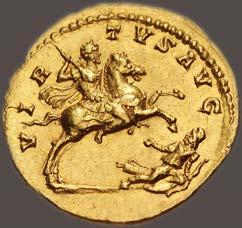
505. Septimius Severus. AD 193-211. AV Aureus (19.5mm, 7.28 g, 6h). Rome mint. Struck AD 200-201. SEVERVS AVG PART MAX, laureate bust right, wearing aegis / VIR TVS AVG, Septimius Severus, in military dress, with cloak flying behind him, on horse rearing right, brandishing javelin in right hand at foeman on his knees to right, turning back head left, and raising right hand in appeal, and holding bow in left hand; arrows in quiver on ground behind him. RIC IV 169a/146a (for obv./ rev. types); Calicó 2539/2576 (for obv./rev. types – same obv. die); BMCRE 208/142 (for obv./rev. dies); cf. Adda 394 (same obv. die); cf. Biaggi 1103 (same obv. die). Lustrous. In NGC encapsulation 8557492-001, graded AU★, Strike: 5/5, Surface: 5/5, Fine Style. Extremely rare and unpublished with this bust type. ($20,000)
Although Septimius Severus is often described as first of the “soldier emperors,” his early career was almost entirely civilian, rising steadily through the ladder of Roman magistracies, much like his predecessors. Nevertheless, his reign proved a major step in militarizing Roman government and life. He entered the Senate in AD 173 and gained some early military experience as a legionary officer in Africa and Syria, where he served under the later Emperor Pertinax. After reaching the consulship in AD 190, he was appointed as governor of Pannonia Superior, which placed him in command of Legio XIIII Gemina Martia Victrix, strategically located within easy march of Italy and Rome. With the assassination of Commodus in AD 193, followed within weeks by the murder of his mentor Pertinax, Severus was hailed as emperor by the XIIIIth at Carnuntum. A lightning march to Rome deposed the pathetic Didius Julianus and placed Severus in firm control of the capital, whereupon he immediately prepared for civil war against two rivals who had likewise been proclaimed in the provinces, Clodius Albinus and Pescinnius Niger. Though wealthy and connected, Severus was from a “new” family and relied heavily on the army to cement his power. He raised military pay and showed his troops many preferments, including ending the longtime ban on marriage for regular soldiers. The army began to think of him as one of their own and, after disposing of Niger and Albinus, he suffered no revolts or serious internal threats for the rest of his reign.



506. Septimius Severus. AD 193-211. AR Denarius (18mm, 3.60 g, 12h). Rome mint. Struck AD 203. Laureate head right / Arch of Septimius Severus: arch consisting of large central bay and two smaller flanking bays divided by four columns; attic surmounted by statues of Septimius in a chariot drawn by six horses, flanked by figures of Caracalla and Geta on horseback. RIC IV 259; RSC 104; Elkins, Monuments Figure 140. Toned, granular surfaces, area of shallow cleaning scratches. VF. Rare. ($1000)
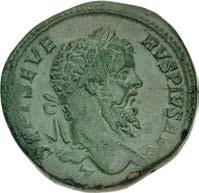


507. Septimius Severus. AD 193-211. Æ Sestertius (32mm, 23.90 g, 12h). Rome mint. Struck AD 210. Laureate head right / Two Victories standing facing each other, attaching shield to palm tree; two captives seated below. RIC IV 796; Banti 124. Attractive green patina, hairline flan crack. Good VF. ($1500)
Ex John Wright Collection, purchased from David Vagi, January 2002.
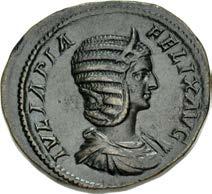

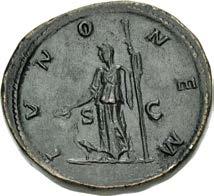
508. Julia Domna. Augusta, AD 193-217. Æ Sestertius (34mm, 29.75 g, 12h). Rome mint. Struck under Caracalla, AD 211-215. Draped bust right, wearing stephane / Juno standing left, holding patera and scepter; at feet to left, peacock standing left, head right. RIC IV 585a (Caracalla); Banti 22. Olive green and brown patina. Good VF. ($1000)
Ex John Wright Collection; John F. Sullivan Collection (Triton IX, 10 January 2006), lot 1517.
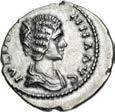
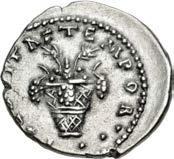

509. Julia Domna. Augusta, AD 193-217. AR Denarius (18.5mm, 2.95 g, 6h). Emesa mint. Struck under Septimius Severus, circa AD 193-195. Draped bust right / Basket, in shape of vase, filled with grain ears, poppies, and grape bunches. RIC IV 620 (Septimius); RSC 53. Toned, struck off center. Good VF. Rare. ($500)
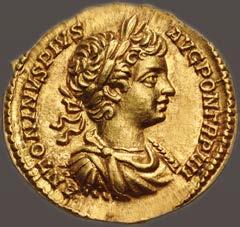

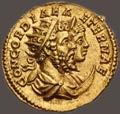

510. Caracalla, with Septimius Severus and Julia Domna. AD 198-217. AV Aureus (19.5mm, 7.32 g, 12h). Dynastic issue. Rome mint. Struck AD 201. ANTONINVS PIVS AVG PON TR P IIII, laureate, draped, and cuirassed bust of Caracalla right / CONCORDIAE A ETERNAE, jugate busts right of Septimius Severus, radiate and draped, and Julia Domna, draped, wearing stephane, set on crescent. RIC I 52; Calicó 2849 (same obv. die as illustration); BMCRE 260; Adda 430 (same obv. die); Biaggi 1163 (same obv. die); Mazzini 1; Triton XXV, lot 950 (same dies). Toned, minor deposits. EF. Three superb portaits on this impressive dynastic issue. ($30,000)
Without an heir to take up the throne, the possibility of a civil war erupting after the death of an emperor was an enormous threat to public safety. This issue celebrates the harmony – even the eternity – of the dynasty, depicting both father and son. In furtherance of this theme, Julia Domna was associated with Luna Lucifera, “the light-bearing Moon”, while Septimius Severus associated himself with Sol, god of the Sun, a natural and immortal pair.

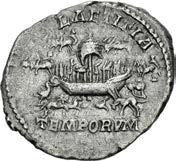
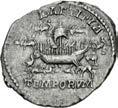
511. Caracalla. AD 198-217. AR Denarius (20mm, 3.31 g, 6h). Rome mint. Struck AD 206. Laureate head right / Ship with mast and sail in center of circus; above, four quadrigae driven left; below, ostrich, lion, zebra, bear and stag right, bull butting left, bear right, head left. RIC IV 157 (R3); RSC 118. Toned, a few shallow cleaning scratches under tone on reverse. Good VF. Rare. ($1000)
Ex G. Hirsch 371 (9 February 2022), lot 1334.
The games of AD 206 repeated the festivities of 202, which celebrated the return of the imperial family from their successful eastern campaigns. This complex and crowded design recognizes most of the forms of entertainment at the games; the naumachia, a mock sea battle which involved flooding the Circus Maximus, the chariot races at the Hippodrome, and combat between wild beasts. In RIC the avian creature at the far left is called a cock, but on many coins it is clearly a long-necked, long-legged bird, either an ostrich or a crane. Both birds would typically appear in a farcical combat with African pygmies.

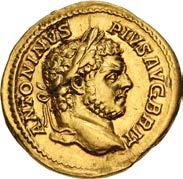

512. Caracalla. AD 198-217. AV Aureus (20mm, 7.45 g, 6h). Rome mint. Struck AD 212-213. ANTONINVS PIVS AVG BRIT, laureate head right / PROVIDENTIAE DEORVM, Providentia, draped, standing left, holding scepter in left hand and wand in right over globe on ground to left. RIC IV 227; Calicó 2802 (same dies as illustration) corr. (obv. legend ends BRIT not GERM); BMCRE p. 374, note 100; Biaggi 1213 (same rev. die); Jameson 186 (same rev. die). A few scratches, hairlines, deposits, minor edge marks. Good VF. ($5000)
Ex Athena 1 (8 October 1987), lot 248.



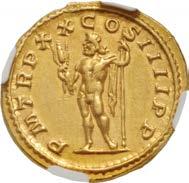
513. Caracalla. AD 198-217. AV Aureus (20mm, 6.39 g, 12h). Rome mint. Struck 1 January-8 April AD 217. ANTONINVS PIVS AVG GERM, laureate and cuirassed bust right / P M TR P XX COS IIII P P, Jupiter, naked but for cloak over left shoulder, standing facing, head left, holding thunderbolt in right hand and vertical scepter in left. RIC IV 285b; Calicó 2755 (same dies as illustration); BMCRE p. 463, note 180; Adda –; Biaggi –; Jameson –; Mazzini –. In NGC encapsulation 5788895-002, graded Ch XF, Strike: 5/5, Surface: 4/5, light marks. Very rare and missing from most major collections. This is one of four examples in CoinArchives. ($7500)
Ex MDC Monaco 10 (13 October 2022), lot 66; Maison Palombo 20 (22 January 2022), lot 67.
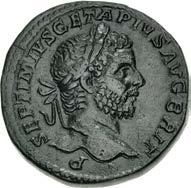

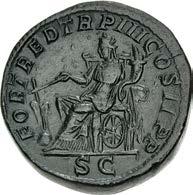
514. Geta. AD 209-211. Æ Sestertius (31mm, 28.02 g, 12h). Rome mint. Struck AD 211. Laureate head right / Fortuna seated left on throne, holding rudder on globe and cornucopia; wheel under throne. RIC IV 168a; Banti 20 (same obv. die as illustration). Dark green patina, hairline flan crack. Near EF. ($2000)
From the Plus 20 Collection. Ex Wild Rose Collection; CNG inventory 564473 (January 2021); Roma XX (29 October 2020), lot 645; Benito Collection (Classical Numismatic Group 114, 13 May 2020), lot 947; Gemini III (9 January 2007), lot 425; H. C. Levis Collection (Ars Classica XI, 18 June 1925), lot 761.

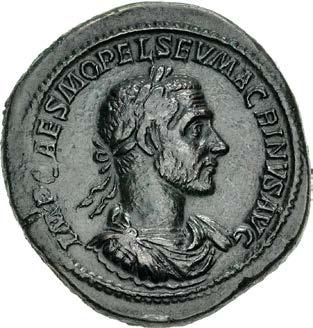

515. Macrinus. AD 217-218. Æ Sestertius (33mm, 27.33 g, 10h). Rome mint. 2nd emission. Laureate, draped, and cuirassed bust right, wearing short beard / Annona seated left, holding three grain ears and cornucopia. RIC IV 169 var. (bust type); Clay Issue 2; Banti 4 var. (same). Dark olive green-brown patina, smoothed, slight doubling on reverse. Good VF. Struck on a medallic flan. ($1500)
Ex John Wright Collection; Classical Numismatic Group 63 (21 May 2003), lot 1458; Lanz 109 (27 May 2002), lot 654.
Born in Mauretania, Macrinus received a legal education that enabled him to rise high as a bureaucrat in imperial service, to the post of Praetorian Prefect. In AD 216, Macrinus accompanied Caracalla to the east on a campaign, but while the emperor was visiting a temple, Macrinus learned that a letter implicating him in a plot was about to be delivered to Caracalla. Acting quickly, he procured Caracalla’s murder. Macrinus proclaimed his innocence and, while not everyone was convinced, he was still able to have the army leadership proclaim him emperor on 11 April AD 217. Though not a senator (he was the first of equestrian rank to become emperor), he adopted Marcus Aurelius as his model.
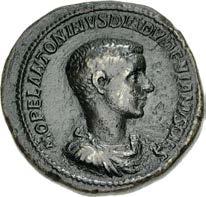

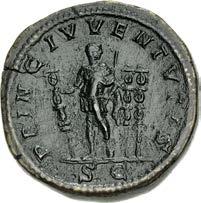
516. Diadumenian. As Caesar, AD 217-218. Æ Sestertius (32.5mm, 28.89 g, 12h). Rome mint. 2nd emission of Macrinus. Bareheaded, draped, and cuirassed bust right / Diadumenian standing facing, head right, holding signum and scepter; two signa to right. RIC IV 211 (Macrinus); Clay Issue 2; Banti 3. Dark green-brown patina, hairline flan crack, some smoothing and roughness. VF. Rare. ($750)
Ex John Wright Collection; Classical Numismatic Group 67 (22 September 2004), lot 1639.
In response to Elagabalus being declared Augustus by the soldiers at Emesa on 15 May AD 218, Macrinus elevated his son Diadumenian to Augustus shortly thereafter at Apamea, while on his way to meet the rebellion. Diadumenian did not remain Augustus for long. Following his defeat on 8 June AD 218, Macrinus entrusted Diadumenian to some loyal soldiers, who were to transport the boy to refuge with the Parthians. Near Zeugma, however, Diadumenian was captured and executed shortly thereafter. He was 10 years old and reigned as Augustus for less than three weeks.
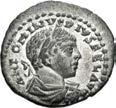
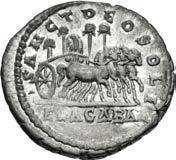

517. Elagabalus. AD 218-222. AR Denarius (19mm, 2.88 g, 6h). Uncertain eastern mint. Struck AD 218-219. Laureate, draped, and cuirassed bust right / Slow quadriga right, bearing the sacred stone of Emesa on which is an eagle, surrounded by four parasols. RIC IV 195; Thirion 360; RSC 268. Lightly toned, some underlying luster. EF. ($750)
At the age of fourteen, Varius Avitus Bassianus (better known as Elagabalus or Heliogabalus) inherited the office of high priest of the sun god El-Gabal at Emesa in Syria. The deity was worshipped in the form of a conical sacred stone, or baetyl, likely a large meteorite. When an unlikely coup made him emperor in June of AD 218, Elagabalus determined to take the stone with him to Rome and introduce its worship to the whole empire. During his reign, the emperor was devoted to promoting the cult of El-Gabal, building a lavish temple on the Palatine Hill to house the stone. For a brief period, the exotic eastern deity nearly came to dominate the Roman Pantheon.
This issue, struck in AD 218-219, likely refers to the journey from Emesa to Rome. The procession was repeated every year in the transfer of the stone from its principal temple in Rome to its “summer home,” a large and richly decorated temple in the suburbs. Describing the transfer, Herodian (V.6.7) writes:
A six-horse chariot bore the sun god, the horses huge and flawlessly white, with expensive gold fittings and rich ornaments. No one held the reins, and no one rode in the chariot; the vehicle was escorted as if the sun god himself were the charioteer. Heliogabalus ran backward in front of the chariot, facing the god and holding the horses’ reins. He made the whole journey in this reverse fashion, looking up into the face of his god.


518. Orbiana. Augusta, AD 225-227. Æ Sestertius (30mm, 19.89 g, 12h). Rome mint. Special marriage emission of Severus Alexander, AD 225. Draped bust right, wearing stephane / Severus Alexander, holding volumen, and Orbiana standing vis-à-vis, clasping right hands. RIC IV 657 (Alexander); BMCRE 301 (Alexander); Banti 3. Green patina, die break on reverse. VF. Rare. ($500)
Ex John Wright Collection; Classical Numismatic Group 63 (21 May 2003), lot 1482.
Sallustia Orbiana was the daughter of Lucius Seius Herennius Sallustius, an influential Roman senator. In AD 225, when she was about 16, she married the young emperor Severus Alexander, who was about the same age. Their marriage gave every appearance of being tranquil for two years; however, her position theoretically equaled that of the emperor’s mother, Julia Mamaea, the true power behind the throne. Mamaea could not countenance this. In AD 227, Sallustius was abruptly charged with trying to foment a rebellion with the Praetorian guards, arrested, and executed. The marriage of Alexander and Orbiana was annulled, and she was stripped of her titles and exiled to Libya. Her final fate is unknown. Such were the risks of challenging a jealous mother-in-law.

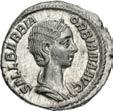
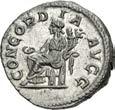

519. Orbiana. Augusta, AD 225-227. AR Denarius (18.5mm, 3.65 g, 6h). Rome mint. Special marriage emission of Severus Alexander, AD 225. Draped bust right, wearing stephane / Concordia seated left, holding patera and double cornucopia. RIC IV 319 (Alexander); BMCRE 287-9 (Alexander); RSC 1. Lustrous. Superb EF. Well struck with fresh dies. ($500)
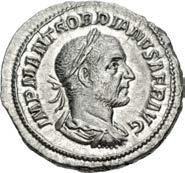
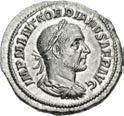

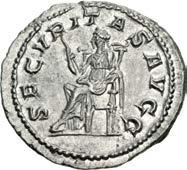
520. Gordian I. AD 238. AR Denarius (20mm, 3.00 g, 11h). Rome mint. Struck 1-22 April. Laureate, draped, and cuirassed bust right / Securitas seated left on throne, holding scepter, fold of drapery over left arm. RIC IV 5; BMCRE 11; RSC 10. Underlying luster, some shallow cleaning marks. EF. Rare and attractive. ($2000)
Gordian I and his son Gordian II share the dubious distinction of having the shortest reigns of any “legitimate” Roman emperors, together ruling a mere 22 days. Despite their brief production run, coins of Gordian I and II are notable for their excellent portraiture. The elder Gordian appears as a distinguished older gentleman with thin, hawkish features, while Gordian II is shown as a younger, plumper and prematurely balding man with a slight beard. This may indicate that official effigies of both were already at the Rome mint when their rebellion against Maximinus I broke out in Carthage, suggesting the whole episode was not as spontaneous as contemporary historians claimed.
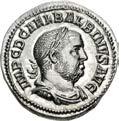


521. Balbinus. AD 238. AR Denarius (19.5mm, 2.91 g, 11h). Rome mint. 1st emission. Laureate, draped, and cuirassed bust right / Providentia, standing left, holding cornucopia and wand over globe set on ground to left. RIC IV 7; BMCRE 33; RSC 23. Attractive and lustrous. EF. Bold strike with fresh dies. ($500)
With the deaths of the Gordians in Carthage, the Roman Senate faced a difficult situation. A vengeful Maximinus was headed to Rome (for the first time in his reign), and there was no center of opposition to his onslaught. The desperate senators called upon two of their number, Balbinus and Pupienus, to become joint emperors in the face of the threat, with Balbinus to organize Rome, while Pupienus marched out to confront Maximinus. Whether the two inexperienced emperors could have successfully met the challenge would never be known, because Maximinus was assassinated by his own troops before Aquileia in early April. The victory of the two emperors would be short-lived; they fell to bickering, and on 29 April disgusted Praetorian guards dragged them out of the palace and murdered them. Their replacement was the young Caesar, Gordian, nephew of Gordian II. In the space of a few short months the Roman Empire had been ruled by a barbarian giant, an elderly provincial governor and his headstrong son, two incompetent senators, and a thirteen year old boy.

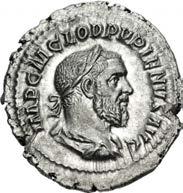

522. Pupienus. AD 238. AR Denarius (20mm, 2.93 g, 6h). Rome mint. 1st emission. Laureate, draped, and cuirassed bust right / Concordia seated left, holding patera and double cornucopia. RIC IV 1; BMCRE 42; RSC 6. A few minor marks. EF. Bold portrait. ($500)
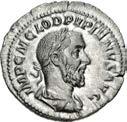

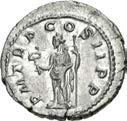
523. Pupienus. AD 238. AR Denarius (20.5mm, 3.48 g, 6h). Rome mint. 1st emission. Laureate, draped, and cuirassed bust right / Felicitas standing left, holding caduceus and scepter. RIC IV 6; BMCRE 52-3; RSC 26. Lightly toned, some underlying luster. EF. ($500)


524. Pupienus. AD 238. Æ Sestertius (29mm, 18.67 g, 12h). Rome mint. 1st emission. Laureate, draped, and cuirassed bust right / Concordia seated left, holding patera and double cornucopia. RIC IV 20; BMCRE 43; Banti 1. Dark brown patina with some scattered green encrustation. VF. ($500)
Ex John Wright Collection; Rudolf Berk Collection (Classical Numismatic Group Electronic Auction 108, 16 February 2005), lot 259.

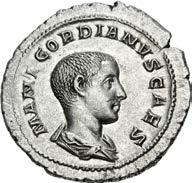
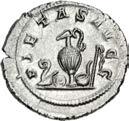
525. Gordian III. As Caesar, AD 238. AR Denarius (21mm, 2.91 g, 1h). Rome mint. 1st emission of Balbinus and Pupienus. Bareheaded and draped bust right / Emblems of the pontificate: lituus, secespita, patera, guttus, simpulum, and aspergillum. RIC IV 1 var. (no patera); BMCRE 62-3 var. (same); RSC 182. Lightly toned. EF. Well struck with fresh dies. Wonderful portrait. Rarer variety with the patera. ($500)


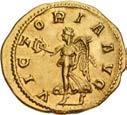
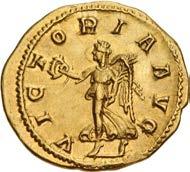
526. Gordian III. AD 238-244. AV Aureus (20.5mm, 4.96 g, 12h). Rome mint, 6th officina. 1st emission, mid-end AD 238. Laureate, draped, and cuirassed bust right / Victory advancing left, holding wreath and palm frond. RIC IV 11; Calicó 3238 (same rev. die as illustration); Biaggi 1371 (same rev. die); Mazzini 356 (same rev. die); Tkalec (8 September 2008), lot 285 (same dies). Light smoothing, faint hairlines, edge marks. Good VF. ($2000)

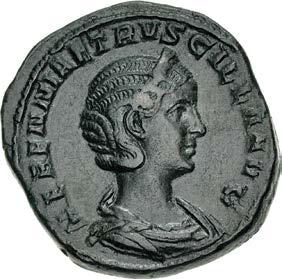
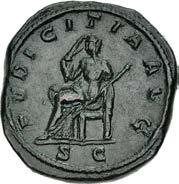
527. Herennia Etruscilla. Augusta, AD 249-251. Æ Sestertius (29mm, 20.50 g, 12h). Rome mint, 6th officina. 3rd emission of Trajan Decius, early to mid AD 250. Draped bust right, wearing stephane, wavy hair ending in chignon / Pudicitia seated left, drawing veil and holding scepter. RIC IV 136b (Decius); Banti 8. Dark brown patina. Good VF. Fine style portrait. ($500)
Ex John Wright Collection; Triton IX (10 January 2006), lot 1556; William C. Boyd (†1906) Collection (Baldwin’s 42, 26 September 2005), lot 615 (part of), purchased from W.S. Lincoln, October 1900.



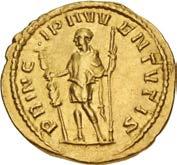
528. Hostilian. As Caesar, AD 250-251. AV Aureus (19mm, 4.10 g, 12h). Rome mint, 5th officina. 5th emission of Trajan Decius, AD 251. Bareheaded and draped bust right / Hostilian standing left, holding signum and reversed vertical spear. RIC IV 181b (Decius); Calicó 3316; Adda 493; Biaggi 1405 (same dies); Jameson 242. Smoothed. VF. ($3000)
Due to the brevity of his reign, gold coins of Hostilian are rare in the Roman series. The empire’s weakened economy is revealed by the severely reduced weight of 4.10 grams. Hostilian’s tender age is quite evident on the obverse portrait, while the reverse proclaims him “Prince of Youth.”
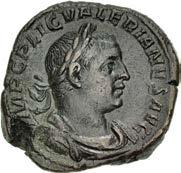

529. Valerian I. AD 253-260. Æ Sestertius (29.5mm, 17.30 g, 6h). Rome mint. 1st emission, AD 253-254. Laureate, draped, and cuirassed bust right / Virtus standing facing, head left, holding spear and resting hand on shield set on ground to left. RIC V 182; MIR 36, 38g; Banti 33. Brown patina, slightly irregular flan. Good VF. ($500)
Ex Alain Lagrange Collection (Classical Numismatic Group 76, 12 September 2007), lot 1600; Monetarium 48 (Autumn 1987), no. 127; Sternberg VIII (16 November 1978), lot 631; Kunst und Münzen XVI (19 October 1976), lot 517.
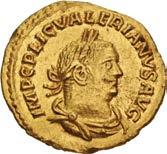

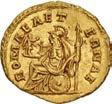

530. Valerian I. AD 253-260. AV Aureus (18mm, 3.07 g, 4h). Samosata mint. 1st emission, AD 255-256. Laureate, draped, and cuirassed bust right / Roma seated left, holding Victory and vertical spear; shield leaning against throne. RIC V 51; MIR 36, 1678c; Calicó 3442; Hunter pl. 1, 6 (Rome); Adda –; Biaggi –; Jameson –; Mazzini –. Slight wave in flan, scrapes, marks. Near EF. A portion of the die engraver’s guide circle remains on the reverse. Very rare and missing from most collections. ($5000)
During the joint reign of Valerian and Gallienus, a pragmatic approach to ruling the vast empire was adopted, hopefully abating the difficulties of governing such vast territories by the previous emperors. The novel mechanism was to split the empire between the two Augusti, with Gallienus ruling in the West while Valerian campaigned (and ruled) in the East. The Persians were the most pervasive threat to the Empire at the beginning of Valerian’s reign, and it was obvious that Valerian would have to personally lead an army to combat them. Unfortunately for the Romans, Valerian’s army arrived too late to stop the Sasanians under Shahpur I from devastating the eastern provinces. The Sasanians at the time typically did not extensively occupy territory but rather raided it for gain. Valerian stayed in the East to mop-up and rebuild while Gallienus faced threats along the Rhine and Danube. During his Danube campaign, Gallienus opened the mint of Viminacium to have a mint located close to the imperial headquarters along the war front. In AD 257, Valerian joined Gallienus there. Not long after, word reached him that the Sasanians were once again invading, and Valerian left for the east in the spring of AD 258. This issue was likely made in anticipation of a hopeful upcoming victorious conclusion to the conflict. But such optimism was in vain. Valerian was captured by Shahpur in AD 260, becoming the first Roman emperor to ever be captured by a foreign enemy. News of his capture gave impetus for massive invasions by Alamanni, Franks, and Juthungi across the Rhine and Danube frontiers, and emboldened the Goths’ sea raids. These events prevented Gallienus from ever attempting to lead an army east to rescue his father, who died as a captive in a foreign state.


531. Gallienus. AD 253-268. Æ Medallion (32mm, 21.36 g, 12h). Struck AD 262. Laureate head right / The three Monetae standing left, each holding scales in their right hand and cornucopiae in their left. Gnecchi pl. 114, 2; MIR 36, 760a; Banti 39. Dark green patina, slight roughness. Fine. ($500)
Ex Classical Numismatic Group Electronic Auction 107 (2 February 2005), lot 191.
The reverse of this medallion depicts the tres Monetae, female personifications of the three metals of gold, silver, and bronze, and commemorates the monetary reform implemented by Valerian I and Gallienus in response to a near total economic collapse of the empire.



532. Saloninus. AD 260. AR Antoninianus (22mm, 2.30 g, 6h). Colonia Agrippinensis (Cologne) mint. Radiate and draped bust right / Spes advancing left, holding flower and raising hem of skirt. RIC V 14 (Lyon) corr. (Spes advancing left, not right); MIR 36, 917f; RSC 94. Toned, struck from a worn reverse die as usual. VF. A very rare issue of Saloninus as Augustus. ($500)
Ex Numismatik Naumann 106 (1 August 2021), lot 741.
After the death of his brother Valerian II, Saloninus was given the rank of Caesar and sent to Cologne to oversee the western provinces. He was aided by Silvanus, the praetorian prefect, and Postumus, the governor of Upper (or Lower) Germany. But after the death of Valerian I, Postumus usurped power by being hailed as emperor by his troops, and he laid siege to Cologne, the site of Saloninus’ court. After holding the rank of Augustus for a very brief period, in which this coin was struck, the unfortunate Saloninus was executed by Postumus. Postumus then constructed a triumphal arch commemorating his victory over the young emperor.

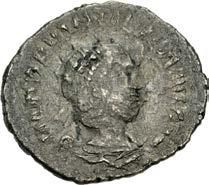

533. Dryantilla. Augusta (Usurper), AD 260. Antoninianus (23mm, 3.76 g, 7h). Carnuntum mint. Struck under Regalianus. Draped bust right, wearing stephane, set on crescent / AETERNITATI AVG, Sol, radiate, standing left, raising hand and holding globe. GMP 5 (this coin); RIC IV –; MIR 43, –; Göbl, Regalianus und Dryantilla –; RSC –. Toned, roughness. Good Fine. Overstruck on an antoninianus of Gordian III (RIC IV 83). ($2000)
Ex S & S Collection (Classical Numismatic Group Electronic Auction 525, 20 October 2022), lot 1257; New York Sale XI (11 January 2006), lot 328; Lanz 26 (5 December 1983), lot 846.
Sulpicia Dryantilla was the wife of of the usurper Regalianus. Little is known about her other than that she was the daughter of Sulpicius Pollio, an officer and senator under Caracalla, and Claudia Ammiana Dryantilla, a possible descendent of the Lycian senator Claudius Dryantianus. Shortly after her husband’s usurpation, she was given the title of Augusta. She was most likely killed along with her husband following his defeat.

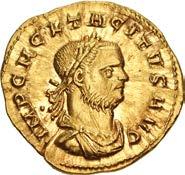

534. Tacitus. AD 275-276. AV Aureus (20mm, 4.15 g, 6h). Serdica mint. 1st emission, November-December AD 275. Laureate and draped bust right / Pax standing left, holding olive branch and long transverse scepter. RIC V Online 3855 corr. (bust type); RIC V –; BN 439; Calicó 4074a (same dies as illustration); Hunter –; Adda –; Biaggi –; Jameson –; Mazzini –. Lustrous, flan crack, faint hairlines, some smoothing, a couple of scratches on obverse. Near EF. Extremely rare; three examples listed in RIC V Online, missing from most major collections. ($5000)



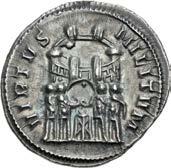
535. Maximianus. First reign, AD 286-305. AR Argenteus (19mm, 3.09 g, 12h). Ticinum mint. 1st emission, AD 294295. Laureate head right / VIRTVS MILITVM, the four Tetrarchs sacrificing over tripod before city enclosure with six turrets. Gautier, Argent 14; RIC VI 18b; Jeločnik 36; RSC 622d. Beautiful deep iridescent toning, light cleaning scratches on obverse. EF. ($500)
Ex Classical Numismatic Group 114 (13 May 2020), lot 991; Spink 261 (27 March 2019), lot 378; Kress 142 (21 July 1969), lot 454.
In AD 294-295, the newly minted Tetrarchy of Roman rulers introduced a new coin of good silver the same size and weight as the old denarius of Nero struck 230 years earlier. The new coin, called an argenteus nummus, was a critical part of Diocletian’s plan to restore confidence in the economy and government. The new silver piece was issued with the names and portraits of all four rulers of the First Tetrarchy—the senior emperors (Augusti) Diocletian and Maximianus, and the junior emperors (Caesares) Galerius and Constantius Chlorus. Rendered in the “hard” artistic style of the time, the portraits appear very similar, emphasizing the government’s unity, although there are subtle differences that distinguish the four rulers. Reverses stressed the Empire’s new status as a secure fortress, showing either the four Tetrarchs sacrificing before a circuit of walls, or a military camp gate surmounted by turrets. The argenteus was struck at mints throughout the Empire, with the mint cities sometimes indicated by a letter or letters on the reverse. Intended to stabilize the Roman economy and eliminate inflation, the argenteus seems to have had the opposite effect, as the coins were widely hoarded for their silver content, rather than circulating in daily commerce.

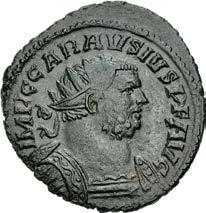
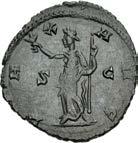
536. Carausius. Romano-British Emperor, AD 286-293. Antoninianus (22mm, 3.72 g, 6h). ‘SC’ mint. Struck circa AD 290-291. IMP C CARAVSIVS P F AVG, radiate and cuirassed bust right / PA X AVG, Pax, draped, standing left, holding olive branch in extended right hand and vertical scepter in left; S|C//–. RIC V.5 3402 (this coin cited and illustrated). Attractive dark brown patina, slight weakness. Near EF. Unique; the only example cited in RIC V.5. Attractive and with an ornately decorated cuirass. Fine style. ($500)
From the Hengist & Horsa Collection. Ex Dr. Malcolm Lyne Collection, purchased from Spink, 22 March 2002.
While Dr. Moorhead studied seventy examples of this type with the D1 bust (RIC V.5 3403), he, by contrast, knew of only this coin for the immensely rarer B1 bust.



537. Carausius. Romano-British Emperor, AD 286-293. Antoninianus (24mm, 3.46 g, 6h). ‘SC’ mint. Struck circa AD 290-291. IMP C CARAVSIVS P F AVG, radiate, draped, and cuirassed bust right / PR OV ID AVG, Providentia, draped, standing left, holding wand over globe set at feet to left and cornucopia; S|C//–. RIC V.5 3424 (this coin cited and illustrated). Dark olive brown patina with some red, some weakness. Good VF. Very rare. One of only fourteen examples cited in RIC V.5. The RIC V.5 plate coin. A very attractive example. ($500)
From the Hengist & Horsa Collection. Ex Dr. Malcolm Lyne Collection, purchased from Spink, 16 July 1999.


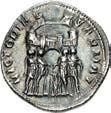
538. Constantius I. As Caesar, AD 293-305. AR Argenteus (19mm, 2.89 g, 6h). Ticinum mint. 1st unsigned emission, AD 294-295. Laureate head right / VICTORIA SARMAT, the four Tetrarchs sacrificing over tripod before city enclosure with six turrets. Gautier, Argent 11; RIC VI 17a; Jeločnik 39; RSC 286a. Beautiful deep iridescent toning, struck with a somewhat worn reverse die. EF. ($500)
Ex Triton XVII (7 January 2014), lot 788.
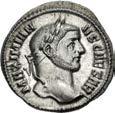
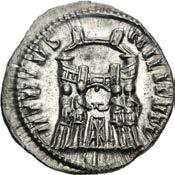

539. Galerius. As Caesar, AD 293-305. AR Argenteus (19mm, 3.10 g, 12h). Ticinum mint. 1st emission, AD 294-295. Laureate head right / VIRTVS MILITVM, the four Tetrarchs sacrificing over tripod before city enclosure with six turrets. Gautier, Argent 8p (this coin, illustrated); RIC VI 15b; Jelocnik 26; RSC 220a. Iridescent toning, struck with worn obverse die, underlying luster. EF. ($500)
Ex Classical Numismatic Group 85 (15 September 2010), lot 1190.
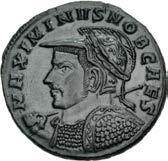


540. Maximinus II. As Caesar, AD 305-309. Æ Follis (27mm, 9.36 g, 12h). Aquileia mint, 3rd officina. Struck circa AD 305-306. Laureate, helmeted and cuirassed bust left, holding ‘scepter’ over shoulder and shield / Maximinus, wearing military attire, on horseback riding right, holding shield, spearing and trampling two fallen enemies: one prostrate on the ground beneath horse raising left hand, and the other kneeling left, raising both hands; shield below horse; AQΓ. RIC VI 68b. Dark brown surfaces, slight die wear and weakness to strike. EF. Rare. A very sharp portrait. On some of the dies for this issue the spear over Maximinus’ shoulder is cut erroneously as a scepter. ($500)
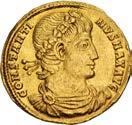


541. Constantine I. AD 307/310-337. AV Solidus (22.5mm, 4.47 g, 6h). Tricennalia issue. Siscia mint. Struck AD 335/6. Rosette-diademed, draped, and cuirassed bust right / Victory, draped at waist, seated right on cuirass, supporting shield set on left knee with left hand and inscribing VOT/ XXX on it in two lines with stylus held in right hand; to right, small nude genius standing left supporting the shield with both hands; an additional shield resting beside the cuirass to left; SIS. RIC VII 243; Depeyrot 1/1; Biaggi 2016. Toned, slightly wavy flan. Good VF. Very rare. ($2000)
Ex Peus 374 (23 April 2003), lot 1095; Künker 34 (8 October 1996), lot 667.
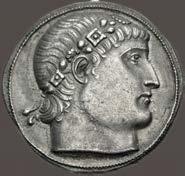

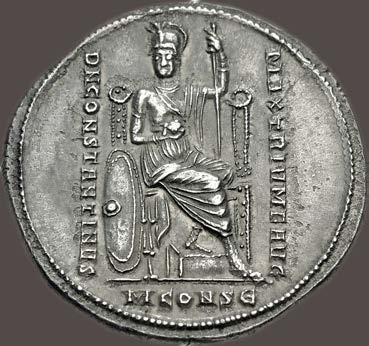
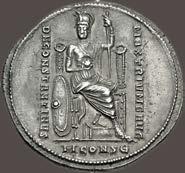
542. Constantine I. AD 307/310-337. AR Medallion of Five Siliquae (30mm, 17.29 g, 6h). Donative Struck to Commemorate the Dedication of the City of Constantinople. Constantinople mint, 5th officina. Struck AD 330. Laurel-androsette-diademed head right / D N CONSTANTINVS downward to left, MAX TRIVMF AVG downward to right, Roma, draped and wearing helmet, enthroned slightly right, head facing, holding globus and scepter; shield set on ground beside throne to left; M CONSЄ in exergue. RIC VII –; Gnecchi –; RSC –; D. Hollard, “Un rare multiple d’argent de Constantin Ier trouvé en Alsace” in BSFN 66.5 (May 2011), pp. 93-97, Type Roma var. (unlisted officina). Toned, slight porosity, minor metal flaw, minor marks. EF. Extremely rare and unique from this officina. ($20,000)
This medallic five siliquae series is extremely rare. Also known for the concurrent Constantinopolis/Tyche type (RIC VII 53; Gnecchi 11-13), the type depicting Roma, as is found here, is significantly rarer. Hollard knew of only three examples representing officinae 6 and 10 in his 2011 article. This Roma type was first discovered in Giessener Münzhandlung 71 (3 May 1995), lot 856, and the corpus of known examples has remained at three since the last new discovery in 2006. Until now. This magnificent specimen represents the 5th officina, is presently unique, and constitutes just the fourth known example for this impressive type which was almost certainly a donative to a high ranking official or a member of the city’s elite. Featuring a piercing gaze from Constantine and a wonderfully-detailed figure of Roma, this medallion is impressive and is a must-have item for a Constantinian collector or simply an appreciator of fine Roman art.

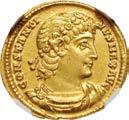


543. Constantine I. AD 307/310-337. AV Solidus (21mm, 4.52 g, 6h). Constantinople mint. Struck AD 335/6. Rosette-dieademed, draped, and cuirassed bust right / Victory standing left, holding wreath and palm; CONS. RIC VII 90; Depeyrot 5/1; Biaggi 1957; Mazzini 98 . In NGC encapsulation 6376282-001, graded AU, Strike: 5/5, Surface: 2/5, brushed, marks. ($4000)
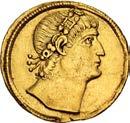

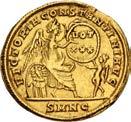
544. Constantine I. AD 307/310-337. AV Solidus (22mm, 4.38 g, 6h). Tricennalia issue. Nicomedia mint, 2nd officina. Struck AD 335/6. Rosette-diademed head right, eyes to God / VICTORIA CONSTANTINI AVG, Victory, draped at waist, seated right on cuirass, supporting shield set on left knee with left hand and inscribing VOT/ XXX on it in two lines with stylus held in right hand; to right, small nude genius standing left supporting the shield with both hands; an additional shield resting beside the cuirass to left; SMNC. RIC VII 175; Depeyrot 44/1; Biaggi 2025 var. (officina); Mazzini 617. Toned, trace deposits, some light marks. Good VF. Rare. ($4000)
Ex UBS 75 (22 January 2008), lot 1114; Spink Taisei 44 (22 October 1992), lot 65; Helbing 52 (24 October 1927), lot 3827.
Constantine’s ‘eyes to God’ coinage shows the emperor looking slightly upward, as if in the attitude of prayer. This new depiction, which seems to have been intentionally ambiguous, could be viewed by various groups within the empire in the context of their own hopes and aspirations. For a discussion of Constantine’s use of deliberately ambiguous language and imagery, see T.G. Elliot, “The Language of Constantine’s Propaganda,” TAPA 120 [1990], pp. 349-353 and H.A. Drake, Constantine and the Bishops: The Politics of Intolerance [Johns Hopkins, 2000], passim
For the Christians within the Roman Empire, who had suffered under a series of persecutions during the early fourth century AD, this new image could be interpreted as the culmination of God’s plan to defeat the pagans and create a new Christian Roman Empire. Eusebius, Bishop of Caesarea and biographer of the emperor, in his Vita Constantini (IV.15), specifically mentions these coins as an indication of Constantine’s piety: “The great strength of the divinely inspired faith fixed in his soul might be deduced by considering also the fact that he had his own portrait so depicted on the gold coinage that he appeared to look upwards in the manner of one reaching out to God in prayer. Impressions of this type were circulated throughout the entire Roman world.” This new imagery was also replicated on statues erected throughout the empire, a fact also mentioned by Eusebius: “His portrait also at full length was placed over the entrance gates of the palaces in some cities, the eyes upraised to heaven, and the hands outspread as if in prayer.” For contemporary Christians, this portrait was a clearly visible sign of imperial support for them. Likewise for Eusebius, whose imperial biography was intended in part to present Constantine as the paradigm of the new Christian emperor and is the source for this interpretation of the coins, this new image served to validate his argument that Constantine was truly a Christian prince.
For non-Christians too, this new image could be interpreted in the context of their own viewpoints. The diademed portrait without the accompanying obverse legend recalls those royal Hellenistic portraits seen on the silver coinage of the successors of Alexander the Great and subsequent eastern monarchs (R.R.R. Smith, “The Public Image of Licinius I: Portrait Sculpture and Imperial Ideology in the Early Fourth Century,” JRS 87 [1997], p. 187 and note 99). Symbolizing royal authority, it appeared not only on the coinage of various Greek monarchies, but also on Roman Republican coinage where the mythical early Roman kings were depicted (cf. Marcia 28, showing Ancus Marcius). The use of the diadem, which appeared in an array of designs – from a simple plain band to ones which were more detailed and complex, eventually becoming an elaborate and jewel-encrusted construction – served to refigure Constantine in his role now as a Greek βασιλεύς, rather than a purely Roman princeps. Like Alexander the Great before him, Constantine also tried to balance the various and seemingly disparate elements of his new empire. Given that Constantine ruled over both Christian and non-Christian populations – neither of which he wished to alienate – his new portrait on these coins could convincingly appeal to the viewpoints of both.


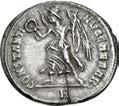
545. Constantine II. As Caesar, AD 316-337. AR Siliqua (19mm, 3.27 g, 6h). Rome mint. Struck under Constantine I, AD 336-337. Diademed head right, eyes to God / Victory advancing left, holding wreath and palm frond; R. RIC VII 378; RSC 76a. Toned, flan crack, slight porosity, scratches, minor die wear on reverse. Good VF. Very rare. ($750)
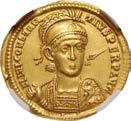

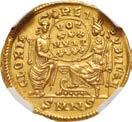
546. Constantius II. AD 337-361. AV Solidus (21.5mm, 4.50 g, 6h). Tricennalia issue. Nicomedia mint, 2nd officina. Pearl-diademed, helmeted, and cuirassed bust facing slightly right, holding spear over shoulder and shield decorated with horseman motif / Roma, holding spear and head facing, and Constantinopolis, head left, holding scepter and foot on prow, seated on thrones facing one another, holding between them wreath inscribed VOT/ XXX/ MVLT/ XXXX in four lines; SMNS. RIC VIII 74; Depeyrot 5/2; Biaggi 2139. In NGC encapsulation 4374654-006, graded Ch AU, Strike: 4/5, Surface: 3/5, edge scuff. ($1000)
Ex Jonathan K. Kern Collection.
Of all of the sons of Constantine I, Constantius II was perhaps the most ambitious. Appointed Caesar shortly after Chrysopolis in AD 324, he spent the remaining years of his father’s reign campaigning with his brother Constantine II in Gaul. Returning to Constantinople shortly before his father’s tricennalia, he was present at his father’s death and may have orchestrated the purge of the relatives of Theodora shortly thereafter. As emperor, Constantius II was engaged in a renewed war against Persia during the vicennalia celebrations. During this same period, his brother, Constans, had successfully campaigned both in Britain and in the upper Danube, so that, as the senior emperor of the two, Constantius II enjoyed the good fortune of victory on the Western fronts while he managed affairs with the Sasanians in the East. Upon Constans demise, however, Constantius would be forced to return West to deal with the threat of the usurper Magnentius.



547. Constantius II. AD 337-361. AV Solidus (21mm, 4.61 g, 12h). Cyzicus mint, 3rd officina. Struck circa AD 340-circa 350. Pearl-diademed, draped, and cuirassed bust right / Victory advancing left, holding wreath inscribed XXV in right hand, extending palm frond held in left hand and cradling trophy in left arm; to left, Persian captive kneeling facing, head right, raising both hands; SMKΓ. RIC VIII – but cf. 55 (for type at Constantinople); Depeyrot – but cf. 2/1 (same); Triton VIII, lot 1259. Toned, with some luster, minor deposits, some light hairlines, small die breaks on reverse. Near EF. Extremely rare and unpublished. Known from only four examples in CoinArchives for Cyzicus. Presently unique from the 3rd officina. ($2000)
It is not presently possible to give more specific dating for this rare series known for Constantinople, Nicomedia, Cyzicus, and Antioch. Kent and Depeyrot both date the series to AD 340-351, however, given that rare examples exist for Constans, one can place the issue between 340 and 350. While this issue likely commemorates a victory over the Sasanians given the presence of the Persian captive on the reverse, which victory specifically during the long war between Constantius and Šābuhr (Shahpur) II is uncertain.
This extremely rare coin is the fifth known for Cyzcius and the only example from the 3rd officina. Additionally, it features both new obverse and reverse dies from the other known examples, the corpus of which is as follows:
1) Triton VIII (11 January 2005), lot 1259.
2) Numismatik Lanz München 135 (21 May 2007), lot 956.
3) Glacier Rams Solidi Collection (Stack’s Bowers Galleries August 2020 Auction, 5 August 2020), lot 20156; Heritage 3073 (25 April 2019), lot 30325.
4) Emporium Hamburg 107 (9 December 2024), lot 970.
5) The present example. Classical Numismatic Group 130 (23 September 2025), lot 547.
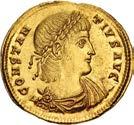


548. Constantius II. AD 337-361. AV Solidus (22mm, 4.48 g, 12h). Antioch mint, 8th officina. Struck AD 337-347. Laureate, draped, and cuirassed bust right / Victory advancing left, holding trophy and palm frond; d|LXXII//SMANH. RIC VIII 7 var. (unlisted officina); Depeyrot 2/2 var. (same). Toned, with some luster, minor doubling, minor marks. Superb EF. Very rare and presently unique from this officina. R4 in RIC and with only seven known to Depeyrot in his 2004 corpus. Two others in CoinArchives; thus a total of ten known (including this coin) for the issue. ($1500)
The LXXII numeral on this issue denotes that this solidus was struck at a fixed weight standard of 1/72nd of a Roman libra (pound) of gold.
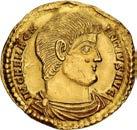
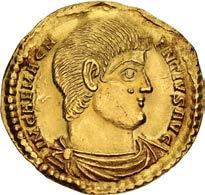
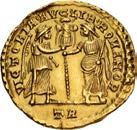
549. Magnentius. AD 350-353. AV Solidus (23mm, 4.20 g, 6h). Treveri (Trier) mint. Struck AD 350. Bareheaded, draped, and cuirassed bust right / Victory, holding palm frond, standing right, and Libertas standing left, holding transverse vindicta, both supporting trophy on shaft between them; TR. RIC VIII 247; Bastien 7; Depeyrot 8/1; Biaggi 2197; Mazzini 46v. Lightly toned, some edge marks, slight wave in flan. EF. ($2500)
Ex Classical Numismatic Group Electronic Auction 484 (27 January 2021), lot 913; InAsta 80 (23 March 2019), lot 280.
Born around AD 303 to a British father and Frankish mother, Flavius Magnus Magnentius showed enough talent to rise high in the Roman army. In the 340s, the western emperor Constans appointed Magnentius as commander in his personal guard. Whatever Magnentius’ merits, gratitude was not among them, for in January AD 350, he staged a successful coup deposing his benefactor. Constans, who had made himself unpopular with the army, attempted to flee to his brother Constantius II, emperor of the East, but was captured and executed. After securing control of Italy, Magnentius attempted to negotiate with Constantius, but the eastern emperor would hear none of it. Taking a year to marshal his forces, Constantius struck in the summer of AD 351, but Magnentius defeated his initial thrust into Italy and went on the offensive, seizing the strategic town of Siscia and forcing a major engagement in the Balkans. The clash at Mursa on September 28, AD 351 proved one of the costliest battles in Roman history, leaving the ground strewn with 55,000 dead. Magnentius fared much the worse and retreated into Gaul. Constantius took his time in pursuit, invading Italy the following year and methodically tightening the noose around Magentius, who was forced to take refuge in the city of Lugdunum. Rather than surrender, Magnentius fell on his sword in August of AD 353. Although a usurper, Magentius had a long-lasting impact on the Roman Empire through the agency of his young widow, Justina, who later married Valentinian I and became a lynchpin in future dynastic politics.



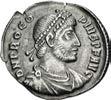


551. Procopius. Usurper, AD 365-366. AR Siliqua (18mm, 1.68 g, 12h). Constantinople mint, 3rd officina. Pearldiademed, draped, and cuirassed bust right / VOT/ V in two lines within laurel wreath with large central jewel; •C•Γ. RIC IX 13.11; RSC 14†d. Toned, compact flan, tiny edge split. Good VF. Scarce. ($500)
A maternal cousin of Julian II, Procopius had a successful career as a civil servant and was made a comes, or count, after Julian won the throne in AD 361. When Julian prepared his invasion of Persia a year later, he placed Procopius in command of a 30,000-man force intended to join with the allied Armenian army and Julian’s legions in Mesopotamia. Procopius later claimed that his cousin also gave him a purple cloak, along with instructions to succeed him as emperor should Julian be killed in battle. Regardless of the validity of this claim, Procopius failed miserably in his role, contributing to the defeat of Julian’s main force and his death in battle on June 27, AD 363. When the army chose Jovian as emperor, Procopius made no protest and took Julian’s body back to Tarsus for burial. But when Jovian abruptly died a few months later and the brothers Valentinian I and Valens came to power, Procopius decided to make a bid for the throne. While Valens was away from the capital, Procopius re-emerged at Constantinople on September 28, AD 365, wrapped in Julian’s purple cloak. The garrison proclaimed him emperor, and Procopius quickly established control of western Asia Minor. But he showed little strategic sense and soon some of his best officers and soldiers began defecting back to Valens. Meanwhile, Valens built his own forces and maneuvered Procopius into a decisive battle at Nicolea, Phrygia in May of 366. Procopius suffered a crushing defeat and was summarily executed in the aftermath, ending his eight-month usurpation.

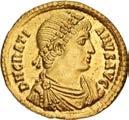
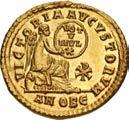
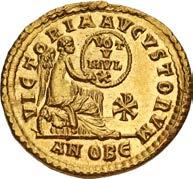
552. Gratian. AD 367-383. AV Solidus (21mm, 4.40 g, 6h). Antioch mint, 5th officina. Struck AD 367-375 (or AD 372). Rosette-diademed, draped, and cuirassed bust right / Victory, draped at waist, seated right on cuirass, supporting shield set on left knee with left hand and inscribing VOT/ V/ MVL/ X on it in four lines with stylus held in right hand; shield resting beside the cuirass to left; Christogram to right; ANOBЄ. RIC IX 21c var. (unlisted officina); Depeyrot 38/10 var. (obv. legend). Toned and lustrous, light hairlines. EF. Very rare. ($1000)
Flavius Gratianus was the son of Valentinian I, one of the last capable Western Roman rulers. In AD 367, at the age of eight, Gratian was proclaimed co-Augustus by his father. Only eight years later, in AD 375, Valentinian suffered an apoplectic stroke and died, leaving the western throne to the 16-year-old Gratian. A few days later, a cabal led by Gratian’s stepmother proclaimed his five-year-old half-brother, Valentian II, as co-emperor. To his credit, Gratian agreed to share power with his sibling. Gratian established his court at Trier, Germany. Gratian was a devout Christian and was the first emperor to refuse the title of Pontifex Maximus. In AD 378, Gratian was on his way east with reinforcements to fight the Goths when his uncle, the Eastern Emperor Valens, was killed in the catastrophic battle of Adrianople. After careful deliberations, Gratian chose the capable Theodosius I as Valens’ replacement. Gratian’s youth and ability seemed to promise a long reign, but in AD 383 the duke of Britain, Magnus Maximus, proclaimed himself emperor and crossed the channel. Gratian advanced to Paris to intercept him, but his troops, angered at his earlier refusal to raise their pay, deserted to the usurper. Gratian fled toward the Alps, but was overtaken at Lugdunum and executed on 25 August, AD 383, at the age of 24.



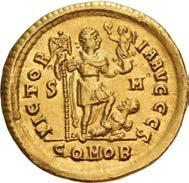
553. Theodosius I. AD 379-395. AV Solidus (21mm, 4.49 g, 12h). Constantinople (or uncertain military) mint, 6th officina. Struck AD 393-395. Pearl-diademed, draped, and cuirassed bust right / Theodosius, wearing pearl-diadem and military attire, standing right, foot spurning bound captive laying to right and holding labarum and Victory on globe left; S|M/S//COMOB. RIC IX 14a var. (Sirmium; unlisted officina); Depeyrot 35/5 (Theodosius II; Sirmium). Toned, minor marks. Good VF. Very rare. ($1000)
The attribution of the mint for this series of solidi has been the matter of some scholarly debate. J.W.E. Pearce likely dates the issue correctly in RIC IX, however, he somewhat controversially identifies the mint as Sirmium. While this may seem reasonable given the S M across the field (which is found on many earlier issues of that mint), there are significant issues with claiming that this series (known also for Arcadius and Honorius) belongs to the Sirmium mint. Ulrich-Bansa suggested that the S M on this issue refers not to Sirmium but to Sacra Moneta and that the coinage was a product of either Constantinople or Thessalonica (or a combination of the two). This attribution was followed by Grierson and Mays in DOCLR (1992) and later by Kent in RIC X. Kent explains that: “The attribution to Sirmium ... is difficult to accept historically... since the eastern court was certainly at Constantinople during most of the period of issue, it is simpler to recognize it as a coinage of that city ... The possibility that the palatine moneyers were out-stationed for at least part of the time shoulder however be retained” (Kent, 1994, p. 36).
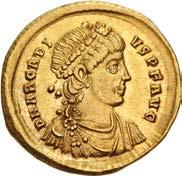



554. Arcadius. AD 383-408. AV Solidus (19.5mm, 4.42 g, 6h). Constantinople (or uncertain military) mint, 2nd officina. Struck AD 395-397. Pearl-diademed, draped, and cuirassed bust right / Arcadius, wearing pearl-diadem and military attire, standing right, foot spurning bound captive laying to right and holding labarum and Victory on globe left; S|M/B//COMOB. RIC X 1; Depeyrot 34/1. Toned with some luster, minor hairlines. Good VF. Rare. ($1000)
For the attribution of this series to the Constantinople mint, see lot 553 above.

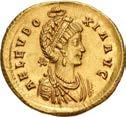


555. Aelia Eudoxia. Augusta, AD 400-404. AV Solidus (20.5mm, 4.45 g, 6h). Constantinople mint. Struck under Arcadius, AD 402-circa 403. Pearl-diademed and draped bust right, wearing earring and necklace; being crowned by manus Dei above / Victory, draped, seated right on cuirass, supporting shield set on left knee with left hand and inscribing a Christogram on it with stylus held in right hand; shield resting beside the cuirass to left; CONOB. RIC X 28; Depeyrot –; Füeg, Corpus 10. Attractively toned with some luster, thin scrape, light hairlines. EF. Very rare. ($3000)
Aelia Eudoxia was a devout Christian and opponent of the heretical Arians. Nonetheless, Eudoxia found herself at odds with other Christian leaders. Her husband, the emperor Arcadius, showed little interest in serving as the benefactor of Christianity in the empire. Eudoxia subsequently stepped in to fill the void and became quite active in Church patronage. However, after the consul Eutropius was banished from the imperial court and subsequently executed, a friction developed between Eudoxia and the beheaded consul’s ally, the Patriarch of Constantinople, John Chrysostom. Eutropius had initially helped install Eudoxia as empress by arranging her marriage to Arcadius. However, the consul fell out of favor with Eudoxia and other officials and additionally developed a bad reputation leading to his downfall. John Chrysostom’s efforts delayed Eutropius’ execution, but within a year the consul lost his head. A damnatio memoriae was additionally issued against the disliked consul.
Tensions worsened between the two major figures in Constantinople’s church life, the Empress and the Patriarch, when Eudoxia took umbrage at comments made by John in his sermons condemning women’s elaborate dress, which Eudoxia took as aimed at herself. Eudoxia found cause against John on account of his failure to rebut Origen, the famous scholar from Alexandria whose teachings had found him out of favor with a number of church officials. Eventually, Eudoxia and her allies succeeded in ousting the Patriarch. However, his exile was short-lived. The populace threatened revolt and an earthquake suddenly struck, which Eudoxia interpreted as a sign of God’s displeasure. The reconciliation was not to last. Not long thereafter John denounced the dedication of a statue of Eudoxia (one pillar of which survives to this day) and compared her to Herodias demanding the head of John the Baptist. The lawyer and historian Salamanes Hermias Sozomenos, or Sozomen, recounts the incident in his Historia Ecclesiastica, writing, “Herodias is again enraged; again she dances; again she demands the head of John in a basin” (Sozomen, Book VIII, Chapter 20). This led to a second trial of John. After the second trial “John held no more assemblies in the church, but quietly remained in the episcopal dwelling-house” (ibid, Chapter 21). He subsequently survived an assassination attempt before being ordered into exile. Once the people discovered his exile, a riot broke out and amidst the chaos “the church was suddenly discovered to be on fire.” Subsequently, “[both] parties mutually accused each other of incendiarism” (ibid, Chapter 22). A mass arrest of John’s allies followed. Eudoxia’s victory was not to last, however, and she died shortly thereafter from an infection due to a failed seventh pregnancy.
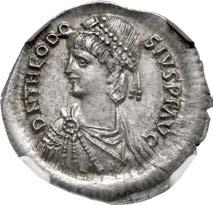


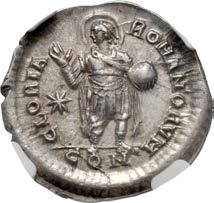
556. Theodosius II. AD 402-450. AR Light Miliarense (24mm, 4.18 g, 12h). Constantinople mint. Struck circa AD 408420. Pearl-diademed, draped, and cuirassed bust right, head left / Theodosius II, nimbate, wearing military attire and draped, standing facing, head left, raising right hand and holding globe; d|–//CON. RIC X 370; RSC 20A. In NGC encapsulation 6558052-003, graded Ch AU, Strike: 5/5, Surface: 5/5. ($1000) Ex Schulman 377 (19 October 2023), lot 63.

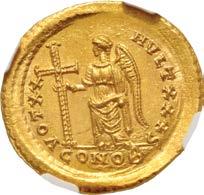
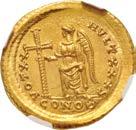
557. Theodosius II. AD 402-450. AV Solidus (21.5mm, 4.46 g, 1h). Vicennalia issue. Constantinople mint, 6th officina. Struck AD 423-425. Pearl-diademed, helmeted, and cuirassed bust facing slightly right, holding spear over shoulder and shield decorated with horseman motif / VOT XX MVLT XXX, Victory standing left, holding long cross; S//CONOB. RIC X 219; MIRB 15a; Depeyrot 74/2; Biaggi –. In NGC encapsulation 2154299-002, graded Ch MS, Strike: 5/5, Surface: 5/5. ($1500)



558. Theodosius II. AD 402-450. AV Solidus (21mm, 4.42 g, 6h). Tricennalia issue. Constantinople mint, 6th officina. Struck AD 430-440. Pearl-diademed, helmeted, and cuirassed bust facing slightly right, holding spear over shoulder and shield decorated with horseman motif / VOT XXX MVLT XXXX, Constantinopolis seated left on throne, foot on prow, holding globus cruciger and scepter; shield to right side of throne; star to right; S//CONOB. RIC X 257; MIRB 25; Depeyrot 81/1; Biaggi –. In NGC encapsulation 2154299-005, graded MS, Strike: 5/5, Surface: 4/5, edge marks. ($750)




559. Bonifatius. Comes Africae, AD 422-431. Æ (8.5mm, 0.63 g, 12h). Carthage mint. Struck circa AD 423-circa 425. [DOMINO NO]STRO, pearl-diademed, draped, and cuirassed bust right / Cross within church. RIC X 3812 var. (no globe). Dark brown patina, slightly off center, porosity. Good Fine. Extremely rare. There appears to be no globe beneath the cross on this coin as is found on the example cited and illustrated in RIC X. It has alternatively been suggested that this series constitutes a later Vandallic issue. However, the attribution to Bonifatius has been retained here. ($1500)
Bonifatius was a successful and decorated general in the Western Roman Empire at a time when competent military leadership was desperately needed. Dispatched first to Southern Gaul to confront the Visigoths at Massilia and then to Spain to face the Vandals, Bonifatius was rewarded for these successes by being appointed comes Africae and subsequently reassigned to Roman North Africa. The death of the Western Emperor Honorius in AD 423, however, forced Bonifatius to make a choice, support the successful western rebel emperor Johannes, or face isolation in the West and hope for the Eastern government to prevail in the long term against the entrenched usurper. Bonifatius elected to pursue the latter of the two strategies despite the leaders of the other Western provinces choosing to acknowledge Johannes. Bonifatius, however, had one advantage in choosing to stand against Rome––he controlled African grain shipments to Italy. As such, Bonifatius suspended deliveries to the rebel Johannes and made his allegiance to the government in Constantinople clear.
After a year and a half, the eastern forces led by the patrician and magister militum Aspar successfully overthrew Johannes and Honorius’ nephew was installed as Western Emperor Valentinian III.
Concurrently, one of Johannes’ kuropalates, Flavius Aëtius, sued for peace with Galla Placidia, Valentinian’s mother, and was brought into the official military structure as comes et magister militum of Gaul. Aëtius would ultimately serve as a foil to Bonifatius. The rivalry between Aëtius and Bonifatius developed until Aëtius convinced Galla Placidia that Bonifatius was disloyal. Bonifatius refused to answer summons and face potential execution for treason and instead allied with his once-enemies, the Vandals. Bonifatius reportedly encouraged King Genseric to migrate his forces to Bonifatius’ sphere of influence in North Africa and serve him as mercenaries. However, relations were soon restored between Bonifatius and the government and he informed the Vandals that they should relocate from North Africa back to Spain. Infuriated, the Vandals warred against Bonifatius and besieged him at the provincial capital and home of Saint Augustine, Hippo Regius. During the siege the celebrated bishop died. Bonifatius and a large portion of the city’s Roman populace abandoned the city to the Vandals and escaped to Italy. The city was laid to waste by the Vandals though they notably spared Augustine’s cathedral and library. The Vandals subsequently held North Africa for the next century.
In Italy, the rivalry between Bonifatius and Aëtius spilled out into open war. The two forces met at Rimini in AD 432. Bonifatius was victorious and Aëtius fled and sought refuge with the Huns in Pannonia. However, Bonifatius was mortally wounded in the battle and perished, ending his colorful career.
These rare coins usually feature either the legend Domino Nostro or Dominis Nostris. As such, it has been suggested that they be divided into two series: the first stuck during Johannes’ usurpation demonstrating Bonifatius’ fealty to Eastern Emperor Theodosius II, and the second acknowledging both Theodosius and Valentinian. This coin would consequently belong to the first period.
Interestingly, this reverse type has been cataloged as a temple façade; however, this seems unlikely given the Christian context in which the coin was struck. As such, perhaps it is more accurate to classify the reverse type as a church building rather than a temple; especially given the presence of a cross within the structure. This reverse type is extremely rare for the series and, if indeed a church, would be one of very few depictions of a church on an ancient numismatic item and the only one from this time period.


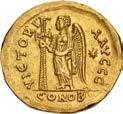
560. Basiliscus. AD 475-476. AV Solidus (20.5mm, 4.47 g, 6h). Constantinople(?) mint. Pearl-diademed, helmeted, and cuirassed bust facing slightly right, holding spear over shoulder and shield decorated with horseman motif / Victory standing left, holding long jeweled cross; d to right; CONOBR (sic). RIC X 1003 var. (no R); Depeyrot 101/1 var. (same). Toned, traces of underlying luster, minor marks, light scuff at edge. Near EF. Very interesting with the addition of an R after CONOB. ($750)
From the Wayne Scheible Collection.
Basiliscus was the brother of the East Roman Empress Verina, wife of Leo I. In 468, Leo put him in command of an immense task force sent to recover North Africa from the Vandals. The entire costly enterprise came to grief when the Vandals set fire to the fleet while at anchorage, a disaster partly caused by the failure of Basiliscus to take basic precautions. Probably due to Verina’s influence, Basiliscus escaped consequences for the debacle. Upon the death of Leo in AD 474, Verina tried to arrange affairs so she could rule the Empire through her son-in-law Zeno and her infant grandson Leo II. When the boy died and Zeno began to take charge of affairs on his own, Verina hatched another scheme to put her lover, Patricius, on the throne with the help of Basiliscus, who controlled the city garrison. Zeno was induced to flee Constantinople, and Basiliscus seized the throne for himself and enraged his powerful sister by executing Patricius. But Basiliscus proved to be as hapless as emperor as he was as a general. After 20 chaotic months, Zeno reentered the capital in August, 476 and deposed Basiliscus in a bloodless coup. Basiliscus and his family were exiled to Cappadocia and starved to death, fulfilling Zeno’s promise not to “shed their blood.” The anarchy which gripped the Eastern Empire throughout AD 475-476 notably prevented it from intervening in Western affairs during this time.




561. Odovacar King, AD 476-493. AR Half Siliqua (13mm, 0.71 g, 12h). In the name of Zeno. Mediolanum (Milan) mint. Struck AD 476-491. Pearl-diademed, draped, and cuirassed bust right / Eagle standing right on prow, head left, wings extended; cross above. RIC X 3623; Toffanin 547/2; RSC 13a; MEC 1, 61. Deep iridescent tone, holed, graffiti on obverse. Near VF. ($500)
From an American Academic Collection.
Traditionally, the reign of Flavius Odovacar (AD 476-493) has been seen as the end of the Western Roman Empire and the beginning of the Middle Ages in the West. A member of the foederati – allied Germanic tribes who served in the Roman army in return for land – Odovacar was appointed their leader in Italy in AD 475 by the magister militum Orestes, who promised in return a third of the Italian peninsula if Odovacar and his Germans would assist Orestes’ revolt against the western emperor, Julius Nepos. Following the defeat of Nepos, Orestes elevated his son, Romulus, to the rank of Augustus, and immediately set about revoking his earlier arrangement with the foederati. Now, Odovacar revolted against Orestes, who was defeated, captured, and executed. Subsequently, Odovacar was proclaimed rex Italiae and, on 4 September AD 476, he compelled the young Romulus to abdicate, sending the imperial insignia to Zeno in Constantinople, and thus ending Roman imperial rule in the West. During his reign, he provided his foederati with lands in Italy and made them beneficiaries of a special tax. He retained the Roman administration, senate, legal institutions, and tax system – all of which gained him the support of the senate and people. This popularity, along with Odovacar’s military successes against the Vandals and his alliances with the Visigoths and Franks, prompted Zeno, the Roman emperor in the East, to remove Odovacar from power. In AD 488, Zeno called on the Ostrogothic king, Theoderic, to overthrow Odovacar. Over the next five years, Theoderic slowly pushed Odovacar back to the old Roman capital at Ravenna where, after a protracted siege, in AD 493, Odovacar surrendered. Under the terms of the peace, Theoderic and Odovacer would share the rule of Italy. At the banquet arranged to celebrate this treaty, however, Theoderic killed Odovacar with his own hands and promptly proceeded to eliminate Odovacar’s family and supporters.



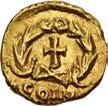
562. Odovacar. King, AD 476-493. AV Tremissis (12.5mm, 1.47 g, 6h). In the name of Zeno. Ravenna mint. Struck AD 476-491. D N ZEN PERP F AVC (sic), pearl-diademed, draped, and cuirassed bust right / Latin cross within wreath with large central jewel; COMO[B]. RIC X 3640 var. (obv. legend); Lacam pl. 53, 60; cf. Ranieri 217 (Zeno); cf. Depeyrot 43/8 (Milan); MEC 1, –. Toned, underlying luster, traces of deposits, marks and scrape on obverse. Near EF. Rare. ($750) Ex Gorny & Mosch 257 (15 October 2018), lot 1033.
End of Session 2
Session 3 – Wednesday, September 24, 2025 — 9 AM
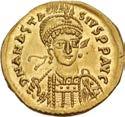


563. Anastasius I. 491-518. AV Solidus (20.5mm, 4.47 g, 6h). Constantinople mint, 10th officina. Struck 492-507. Helmeted and cuirassed bust facing slightly right, holding spear over shoulder and shield decorated with horseman motif / Victory standing left, holding long jeweled cross; d to right; I//CONOB. DOC 3i; MIBE 4a; SB 3. Toned, with some luster, a few light scratches. EF. ($500)
From the Wayne Scheible Collection. Ex Classical Numismatic Group 72 (14 June 2006), lot 1967.
Upon the death of Emperor Zeno, his widow, Ariadne, was tasked with appointing a successor to the throne. She selected Anastasius, a competent court official and married him, cementing her continued position as empress. Anastasius proved to be an effective ruler for his time, particularly in the area of finances. He completely reformed the coinage and his reforms fundamentally shaped the history of Byzantine coinage which then stood as a model system in stark contrast to the deteriorating situation in the west. Anastasius was also notably Greek Orthodox, a requirement the people requested during the appointment process. Anastasius I is considered to be the first Byzantine ruler on account of both the developments during his rule, and due to the diverging paths the eastern and western portions of what had long stood as the Roman Empire took during this time. This distinction, is however, largely convenient. The rulers and citizens of the eastern empire, ‘Byzantines,’ thoroughly considered themselves to be Romans and referred to themselves as such on their coinage. It was not until after the fall of the Byzantine state in the mid 15th century AD that western historians began referring to the eastern empire at this time as the ‘Byzantine’ Empire rather than the continuation of the Roman. In fact, it was even used as a derogatory distinction. Nonetheless, distinguished as the first Byzantine emperor, Anastasius laid the foundational groundwork essential for a successful civilization that is often overlooked or underappreciated. In but one facet, the financial largess that his policies created enabled Justinian I’s bold plans of reconquest and his expensive campaigns just a decade after Anastasius’ reign. Ultimately, the groundwork that Anastasius laid set the stage for a thriving civilization that endured for a millennium.
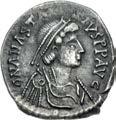
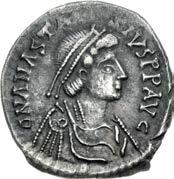

564. Anastasius I. 491-518. AR Light Miliarense (19mm, 4.11 g, 6h). Thessalonica mint. Struck circa 492-518. Pearldiademed, draped, and cuirassed bust right / Anastasius, pearl-diademed and wearing military attire, standing left, holding spear and resting hand on shield set on the ground to right; d to left; THSOB. DOC –; MIBE NN18; SB –. Toned, light find patina, light scuff on reverse. Good VF. Very rare. Fewer that approximately twenty examples known. In fine style for the type. ($500)

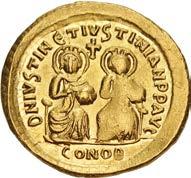

565. Justin I & Justinian I. 527. AV Solidus (21mm, 4.48 g, 6h). Constantinople mint, 6th officina. Struck 4 April-1 August. Justin and Justinian enthroned facing, both nimbate, both placing hand on chest and holding globus; cross between / Angel standing facing, holding long cross and globus cruciger; d to right; S//CONOB. DOC –; Metcalf, Joint Group Id, 16 (O8/ S4); MIBE 1d; SB 117. Toned and lustrous, a couple of areas of weakness, minor metal flaw. EF. Very rare. ($1000)
From the Wayne Scheible Collection. Ex Berk BBS 68 (13 November 1991), lot 28.
Justin was an illiterate peasant from Thrace who acquired the throne through his natural strengths and cunning. Though of little learning himself, he understood the value of education, especially for his relatives. Consequently, his nephew Peter was sent to Constantinople for his education. When Justin became emperor, his nephew was renamed Justinian and served as his trusted advisor. Justinian was the real driving force behind many of the wise policies adopted under the reign of his uncle and his true brilliance would come to light during his future sole reign. When Justin’s health began to fail in 527, Justinian was readily accepted as co-emperor and the transition of power was uneventful. The coming change was advertised by an extensive series of joint reign solidi, judging by the number of dies known. Presumably, these pieces were withdrawn from circulation after the accession of Justinian, accounting for their rarity today

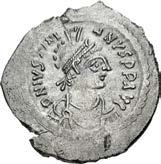

566. Justinian I. 527-565. AR Siliqua (18.5mm, 1.67 g, 6h). Constantinople mint. Struck 537-565. Diademed, helmeted, draped, and cuirassed bust right / Justinian, wearing military attire, standing facing, head right, holding spear and globus cruciger; d to right; COB. DOC 22; MIBE 50; SB 155. Toned, minor metal flaws and marks, crystallized and fragile. Good VF. Very rare. A most attractive bust of Justinian. Superior to most. ($500)
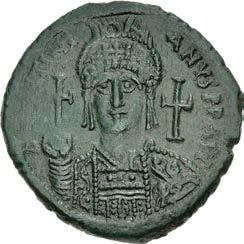

567. Justinian I. 527-565. Æ Follis (39mm, 23.13 g, 5h). Antioch (Theoupolis) mint, 3rd officina. Dated RY 16 (AD 542/3). Helmeted and cuirassed bust facing, holding globus cruciger, shield decorated with horseman motif on shoulder; cross to right / Large M, cross above; A/N/N/O - Xς (date) across field; Γ//cHЄЧPo. DOC 216a; MIBE 144a; SB 219. Dark green patina, minor spots of weakness, a few cleaning scratches. Good VF. Very rare. A very attractive bust. From a brief one-year issue between the Persian sack of the city in June 540 and the thralls of the Plague which reached the city circa AD 543. ($500)
Ex John Wright Collection; Berk BBS 114 (23 May 2000), lot 590; William Herbert Hunt Collection (Sotheby’s New York, 5 December 1990), lot 94.

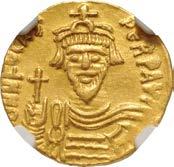
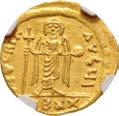
568. Phocas. 602-610. AV Solidus (19mm, 3.58 g, 6h). Light weight issue of 20 Siliquae. Constantinople mint, 10th officina. Struck 609-610. Crowned, draped, and cuirassed facing bust, holding globus cruciger / Angel standing facing, holding cross and globus; I//OBXX. DOC 14 var. (obv. legend and unlisted officina); MIBE 22; SB 629. Toned. In NGC encapsulation 3954519-010, graded AU, Strike: 4/5, Surface: 4/5. Very rare. ($750)
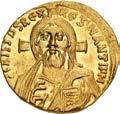


569. Justinian II. First reign, 685-695. AV Solidus (19.5mm, 4.45 g, 6h). Constantinople mint, 2nd officina. Struck 692-695. Nimate facing bust of Christ Pantokrator, raising hand in benediction and holding Gospels / Justinian standing facing, wearing crown and loros, holding cross potent set on two steps and akakia; B//CONOP. DOC 7b var. (officina not retrograde); MIB 8a; SB 1248. Toned, underlying luster, some weakness, light hairlines. Near EF. An outstanding Christ portrait. ($2000)
From the Wayne Scheible Collection, purchased from Harlan J. Berk.
The portrait of Christ that appears on this solidus issue marks the first representation of Christ on a coin. The Council in Trullo, or the Quinisex Council, was held during the reign of Justinian II in Constantinople following the Fifth and Sixth Ecumenical Councils. The assembly was called partly in order to address diverging practices in the east and west and to set church policy explicitly in written canons in order to discipline those who continued to engage in contrary practices. One of the canons set during the council concerned appropriate portrayals of Christ. Canon 82 cites 1st Corinthians 13:10 and makes use of similar language in Hebrews 10:1 to specify that “we decree that the figure in human form of the Lamb who takes away the sin of the world, Christ our God, be henceforth exhibited in images” (Quinisex Council, Canon 82). The text goes on to specify that Christ as a man ought be used in icons and visual depictions rather than the Agnes Dei. That same year, this issue of solidi was released into circulation by Justinian. The Council was very poorly received in the West and even denounced by some western thinkers. This monumental decision, however, greatly shaped the future of Byzantine coinage and concurrently stood in sharp contrast to the emergent Umayyad Caliphate’s contemporary practice of not depicting religious figures on coinage.
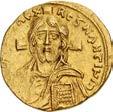


570. Justinian II. First reign, 685-695. AV Solidus (18.5mm, 4.45 g, 6h). Constantinople mint, 5th officina. Struck 692695. Nimate facing bust of Christ Pantokrator, raising hand in benediction and holding Gospels / Justinian standing facing, wearing crown and loros, holding cross potent set on two steps and akakia; Є//CONOP. DOC 7e; MIB 8a; SB 1248. Toned, minor mark, light deposits. Good VF. A well-struck Christ portrait. ($1500)
From the Wayne Scheible Collection.




571. Justinian II. First reign, 685-695. AR Hexagram (19mm, 6.56 g, 7h). Constantinople mint, 3rd officina. Struck circa 692-695. Nimate facing bust of Christ Pantokrator, raising hand in benediction and holding Gospels / Justinian standing facing, wearing crown and loros, holding cross potent set on two steps and akakia; Γ//[CONOP]. DOC 17; MIB 40; Yannopoulos Type II, 3-12; SB 1259. Attractively toned with light golden hues, slight porosity, minor clashing on reverse. Choice EF. Very rare. These hexagrams are struck with solidus dies. One of the finest known for this incredibly difficult and desirable issue. ($10,000)
From the Gasvoda Collection. Ex Iconodule Collection (Triton XXIII, 14 January 2020), lot 925.


572. Justinian II. First reign, 685-695. AR Hexagram (20mm, 6.68 g, 7h). Constantinople mint, 6th officina. Struck circa 692-695. Nimate facing bust of Christ Pantokrator, raising hand in benediction and holding Gospels / Justinian standing facing, wearing crown and loros, holding cross potent set on two steps and akakia; S//CONOP. DOC 17; MIB 40; Yannopoulos Type II, 3-12; SB 1259. Toned, deposits, some weakness. VF. Very rare. These hexagrams are struck with solidus dies. ($1000)



573. Leontius. 695-698. AV Solidus (19mm, 4.32 g, 6h). Constantinople mint, 3rd officina. Crowned facing bust, wearing loros, holding akakia and globus cruciger / Cross potent set on three steps; Γ//CONOB. DOC 1c; MIB 1; SB 1330. Toned and lustrous, spots of weakness, trace deposits. EF. ($750)
From the Wayne Scheible Collection. Leontius was appointed as the strategos of the Anatolic Theme by Justinian II’s father Constantine IV. Continuing into Justinian’s reign, Leontius was dispatched to combat the threat of the Umayyads. However, at the battle of Sabastopolis in 692, Leontius was defeated by the Umayyad army when the majority of his Anatolian Slavic forces defected. He was imprisoned by Justinian for this failure but released in 695 and appointed the strategos of Hellas. Not long thereafter, Leontius exploited dissatisfactions with Justinian’s reign among various factions and led a successful rebellion. Leontius subsequently had Justinian mutilated and exiled to Cherson, the Byzantine enclave in Crimea. However, soon thereafter the Umayyads invaded Byzantine North African and ultimately captured Carthage. The Byzantine naval forces that Leontius dispatched to recapture Carthage were unsuccessful. Fearing reprisal from the Emperor, the navy rebelled and proclaimed the droungarios of the Cibyrrhaeot Theme, Apsimar, as Emperor. Apsimar successfully besieged Constantinople and had Leontius mutilated and exiled to a monastery. However, Justinian II ultimately returned to power with the backing of the Bulgars. Upon reassuming imperial power, he had both usurpers, Leontius and Apsimar, executed.



574. Tiberius III (Apsimar). 698-705. AV Solidus (17.5mm, 4.34 g, 6h). Constantinople mint, 2nd officina. Crowned and cuirassed facing bust, holding transverse spear and shield decorated with horseman motif / Cross potent set on three steps; B// CONOB. DOC 1b; MIB 1; SB 1360. Toned, slightly clipped, hairline scratches and area of graffiti on reverse. EF. ($500)
From the Wayne Scheible Collection, purchased from Jonathan Kern.

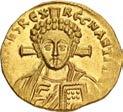


575. Justinian II. Second reign, 705-711. AV Solidus (20mm, 4.46 g, 6h). Constantinople mint. Struck 705. Nimbate facing bust of Christ Pantokrator, raising hand in benediction and holding Gospels / Crowned facing bust of Justinian, wearing loros, holding cross potent set on three steps and patriarchal globus cruciger inscribed PAX. DOC 1; MIB 1; SB 1413. Some luster, minor weakness. Superb EF. An excellent Christ portrait. ($1500)
From the Wayne Scheible Collection. Ex Berk BBS 68 (13 November 1991), lot 51.
Justinian II returned to power with a vengeance and, rather than attending to urgent matters of state, such as the Arab threat, was more preoccupied with settling scores from his initial overthrow. His second reign devolved into a reign of terror full of reprisals and revenge. Amidst these reprisals, Justinian dispatched an army to punish Cherson, were he had been initially imprisoned, but the army rebelled and proclaimed its general Bardanes as Emperor. Bardanes successfully took Constantinople and executed Justinian and his son Tiberius, thus ending the Heraclian dynasty.

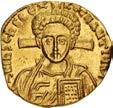


576. Justinian II, with Tiberius. Second reign, 705-711. AV Solidus (18.5mm, 4.34 g, 6h). Constantinople mint. Struck 705-711. Nimbate facing bust of Christ Pantokrator, raising hand in benediction and holding Gospels / Crowned facing halflength busts of Justinian and Tiberius, both wearing chlamys, together holding cross potent set on two steps between them. DOC 2a; MIB 2a; SB 1414. Lustrous, clipped, light edge scrape, light scratch, minor deposits. EF. All three portraits very clear and excellent. ($1500)
From the Wayne Scheible Collection, purchased from Harlan J. Berk.



577. Philippicus (Bardanes). 711-713. AV Solidus (21mm, 4.40 g, 6h). Constantinople mint, 1st officina. Crowned facing bust, wearing loros, holding globus cruciger and eagle-tipped scepter / Cross potent set on three steps; A//CONOB. DOC 1a; MIB 1; SB 1447. Toned and lustrous, slightly off center on obverse, minor mark at edge. Superb EF. ($1000)
From the Wayne Scheible Collection. Ex Berk BBS 81 (31 March 1994), lot 50.
During the first overthrow of Justinian II in 695, Bardanes made a tacit play for the throne. However, Leontius successfully took the purple before he could solidify his position. Under Tiberius III Apsimar, Bardanes was reassigned far away from the political scene at Constantinople and sent to the Ionian island of Cephalonia. However, Justinian later reassigned him to Cherson during his second reign following his resumption of power. It was during this campaign that the army revolted and proclaimed Bardanes as Emperor. Following his overthrow of Justinian, Bardanes (who took the name Philippicus) attempted to assert control over all of Byzantium’s possessions. However, he failed to secure the support of the Pope in Italy which led to a continuing deterioration of the untenable situation in Italy. Harboring heretical monophysite beliefs, Philippicus was additionally not readily accepted in Orthodox circles and went so far as to remove the Patriarch in favor of one favoring the monothelete heresy. His precarious position as Emperor was ultimately undone when the Bulgar Khanate under Khan Tervel invaded with the casus belli of avenging his ally Justinian. A military revolt broke out from the Opsikion theme in Thrace and Philippicus was overthrown.

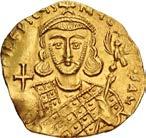

578. Philippicus (Bardanes). 711-713. AV Tremissis (15.5mm, 1.31 g, 6h). Constantinople mint. Crowned facing bust, wearing loros, holding globus cruciger and eagle-tipped scepter / Cross potent; CONOB. DOC 6; MIB 6; SB 1452. Toned, clipped, slightly bent, light hairlines. EF. ($500)


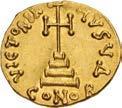
579. Anastasius II Artemius. 713-715. AV Solidus (20mm, 4.48 g, 6h). Constantinople mint, 4th officina. Crowned facing bust, wearing chlamys, holding globus cruciger and akakia / Cross potent set on three steps; Δ//CONOB. DOC 2c; MIB 2; Füeg 2.D.2 (this coin cited in corpus); SB 1463. Toned, minor deposits, hairlines. EF. Very rare from the 4th officina. ($1500)
From the Wayne Scheible Collection. Ex P.J. Donald Collection (Baldwin’s 5, 11 October 1995), lot 168.
An effective court bureaucrat, Artemius was elevated to the throne following a revolt by the Opsikion theme against Philippicus. Many of the policies adopted by Artemius, who took the regnal name Anastasius II, were wise and helped stabilize the empire following two decades of tumult. He was additionally Orthodox and removed Philippicus’ heretical appointee as Patriarch, John VI. However, during his campaigns against the Arabs (which included dispatching future emperor Leo III to Syria), the Opsikion theme revolted a second subsequent time while on campaign at Rhodes. Anastasius was deposed and fled to Nicaea but was allowed to live and retire to a monastery at Thessalonica. However, in 719, Anastasius revolted against then Emperor Leo III from Thessalonica in an effort to retake the throne. Receiving support from the Bulgars, Anastasius orchestrated a plot to have the gates of Constantinople opened for his mercenary army; for, the walls and defenses that Anastasius himself had rebuilt and constructed during his reign would have been an immense obstacle to overcome in taking the city. Unfortunately for him, his message was intercepted, the plot exposed, and his conspirators in Constantinople were executed. With the siege unsuccessful, Anastasius was handed over to Leo by his Bulgar army. He was then executed along with the chief co-conspirators of his revolt including the archbishop of Thessalonica, Niketas Xylinitas.

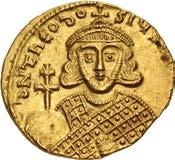
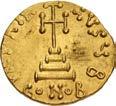
580. Theodosius III of Adramytium. 715-717. AV Solidus (19.5mm, 4.42 g, 6h). Constantinople mint, 2nd officina. Crowned facing bust, wearing loros, holding patriarchal globus cruciger and akakia / Cross potent set on three steps; B//CONOB. DOC 1 var. (unlisted officina); MIB 1; Füeg 1.B.2 (this coin cited in corpus); SB 1487; Berk, Roman 211 (this coin). Toned, minor deposits, area of marks, a few light scratches, hairlines on reverse. EF. Very rare from this officina. ($3000)
From the Wayne Scheible Collection. Ex “An Important Private Collection of Byzantine Coins” (Sotheby’s New York, 2 November 1998), lot 384.
An obscure tax-collector, Theodosius was elevated to the throne following the Opsikion theme’s revolt against Anastasius II. Many of the other powerful themes, however, did not acknowledge Theodosius despite his successful capture of Constantinople and removal of Anastasius II. Namely, the Anatolic theme under its strategos, Leo, and the Armenian theme headed by the strategos Artavasdus allied together to combat Theodosius. Following Leo’s capture of Nicomedia along with Theodosius’ son, Theodosius sued for peace and abdicated. Within two years, Leo had successfully supplanted Theodosius and was crowned as Emperor Leo III. Soon, the turmoil of the previous twenty years of constant usurpations and revolts would be replaced by a new religious controversy – the iconoclastic.



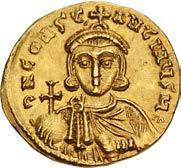
581. Leo III the “Isaurian”, with Constantine V. 717-741. AV Solidus (19.5mm, 4.45 g, 6h). Constantinople mint. Struck 720-circa 725. Crowned facing bust of Leo, wearing chlamys, holding globus cruciger and akakia / Crowned facing bust of Constantine, wearing chlamys, holding globus cruciger and akakia; Є at end of legend. DOC 4 var. (unlisted “officina”); Füeg 4.F (this coin cited in corpus); SB 1504. Toned, minor deposits, a few minor marks. Near EF. Very rare from this “officina.” Only five known to Füeg. ($500)
From the Wayne Scheible Collection. Ex P.J. Donald Collection (Baldwin’s 5, 11 October 1995), lot 174.
Leo III proved to be a more capable ruler than most of his recent predecessors. He successfully defended Constantinople from the Arab forces and subsequently defeated them decisively at the battle of Akroinon in Phrygia. He is, however, more well known as the promulgator of the first iconoclastic controversy. The iconoclasts were strictly opposed to the use of religious icons in worship and went so far as to destroy sacred works of religious art in their zealous prescription of their policies. The controversy was more pronounced later in Leo’s reign but was continued fervently by his son and successor Constantine V who was given the moniker, Copronymos, i.e. “the dung-named,” by his later detractors for reportedly befouling his baptismal font.




582. Artavasdus, with Nicephorus. 741/2-743. AV Solidus (19mm, 4.41 g, 6h). Constantinople mint. Struck 742/743. Crowned facing bust of Artavasdus, wearing chlamys, holding globus cruciger and akakia / Crowned facing bust of Nicephorus, wearing loros, holding globus cruciger and akakia; Θ/• ς at end of legend. DOC –; Füeg 3.D (this coin cited in corpus); SB 1543A. Toned, a couple of light scratches, die break on obverse. Near VF. Extremely rare. One of only three known to Füeg. ($10,000)
From the Wayne Scheible Collection. Ex Berk BBS 185 (9 July 2013), lot 52; Berk BBS 183 (28 March 2013), lot 57; Triton XVI (7 January 2013), lot 1283; Giessener Münzhandlung 199 (10 October 2011), lot 850.
Artavasdus was first appointed strategos of the Armenian theme by Emperor Anastasius II. After Theodosius III usurped Anastasius, Artavasdus sided with and aided Leo III in his later revolt against Theodosius. In exchange for his loyalty, Artavasdus was granted the honorific title kouropalates (master of the palace), made the comes of the Opsikion theme while retaining his original command, and given Leo’s daughter Anna in marriage. Upon the death of Leo III in 741, Artavasdus’ loyalty did not extend to Leo’s son and successor Constantine V. One year later he successfully usurped the throne from Constantine for himself in July 742. Artavasdus ambushed and defeated Constantine’s forces as they set out to campaign against the Umayyads. Following the disastrous battle, Constantine fled into exile at Amorium where he began rallying support for his cause against Artavasdus. In contrast to Leo and Constantine, Artavasdus was an iconodule who restored the adoration of icons during his brief reign in opposition to the policies taken by Leo III and Constantine V. Unfortunately for the iconodules, Constantine and Artavasdus would meet in battle again, this time at Sardes, where Constantine emerged victorious and Artavasdus’ brief reign came to an end. Upon retaking the throne, Constantine promptly reinstated his father’s iconoclast policies and had Artavasdus and his son Nicephorus mutilated and exiled.




583. Constantine V Copronymus, with Leo III. 741-775. AV Solidus (18.5mm, 4.45 g, 6h). Constantinople mint. Struck 741-751. Crowned facing bust of Leo, wearing chlamys, holding cross potent and akakia / Crowned facing bust of Constantine, wearing chlamys, holding cross potent and akakia; B at beginning of legend, ü at end. DOC (1e.2); Füeg 3.A.6; SB 1550. Toned. EF. An outstanding example. ($750)
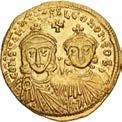


584. Constantine V Copronymus, with Leo IV and Leo III. 741-775. AV Solidus (20mm, 4.43 g, 6h). Constantinople mint. Struck 751-circa 757. Crowned facing busts of Constantine V and Leo IV, both wearing chlamys; cross above, • between / Crowned facing bust of Leo III, wearing loros, holding cross potent; Θ at end of legend. DOC 2c; Füeg 4.B.1; SB 1551. Toned, some doubling on obverse, minor weakness on reverse. Near EF. ($500)
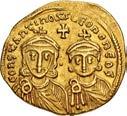
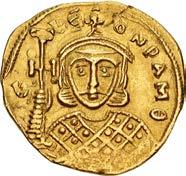
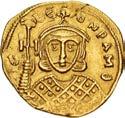
585. Constantine V Copronymus, with Leo IV and Leo III. 741-775. AV Solidus (21mm, 4.42 g, 6h). Constantinople mint. Struck 751-circa 757. Crowned facing busts of Constantine V and Leo IV, both wearing chlamys; cross above, • between / Crowned facing bust of Leo III, wearing loros, holding cross potent; Θ at end of legend. DOC 2c var. (rev. legend); Füeg 4.A.3 (this coin cited in corpus and illustrated); SB 1551; Berk, Roman 228 (this coin). Toned, spot of weakness, some doubling on reverse, minor dig at edge. Good VF. ($500)
Ex Family of Constantine Collection (Classical Numismatic Group 126, 29 May 2024), lot 977; “An Important Private Collection of Byzantine Coins” (Sotheby’s New York, 2 November 1998), lot 407; Tietjen 26 (28 June 1978), lot 3004.


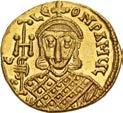

586. Constantine V Copronymus, with Leo IV and Leo III. 741-775. AV Solidus (20mm, 4.43 g, 6h). Constantinople mint. Struck circa 757-775. Crowned facing busts of Constantine V and Leo IV, both wearing chlamys; cross above, • between / Crowned facing bust of Leo III, wearing loros, holding cross potent. DOC 2d; Füeg 5.A.2; SB 1551. Toned with some luster, trace deposits, spot of die clash. EF. ($600)
From the Wayne Scheible Collection, purchased from Baldwin’s.


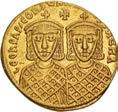

587. Leo IV the Khazar, with Constantine VI, Leo III, and Constantine V. 775-780. AV Solidus (19.5mm, 4.40 g, 6h). Constantinople mint. Struck 776-778. Crowned facing busts of Leo IV and Constantine VI, both wearing chlamys; cross above, • between; Θ at end of legend / Crowned facing busts of Leo III and Constantine V, both wearing loros; cross above. DOC 1b; Füeg 2.A.1; SB 1583. Toned, with some luster. Near EF. ($750)

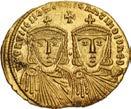


588. Leo IV the Khazar, with Constantine VI, Leo III, and Constantine V. 775-780. AV Solidus (21.5mm, 4.49 g, 6h). Constantinople mint. Struck 776-778. Crowned facing busts of Leo IV and Constantine VI, both wearing chlamys; cross above, • between; [Θ] at end of legend / Crowned facing busts of Leo III and Constantine V, both wearing loros; cross above, • between. DOC 1b; Füeg 2.A.1; SB 1583. Toned, minor doubling, die rust, minor deposits. EF. ($1000)
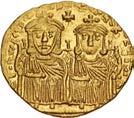

589. Leo IV the Khazar, with Constantine VI, Leo III, and Constantine V. 775-780. AV Solidus (22mm, 4.43 g, 6h). Constantinople mint. Struck 778-780. Leo IV and Constantine VI enthroned facing on suppedion, both wearing crown and chlamys; cross above / Crowned facing busts of Leo III and Constantine V, both wearing loros; cross above, • between. DOC 2; Füeg 1.C.2 (Constantine VI); SB 1584. Toned, with some luster, minor doubling. Near EF. ($500)
From the Wayne Scheible Collection. Ex Berk BBS 75 (28 January 1993), lot 37.
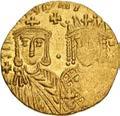


590. Constantine VI & Irene, with Leo III, Constantine V, and Leo IV. 780-797. AV Solidus (19.5mm, 4.41 g, 6h). Constantinople mint. Struck 780-790. Crowned facing busts of Constantine VI, wearing chlamys and holding globus cruciger, and Irene, wearing loros, holding cruciform scepter and globus cruciger; cross above, • between / Constantine V, Leo III, and Leo IV enthroned facing on suppedion, each wearing crown and chlamys. DOC 1; Füeg Ir.2.13/C.2.1 (obv./rev.); SB 1591. Toned, a couple areas of weakness. Good VF. ($750)

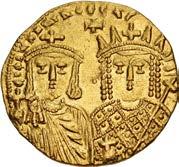

591. Constantine VI & Irene, with Leo III, Constantine V, and Leo IV. 780-797. AV Solidus (19.5mm, 4.52 g, 6h). Constantinople mint. Struck 780-790. Crowned facing busts of Constantine VI, wearing chlamys and holding globus cruciger, and Irene, wearing loros, holding cruciform scepter and globus cruciger; cross above, • between / Constantine V, Leo III, and Leo IV enthroned facing on suppedion, each wearing crown and chlamys. DOC 1; Füeg 4.3 (Ir.4.3/C.4.3; this coin cited in corpus and illustrated); SB 1591. Toned, with some luster, die wear on reverse. Near EF. Very rare die pairing. The only example noted by Füeg in his corpus. ($750)
From the Wayne Scheible Collection. Ex Berk BBS 75 (28 January 1993), lot 38.



592. Constantine VI & Irene. 780-797. AV Solidus (20.5mm, 4.49 g, 6h). Constantinople mint. Struck 792-797. Crowned facing bust of Irene, wearing loros, holding globus cruciger and cruciform scepter / Crowned facing bust of Constantine, wearing chlamys, holding globus cruciger and akakia; Θ at end of legend. DOC 3a; Füeg 5.A; SB 1594. Toned, with some luster. EF. ($1000)


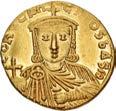
593. Constantine VI & Irene. 780-797. AV Solidus (18.5mm, 4.47 g, 6h). Constantinople mint. Struck 792-797. Crowned facing bust of Irene, wearing loros, holding globus cruciger and cruciform scepter / Crowned facing bust of Constantine, wearing chlamys, holding globus cruciger and akakia; Θ at end of legend. DOC 3a; Füeg 5.A; SB 1594. Toned, with some luster, edge slightly upturned, minor mark, light hairlines. EF. ($1000)
From the Wayne Scheible Collection. Ex Berk BBS 172 (20 December 2010), lot 39.
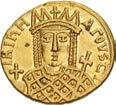

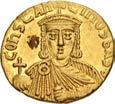
594. Constantine VI & Irene. 780-797. AV Solidus (19mm, 4.48 g, 7h). Constantinople mint. Struck 792-797. Crowned facing bust of Irene, wearing loros, holding globus cruciger and cruciform scepter / Crowned facing bust of Constantine, wearing chlamys, holding globus cruciger and akakia; Θ at end of legend. DOC 3a; Füeg 5.A; SB 1594. Toned, with some luster, deposits. EF. ($1000)


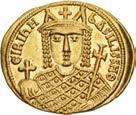

595. Irene. 797-802. AV Solidus (22.5mm, 4.42 g, 6h). Constantinople mint. Crowned facing bust, wearing loros, holding globus cruciger and cruciform scepter / Crowned facing bust, wearing loros, holding globus cruciger and cruciform scepter; Θ at end of legend. DOC 1b; Füeg 1.A.1; SB 1599. Toned, with some luster, minor deposit. EF. ($2500)
Like Empress Aelia Eudocia of four centuries earlier, Irene hailed from Athens. The wife of the prematurely deceased Emperor Leo IV the Khazar, Irene took over affairs of state as regent on behalf of their son Constantine VI. This taste of imperial dynamism made Irene reluctant to give up her status and power. Meanwhile Constantine became increasingly at odds with his mother and her agenda (which included ending iconoclastic policies) as his rule developed. Ultimately, Irene was banished; however, within approximately a year, she managed to reassert herself as effective co-ruler. This failure to remove Irene from power would prove to be Constantine’s undoing. He was deposed and gruesomely blinded by his own mother’s courtiers. The accession of Irene, the first sole empress to rule the Byzantine state, caused some difficulty for those tasked with creating her coinage. It would be difficult to continue the previous status quo of the coinage depicting the new ruler on one side while concurrently honoring their predecessor or displaying an associate ruler on the other side. Consequently, Irene elected to have her visage represented twice on both the obverse and reverse of her solidi. The precedent this set would see the technique employed again in future reigns. As an additional difficulty to overcome, this time linguistic, Irene was titled on her coinage in the dative (although Grierson does note in DOC III.1 that she titled herself as basileus in her legislation). Following the Greek meaning of the word and given the nature of her unusual rise to power, her detractors may well have thought of her as Irene Tyrannos rather than as the Irene Basileus she desired to be.


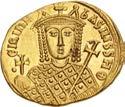

596. Irene. 797-802. AV Solidus (20.5mm, 4.40 g, 6h). Constantinople mint. Crowned facing bust, wearing loros, holding globus cruciger and cruciform scepter / Crowned facing bust, wearing loros, holding globus cruciger and cruciform scepter; at end of legend. DOC 1a.2 and 1a.4-5; Füeg 2.B.1; SB 1599. Toned and lustrous, minor deposits. Superb EF. Two excellent and imposing portraits. ($3000)



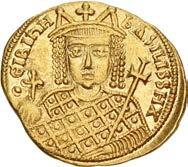
597. Irene. 797-802. AV Solidus (20mm, 4.46 g, 6h). Constantinople mint. Crowned facing bust, wearing loros, holding globus cruciger and cruciform scepter / Crowned facing bust, wearing loros, holding globus cruciger and cruciform scepter; X at end of legend. DOC 1c; Füeg 1.B (this coin cited in corpus); SB 1599. Toned and lustrous, minor doubling on reverse. EF. ($2000)
From the Wayne Scheible Collection. Ex Berk BBS 176 (8 September 2011), lot 41; Berk BBS 173 (15 March 2011), lot 85.

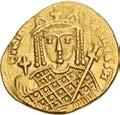
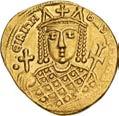

598. Irene. 797-802. AV Solidus (19.5mm, 4.35 g, 6h). Constantinople mint. Crowned facing bust, wearing loros, holding globus cruciger and cruciform scepter / Crowned facing bust, wearing loros, holding globus cruciger and cruciform scepter; X at end of legend. DOC 1c; Füeg 1.B (this coin cited in corpus); SB 1599. Toned, minor die breaks. Near EF. ($2000)
From the Wayne Scheible Collection. Ex Berk BBS 81 (31 March 1994), lot 49.



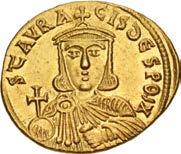
599. Nicephorus I, with Stauracius. 802-811. AV Solidus (19mm, 4.41 g, 6h). Constantinople mint. Struck 803-811. Crowned facing bust of Nicephorus, wearing chlamys, holding cross potent and akakia / Crowned facing bust of Stauracius, wearing chlamys, holding globus cruciger and akakia; X at end of legend. DOC 2c; Füeg 2.A.2 (this coin cited in corpus); SB 1604. Toned and fully lustrous, trace deposits, a few minor die breaks on reverse. Superb EF. ($1500)
From the Wayne Scheible Collection. Ex Berk BBS 75 (28 January 1993), lot 40.
Nicephorus’ career came to an abrupt end at the battle of Pliska on 26 July 811 during his Bulgarian campaign. The initial campaign was a rousing success, and the battle came immediately after the sack of Pliska (the Bulgarian capital) by Byzantine forces. The Bulgarian Khan Krum attempted to sue for peace after the disastrous loss of his capital city, but Nicephorus, confident from his great victory, refused and planned to retake all of Bulgaria. While the Byzantines were plundering the city, Krum blocked their exit from the valley with traps and fortifications including a wooden palisade. Nicephorus was unwilling to assault the newly-constructed battlements and elected to set up camp. This proved unwise. The Bulgarians spent the next few days across in their camp rattling their shields in an effort to intimidate the Byzantine forces. By the time the two armies met in battle, the Byzantine army’s morale had evaporated. Despite the Byzantine’s possessing superior numbers, the army was completely routed by the Bulgarian Khanate. Very few members of the approximately 30,000 strong Byzantine army escaped the slaughter. Emperor Nicephorus himself was slain (notably as the first Roman Emperor to die in battle against foreign enemies since Valens’ demise over four centuries earlier at the hands of the Goths); concurrently, Nicephorus’ son and successor, Stauracius, received a serious wound to his spine which left him partially paralyzed and caused his death six months later. Theophanes the Confessor summarized the aftermath of the disaster in his Chronographia as follows: “Among the victims were ... the patrician Romanus, who was strategos of the Anatolics, and many protospatharioi and spatharioi, the commanders of the tagmata, including the domestic of the excubitors and the drungarios of the Imperial Watch, the strategos of Thrace, many officers of the themata, and an infinite number of soldiers so that the flower of Christendom was destroyed ... May not Christians experience another time the ugly events of that day for which no lamentation is adequate” (Theophanes, 491).
Nicephorus’ body was not recovered and Theophanes records that the Khan Krum “cut off the head of Nikephoros and for several days hung it on a pole so as to exhibit it to the tribes that came before him ... After that, he bared the skull, reveted it on the outside with silver and, in his pride, made the chieftains of the Sklavinians drink from it” (Theophanes, 491-2). This follows the ancient Skythian custom recorded by Herodotus in The Histories Book 4.65. Thus ended the reign of Nicephorus and Stauracius.
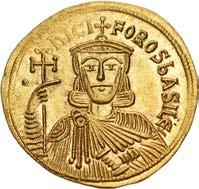

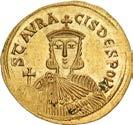

600. Nicephorus I, with Stauracius. 802-811. AV Solidus (21.5mm, 4.45 g, 6h). Constantinople mint. Struck 803-811. Crowned facing bust of Nicephorus, wearing chlamys, holding cross potent and akakia; • at beginning of legend / Crowned facing bust of Stauracius, wearing chlamys, holding globus cruciger and akakia; X at end of legend. DOC 2c; Füeg 2.C.2; SB 1604. Toned and fully lustrous, minor deposits, spots of weakness. Superb EF. A magnificent example with an outstanding portrait of Nicephorus. ($1500)
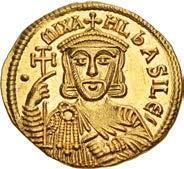

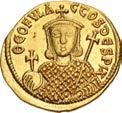

601. Michael I Rhangabe, with Theophylactus. 811-813. AV Solidus (20mm, 4.43 g, 6h). Constantinople mint. Crowned facing bust of Michael, wearing chlamys, holding cross potent and akakia / Crowned facing bust of Theophylactus, wearing loros, holding globus cruciger and cruciform scepter; X at end of legend. DOC 1a; Füeg 1.B (this coin cited in corpus); SB 1615. Toned and lustrous, a couple of minor spots of weakness. EF. Rare. An excellent example. ($7500)
From the Wayne Scheible Collection. Ex Berk BBS 75 (28 January 1993), lot 42.
Michael I Rhangabe was one of the few nobles to survive the disaster at Pliska. Theophanes records: “The caiopalates Michael, who escaped unharmed, received many entreaties from his friends that he should be proclaimed emperor, but did not consent because of his oath to Nikephoros and Staurakios” (Theophanes, 492). However, due to Stauracius being unfit to rule given the wound he received at Pliska, Michael succeeded his brother-in-law on 2 October 811. Unfortunately for Michael and his son Theophylactus, like their predecessors Nicephorus and Stauracius, the two emperors also suffered a disastrous defeat at the hands of the Bulgarian Khan Krum, this time at the battle of Versinikia which occurred less than two years into their reign. Following the disaster, the army proclaimed the strategos of the Anatolian theme, Leo as emperor. Michael quickly abdicated and retired to a monastery.
During his short reign, Michael notably reversed the iconoclast policies of his predecessor and recognized Charlemagne as emperor of the West in exchange for the return of Venice. The Venetians, however, simply ignored the edict which Michael was unable to enforce. Michael’s coinage in all metals is generally rare.


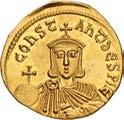
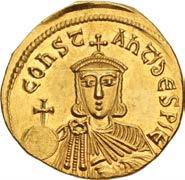
602. Leo V the Armenian, with Constantine. 813-820. AV Solidus (20.5mm, 4.42 g, 6h). Constantinople mint. Crowned facing bust of Leo, wearing chlamys, holding cross potent and akakia / Crowned facing bust of Constantine, wearing chlamys, holding globus cruciger and akakia; Є at end of legend. DOC 2a; Füeg 2.B.1; SB 1627. Toned and lustrous, minor deposits, lightly clipped, hairlines, minor die rust on obverse, thin die breaks on reverse. EF. Two excellent and well-struck portraits. ($2000)
From the Wayne Scheible Collection, purchased from Spink.
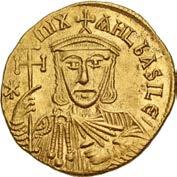
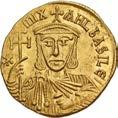

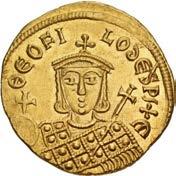
603. Michael II the Amorian, with Theophilus. 820-829. AV Solidus (19mm, 4.39 g, 6h). Constantinople mint. Struck 821-829. Crowned facing bust of Michael, wearing chlamys, holding cross potent and akakia / Crowned facing bust of Theophilus, wearing loros, holding globus cruciger and cruciform scepter; Є at end of legend. DOC (2a) var. (obv. legend); Füeg 2.A.1; SB 1640. Toned with some luster, light scrape at edge on reverse. EF. ($1500)




604. Michael II the Amorian, with Theophilus. 820-829. AV Solidus (21.5mm, 4.32 g, 6h). Constantinople mint. Struck 821-829. Crowned facing bust of Michael, wearing chlamys, holding cross potent and akakia / Crowned facing bust of Theophilus, wearing loros, holding globus cruciger and cruciform scepter; Є at end of legend. DOC 5a; Füeg 4.A.1; SB 1640. Toned, deposits, a few minor die breaks. VF. ($1000)
From the Wayne Scheible Collection.
Very Rare Issue – Unlisted Variety – Notable Overstrike

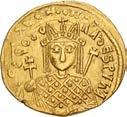


605. Michael III “the Drunkard”, with Theodora and Thecla. 842-867. AV Solidus (20.5mm, 4.39 g, 7h). Constantinople mint. Struck 842-circa 843. Crowned facing half-length bust of Theodora, wearing loros, holding patriarchal globus cruciger and cruciform scepter / Crowned facing half-length figures of Michael, wearing chlamys and holding globus cruciger, and Thecla, wearing loros, holding patriarchal cross and akakia. DOC 1a.1 var. (rev. legend); Füeg 1.D.4-5/1.D (obv./rev.); SB 1686. Toned, overstruck, light scuff, minor edge mark. Good VF. Very rare. An unlisted obverse/reverse die combination in Füeg. Notably overstruck on a SB 1551 AV Solidus of Constantine V Copronymus, with Leo IV and Leo III with portions of the legends visible. ($7500)
From the Wayne Scheible Collection.
Michael III was only two years old when his father Theophilus died in 842. His mother Theodora as regent was the effective ruler of the empire, and the first coinage of his reign gives her prominence on the obverse, relegating Michael to the reverse. Michael was generally kept in the background, and is even overshadowed on the coinage by his sister Thecla such as on this early solidus issue. With Michael in isolation, Theodora maintained the empire with the assistance of her brothers, Bardas and Petronas, along with Theoktistos, the logothete of the dromos. During Theodora’s regency, she brought an end to the second iconoclastic controversy and demonstrated herself as an effective and capable ruler. In a typical example of Byzantine family intrigue, Theoktistos moved against Bardas, who in turn conspired with the young emperor in 856 to remove his mother’s regency and eliminate Theoktistos. Theoktistos was ultimately killed and Theodora was removed from power and confined to a convent. The conspiracy continued and Bardas was murdered in 865 by Basil, an ambitious court official who befriended Michael and soon became co-emperor. Basil proceeded to promptly eliminate his benefactor shortly thereafter.
Although Michael was given the unflattering epithet the “Drunkard,” this smear on his name was perpetuated by Basil to justify his seizure of power. Michael appears to have been a conscientious ruler and capable military leader, his only fatal failing being that he was too easily swayed by his unscrupulous associates.
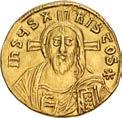
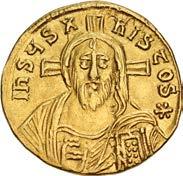

606. Michael III “the Drunkard”. 842-867. AV Solidus (20mm, 4.37 g, 6h). Constantinople mint. Struck 856-867. Nimbate facing bust of Christ Pantokrator, raising hand in benediction and holding Gospels / Crowned facing bust of Michael, wearing loros, holding labarum and akakia. DOC 3; Füeg 3.A; SB 1688. Toned, minor marks, spot of clashing on obverse. VF. Rare. ($4000)
From the Wayne Scheible Collection.



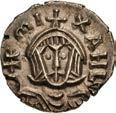
607. Michael III “the Drunkard”. 842-867. AV Semissis (12.5mm, 1.44 g, 6h). Syracuse mint. Struck 842-866. Crowned facing bust, wearing loros, holding patriarchal globus cruciger / Crowned facing bust, wearing chlamys, holding patriarchal globus cruciger. DOC 9; Anastasi 563d; SB 1694. Toned, slight doubling, minor metal flaw at edge. EF. Very attractive for issue. ($500)
From the Wayne Scheible Collection, purchased from Harlan J. Berk.
This semissis and the following one are from one of the final emissions of the Syracuse mint under the Byzantines. The Arab conquest of Sicily had began many years prior, but the mint at Syracuse dutifully continued producing coinage until the reign of Michael’s successor, Basil I, with whatever meager metal reserves were at their disposal. These final emissions, the latter struck even while Syracuse itself was under siege, are often either heavily debased electrum or even just gilt copper in the most extreme cases. These two specimens are conversely very attractive for such a late issue. Ultimately, the Syracusan Byzantine coinage terminated under Basil I when Syracuse fell to Aghlabid forces in 878 approximately a decade after this issue was last struck.




608. Michael III “the Drunkard”. 842-867. AV Semissis (13mm, 1.58 g, 5h). Syracuse mint. Struck 842-866. Crowned facing bust, wearing loros, holding patriarchal globus cruciger / Crowned facing bust, wearing chlamys, holding patriarchal globus cruciger. DOC 9; Anastasi 563d; SB 1694. Toned. In NGC encapsulation 4884485-017, graded AU, Strike: 4/5, Surface: 5/5. ($500)


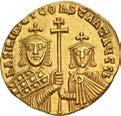

609. Basil I the Macedonian, with Constantine. 867-886. AV Solidus (19.5mm, 4.38 g, 7h). Constantinople mint. Struck 868-879. Christ Pantokrator, nimbate, enthroned facing on suppedion, raising hand in benediction and holding Gospels / Crowned facing busts of Basil, wearing loros, and Constantine, wearing chlamys, together holding patriarchal cross between them. DOC 2b; Füeg 3.A.2 (this coin cited in corpus); SB 1704; Berk, Roman 265 (this coin). Toned, light deposits, light hairlines, minor die shift on obverse. EF. An early and incredibly vibrant strike with the die engravers’ centering circle and numerous spacing lines still visible on the reverse. ($500)
From the Wayne Scheible Collection. Ex “An Important Private Collection of Byzantine Coins” (Sotheby’s New York, 2 November 1998), lot 469.
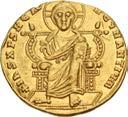
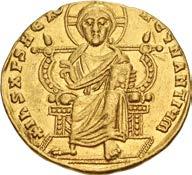
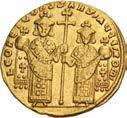
610. Leo VI the Wise, with Constantine VII. 886-912. AV Solidus (21mm, 4.33 g, 7h). Constantinople mint. Struck 908-912. Christ Pantokrator, nimbate, enthroned facing on suppedion, raising hand in benediction and holding Gospels; armrests with seven pellets / Crowned facing figures of Leo, holding globus cruciger in right hand, and Constantine, holding globus cruciger in left hand, both wearing loros decorated with a cross at end and together holding patriarchal cross between them with left and right hands respectively. DOC 2; Füeg 3.B.5; SB 1725. Toned, edge mark, tiny spot of graffiti. VF. Only three examples of this sub-variety noted by Füeg, all in museum collections. ($750)
From the Wayne Scheible Collection, purchased from Herb Kreindler.
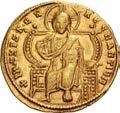

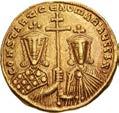
611. Constantine VII Porphyrogenitus, with Romanus II. 913-959. AV Solidus (19.5mm, 4.41 g, 6h). Constantinople mint. Struck 945. Christ Pantokrator, nimbate, enthroned facing on suppedion, raising hand in benediction and holding Gospels / Crowned facing half-length busts of Constantine, wearing loros, and Romanus, wearing chlamys, together holding patriarchal cross between them. DOC 14; Füeg 14.4 note; SB 1750. Toned. VF. Very scarce issue. Very rare variety with the obverse legend spelled R•ЄX. ($1000)
Ex Grapevine Collection, purchased from Herb Kreindler.
Constantine VII’s time as emperor had a very complex path to his eventual sole reign. Following the death of his uncle Alexander, Constantine began his reign under the regency of the Patriarch of Constantinople, Nicolas Mystikos. However, Nicolas’ regency was short-lived. After the Tsar of Bulgaria, Symeon, appeared outside Constantinople with a massive army, Nicolas capitulated to the Bulgarians’ demands and granted them numerous concessions. This lack of strength by Nicolas led to a palace revolt in which Nicolas’ regency was removed and replaced with that of Constantine’s mother, Zoe Karbonopsina. This change in government led Symeon to invade the Byzantine empire and lay waste to numerous provinces. His destructive campaign was eventually stymied by the capable general Romanus Lecapenus. Upon Romanus’ initial victories, he assumed the regency from Zoe, whom he forced into a convent. Romanus additionally married his daughter Helena to Constantine. In December of 920, Romanus assumed the title of co-Augustus and, though he did not depose Constantine, he kept all the power for himself. Romanus and Symeon continued to war against each other until Symeon’s death in 927. Symeon’s death seriously diminished the Bulgarians’ power and Romanus was free to turn his attention towards matters of state.
Between 921 and 945, Romanus elevated three of his sons as co-Augustus: Christopher, Stephen, and Constantine. All the while, the former senior Augustus Constantine VII was completely sidelined for over thirty years (Romanus officially displaced Constantine as senior Augustus around 921). However, matters eventually changed when Stephen and Constantine turned on their father and deposed him in December 944 (Romanus’ other son Christopher had predeceased his father at this point). This revolt by Romanus’ sons was precipitated by Romanus drafting a will in which he intended to leave Constantine VII as sole Augusutus following his death. Constantine VII seized his chance and in turn successfully deposed Stephen and Constantine that following January. Finally, in the thirty-first year of his reign in 945, Constantine VII was free of his domineering associates and became sole Augustus. Later that year, he added his own son Romanus II as co-Augustus. Constantine reigned for an additional fourteen years after he finally deposed the Lecapeni before dying in 959 after reigning for a total of forty-six years. This rare issue was struck following Constantine VII’s brief reign without any associates upon his association of his son, Romanus II. It was immediately succeeded by the far more common issue with a facing bust of Christ (SB 1751) rather than Christ enthroned.

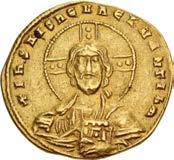

612. Basil II Bulgaroktonos, with Constantine VIII. 976-1025. AV Tetarteron Nomisma (19mm, 4.07 g, 6h). Constantinople mint. Struck 977. Nimbate facing bust of Christ Pantokrator, raising hand in benediction and holding Gospels; two pellets in each arm of nimbus / Crowned facing busts of Basil, wearing loros, and Constantine, wearing chlamys, together holding patriarchal cross between them. DOC 7 and 14 corr. (Tetarteron not Histamenon); Füeg II 7.A; SB 1801. Toned, minor marks and deposits. Good VF. Very rare. Fewer than approximately twenty examples known. ($500)
From the Wayne Scheible Collection.
The son of Romanus II, Basil II theoretically inherited the purple at the age of five when his father died in AD 963. However, he was overshadowed by regents and co-emperors until AD 976. He had to fight off several challenges to his rule and was not fully secure until AD 989. The experience made a hard, austere man of him. Monastic in tastes and militant in manners, he never married and devoted his whole reign to administering the state and leading armies into battle. He expended enormous efforts toward destroying the Bulgarian menace once and for all. At the Battle of Kleidion in 1014, he acquired his nickname “Bulgar–slayer” (Bulgaroktonos) when he captured and blinded 15,000 Bulgarians; the Bulgarian Tsar Samuel reportedly died of a heart attack when he beheld the fate of his men. The Fatamids and Arabs also felt Basil’s wrath, and he oversaw the annexation of Georgia to the Empire. He kept wealthy aristocrats on a short leash and favored peasants and small farmers, the backbone of the army. By Basil’s death in 1025, the medieval Byzantine Empire had reached its greatest size, power, and prestige. Maintaining it would require rulers possessing similar devotion to duty; regrettably, this character was lacking from many of his successors who proceeded to squander away his legacy with astonishing speed.
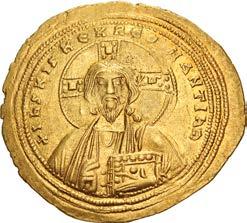


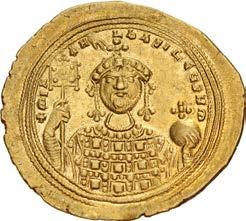
613. Michael IV the Paphlagonian. 1034-1041. AV Histamenon Nomisma (27mm, 4.42 g, 6h). Constantinople mint. Nimbate facing bust of Christ Pantokrator, raising hand in benediction and holding Gospels / Crowned facing bust of Michael, wearing jeweled loros, holding labarum and globus cruciger, being crowned by manus Dei above. DOC 1 var. (decoration of labarum); Füeg II 1.A.2; SB 1824. Attractively toned, trace deposits, slightly ragged edge. Near EF. A very rare labarum decoration. Only three noted by Füeg. ($1000)
From the Wayne Scheible Collection, purchased from Harlan J. Berk.
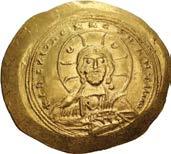

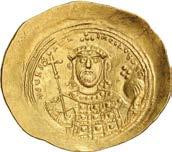
614. Constantine IX Monomachus. 1042-1055. AV Histamenon Nomisma (28mm, 4.43 g, 6h). Constantinople mint. Nimbate facing bust of Christ Pantokrator, raising hand in benediction and holding Gospels; upturned crescents in upper quarters of nimbus / Crowned facing bust of Constantine, wearing loros, holding cruciform scepter and globus cruciger. DOC 3; Füeg II 3.A.6/6; SB 1830. Toned, with some luster, a few light scratches at periphery. Near EF. ($500)
From the Wayne Scheible Collection, purchased from Harlan J. Berk.

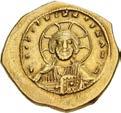

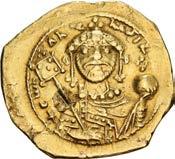
615. Constantine IX Monomachus. 1042-1055. AV Tetarteron Nomisma (19mm, 4.06 g, 6h). Constantinople mint. Nimbate facing bust of Christ Pantokrator, raising hand in benediction and holding Gospels / Crowned facing bust of Constantine, wearing jeweled chlamys, holding labarum-tipped scepter and globus cruciger. DOC 6; Füeg 6.B3/6.B8-11 var. (unlisted obv./rev. legend combination); SB 1833. Toned, trace of die rust and delamination on reverse, minor edge mark. Good VF. ($500)
From the Wayne Scheible Collection.



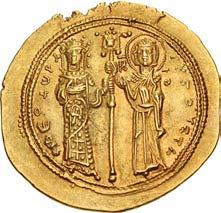
616. Theodora. 1055-1056. AV Histamenon Nomisma (24mm, 4.39 g, 6h). Constantinople mint. Christ Pantokrator, nimbate, standing facing on suppedion, holding Gospels in both hands; one pellet in each bar of nimbus / Theodora, wearing crown and loros decorated with a cross, and the Theotokos, standing facing, together holding between them a labarum on long staff with a pellet on the shaft and beneath. DOC 1a; Füeg II 1.A; SB 1837. Attractively toned, slightly ragged edge. Near EF. ($2000)
From the Wayne Scheible Collection.

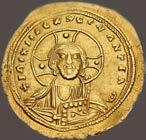

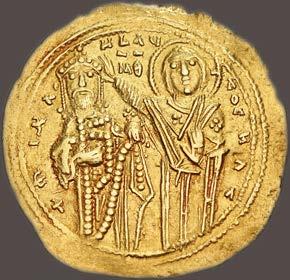
617. Michael VI Stratioticus. 1056-1057. AV Histamenon Nomisma (24mm, 4.33 g, 6h). Constantinople mint. Nimbate facing bust of Christ Pantokrator, raising hand in benediction and holding Gospels; • in each quarter of nimbus / Michael standing facing, wearing crown and jeweled chlamys, resting hand on chest and holding globus cruciger, being crowned by the Theotokos, nimbate, to right; M Θ, both with macron above between. DOC 1a; Füeg II 1.A; SB 1840. Toned, slightly wavy flan, minor scratches, minor die rust on reverse, edge marks. Good VF. Very rare. ($10,000)
From the Wayne Scheible Collection. Ex Harlan J. Berk inventory cc79771; Baldwin’s FPL (Summer 2013), no. 26; Baldwin’s of St. James’s 23 (4 February 2013), lot 85; Münzen & Medaillen AG 35 (16 June 1967), lot 242 (there as Michael V).
Michael served as a logothetes tou stratiotikou (approximately a comptroller of military finances) during the sole reign of Theodora who appointed him as her successor. However, Michael failed to secure the backing of the powerful military faction in Asia Minor which revolted against him and proclaimed the general Isaac Comnenus as emperor. Michael ultimately abdicated and took holy orders. His brief 375 day reign likely contributes to the great rarity of his coin coinage today



618. Eudocia, with Michael VII and Constantius. 1067. AV Histamenon Nomisma (24.5mm, 4.38 g, 6h). Constantinople mint. Christ Pantokrator enthroned facing on suppedion, nimbate, raising hand in benediction and holding Gospels / Crowned facing figures of Eudocia, holding jeweled scepter, standing facing on suppedion, flanked by her sons Michael, to left, holding globus cruciger and akakia, and Constantius, to right, holding akakia and globus cruciger, all wearing loros. DOC 1; Füeg II 1.y2; SB 1857. Toned, minor edge splits and scratches, light scuff and bend at edge. Good VF. Scarce. ($600)
From the Wayne Scheible Collection. Ex Classical Numismatic Group XXIV (9 December 1992), lot 540; Aus dem Monetarium (May 1989), no. 82; Hess-Leu 49 (27 April 1971), lot 561.
Eudocia ruled as regent from the death of her husband Constantine X in May of 1067 until the end of the year. At the time, the empire was facing a military crisis in the east as the Seljuq Turks advanced further into Asia Minor, and the prevailing feeling was that a competent military leader should be emperor. Eudocia, despite having declared that she would never remarry, took the hand of Romanus IV Diogenes on 1 January 1068. Romanus’s own rule lasted just a little over two and a half years until his capture by the Turks at the disastrous Battle of Manzikert in August 1071. Eudocia was re-established as regent for two months from September to October before being coerced into retiring to a convent. Whether this issue dates to her first or second term as regent has been debated, but the former date of 1067 is more widely accepted. While by no means abundant, the output of this coinage is too large to be condensed into the short span of her second regency. Additionally, Grierson reports in DOC 3.2 that “the fineness of such specimens as have been tested is also about 17 1/2 carats, which would correspond better to 1067 than to 1071” (DOC, p. 781). Unpublished

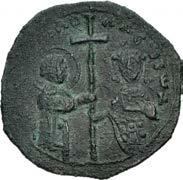

619. Alexius I Comnenus. 1081-1118. BI Half Miliaresion (20mm, 1.27 g, 6h). Thessalonica mint(?). Struck circa 1081-circa 1092. Nimbate half-length figure of St. Demetrius, facing slightly right, presenting cross to half-length facing figure of Alexius, wearing crown and loros, holding cross with one hand and resting the other on his chest / + XЄ/ ROHΘЄI/ ΛΛЄΞΙω/ [Δ]ЄCΠOTH/ [T]ω K(MNH)/Nω in six lines. Cf. DOC (13.1) and (13.2) (for issue in silver); cf. SB 1908 (same); CNG 497, lot 644 (this coin). Slightly rough dark brown and green patina. VF. Extremely rare issue. Unknown and unpublished in billon save for this coin. ($750)
From the Gasvoda Collection. Ex Classical Numismatic Group Electronic Auction 497 (4 August 2021), lot 644.

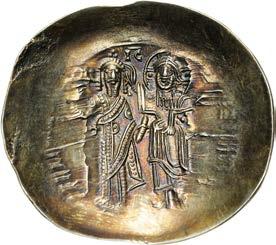

620. Andronicus I Comnenus. 1183-1185. EL Aspron Trachy Nomisma (29mm, 3.46 g, 6h). Constantinople mint. The Theotokos, orans, standing facing on suppedion; with facing head of the Holy Infant on breast / Andronicus standing facing, wearing crown and chlamys, holding labarum and akakia, being crowned by Christ, nimbate, holding Gospels. DOC 2a; SB 1984. Attractive iridescent toning, metal flaw, some peripheral weakness, minor wax deposits. Near EF. ($500)
From the Wayne Scheible Collection.
Ascending to the throne at a relatively old age, Andronicus I devoted part of his administration to eliminating corruption within the bureaucracy. His tactics, however, were severe and ruthless. After a Norman sack of Thessalonica, a panic-stricken angry mob tortured and mutilated the emperor to death. Androncius reportedly suffered the torture well but ultimately perished, retaining as much of his dignity as possible. Thus his two year reign ended quite eventfully but ignominiously.
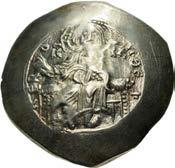

621. Alexius III Angelus-Comnenus. 1195-1203. EL Aspron Trachy Nomisma (27.5mm, 4.73 g, 6h). Constantinople mint. Struck 1197-1203. Christ Pantokrator enthroned facing, nimbate, raising hand in benediction and holding Gospels / Crowned facing figures of Alexius and St. Constantine I, both wearing loros and holding cruciform scepter, together holding labarum between them. DOC 2c; SB 2009 or 2010. Attractive iridescent toning, luster, graffiti at peripheries. Good VF. ($500)
From the Wayne Scheible Collection. Ex Charles W. Neumoyer Collection (Stack’s, 4 May 1960), lot 424.

622

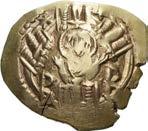
623

622. John Comnenus-Ducas. As emperor of Thessalonica, 1237-1242. BI Aspron Trachy (22.5mm, 1.15 g, 6h). Thessalonica mint. St. Demetrius enthroned facing, wearing military attire and holding sword resting across his lap / Standing facing figures of John, wearing crown and loros, holding akakia, and the Theotokos, nimbate, together holding a long staff surmounted by cross within circle with triangular decoration beneath; globule beneath staff. Cf. DOC 1 (for type as larger module) and 14 (for type as smaller module); S. Bendall, “Notes on the Coinage in the name of John Comnenus-Ducas of Thessalonica (AD 1237-44)” in NC 162 (2002), Type 1, Series II and pl. 48, 5; CLBC 14.1.2; cf. SB 2187 (for type as larger module) and 2199 (for type as smaller module). Dark green patina, some weakness, area of scratches. Good VF. Very rare. ($1000)
From the Gasvoda Collection. Ex Collection of Simon Bendall (Classical Numismatic Group 115, 16 September 2020), lot 790.
623. John V Palaeologus, with John VI. 1341-1391. AV Hyperpyron (24mm, 3.82 g, 6h). Constantinople mint. Struck 1347-1353. Half-length figure of the Theotokos, orans, within city walls with four towers; sigla: d/B|d/B / Christ Pantokrator, nimbate, standing between and blessing John V and John VI, both kneeling and wearing crown and loros. Cf. DOC V 1193 (for type); LPC p. 138, 1; PCPC 285 var. (unlisted sigla); S. Bendall, “A Note on the Hyperpyra of John V and VI (1337-1354)” in NumCirc CXII.5 (October 2004), p. 297, Sigla J; SB 2526. Toned, small edge splits, flan crack, graffito. VF. Well struck for issue. Very rare sigla. Bendall knew of only two examples in his 2004 article. ($750) Ex Grapevine Collection.
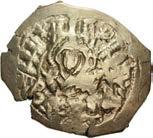
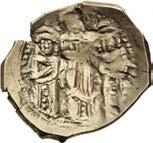
624. John V Palaeologus, with John VI. 1341-1391. AV Hyperpyron (24mm, 4.45 g, 6h). Constantinople mint. Struck 1347-1353. Half-length figure of the Theotokos, orans, within city walls with four towers; sigla: d/B|d/Δ (or A) / Christ Pantokrator, nimbate, standing between and blessing John V and John VI, both kneeling and wearing crown and loros. Cf. DOC V 1193 (for type); LPC p. 138, 1; PCPC 285 var. (unlisted sigla); S. Bendall, “A Note on the Hyperpyra of John V and VI (1337-1354)” in NumCirc CXII.5 (October 2004), p. 297, Sigla K (or C); SB 2526. Toned, typical weakness for issue, edge split, a few scratches. VF. Extremely rare from these sigla; Bendall knew of only one example in 2004. However, he noted that sigla K could be symonymous with sigla C if the Δ is actually a poorly cut A. Nevertheless, sigla C is rare. ($750)
From the Wayne Scheible Collection. Ex Harlan J. Berk inventory cc42508.



625. John V Palaeologus, with John VI. 1341-1391. AR Basilikon (17.5mm, 1.16 g, 12h). Constantinople mint. Struck 1347-1353. The Theotokos, nimbate, enthroned facing, holding the Holy Infant, nimbate, in one hand and resting the other on her breast / Crowned facing figures of John V and John VI, both wearing loros, both resting hand on chest and together holding long cross with a forked base between them. DOC 1195; LPC p. 142, 5; PCPC (289); SB 2530. Toned. Good VF. Extremely rare. One of three genuine examples of this issue in CoinArchives. ($750)
From the Gasvoda Collection. Ex Leu Numismatik AG 7 (24 October 2020), lot 1973; Numismatik Naumann 87 (1 March 2020), lot 813.




626. John V Palaeologus. 1341-1391. BI Tornese (14.5mm, 0.67 g). Politikon coinage. Constantinople mint. Struck 1354-1376. Palaeologan monogram / Cross pattée; stars of six rays in quarters. DOC 1222; LPC p. 188, 12 (Anonymous Politikon); PCPC (368) (Anonymous Politikon); SB 2583 (Anonymous Politikon). Toned. EF. Extremely rare. One of the finest known. ($500)
From the Gasvoda Collection. Ex Iconodule Collection (Triton XXIII, 14 January 2020), lot 943.



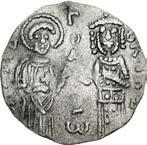
627. John VI Cantacuzene. Second reign, 1353-1354. AR Basilikon (16mm, 0.71 g, 6h). Didymoteichon(?) mint. Christ Pantokrator enthroned facing, nimbate, raising hand in benediction and holding Gospels; sigla: B|(Φ/Ρ) / St. Demetrius, holding small cross, standing slightly right, extending hand to John, wearing crown and loros, standing facing, resting hand on chest. DOC 1206; LPC p. 150, 3; PCPC (303); A. Veglery & A. Millas, “Gold and silver coins of the time of John V” in NumCirc LXXX.9 (September 1972), p. 311, 5; SB 2542. Toned. Good VF. Very rare. ($2500)
From the Gasvoda Collection. Ex Iconodule Collection (Classical Numismatic Group 112, 11 September 2019), lot 698.




628. Manuel II Palaeologus. 1391-1425. AR Stavraton (25mm, 8.06 g, 6h). Constantinople mint. Struck 1391-1394/5. Nimbate facing bust of Christ Pantokrator, raising hand in benediction and holding Gospels; sigla: C|(lys) / Nimbate and crowned facing bust of Manuel, wearing loros; no sigla. DOC 1305 (sigla a); PCPC 332.1 corr. (sigla; sigla 3); SB 2548. Toned, trace deposits, slight weakness. EF. ($1500)
From the Wayne Scheible Collection. Ex Classical Numismatic Group 72 (14 June 2006), lot 2201 (there as John V).
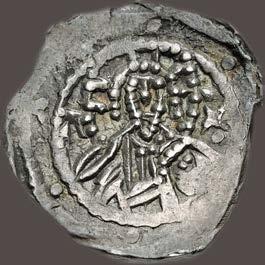

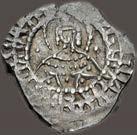

629. Constantine XI Palaeologus (Dragases). 1448-1453. AR Stavraton (20.5mm, 6.48 g, 1h). Constantinople mint. Struck 1449-1453. Nimbate facing bust of Christ Pantokrator, raising hand in benediction and holding Gospels; sigla: –|• / Nimbate and crowned facing bust of Constantine, wearing loros; sigla: •|•. DOC 1787 var. (sigla); Bendall, Coinage 83 (this coin); SB –. Attractively toned with iridescence. EF. Very rare. ($30,000)
From the Wayne Scheible Collection. Ex Berk BBS 80 (18 January 1994), lot 704; Constantine XI Hoard (1991).
Constantine XI, a member of the last Byzantine dynasty, the Palaeologan, was a heroic figure despite being fated to be the final Byzantine ruler. One of the younger sons of Emperor Manuel II, Constantine distinguished himself during the siege of Constantinople in 1422 during the last days of Manuel II’s rule. After Manuel suffered a stroke and became incapable of governing, Constantine’s older brother, future emperor John VIII, took the reins of the government on behalf of his father. However, John’s first priority was to seek to rally support for the Byzantine state against the ascendant Ottomans. In pursuit of this objective, he embarked on a tour of Western Europe. In his stead, he left his younger brother Constantine as regent and granted him the title of despot. Constantine effectively administered what was left of the shrinking Byzantine State in his brother’s absence, but John’s quest to enlist western support for Byzantium was ultimately unsuccessful.
Once John assumed the imperial mantle upon the death of Manuel II, Constantine was tasked with governing one of the few remaining possessions of the once-illustrious Byzantine Empire – the Depostate of Morea. Constantine again proved himself a capable ruler and administrator, using the limited resources he had at his disposal to recover Morea from the Franks who had occupied the Peloponnesos since the Fourth Crusade. Ultimately, Constantine’s Morea encompassed the entire Peloponnesos and, along with Epirus, constituted the bulk of Byzantine possessions outside of Constantinople which was itself quickly shrinking into a city-state as more and more territory was lost to the Ottomans.
When John died in 1448 without issue, Constantine was designated as his successor and called to assume the fateful position of emperor. Crowned at the citadel at Mystras, Constantine traveled from Morea to Constantinople in a hired Catalan galley – a succinct representation of how miserably Byzantine power had dwindled by the mid 15th century. The Byzantine fleet had been previously destroyed during the reign of John VI in a disastrous naval engagement in 1349 with the Genoese. All Constantine could do in his new station as emperor was prepare for the inevitable attack by the Ottomans. He worked to repair the city walls and recruit and muster as many soldiers as possible to mount his final defense of the city. As part of that effort, coins such as this rare example were minted to pay the mostly hired soldiers.
The attack came in late May of 1453. Constantine himself manned the ramparts and fought valiantly during the city’s final defense. He was ultimately killed upon the city walls and his corpse mutilated by the invaders. Thus ended the Byzantine Empire, an institution that lasted nearly a millennium and outlasted its parent Western Roman Empire by five centuries.
Published by Bendall



630. Andronicus I Gidon. Emperor of Trebizond, 1222-1235. AR Aspron Trachy (26.5mm, 3.07 g, 6h). The Theotokos standing slightly right on suppedion, orans / Christ Pantokrator standing facing on suppedion, raising hand in benediction and holding Gospels. DOC IV.2 1 (Anonymous Magnesian); Retowski –; Bendall, Introduction, 2.2; S. Bendall, “A Hoard of Coins of Andronicus I Gidon of Trebizond(?)” in NumCirc CXV.1 (February 2007), 3 (this coin); SB 2148 (Uncertain Nicaea). Toned, flan void, some scratches. EF. ($750)
From the Gasvoda Collection. Ex Martinez Collection (Classical Numismatic Group 115, 16 September 2020), lot 803; Numismatica Ars Classica 56 (8 October 2010), lot 856; Freeman & Sear 14 (21 June 2007), lot 538.
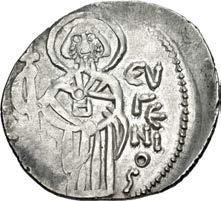



631. Theodora. Empress of Trebizond, Circa 1285. AR Asper (24mm, 2.72 g, 6h). St. Eugenius, nimbate, standing facing, holding long cross / Theodora standing facing, wearing crown and loros, holding globus cruciger; [manus Dei] to upper left. Retowski 1-2; Bendall, Introduction, 47; SB 2618. Toned, some weakness at peripheries. Good VF. Rare. ($1000)
From the Gasvoda Collection. Ex Luis A. Lopez Martinez Collection (Classical Numismatic Group Electronic Auction 504, 17 November 2021), lot 583; Classical Numismatic Group 63 (21 May 2003), lot 1746.


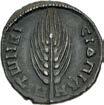
632. AXUM. Aphilas. Circa 310-early 320s. CU Lepton (17.5mm, 2.42 g, 12h). Draped bust right, wearing head-cloth; pellet-in-crescent above / Large grain ear. H&K 13; Hahn, Aksumite 9; Munro-Hay Type 13; BMC Axum, p. 28; SACAM 413. VF. H&K cite only 21 examples, of which six are in museum collections. Very rare. ($750)
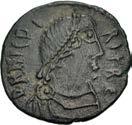



633. VANDALS. Hilderic. 523-530. AR 500 Nummi – 50 Denarii (15mm, 1.06 g, 9h). Carthage mint. D N HILDI RIX RE[X], pearl-diademed, draped, and cuirassed bust right / KARTG FELIX, Karthago standing facing, holding three grain ears in each hand. Hahn, Wertsystem –; BMC Vandals 3-6; MEC 1, 21-2. Find patina, porous. VF. ($500)
From an American Academic Collection.
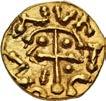



634. MEROVINGIANS, Clermont-Ferrand (region). AV Tremissis (12.5mm, 1.11 g, 12h). Á IV©IV©© Á, cross ancrée and pommée; pellets in first, second, and fourth quarters, I in third / VüI©I⍛Ie⍛ , large ¬ʼ ; below, two parallel lines, each with pellets at either end and joined by six smaller vertical lines; ©⌴© in exergue. NM –; Belfort –, but cf. 343-49 (for reverse); MEC 1, –. Toned, die rust, slight double strike on reverse. EF. Extremely rare. ($1500)
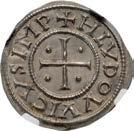


635. CAROLINGIANS. Louis ‘le Pieux’ (the Pious). As Emperor Louis I, 814-840. AR Denier (21mm, 1.64 g, 9h). Class 3. Unspecified mint. Struck 822/3-840. แ ƊǮ⎍ē⌴⎍⎍IæVs Iȵʖ , cross pattée; pellets in quarters / แ PIs⍆I²Ⱦ² ⎁⍟ǮIŶIɯ , temple façade. Coupland, Money –; Depeyrot 1179; M&G 472; cf. MEC 1, 809 (obol); Simon Coupland Collection (CNG E-467), lot 486. In NGC encapsulation 2141143-030, graded MS 64. Top Pop ($750)
From the Deer Creek Collection. Ex Triton XXVII (9 January 2024), lot 976.



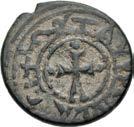
636. CRUSADERS, Edessa. Baldwin II. Second reign, 1108-1118. Æ (16mm, 1.93 g, 12h). + BA/ΓΔOY/IN XO/[MI] in four lines / + (ornate ß)TAY9I-C NIXACI, Latin cross pattée with bifurcated lower arm; pellet at each end of other arms. Metcalf, Crusades, p. 37; cf. Pesant 3/1 (obv./rev.); CCS 15c. Earthen black-green patina. Good VF. Very rare. ($750)
Ex Classical Numismatic Group 97 (17 September 2014), lot 819.
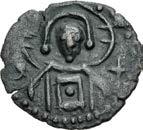


637. CRUSADERS, Edessa. Joscelin I de Courtenay or Joscelin II. 1119-1150. Æ Follis (24mm, 3.73 g, 9h). Facing bust of Christ Pantocrator / Blundered [IЄV]SЄΛ(IИ), cross pattée. Metcalf, Crusades, p. 38; R. Pesant, “Folles of Doubtful Attribution to Joscelynde Courtenay, Count of Edessa” in NumCirc XCIII.6 (July-August 1985), 3; CCS –; CNG E-343, lot 661. Brown and dark green surfaces, areas of peripheral weakness, edge split. Good VF. Attractive example. Very rare. ($750)



638. CRUSADERS, Cyprus. Richard. King of England, 1189-1199. BI Denier(?) (15mm, 0.85 g, 9h). Crowned facing bust, holding cross-tipped scepter and globus cruciger / Cross on one step; arms ending in R Є X. Cf. Metcalf, Lusignan p. 2 (for copper issue); R. Bendall, “A Cypriot Coin of Richard I Lion-heart?” in NumCirc CX.2 (April 2002), pp. 62-3 (same); cf. I. and W. Schultze, “A Cypriot Coin of Richard I Lion-heart” in NumCirc CXI.1 (February 2003), pp. 6-7 (same); R. Bendall, “Richard I in Cyprus Again” in NumCirc CXXII.2 (April 2004), pp. 85-6 (this coin). Toned, roughness. Near VF. Very rare in this metal. ($750)
Ex Simon Bendall Collection (Classical Numismatic Group Electronic Auction 473, 29 July 2020), lot 482.
The exact relation of this billon piece to the bronze tetartera is still unknown. Bendall (Richard I in Cyprus Again,” NumCirc CXXII.2 [April 2004]) speculated that the earliest coinage of Richard in Cyprus was in billon, with the later bronzes a debasement, though proper metallurgical studies have not yet been performed to examine this theory. In any case, there is a small variation in the types: on the copper issue, the cross is set on three steps, while this is on only one.

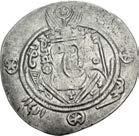


639. Pre-reform issues, Tabaristan (‘Abbasid governors). Nusayr (or Sa‘d). AH 168 / AD 784/5. AR Hemidrachm (23.5mm, 2.14 g, 6h). al-Rayy mint. Dated AH 168 = PYE 133 (AD 784/5). Crowned Tabaristan-type bust right; GDH monogram and ‘pzwt in Pahlavi to left; nsyl in Pahlavi to right; ‘pd and nwk’ in outer margin / Fire altar flanked by attendants; star and crescent flanking flames; b-al-rayy in Arabic (mint) to left; thaman wa sittin wa mi’a (date) in Arabic to right; alternating triple pellets and star-in-crescents in outer margin. Malek 212.1-3; SICA 1, 352; Album L73; CNG 109, lot 789. Light iridescent toning, slight porosity, areas of weak strike. EF. Extremely rare and excellent for issue. ($500)
Album notes that Nusayr has been tentatively identified as Nusayr al-Wasif, chief of intelligence under the Abbasid caliph al-Mahdi.



640. Isma’ilis of Alamut (Batinids). ‘Ala’ al-Din Muhammad III. AH 618-653 / AD 1221-1255. Æ Fals (16.5mm, 1.82 g, 9h). Figural (Bird) type. No mint or AH date. al-mawla/al-a’zam in two lines / Stylized bird to right, formed from the letters of the name Muhammad b. al-Hasan. Album 1291I; Islamic 9, lot 471; Album 49, lot 554; Album 41, lot 515. Earthen brown and dark green patina. VF. Extremely rare. ($1500)
The stylised bird formed from Muhammad b. al-Hasan’s name would have been a particularly appropriate design for the Isma’ilis of Alamut, since the name ‘Alamut’ translates as ‘Eagle’s Nest.’
Headquartered in the remote Alborz Mountains north of Qazwin at Kursi al-Daylam (modern-day Alamut), the Order of Assassins, derived from an amalgamation of the Arabic term Hashshashin, meaning ‘users of hashish,’ and Asāsīyūn (i.e. ‘people who are faithful to the foundation of the faith’), instilled fear across the region for almost two hundred years via targeted assassinations. Assasinating prominent Fatamid, ‘Abbasid, Seljuk, and Christian leaders alike, their reign of terror ultimately came to an end with the Mongol invasion. Hulagu Khan, a grandson of Genghis, besieged Alamut in AD 1256. After a 15-day siege, the Order surrendered, and within twenty years, was dissolved.

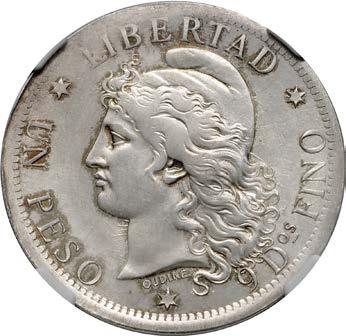
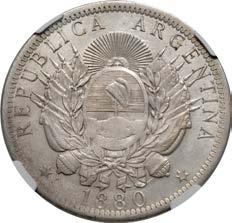
641. ARGENTINA, Republic. 1861-pres. Pattern AR Peso (37mm, 6h). Dies by Eugène André Oudiné. Dated 1880, though a 20th century unofficial restrike. LIBERTAD ო UN PESO ო 9 Dos FINO ო , head of Liberty left, wearing cap; OUDINÉ below / ო REPUBLICA ARGENTINA ო 1880, coat-of-arms within wreath; flags behind; rising sun above. KM Pn20. Toned. In NGC encapsulation 6636266-010, graded MS 63. ($500)

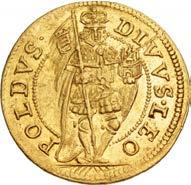
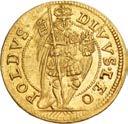
642. AUSTRIA, Holy Roman Empire. Leopold V. Archduke, 1619-1632. AV Dukat (20mm, 3.43 g, 12h). Hall mint. Leopold in armor standing facing, holding scepter and resting hand on hilt of sword / St. Leopold, crowned and in armor, standing facing, holding banner and model of church. Moser & Tursky 484; KM 757; Friedberg 184. In NGC encapsulation 8383380-003, graded AU 58. Top Pop ($1500)
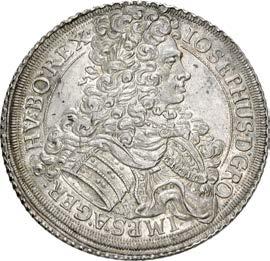
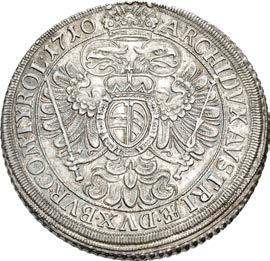
643. AUSTRIA, Holy Roman Empire. Josef I. Emperor, 1705-1711. AR Taler (44mm, 28.78 g, 12h). Wien (Vienna) mint. Dated 1710/00 IMH. Laureate and armored bust right / Crowned double-headed eagle with wings spread; crowned and collared coat-of-arms on breast. Voglhuber 251; Davenport 1014; KM 1505 (overdate not noted). Toned. In NGC encapsulation 8372254-015, graded MS 63. ($1000)
From the Alexander Christopher Collection.


644. AUSTRIA, Holy Roman Empire. Karl VI. Emperor, 1711-1740. AR Taler (44mm, 28.77 g, 12h). Wien (Vienna) mint. Dated 1715. Laureate and armored bust right / Crowned double-headed eagle with wings spread; crowned and collared coat-of-arms on breast. Voglhuber 251; Davenport 1035; KM 1522. Lightly toned. In NGC encapsulation 8372254-014, graded MS 63+. ($1000)
From the Alexander Christopher Collection.

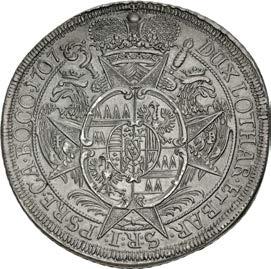
645. AUSTRIA, Olmütz (Bishophric). Karl III von Lothringen. 1695-1710. AR Taler (44mm, 28.28 g, 12h). Dated 1707. Bust right / Crowned coat-of-arms on crossed sword and crozier; crowned griffn supporters. KM 378; Davenport 1211. Attractively toned, minor edge mark, light hairlines. EF. ($500)
From the Deer Creek Collection. Ex CJR Collection (Classical Numismatic Group 124, 19 September 2023), lot 823.



646. AUSTRIA, Salzburg (Prince-Archbishophric). Johann Jakob Khuen von Belasi. 1560-1586. AV Dukat (21mm, 3.46 g, 7h). Dated 1574. Half-length bust of St. Rupert, in episcopal regalia, facing slightly left; coat-of-arms below / Crowned double-headed eagle with wings spread. Zöttl 574; Probszt 502; Friedberg 637. In NGC encapsulation 8383380-004, graded MS 61. ($1000)
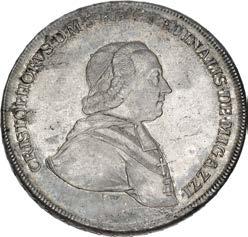

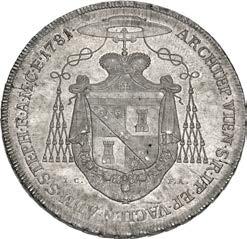
647. AUSTRIA, Wien (Vienna [Prince-Archbishophric]). Christoph Bartholomäus Anton Migazzi. 1757-1803. AR Taler (40mm, 28.08 g, 12h). Wien (Vienna) mint. Dated 1781 IC FA. Bust right, wearing mozzetta and zuchetto / Crowned, mantled, and collared coat-of-arms surmounted by tasseled gallero. Davenport 1267; KM 1. Toned. In NGC encapsulation 8372254-012, graded MS 63. Top Pop ($500)
From the Alexander Christopher Collection.
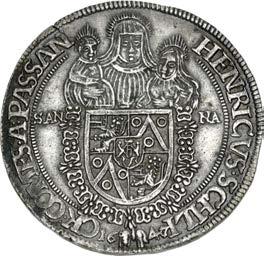
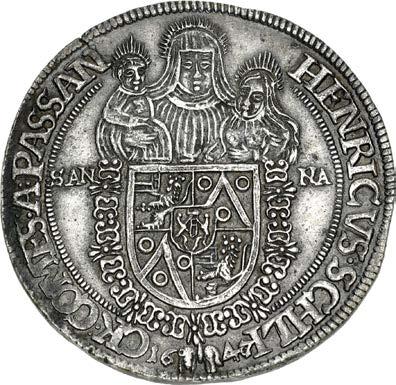
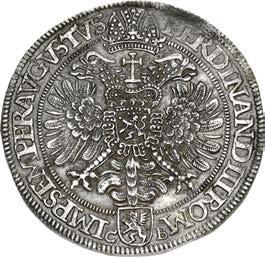
648. BOHEMIA, Schlick (Šliků [County]). Heinrich IV. 1612-1650. AR Taler (43mm, 29.11 g, 2h). In the name of Ferdinand III, Holy Roman Emperor. Joachimstal (Jáchymov) mint. Dated 1647/6 CB. Bust of St. Anna facing, holding infant Christ and embracing Virgin / Double-headed eagle on crowned cross; crowned and collared coat-of-arms on breast; coat-ofarms below. Smetana & Jakymenková CB18b; Davenport 3408; KM 9 (overdate not noted). Toned. In NGC encapsulation 8372854-003, graded AU 58. Rare. ($1500)
From the Drewry Family Collection. Ex Frank Katen 50 (20 April 1979), lot 70.




649. BRAZIL, Colonial. Joao VI. As prince regent, 1799-1816. AR 960 Réis (40mm). Struck for use in Minas Gerias, 1808-1810. Crowned coat-of-arms within wreath / Armillary sphere. Countermarked on a Bolivian 8 Reales dated 1806 (PTS)
PJ. For countermark: Gomes 112.02; KM 242. For host: KM 73. In NGC encapsulation 5971180-001, graded AU 53, c/s UNC Strong. Top Pop. ($500)
From the Deer Creek Collection. Ex Michael Cassick Collection (Triton XXV, 11 January 2022), lot 1131, purchased January 2001.
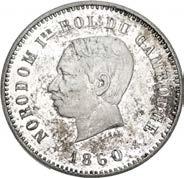
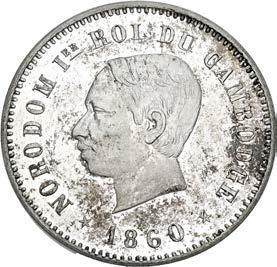

650. CAMBODIA, French Protectorate. Norodom I. 1860-1904. AR 10 Centimes Essai (30mm, 10.99 g, 6h). Brussels mint. Dies by C. Wurden. Dated 1860, though struck 1875. NORODOM IER ROI DU CAMBODGE, bare head left; ESSAY and (star) 1860 (star) below / Coat-of-arms; DIX CENTIMES below. Lecompte 15; MCF 3; KM (X) E3a. In NGC encapsulation 8372843-005, graded SP 64. Top Pop ($2000)
From the Alexander Christopher Collection.
The coinage of Norodom I is traditionally divided into “original” and “restrike” issues struck at Birmingham, Brussels, or Phnom Penh. However, examination of mint records suggests that the date 1860 in fact represents the accession date of the ruler and not, as is custom, the date of issue. It is likely that the first issues of the series were struck in 1875, when new presses were delivered to Cambodia, and continued to be struck sporadically in both the native Cambodian and European mints until the late 19th century. The series has yet to be studied closely enough to allow individual issues to be assigned to the various mints, but it would appear that at least the pieces struck from very worn dies can be attributed to Cambodia.

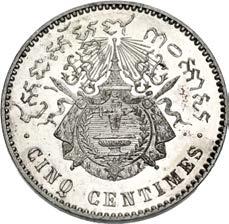
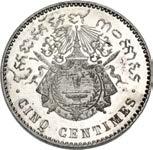
651. CAMBODIA, French Protectorate. Norodom I. 1860-1904. AR 5 Centimes Essai (25mm, 5.82 g, 6h). Brussels mint. Dies by C. Wurden. Dated 1860 E, though struck 1875. NORODOM I ROI DU CAMBODGE, bare head left; E to left, 1860 below / Coat-of-arms; CINQ CENTIMES below. Lecompte 10; MCF 2 var. (metal); KM (X) E2 var. (same). In NGC encapsulation 8372843-006, graded SP 63. ($2000)
From the Alexander Christopher Collection.



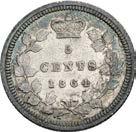
652. CANADA, New Brunswick. Victoria. 1837-1901. AR 5 Cents (15mm, 6h). London mint. Dated 1864. Laureate head left / Crowned denomination and date within maple wreath. Large 6. KM 7. Attractive iridescent toning. In NGC encapsulation 8395632-001, graded AU 53. ($1000)
From the Alexander Christopher Collection.


653. CANADA, Newfoundland. Victoria. 1837-1901. AR 50 Cents (29mm, 6h). Heaton mint. Dated 1876 H. Laureate head left / Denomination and date within decorative border. KM 6. In NGC encapsulation 8395632-006, graded AU Details, Cleaned. Low mintage of 28,000. ($500)
From the Alexander Christopher Collection.

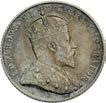


654. CANADA, Newfoundland. Edward VII. 1901-1910. Specimen AR 10 Cents (17.5mm, 12h). London mint. Dated 1903. Crowned and mantled bust right / Denomination and date within decorative border. KM 8. Beautiful iridescent toning. In NGC encapsulation 8395632-005, graded SP 61 Matte. Top Pop. Only one other graded at PCGS. ($1000)
From the Alexander Christopher Collection.



655. CANADA. George V. 1910-1936. Specimen AR 25 Cents (23mm, 12h). Ottawa mint. Dated 1911. Crowned and mantled bust left / Crowned denomination and date within maple wreath. Cf. KM 18 (for circulation issue). In PCGS encapsulation 9246904, graded SP 64. ($500)


656. CARRIBEAN TERRITORIES, Danish West Indies. Christian IX. 1863-1906. AV 4 Daler – 20 Francs (20mm, 6.45 g, 12h). København (Copenhagen) mint; mm: heart. Dated 1904. Bare head left / Female figure seated left, head right; in background, ship loaded with bales. KM 72; Friedberg 2. In NGC encapsulation 8375962-012, graded MS 64. ($750)
From the William H. Birkinshaw Collection.


657. CHINA, Eastern Zhou dynasty - Warring States Period. State of Qí. Circa 400-220 BC. Æ Qi Knife (185x28mm, 62.67 g). ji mo zhi fa hua (= Jimo Legal Money) in jīnwén (bronzeware script) characters / Three lines (or san?) and che (or cao?) in jīnwén (bronzeware script) characters. Cf. BN, Chinoises I 336-7 (for obv.); Hartill 4.2m. Green and red-brown patina. Near EF. Notable type with five characters. ($5000)
From the J.P. Righetti Collection.


658. CHINA, Eastern Zhou dynasty - Warring States Period. State of Qí Circa 400-220 BC. Æ Qi Knife (167x28mm, 44.63 g). qi fa hua (= Qi Legal Money) in jīnwén (bronzeware script) characters / Three lines (or san?) and che? (or cao?) in jīnwén (bronzeware script) characters. BN, Chinoises I 339; Hartill 4.6-7m. Green-brown patina with light earthen deposits, tip broken, collector’s sticker. Good VF. ($500)
From the J.P. Righetti Collection.


659. CHINA, Eastern Zhou dynasty - Warring States Period. State of Qí. Circa 400-220 BC. Æ Qi Knife (181x29mm, 47.28 g). qi fa hua (= Qi Legal Money) in jīnwén (bronzeware script) characters / Three lines (or san?) and chang (or gan?) in jīnwén (bronzeware script) characters. Cf. BN, Chinoises I 339-42; Hartill 4.6-7aa. Green patina with thick green encrustation and brown earthen deposits. Good VF. ($500)
From the J.P. Righetti Collection.


660. CHINA, Eastern Zhou dynasty - Warring States Period. State of Qí Circa 400-220 BC. Æ Qi Knife (180x29mm, 50.28 g). qi fa hua (= Qi Legal Money) in jīnwén (bronzeware script) characters / Three lines (or san?) and qi (or bi) in jīnwén (bronzeware script) characters. Cf. BN, Chinoises I 339-42; Hartill 4.6-7e. Green patina with thick green and brown earthen deposits, a few cleaning scratches in deposits. Good VF. ($500)
From the J.P. Righetti Collection.


661. CHINA, Eastern Zhou dynasty - Warring States Period. State of Qí. Circa 400-220 BC. Æ Qi Knife (179x29mm, 45.00 g). qi fa hua (= Qi Legal Money) in jīnwén (bronzeware script) characters / Three lines (or san?) and yi (or yang) in jīnwén (bronzeware script) characters. Cf. BN, Chinoises I 339-42; Hartill 4.6-7x. Green patina with thick green and brown earthen deposits, collector’s sticker. Good VF. ($500)
From the J.P. Righetti Collection.


662. CHINA, Eastern Zhou dynasty - Warring States Period. State of Qí. Circa 400-220 BC. Æ Qi Knife (178x28mm, 48.57 g). qi fa hua (= Qi Legal Money) in jīnwén (bronzeware script) characters / Three lines (or san?) and dao? in jīnwén (bronzeware script) characters. Cf. BN, Chinoises I 339-42; cf. Hartill 4.6-7 (unlisted rev. character). Green patina with thick green and brown earthen deposits. Good VF. ($500)
From the J.P. Righetti Collection.


663. CHINA, Eastern Zhou dynasty - Warring States Period. State of Qí. Circa 400-220 BC. Æ Qi Knife (180x28mm, 46.51 g). qi fa hua (= Qi Legal Money) in jīnwén (bronzeware script) characters / Three lines (or san?) and tu (or shi) in jīnwén (bronzeware script) characters. Cf. BN, Chinoises I 342; Hartill 4.6-7l. Green patina with thick green and brown earthen deposits. Good VF. ($500)
From the J.P. Righetti Collection.
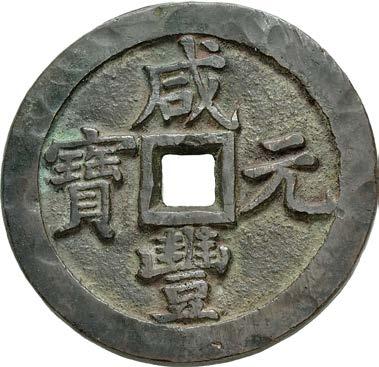
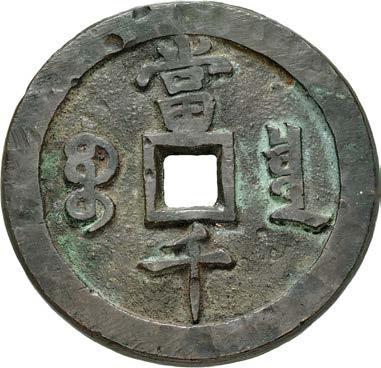
664. CHINA, Qīng dynasty. Wénzōng (Xiánfēng). AD 1851-1861. Æ 1000 Cash (63mm, 69.42 g, 12h). Board of Revenue mint, north branch. Cast March-August 1854. Xian Feng Yuan Bao in Hànzì characters / Dang Qian (Value One Thousand) in Hànzì characters and boo chiowan in Manchu script. Hartill 22.714. Brown patina with green deposits, numerous bumps and marks. VF. ($750)


665. CHINA, Qīng dynasty. Wénzōng (Xiánfēng). AD 1851-1861. Æ 50 Cash (56mm, 96.54 g, 12h). Fuzhou mint in Fujian pronvince. Cast circa 1853-1855. Xian Feng Tong Bao in Hànzì characters / Wu Shi (Fifty) in Hànzì characters and boo fu in Manchu script. Hartill 22.782. Brown patina, light scratches. VF. ($750)


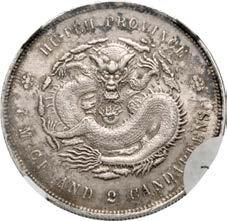
666. CHINA, Qīng dynasty Provincial issues Húběi. AR 7 Mace 2 Candareens – Dollar. Wǔchāng mint. Struck 1909 Legend in Hànzì characters around legend in Manchu script / Flying imperial dragon facing, coiled leftward around flaming pearl. L&M 187; KM (Y) 131. In NGC encapsulation 8380308-007, graded MS 62. ($1500)



667. CHINA, Qīng dynasty Provincial issues Fèngtiān. AR 7 Mace 2 Candareens – Dollar (38mm, 12h). Fèngtiān mint. Dated RY 24 of Dézōng (Guāngxù) (AD 1898). Dragon flying facing around central pearl; stylized clouds around; narrow mustache variety / Denomination at center in Hànzì characters; legend in English and Manchu script around. Pointed Yī in denomination. L&M 471; KM (Y) 87. Toned. In PCGS encapsulation 89293789, graded VF Details, repaired. ($2000)
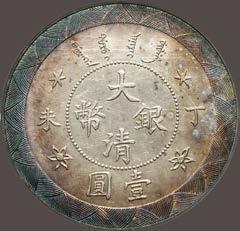

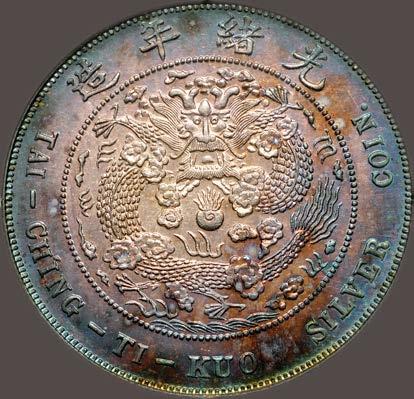
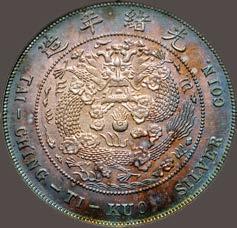
668. CHINA, Qīng dynasty. General issues. Pattern AR Yuán – Dollar (39mm, 12h). In the name of Dézōng (Guāngxù). Tiānjīn Central (Tientsin) mint. Dated Gānzhī year Dīngwèi (AD 1907). Legend in Manchu script flanked by stars of six rays, Dīng Wèi (date) in Hànzì characters flanking across field, flowers flanking Yì Yuán (denomination) in Hànzì characters, all within outer border; Dà Qīng Yín Bì in Hànzì characters within central dotted border; all surrounded by stylized waterwave motif border / Dragon flying facing around central flaming pearl; stylized clouds around; Guāng Xù Nián Zào in Hànzì characters and TAI – CH‘ING – TI – KUO SILVER COIN. across outer border. L&M 20; Kann 212; KM 212. Beautiful iridescent toning. In ANACS encapsulation 2736317, graded MS 62. ($50,000)
The standard upon which Chinese machine-struck coinage was based was a matter of some debate from the beginning of its issue. Some were struck on the traditional Chinese weight “Liang (Tael),” while others advocated for using the “7 mace and 2 candareens” system, or “Yuan (Dollar),” which was more in line with international standards and close in weight to the Mexican (8 Reales) widely used in trade.
During the ongoing debate, the Ministry of Revenue adopted the silver Tael standard on 19 November 1905, and the Tiānjīn Mint began preparations, resulting in the “Bing Wu Silver Tael” pattern coin. However, most provinces did not officially implement the new standard.
In 1906, the Qing government established the Ministry of Finance (Duzhibu), which in April 1907 proposed replacing the tael-based coinage with a new national system based on the Dollar. The principal coin of this new series was the “Ding Wei Silver Dollar (this issue).” Its design was adapted from the earlier “Bing Wu” Silver Tael, with reduced outer water-wave motifs, partial text removal, the cyclical year changed to “Ding Wei,” and the denomination updated to “One Yuan” (or One Dollar). According to the record jointly submitted by Minister Zai Ze and others on 17 August 1907, titled “Articles of the Newly Issued General Silver Coins and their Finenesses and Weights «进呈新铸通用银币 及议定成色分量章程»” 400 sample sets were presented, though the actual number minted was probably higher
The reformation, however, was met with strong opposition from advocates of the tael standard, such as Zhang Zhidong and Yuan Shikai. As all the relevant parties were unable to reach a consensus, the reformation was shelved once again. Many of the coins that had been struck were likely melted down, and as a result, few examples survive today and are rarely seen on the market.
The monetary system dispute in the Qing Dynasty continued. However, in late 1908, just as there were plans to revert to the tael system, both Emperor Guāngxù and Empress Cixi passed away. Thus, this “Ding Wei Silver Dollar” became the final silver coin of Guāngxù’s reign. Soon afterwards, key advocates for the tael system also died, and the long-standing monetary debate quietly came to an end.



669. CHINA, Republic of China. General issues. 1912-1949. AR 50 Cents – 3 Mace 6 Candareens (32mm, 12h). Comemmorating General Táng Jìyáo. Kunming mint. Struck 1916. Uniformed bust right / Crossed flags; star above. L&M 862; KM (Y) 480. Toned. In PCGS encapsulation 50319569, graded XF Details, cleaned. ($750)

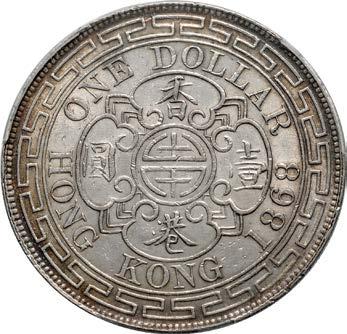

670. CHINA, Foreign Enclaves. Hong Kong. Victoria. Queen of Great Britain, 1837-1901. AR Dollar (38mm, 12h). Hong Kong mint. Dated 1868. Crowned head left within border / Legend in Hànzì on floral quadrilobe; all within border. Pridmore 3; KM 10. Toned. In PCGS encapsulation 50670826, graded AU 50. The final year of production at the Hong Kong mint. ($2000)
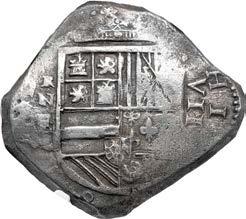
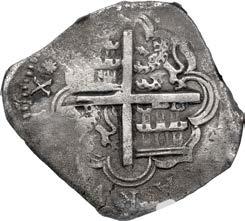
671. COLOMBIA, Colonial. Felipe IV. King of Spain, 1621-1665. AR 8 Reales (39.5mm 11h). Cob issue. Cartagena mint. Struck circa 1626-1629. Crowned coat-of-arms; R/N/E to left, denomination to right / Quartered coat-of-arms within polylobe. Restrepo M45; cf. Menzel Ca-10 and Ca-12; KM 3.4. In NGC encapsulation 6634570-010, graded XF Details, Saltwater Damage. ($750)
Top Pop Colombian Real – Extremely Rare Legend Error
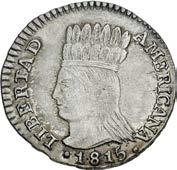



672. COLOMBIA, War of Independence. Provincial coinage. Cundinamarca. 1810-1821. AR Real (19mm, 2.68 g, 6h). Bogotá mint. Dated 1815 JF. Head of Native American left, wearing feathered headdress / Pomegranate; NVEBA (sic) in legend. Restrepo 133.3; KM F1; cf. Sedwick 34 (2 November 2023), lot 1159 (hammer $2800). Toned. In NGC encapsulation 8372738-014, graded MS 62. Extremely rare legend error. Restrepo notes only 3-5 examples known. Top Pop ($3000)
From the Alexander Christopher Collection.

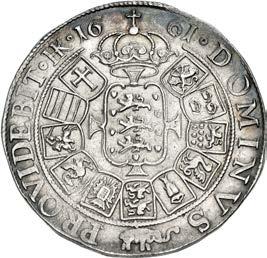
673. DENMARK. Frederik III. 1648-1670. AR Speciedaler (44mm, 28.26 g, 12h). København (Copenhagen) mint. Dated 1661 (HK). Crowned, draped, and cuirassed bust right / Crowned coat-of-arms over cross surrounded by collar of provincial arms within border from which the Order of the Elephant is suspended. Hede 57B; KM 238; Davenport 3546A. Peripheral iridescent toning, minor marks, light hairlines. Near EF ($1500)

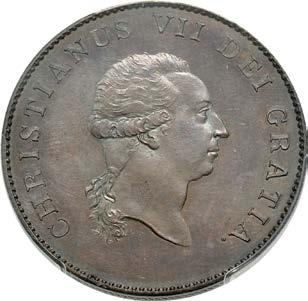
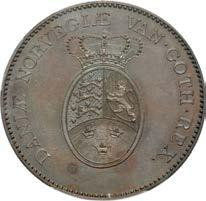
674. DENMARK. Christian VII. 1766-1808. Specimen CU 2/3 Speciedaler (34mm, 6h). København (Copenhagen) mint. Bare head right / Crowned coat-of-arms. Hede 17; KM –. In PCGS encapsulation 84087938, graded SP 63 BN. Top Pop ($500)



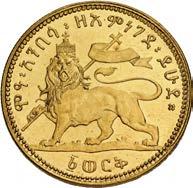
675. ETHIOPIA, Ethiopian Empire. Menelik II. 1889-1913. AV Werk (20mm, 5.42 g, 12h). Addis Ababa mint. Dated EE 1889 (AD 1897). Crowned bust right set on wreath / Crowned Lion of Judah left, head facing, holding banner on cross over shoulder. Gill p. 111; KM 18. In NGC encapsulation 8375962-006, graded MS 64 PL. ($1000)
From the William H. Birkinshaw Collection.


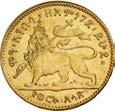
676. ETHIOPIA, Ethiopian Empire. Menelik II. 1889-1913. AV Half Werk (18mm, 2.79 g, 10h). Addis Ababa mint. Dated EE 1889 (AD 1897). Crowned bust right set on wreath / Crowned Lion of Judah left, head facing, holding banner on cross over shoulder. Gill p. 111; KM 17. In NGC encapsulation 8375962-008, graded MS 65. Top Pop. ($1000)
From the William H. Birkinshaw Collection.

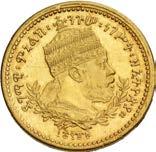

677. ETHIOPIA, Ethiopian Empire. Menelik II. 1889-1913. AV Quarter Werk (17mm, 2.77 g, 11h). Addis Ababa mint. Dated EE 1889 (AD 1897). Crowned bust right set on wreath / Crowned Lion of Judah left, head facing, holding banner on cross over shoulder. Gill p. 111; KM 16. In NGC encapsulation 8375962-010, graded MS 65+. Top Pop ($750)
From the William H. Birkinshaw Collection.



678. FRANCE, Royal. Philippe VI de Valois. 1328-1350. AV Lion d’or (30mm, 4.86 g, 11h). Authorized 31 October 1338. ი ʖƑ=
, Philippe seated facing within Gothic portico, holding lis-tipped scepter in each hand; at feet, lion seated left, head facing /
, cross quadrilobée, feuilluée, and fleurdelisée; quadrilobe in center of cross; all within quadrilobe, arcs ending in trefoils; crowns in spandrels. Duplessy 250; Ciani 290; Friedberg 265. Light orange tone with flashes of luster. In NGC encapsulation 6458806-001, graded MS 61. A very well struck up example with excellent detail to king and lion–rare thus. Conservatively graded by NGC in our opinion. ($5000)
From the Deer Creek Collection. Ex Classical Numismatic Group 121 (6 October 2022), lot 1168.


679. FRANCE, Royal. Philippe VI de Valois. 1328-1350. AV Lion d’or (31mm, 4.87 g, 7h). Authorized 31 October 1338.
, Philippe seated facing within Gothic portico, holding lis-tipped scepter in each hand; at feet, lion seated left, head facing /
, cross quadrilobée, feuilluée, and fleurdelisée; quadrilobe in center of cross; all within quadrilobe, arcs ending in trefoils; crowns in spandrels. Duplessy 250; Ciani 290; Friedberg 265. Riverine surfaces, traces of deposits, digs, crimped and straightened. VF. ($2000)



680. FRANCE, First Empire. Napoléon I. 1804-1814. AV 40 Francs (26mm, 12.84 g, 6h). Paris mint; différents: signature/rooster. Dated L’An 13 A (AD 1804/5). Bare head left / Denomination within wreath. VG 1081; KM 664.1; Friedberg 481. Toned, marks. VF. ($1000)
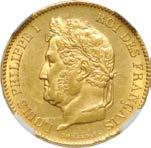


681. FRANCE, Royal (Restored). Louis Philippe. 1830-1848. AV 40 Francs (25mm, 6h). Rouen mint; différent: Agnus Dei. Dated 1832 B. Laureate head left / Denomination and date within wreath. VG 1106; KM 747.2; Friedberg 558. In NGC encapsulation 6771849-001, graded MS 60. Low mintage. ($1000)

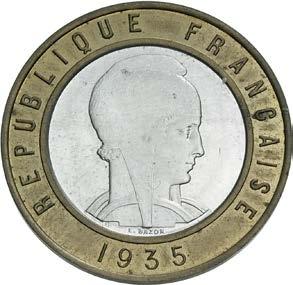

682. FRANCE, Third Republic. 1870-1940. Bimetallic Bronze and Aluminum Essai de 25 Francs (30mm). Paris mint. Die by Bazor. Dated 1935. REPUBLIQUE FRANÇAISE, head of Marianne right, wearing liberty cap; 1935 below / Blank. Gadoury, Essais 219.21; Mazard –; KM –. In NGC encapsulation 8395632-012, graded MS 65. Extremely rare – only three known, with only one in CoinArchives. Top Pop ($1000)
From the Alexander Christopher Collection.



683. FRANCE, Provincial. Strasbourg (city). AV Ducat (22mm, 3.49 g, 12h). Struck circa 1650. Coat-of-arms surmounted by ornately crested helmet / Legend in four lines within garnished frame. Engel & Lehr 488; KM 424.1; Friedberg 235b. In NGC encapsulation 8338380-006, graded MS 62. Top Pop ($1500)
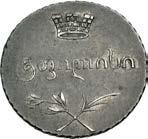



684. GEORGIA, Russian Rule. temp. Aleksandr I Pavlovich. 1801-1825. AR Half Abazi (16mm, 12h). Tbilisi mint. Dated 1804 ПЗ (in Mkhedruli numerals). Legend; turreted crown above, crossed olive branch and palm frond below / Date and denomination. Bennett 1135; Bitkin 773; KM 73. Toned. In NGC encapsulation 8395632-015, graded AU Details, scratches. ($2000)
From the Alexander Christopher Collection.




685. GERMANY, Augsburg (city). nomine Ferdinand III. Holy Roman Emperor, 1637-1657. AV Dukat (21mm, 3.49 g, 12h). Dated 1647. Laureate and armored bust right / Coat-of-arms. Forster 309; KM 83; Friedberg 61. In NGC encapsulation 8383380-005, graded MS 60. Top Pop ($1000)


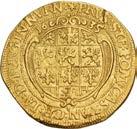
686. GERMANY, Brandenburg-Bayreuth (Margravate). Christian. 1604-1655. AV Dukat (22mm, 3.41 g, 12h). Nürnberg mint. Dated 1635. Armored figure of Christian, standing slightly right, holding baton and resting hand on sword hilt set in sheath; small coat-of-arms below; plumed helmet set on table to right / Coat-of-arms. Cf. KM 6; cf. Friedberg 368; Slg. Grüber (Künker 267, 29 September 2015), lot 3450. Toned, tiny flan crack, scratches. VF. ($750)

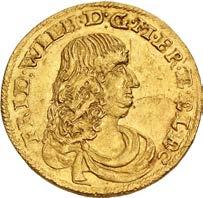
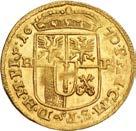
687. GERMANY, Brandenburg-Preußen (Electorate & Duchy). Friedrich Wilhelm. 1640-1688. AV Dukat (22mm, 3.45 g, 4h). Minden mint. Dated 1670 HB. Draped bust right / Crowned coat-of-arms. Neumann 11.28; KM 413. In NGC encapsulation 8383383-001, graded MS 62. ($6000)



688. GERMANY, Erfurt (Swedish occupation). Gustav II Adolf. King of Sweden, 1611-1632. AR Taler (42mm, 28.97 g, 2h). Commemorating the second anniversary of the victory at Leipzig. Dated 1632. Radiate Tetragrammaton; floral spray below / Legend in eleven lines. AAJ 12; Delzanno 352; Davenport 4546; KM 59. Toned, deposit on edge, minor marks and hairlines. VF. ($500)
Ex Peus 426 (16 June 2020), lot 856; Peus 371 (24 April 2002), lot 2070.
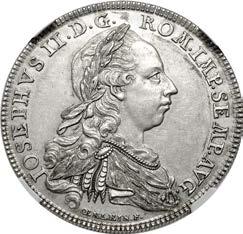

689. GERMANY, Hall in Schwaben (City). Josef II. Holy Roman Emperor, 1765-1790. AR Taler (40mm, 12h). Hall mint. Dated 1777 (OE)XLEIN K R. Laureate, draped, and cuirassed bust right / Three ornate coat-of-arms; laurel branches flanking the top coat-of-arms. KM 47; Davenport 2280. In NGC encapsulation 8378053-003, graded AU 58. Low reported mintage of 406. ($1000)
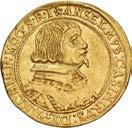

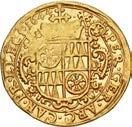
690. GERMANY, Mainz (Archbishophric-electorate). Anselm Casimir Wambold von Umstadt. 1629-1647. AV Dukat (22mm, 3.40 g, 12h). Dated 1644. Mantled bust right / Crowned coat-of-arms over crossed sword and crozier. KM 60; Friedberg 1647. In NGC encapsulation 8403848-006, graded AU 58. Top Pop ($1000)


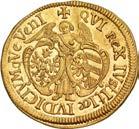
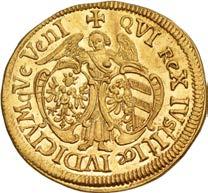
691. GERMANY, Nürnberg (city). AV Dukat (23mm, 3.46 g, 12h). Dated 1648 (in chronogram). Crowned eagle facing with wings spread, head right / Angel standing facing, head left, resting arms on two coats-of-arms; cross above. Kellner 65; KM 137; Friedberg 1830. In NGC encapsulation 8388380-001, graded MS 64. ($2000)




692. GERMANY, Nürnberg (city). AV ½ Dukat Kippe (14mm, 12h). Dated 1700 GFN. Turreted coat-of-arms within wreath of palm fronds / Agnus Dei advancing left, holding banner. Kellner 90; KM 256; Friedberg 1888. In PCGS encapsulation 16135263, graded MS 63. ($750)
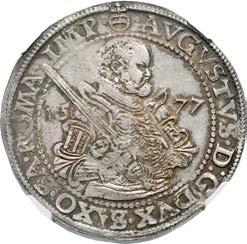


693. GERMANY, Sachsen (Duchy & Electorate [Albertine line]). August. Elector, 1553-1586. AR Taler (40mm, 3h). Dresden mint. Dated 1577 (HB). Armored half-length bust right, holding sword over shoulder / Coat-of-arms surmounted by three ornately crested helmets. Keilitz & Kahnt 68; Davenport 9798. Attractive iridescent toning. In NGC encapsulation 6637566-001, graded MS 61. ($500)



694. GERMANY, Sachsen (Duchy & Electorate [Albertine line]). Christian II, with Johann Georg and August. Elector, 1591-1611. AR Taler (41mm, 29.13 g, 10h). Dresden mint. Dated 1595 (HB). Busts of Christian II, Johan Georg, and August facing, each wearing ruff / Coat-of-arms surmounted by three ornately crested helmets. Keilitz & Kahn 186; Davenport 9820. Toned. In NGC encapsulation 8372843-003, graded MS 63. ($750)
From the Drewry Family Collection. Ex Charles Wyatt 15 (15 October 1986), lot 183.

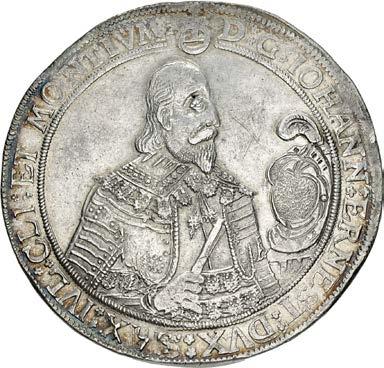
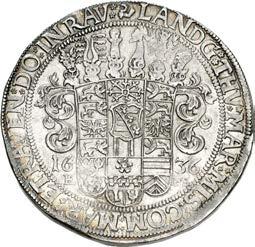
695. GERMANY, Sachsen-Coburg-Eisenach (Duchy). Johann Ernst I. 1633-1638. AR Taler (41mm, 29.09 g, 5h). Coburg mint. Dated 1636 EFS. Armored bust right, holding baton; plumed helmet to right / Coat-of-arms surmounted by six ornately crested helmets. KOR 338.1; Davenport 7437 (Saxe-Gotha); KM 169 (Saxe-Old-Gotha). In PCGS encapsulation 49713783, graded AU Details, cleaned. ($1500)
Ex Alexander Christopher Collection.



696. GERMANY, Stolberg-Stolberg (County). Wolfgang Georg. 1615-1631. AR Taler (45mm, 28.88 g, 3h). Stolberg mint. Dated 1624 CZ. Coat-of-arms surmounted by three ornately plumed helmets / Stag standing left. Davenport 7778; KM 52. Golden iridescent toning with significant luster, minor double strike, some faint hairlines. AU. ($750)
From the Deer Creek Collection. Ex Alexander Christopher Collection.



697. GERMANY, Straßburg (city). Strasbourg Bishops’ War (Bischöflicher Krieg). Besieged by the Roman Catholic bishop, Herzog Karl von Lothringen, 1592. AR 80 Kreuzer Klippe (33x35mm, 29.05 g). Dated 1592. Coat-of-arms of the Prince-Bishop; below, coats-of-arms of the cathedral chapter and city of Straßburg; 15 9Z flanking upper shield; 80 (mark of value) in exergue; all within wreath / Blank. E&L 448; Mailliet 1; Brause-Mansfeld I, pl. 25, 2; Lasser 1188. Iridescent toning, areas of weakness and double strike, striking fractures. VF. ($500)
Taking place between 1592 and 1604, the Strasbourg Bishops’ War was a conflict between Protestants and Catholics for control of the Bishopric of the city. One of two sectarian wars that broke out within the Holy Roman Empire between the 1555 Peace of Augsburg and the outbreak of the Thirty Years’ War in 1618, it proved to be less bloody than the other sectarian war, the 1583-1588 Truchsessischer Krieg over control of Köln. Benefitting from the Peace of Augsburg, Straßburg enjoyed a larger amount of autonomy, status as an important trading center, and the site of a prestigious university. This university initially attracted radical thinkers of both religious sides. By the beginning of the war, both the university and the town were strongly Protestant. When the city’s bishop, Johann von Manderscheid, died, Protestants, fearing that the Catholic Karl von Lothringen would stand for election as the new bishop (which he did), seized the episcopal offices and appointed fifteen-year-old Johann Georg, son of the Elector of Brandenburg, in the hopes that Protestant Germany would rally behind them. In addition, the Protestants acquired a loan of 300,000 florins from Friedrich I, Duke of Württemburg, to assist their cause. The Catholic prelates meanwhile fled to Saverne, and in exile, elected Karl as bishop. With the support of his younger brother Franz, Karl moved from Saverne to take Straßburg. Owing to the unwillingnes of the Holy Roman Emperor, Rudolf II, to intervene, Henri IV, King of France – a Protestant who had converted to Catholicism – brokered a truce by dividing the bishopric between the contending prelates. Ultimately, Johann Georg passed the bishopric to Karl in return for Oberkirch, a German district that passed to the House of Württemburg


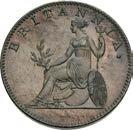
698. GREECE, United States of the Ionian Islands. British Protectorate. 1815-1864. CU 2 Lepta (21mm, 4.69 g, 6h). Dated 1820. London mint. Lion of St. Mark standing left, head facing, holding gospel and bundle of arrows / Britannia seated left on Union shield, holding trident. Pridmore 21; KM 31. Brown surfaces. In NGC encapsulation 8388454-001, graded MS 64 BN. Top Pop ($500)
From the Alexander Christopher Collection.



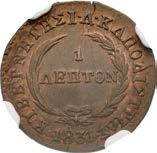
699. GREECE, First Hellenic Republic. Ioannis Antonios Kapodistrias. Governor, 1828-1831. CU Lepton (16.5mm, 11h). Aegina mint. Dated 1831. Phoenix rising from flames, head upturned to left, with wings spread; rays to upper left, long cross above / Denomination within wreath. Chase 355-L.g; Divo 8; Karamitsos 6; KM 9. In NGC encapsulation 6282880-012, graded MS 63 BN. ($600)
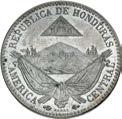

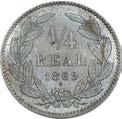
700. HONDURAS, Republic. 1840-pres. Proof Pattern CU-NI ¼ Real (19mm, 3.15 g, 6h). Paris mint; différents: two anchors. Dies by Barré. Dated 1869 E. REPUBLICA DE HONDURAS AMERICA CENTRAL, view of city and mountains flanked by two ships; triangular device above; all over crossed flags / ¼/ REAL/ 1869 within wreath; E below date. Cf. Stickney C276 (for regular issue); KM Pn7. In NGC encapsulation 8372254-005, graded PF 66. ($1000)
From the Alexander Christopher Collection.

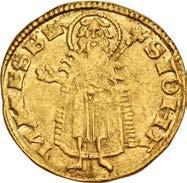

701. HUNGARY, Kingdom of Hungary. Lajos I. 1342-1382. AV Aranyforint (21mm, 3.53 g, 2h). Körmöcbánya (Kremnica) mint. Struck 1342-1353. Ornate lily of Florence / St. John the Baptist standing facing, holding long cross. Lengyel 3; Huszár 512; Friedberg 3. VF. ($750)
Ex Classical Numismatic Group Electronic Auction 196 (1 October 2008), lot 448.

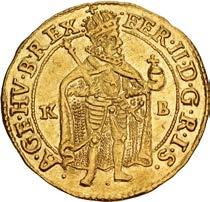
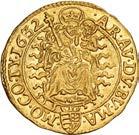
702. HUNGARY, Holy Roman Empire. Ferdinánd II. 1619-1637. AV Dukat (23mm, 3.47 g, 9h). Körmöcbánya (Kremnica) mint. Dated 1632 KB. Ferdinánd standing right, holding globus cruciger and scepter / Madonna seated facing, holding scepter and infant Christ; all within glory of rays. Huszár 1166; KM 78; Friedberg 98. In NGC encapsulation 8403848001, graded MS 62. ($2500)

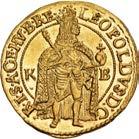


703. HUNGARY, Holy Roman Empire. Lipót I. 1657-1705. AV Dukat (23mm, 3.47 g, 6h). Körmöcbánya (Kremnica) mint. Dated 1660 KB. Lipót standing right, holding globus cruciger and scepter / Madonna seated facing, holding scepter and infant Christ; all within glory of rays. Huszár 1320; KM 151; Friedberg 128. In NGC encapsulation 8403848-007, graded MS 64+. Top Pop ($4000)
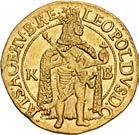
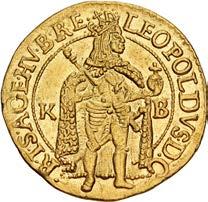

704. HUNGARY, Holy Roman Empire. Lipót I. 1657-1705. AV Dukat (23mm, 3.55 g, 5h). Körmöcbánya (Kremnica) mint. Dated 1662 KB. Lipót standing right, holding globus cruciger and scepter / Madonna seated facing, holding scepter and infant Christ; all within glory of rays. Huszár 1320; KM 151; Friedberg 128. In NGC encapsulation 8403848-003, graded MS 62. ($2500)
Pop

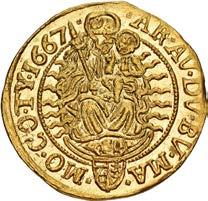

705. HUNGARY, Holy Roman Empire. Lipót I. 1657-1705. AV Dukat (23mm, 3.49 g, 5h). Körmöcbánya (Kremnica) mint. Dated 1667 KB. Lipót standing right, holding globus cruciger and scepter / Madonna seated facing, holding scepter and infant Christ; all within glory of rays. Huszár 1320; KM 151; Friedberg 128. In NGC encapsulation 8403848-004, graded MS 63. Top Pop. ($3000)

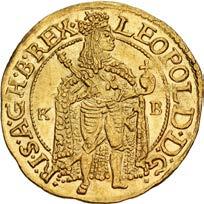

706. HUNGARY, Holy Roman Empire. Lipót I. 1657-1705. AV Dukat (22mm, 3.46 g, 10h). Körmöcbánya (Kremnica) mint. Dated 1668 KB. Lipót standing right, holding globus cruciger and scepter / Madonna seated facing, holding scepter and infant Christ; all within glory of rays. Huszár 1320; KM 151; Friedberg 128. In NGC encapsulation 8403848-002, graded MS 63. ($3000)



707. HUNGARY, Austro-Hungarian Empire. Ferenc József. 1867-1916. AR 5 Korona (36mm, 12h). Körmöcbánya (Kremnica) mint. Dated 1909 KB. Laureate head right / Angels supporting and flanking large crown held above denomination and date; wreath below. Huszár 2201; KM 488. Toned. In PCGS encapsulation 44994197, graded MS 65. Top Pop ($2000)



708. INDIA, Medieval (Southern Deccan). Kadambas of Goa. Jayakesin I and Jayakesin II. AD 1050-1080 and 1104-1147/8. AV Gadyana (19mm, 9h). Dated cyclical year šrīmukha?. Lion to left, floral symbol below; cyclical year in Devanagari to left / śri saprata ko/tisa labdhavara/vira jayakesi/deva malava/ramari in Devanagari in five lines. Cf. Mitchiner, South I 237; cf. Chattopadhyaya 142; Zeno –. In ANACS encapsulation 7453667, graded MS 62. ($750)

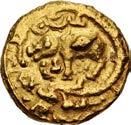

709. INDIA, Medieval (Southern Deccan). Chalukyas of Kalyana. Uncertain ruler. Circa 973-1068 or later. AV Pagoda (15mm, 3.98 g, 7h). Boar/Temple type. Caparisoned boar standing left within ornate frame / Elaborately decorated temple entrance. Cf. Mitchiner, South I, 267 (Jayashima II; for type, but uninscribed); Adams –; Album 32, lot 1757. Lightly toned, hint of deposits, struck with rusty dies, hint of clipping. VF. Extremely rare type with the boar left. ($1000)

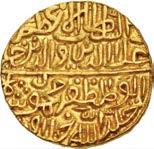
710. INDIA, Islamic Sultanates. Malwa. ‘Ala al-din Mahmud I. AH 839-873 / AD 1436-1469. AV Tanka (26mm, 11h). Hadrat Shadiabad mint. Dated AH 841 (AD 1438/9). al-sultan al-‘zam legend / sikandar al-thani legend. CIS M21; Rajgor Type 3064. In NGC encapsulation 6922485-015, graded MS 62. ($1500)


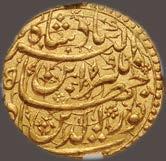

711. INDIA, Mughal Empire. Nur al-Din Muhammad Jahangir. AH 1014-1037 / AD 1605-1627. AV Mohur (27mm, 13.62 g, 5h). Sawai type. Agra mint. Dually dated AH 1018 and RY 5 (15/24 October AD 1609 - 25 March AD 1610). sikka zad dar shahr e agra khusru e giti panah; AH date to lower left / shah nur ud din jahangir ibn akbar badshah; RY date to left. Liddle type G-45: BM 296; IMC –; cf. Hull 1373 KM 185.1. In NGC encapsulation 6972502-001, graded MS 63. A brilliant testament to the numismatic artistry of India. ($25,000)
In spite of a small group of these exceedingly rare Sawai mohurs appearing in the market in early 2023, this type remains one of the great rarities of Mughal coinage and is highly sought after.
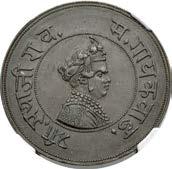
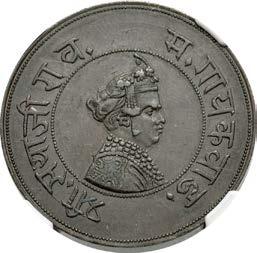
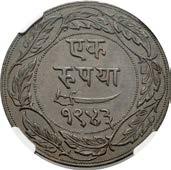
712. INDIA, Princely States. Baroda. Sayaji Rao III. VS 1932-1995 / AD 1875-1938. CU Piedfort Rupee Pattern (28.5mm, 12h). Dated VS 1943 (AD 1886). Bust right, wearing jeweled turban / Value, scimitar right, and date in four lines in Nagari; all within wreath. KM-PnA4. In NGC encapsulation 8219681-001, graded AU 55 BN. ($1000)




713. INDIA, Colonial. French India La Compagnie française des Indes orientales (French East India Company). AR Nazarana Rupee (32mm, 11.46 g, 12h). Struck in the name of Shah Alam II. Arcot mint. Dually dated AH 1198; RY 32 (sic) (AD 1783/4). Lecompte 152; KM 16. In NGC encapsulation 8375962-014, graded AU 58. Very rare. Top Pop. ($1000)
From the Alexander Christopher Collection.
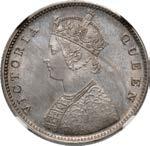
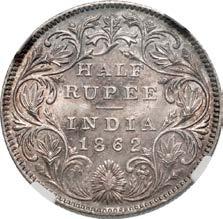
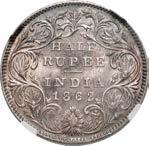
714. INDIA, Colonial. British India. Victoria. Queen of the United Kingdom and Ireland, 1837-1901. AR Half Rupee. Bombay or Madras mint. Dated 1862. VICTORIA QUEEN, crowned younger bust left; no V at truncation of bust / HALF/ RUPEE/ –/ INDIA/ 1862 in five lines; all within ornate floral border. UIC 4.125; Pridmore 259; KM 472. In NGC encapsulation 6636266-003, graded MS 65. Top Pop ($500)
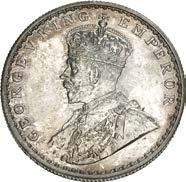

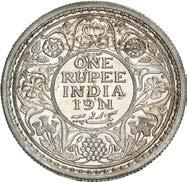
715. INDIA, Colonial. British India. George V. King of the United Kingdom and Emperor of India, 1910-1936. Restrike Proof AR Rupee (31mm, 11.67 g, 12h). Calcutta mint. Dated 1911. Crowned bust left / ONE/ RUPEE/ INDIA/1911 in five lines; all within ornate floral border; no pellet below lotus. UIC 8.13; Pridmore –; KM 523 var. (straight proof). In NGC encapsulation 8375962-013, graded PF 65. ($1000)
From the Alexander Christopher Collection.


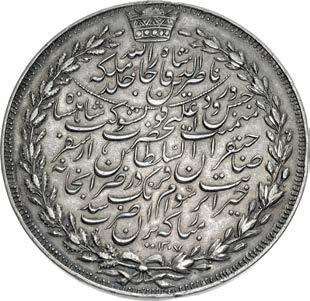
716. IRAN, Qajars. Nasir al-Din Shah. AH 1264-1313 / AD 1848-1896. AR Medal (51mm, 46.08 g, 12h). Dated AH 1307 (AD 1889/90). Bust facing slightly left within double linear circular border; all within laurel wreath; outer border consisting of dentils / be meymanat-e Jashne voroud-e A’la hazrat-e ghavi shoukat, Shah’nshah Sahebqaran Al-Soltan “Nasereddin Shah-e Qajar” Khalad’llah Melka az safar-e khayyerat-e sewwom-e farang dar zarrabkhaneyeh mobarakey-e Iran (in Persian) (this coin at the mint in blessed Iran struck to commemorate the great occasion of the arrival from his third important journey to Europe the Lord of the auspicious conjunction, the great Sultan, Shahanshah, Nasir al-Din Shah Qajar, may Allah perpetuate his kingdom 1307; all within oak and laurel wreath; Kiani Crown above; name Nasir al-Din Shah and invocation above beaded chain. Cf. Adams III (Triton XIX), lot 2492 (for issue in gold); Rabino di Borgomale pl. 44, 60; Album –; KM X# M9. In NGC encapsulation 8383387-001, graded AU 53. Very rare. ($2000)
From the Alexander Christopher Collection.



717. IRELAND, Irish Free State. 1922-1937. AR Florin (23mm, 11.31 g, 12h). London mint. Dated 1937. Harp / Salmon right. SCBC 6626; KM 7. Toned. In NGC encapsulation 8375962-015, graded MS 63. Key date. ($500)
From the Alexander Christopher Collection.


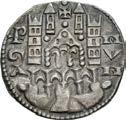
718. ITALY, Bergamo (Commune). 1236-early 14th century. AR Grosso da sei denarii (20.5mm, 2.13 g, 6h). nomine Holy Roman Emperor Frederick II (1220-1250). Struck 1236-circa 1250. Laureate and draped bust right / Domed building, with two towers flanking; all above crenellated archway set on rocks. MIR 16a; MEC 12, 396; Biaggi 351. Attractive deep toning. Good VF. ($1000)


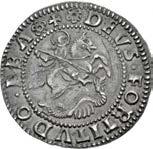

719. ITALY, Ferrara (Marquisate). Ercole I d’Este. 1471-1505. AR Grossone (26.5mm, 3.77 g, 10h). Second emission. Armored bust left, wearing ruff / St. George on horseback right, spearing dragon to lower right. Bellesia, Ferrara 7/b; MIR 257; Biaggi 770. Old cabinet toning, minor porosity. Good VF. ($500)
Ex Classical Numismatic Group 117 (19 May 2021), lot 874.
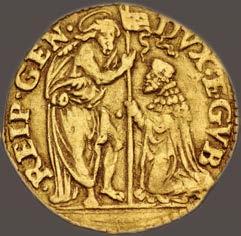
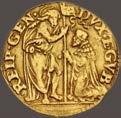


720. ITALY, Genova. The Biennial Doges. 1528-1797. AV Zecchino (20.5mm, 3.39 g, 7h). Copying the types of Venice. Genova mint. Struck circa 1554. DVX · (ET) · GVB REIP · GEN ·, St. John standing right, presenting banner to doge kneeling left / · DEO · OPT[ · · ]MAX · GLO ·, Christ standing facing within mandorla containing twelve stars. Scarfea, Imitazioni 350; MIR 210; Friedberg 435. Toned, deposits in devices, slightly clipped. Good VF. Very rare. ($10,000)
In the 16th century, the Venetian zecchino was the de facto trade coinage of the Mediterranean world. The Genovese began striking their own Venetian-style coins, including both the gold zecchino and various silver denominations, in 1554. The coins are today extremely rare. They were most likely withdrawn shortly after the initial issue, possibly due to protests from the Venetians. Other areas, particularly in India, continued to copy the zecchino with abandon, striking increasingly stylized imitations as late as the 20th century.


721. ITALY, Napoli (Kingdom). Carlo II di Spagna. 1665-1700. AR 100 Grana – Ducato (39.5mm, 21.89 g, 6h). Napoli mint. Dated 1693 AG A. Crowned, draped, and armored bust right / Badge of the Golden Fleece suspended from arabesque frame. MIR 294; Pannuti-Riccio 3; KM 121. Traces of die rust and adjustment marks, lustrous. AU. ($500)
From the Dr. William Conte Collection.


722. ITALY, Napoli (Kingdom). Carlo IV (VII) di Borbone. 1734-1759. AR 120 Grana – Piastra (42mm, 25.06 g, 6h). Napoli mint. Dated 1750 (MV) - (MM)/R. Bareheaded, draped, and armored bust right / Crowned coat-of-arms; shield in ornate frame. MIR 337/1; Pannuti-Riccio 29a; KM 162. Iridescent toning, slight roughnesss. EF. Rare variant with De G below bust, as on later coins, rather than on the truncation of the arm. ($500)
From the Dr. William Conte Collection. Ex Giuseppe De Falco Collection (Cambi & Crippa 881, 8 November 2023), lot 775 (hammer €4,500).
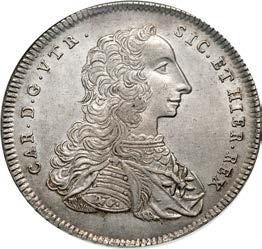

723. ITALY, Napoli (Kingdom). Carlo IV (VII) di Borbone. 1734-1759. AR 120 Grana – Piastra (42mm, 25.24 g, 6h). Napoli mint. Dated 1750 (MV) - (MM)/R. Bareheaded, draped, and armored bust right / Crowned coat-of-arms; shield in ornate frame. MIR 337 var. (obv. legend); Pannuti-Riccio 29 var. (same); KM 162. Toned. In NGC encapsulation 2932467002, graded AU 58. Rare variant with V in obverse legend rather than the typical U. ($1500)
From the Dr. William Conte Collection, purchased from Artemide, 17 July 2024, for €3,300. Ex Strada Collection (Nomisma 6, 4 May 2024), lot 1265.
Reported by Cagiati in his supplement. Additionally, the coin is from a broad die and is of greater diameter than usual with a slightly larger portrait and with particularly full hair over the shoulder. Perhaps this is a very early die for the type.

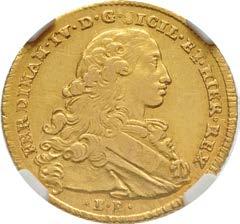
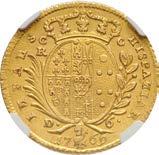
724. ITALY, Napoli (Kingdom). Ferdinando IV di Borbone. First reign, 1759-1799. AV Six Ducati (26mm, 8.81 g, 6h). Napoli mint. Dated 1769 C/R - C. Draped and armored bust right / Crowned coat-of-arms within palm and laurel wreath with Badge of the Order of the Golden Fleece below. MIR 356/2; Pannuti-Riccio 16; Friedberg 849; KM (C) 76. In NGC encapsulation 2933639-002, graded AU 58+. ($1000)
From the Dr. William Conte Collection.
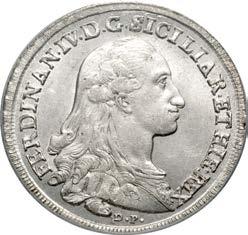

725. ITALY, Napoli (Kingdom). Ferdinando IV di Borbone. First reign, 1759-1799. AR 120 Grana – Piastra (41mm, 6h). Napoli mint. Dated 1787 C/C - C. Armored bust right / Crowned coat-of-arms within ornate frame; shield framed by laurel; palm and laurel branches at base. MIR 370/3; Pannuti-Riccio 51; KM –. In PCGS encapsulation 42177282, graded MS 62. ($500)
From the Dr. William Conte Collection. Ex Numismatica Ars Classica 12 (1 May 1998), lot 2700.
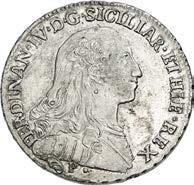

726. ITALY, Napoli (Kingdom). Ferdinando IV di Borbone. First reign, 1759-1799. AR 60 Grana – Half Piastra (32mm, 13.64 g, 6h). Napoli mint. Dated 1792 M/A - P. Armored bust right / Crowned coat-of-arms within ornate frame; shield framed by laurel; palm and laurel branches at base. MIR 379; Pannuti-Riccio 72; KM 214. Iridescent toning, deposits, slight roughness, traces of underlying luster, hairlines. EF. ($500)
From the Dr. William Conte Collection.
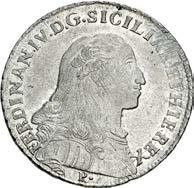

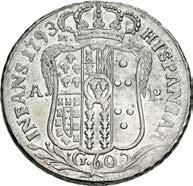
727. ITALY, Napoli (Kingdom). Ferdinando IV di Borbone. First reign, 1759-1799. AR 60 Grana – Half Piastra (32mm, 13.60 g, 6h). Napoli mint. Dated 1793 M/AP. Armored bust right / Crowned coat-of-arms within ornate frame; shield framed by laurel; palm and laurel branches at base. MIR 379/1; Pannuti-Riccio 73; KM 214. Iridescent toning, adjustment marks, underlying luster. AU. ($750)
From the Dr. William Conte Collection.

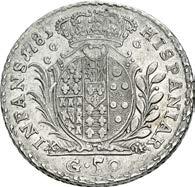
728. ITALY, Napoli (Kingdom). Ferdinando IV di Borbone. First reign, 1759-1799. AR 50 Grana – Half Ducato (32mm, 11.27 g, 6h). Napoli mint. Dated 1785 C/C - C. Armored bust right / Crowned coat-of-arms within ornate frame set on ground line; shield framed by palm and laurel branches; cornucopias at base. MIR 382; Pannuti-Riccio 78; KM 192. Iridescent toning, slight marks, traces of underlying luster. AU. Exceptional condition for this rare denomination. ($1000)
From the Dr. William Conte Collection. Ex Nomisma 69 (23 March 2024), lot 1303 (hammer €4450); Numismatica Ars Classica 12 (1 May 1998), lot 2726.
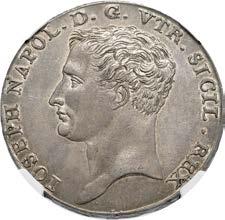


729. ITALY, Napoli (Kingdom). Guiseppe Napoleone. 1806-1808. AR 120 Grana – Piastra (37mm, 6h). Napoli mint. Dated 1808. Bare head left / Crowned coat-of-arms with triton and tritoness supporters. MIR 433/3; Pannuti-Riccio 3; Pagani 43; KM (C) 100. In NGC encapsulation 2936607-001, graded MS 62. ($1500)
From the Dr. William Conte Collection. Ex Numismatica Ars Classica 139 (27 June 2023), lot 785, purchased from A. de Falco, 1996.


730. ITALY, Sicilia (Kingdom). Carlo di Borbone. 1734/5-1759. AR Scudo – 12 Tarì (39.5mm, 6h). Palermo mint. Dated 1735 FN. Laureate, draped, and cuirassed bust right / Crowned eagle facing with wings spread, head left. Edge: laureate. MIR 553; Spahr 14; KM 151. In NGC encapsulation 2933639-005, graded AU 58. ($750)
From the Dr. William Conte Collection.


731. ITALY, Sicilia (Kingdom). Ferdinando III di Borbone. 1759-1816. AR 12 Tarì (39mm, 27.33 g, 6h). Palermo mint. Dated 1799 JU I. Armored bust right / Crowned eagle facing with wings spread, head left, coat-of-arms on breast. Edge: laureate. MIR 639/1; Spahr 126; Pagani 2a; KM (C) 49a. Richly toned, slight adjustment marks. AU. ($500)
From the Dr. William Conte Collection.


732. ITALY, Venezia (Venice). Francesco Molino. 1646-1655. AV 10 Zecchini (45mm, 32.97 g, 11h). St. Mark standing right, presenting banner to Doge kneeling left; ★ ᚩ ★ in exergue / Christ standing facing within mandorla containing twenty stars. Paolucci 4; KM 214; Friedberg 1316. Toned, polished surface, marks, slightly wavy flan, edge marks from once having been in bezel, mount removed, holed and plugged. Near VF. Very rare. ($2000)

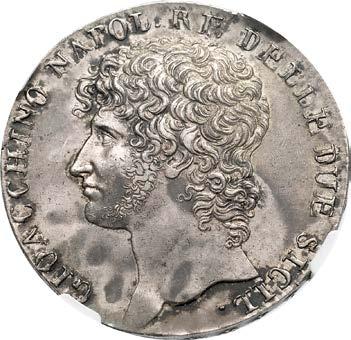

733. ITALY, Kingdom of the Two Sicilies. Gioacchino Murat. 1808-1815. AR 12 Carlini – Piastra (38mm, 6h). Napoli mint. Dated 1810. Bare head left / DODICI/ CARLINI/ 1810 in three lines within laurel and grain ear wreath. MIR 434/1; Pannuti-Riccio 2; Pagani 46h; KM (C) 103. In NGC encapsulation 2933639-006, graded AU 58. ($1000)
From the Dr. William Conte Collection, purchased from Heritage, 6 July 2023.

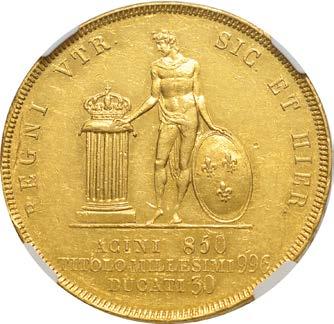
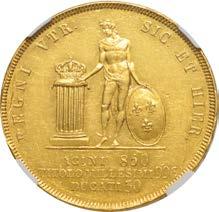
734. ITALY, Kingdom of the Two Sicilies. Ferdinando II. 1830-1859. AV 30 Ducati (36mm, 37.82 g, 6h). Napoli mint. Dated 1840. Bare head right, wearing short beard / Bourbon Genius, holding shield decorated with three lis and set on ground, standing facing, head left, touching cushion set on column and surmounted by crown. MIR 485/1; Pannuti-Riccio 5; Pagani 134; Friedberg 866; KM (C) 157b. In NGC encapsulation 2933639-001, graded AU 55. ($5000)
From the Dr. William Conte Collection, purchased from Alex Numismatica e Filatelia.


735. JAMAICA, Colony. George II. 1727-1760. AR 6 Shillings 8 Pence (39mm). Struck 1758. Floreated GR in circular countermark on a Mexican 1757 Mo MM 8 Reales. Pridmore 4; KM 8.4. Toned. In PCGS encapsulation 81855670, graded XF 40, c/m XF Details. ($1000)
In 1758, the Jamaica Assembly passed an act which provided that some of the new Spanish milled money should be made legal tender and have a fixed value. £100,000 was proposed, and in order to distinguish the re-valued coins, they were countermarked with the initials GR representing the reigning monarch, George II.
The act succeeded in raising the value of the dollar to 6s 8d, and by common consent all coins of this new money, stamped or not, also passed at the 6s 8d per dollar rate. When the home authorities received copies of the local act it was repealed and the Governor of Jamaica censured for exceeding his powers, only £12,000 was countermarked before the project was abandoned in 1759.
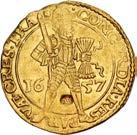
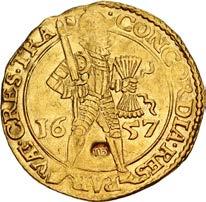
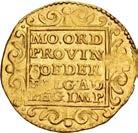
736. LOW COUNTRIES, Republic of the Seven Netherlands (Dutch Republic). Utrecht. 1581-1795. AV Dukat (23mm, 3.50 g, 10h). Utrecht mint. Dated 1657. Knight standing facing, holding sword and bundle of arrows; between legs, merchant’s c/m: IB in oval / Legend in five lines within ornate tablet. P&W Ut24; CNM 2.43.44; Delmonte, Or 963; KM 7.4; Friedberg 284. In NGC encapsulation 8403848-005, graded UNC Details, Private Countermark. ($1000)

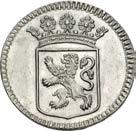
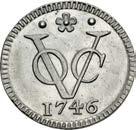

737. MALAY ARCHIPELAGO, Colonial. Netherlands East Indies. Dutch East India Company. 1602-1799. AR Doit (22mm, 3.29 g, 12h). Dordrecht in Holland mint. Dated 1746. Crowned coat-of-arms / VOC monogram; rosette above. Scholten 125; KM 70a. Lustrous, hairlines. UNC. Specially made off-metal strike in silver. ($500)
From the Drewry Family Collection. Ex Ponterio 26 (14 December 1986), lot 955.
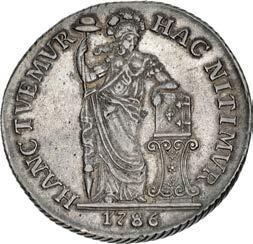

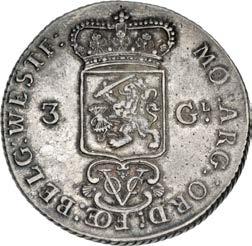
738. MALAY ARCHIPELAGO, Colonial. Netherlands East Indies. Dutch East India Company. 1602-1799. AR 3 Gulden (41mm, 31.61 g, 12h). West Friesland mint. Dated 1786. Minerva standing facing, head right, holding cap on long pole and resting arm on book set on plinth / Crowned coat-of-arms; VOC monogram below. Scholten 63b; KM 140. Old cabinet toning. In NGC encapsulation 8372854-002, graded AU 55. ($1000)
From the Drewry Family Collection. Ex NASCA 58 (10 December 1985), lot 620.



739. MAURITIUS, Colonial. Victoria. 1837-1901. Proof CU 5 Cents (27.5mm, 9.62 g, 12h). London mint. Dated 1878. Crowned bust left / Denomination. KM 9. Some iridescent luster. In NGC encapsulation 8372738-009, graded PF 64+ BN. ($750)
From the Alexander Christopher Collection.

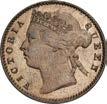


740. MAURITIUS, Colonial. Victoria. 1837-1901. Proof CU Cent (17mm, 1.98 g, 6h). London mint. Dated 1884 Crowned bust left / Denomination. KM 7. In NGC encapsulation 8372738-010, graded PF 65 RB. Top Pop. The sole graded example. ($500)
From the Alexander Christopher Collection.
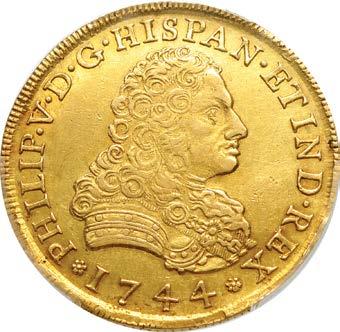
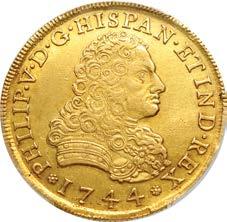
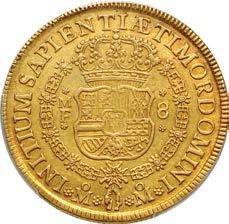

741. MEXICO, Colonial. Felipe V. King of Spain, second reign, 1724-1746. AV 8 Escudos (37mm, 11h). Mexico City mint. Dated 1744 Mo MF. Armored bust right / Crowned and collared coat-of-arms. Calicó, Onza 573; BW 33.1; KM 148; Friedberg 8. In PCGS encapsulation 52718196, graded AU 55. A wonderful example of the type. ($7500)
The earliest reference to the eight escudo coin is from 14 June 1587, when Spanish king Philip II visited the new Segovia mint, and the piece certainly saw major production by 1611. This should not be surprising – with the vast amounts of precious metals pouring out of the Spanish colonies in the New World, larger denominations were then in vogue, leading to the creation of not only a vast, crown-sized coinage in silver (eight reales), but in gold as well. In fact, though it was first created in Spain, the eight escudos was actually struck in much greater numbers in the Americas.
Though formally termed an eight escudo piece, the colloquial names of this coin developed in a confusing manner. As the weight of the piece was set at 27.069 grams, just a few tenths of a gram shy of an eighth of the Castilian mark, the coin became known as an onza in Europe. Sharing the name with both the coin and the weight led to some misunderstandings in the official records.
A second colloquial name, more popular in the Americas, took an even more convoluted route. When the first excelente, a coin bearing the confronted portraits of the two monarchs, was produced under Ferdinand and Isabella, any Spanish gold coin could be broadly referred to as a dobla, from the old Arabic double dinar. As the new excelente weighed twice that, it was termed a doblón, or double dobla. This coin was equivalent to a two-escudo piece, and when the four escudo was struck, it took the name doblón de a cuatro. The eight escudo thus became the doblón de a ocho – “double double of eight.” In English-speaking America, this was abbreviated to simply “doubloon.”


742. MEXICO, Colonial. Carlos III. King of Spain, 1759-1788. AR 8 Reales (38.5mm, 12h). Ciudad de México (Mexico City) mint. Dated 1777 Mo FM. Laureate, draped, and cuirassed bust right / Crowned coat-of-arms between garlanded Pillars of Hercules. BW 28.6; KM 106.2. Toned. In NGC encapsulation 3888236-006, graded AU 58. ($750)
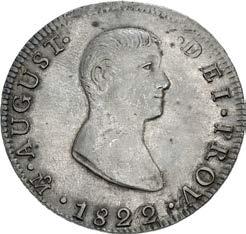

743. MEXICO, First Mexican Empire. Agustín de Iturbide. 1822-1823. AR 8 Reales (39.5mm, 27.02 g, 12h). Ciudad de México (Mexico City) mint. Dated 1822 Mo JM. Bareheaded bust right / Crowned eagle standing facing on cactus, head left, wings spread. BW 166.1; KM 304. Toned, area of die clash on reverse, minor deposits. VF. ($500)
Off Center Mexican Peso
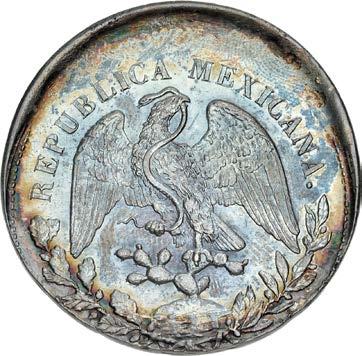



744. MEXICO, Second Republic. 1867-1905. AR Peso (39mm, 27.00 g, 6h). Mexico City mint. Dated 1904 Mo AM Eagle standing facing on cactus, head right, wings spread, grasping snake in beak and right talon; all atop laurel and oak wreath / Liberty cap; glory of rays in background. BW 258.12; KM 409.2. Iridescent toning. In NGC encapsulation 8375962-001, graded Mint Error MS 62. Struck 15% off center. ($500) From the Alexander Christopher Collection.



745. MEXICO, Mexican Revolution. Free and Sovereign State of Oaxaca. AV Plated 10 Pesos (22mm, 7h). Issued under Governador José Inés Dávila. Oaxaca mint. Dated 1915. Bust of Benito Juárez left within wreath / Denomination over wreath. Ventana 124; G&B 374; BW 353; KM A752; Friedberg 176. In PCGS encapsulation 52718199, graded MS 61. This obverse die was also used to strike CU 5 Centavos. ($1000)

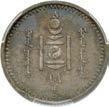
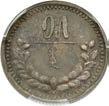
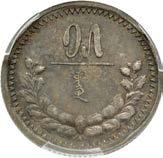
746. MONGOLIA, People’s Republic. 1924-1992. AR 15 Mongo (18mm, 12h). Leningrad mint. Dated year 15 (AD 1925). Soyombo symbol / Legend over wreath. L&M 622; KM 5. Iridescent toning. In PCGS encapsulation 50671178, graded AU 58. ($600)


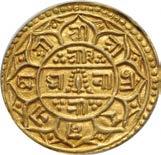
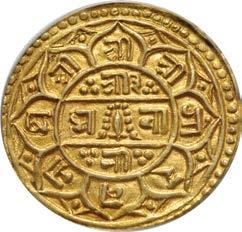
747. NEPAL, Shah dynasty. Girvan Yuddha Vikrama. SE 1720-1738 / AD 1799-1816. AV 1½ Mohar (25mm, 12h). Dated SE 1726 (AD 1804). Legend within quadrate around central ornate design; additional designs around; SE date in exergue / Legend and design in three lines within center of floral design; additional legend in petals. KM 547; Friedberg 6. In PCGS encapsulation 11727391, graded AU 58. ($1000)

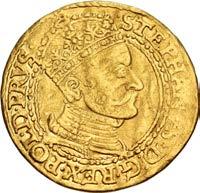

748. POLAND, Monarchy. Stefan Batory. 1576-1586. AV Dukat (22mm, 3.46 g, 6h). Danzig (Gdańsk) mint. Dated 1583 Crowned and armored bust right / Coat-of-arms with leonine supporters. Dutkowski & Suchanek 136 IV; Kopicki 7438; Friedberg 3. Toned. VF. ($3000)

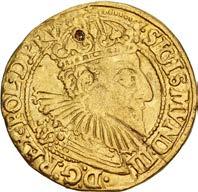
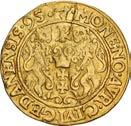
749. POLAND, Monarchy. Zygmunt III Wasa. 1587-1632. AV Dukat (21.5mm, 3.42 g, 8h). Danzig (Gdańsk) mint. Dated 1595. Crowned and armored bust right wearing ruff / Coat-of-arms with leonine supporters; (PK) monogram above. Dutkowski & Suchanek 176; Kopicki 7517; Friedberg 10. Toned, small attempted piercing. Near VF. ($1500)

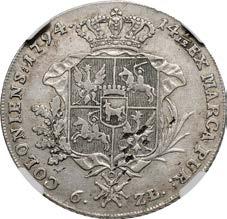
750. POLAND, Monarchy. Stanislaw August Poniatowski. 1764-1795. AR 6 Zlotych (37mm, 12h). Warszawa (Warsaw) mint. Dated 1794. Bare head right / Crowned coat-of-arms decorated with ribbon and sprigs and with the Order of the White Eagle suspended beneath. Parchimowicz 1233a; Kopicki 2487; KM 216. Toned. In NGC encapsulation 6643633-001, graded XF 40. ($500)
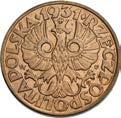
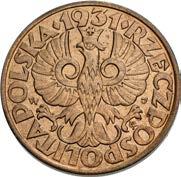

751. POLAND, Republic of Poland. 1919-1939. CU 5 Groszy (18mm, 12h). Warszawa (Warsaw) mint. Dated 1931 Crowned eagle facing with wings spread, head left / Denomination. Parchimowicz 103e; Kopicki 2826; KM (Y) 10a. In NGC encapsulation 8395632-007, graded MS 65 RD. Top Pop ($750)
From the Alexander Christopher Collection.


752. RUSSIA, Empire. Yelizaveta Petrovna (Elizabeth). 1741-1762. AR Rouble (40mm, 25.35 g, 12h). Moscow mint. Dated 1752 ММД Е. Crowned bust right / Crowned double-headed eagle facing, holding scepter and globus cruciger; collared coat-of-arms on breast. Diakov 257; Bitkin 125; KM (C) 19.2. Old cabinet toning. In NGC encapsulation 8372843-002, graded AU 50. ($600)
From the Drewry Family Collection. Ex Galerie des Monnaies of Geneva (25 June 1976), lot 408.
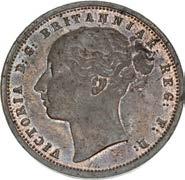
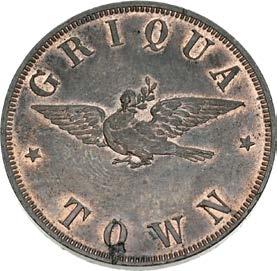
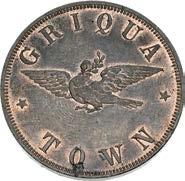
753. SOUTH AFRICA, Griquatown. Victoria. 1837-1901. Pattern Æ Penny (29mm, 10.59 g, 6h). Dies by L.C. Lauer, for Otto Nolte & Co. (Berlin). Struck circa 1890. VICTORIA D : G : BRITANNIAR : REG : F : D :, head left, with hair tied in bandeau / ✭ GRIQUA ✭ TOWN, dove flying left, head right, holding olive branch in beak. Hern GT21; KM (X) 9. In NGC encapsulation 8372254-008, graded MS 62 BN. ($500)
From the Alexander Christopher Collection.

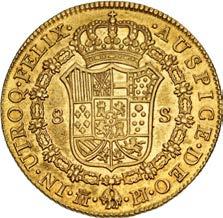
754. SPAIN, Kingdom. Carlos III. 1759-1788. AV 8 Escudo (36mm, 27.01 g, 12h). Madrid mint. Dated 1775 M PJ. Armored and draped bust right / Crowned and collared coat-of-arms. ME 12863; Calicó y Trigo 55; KM 409.1; Friedberg 282. Lustrous, a few hairlines. AU. ($1500)


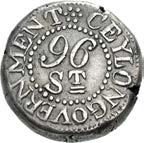
755. SRI LANKA (CEYLON), Colonial. British. George III. 1760-1820. AR 96 Stuivers (23mm, 17.62 g, 12h). Dated 1808. Elephant left / Denomination in two lines within dotted border. Pridmore 1; KM 79. Toned, slight porosity, trace deposits. Good VF. ($500)
Very Rare


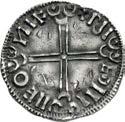
756. SWEDEN. temp. Olof Skötkonung (the Treasurer). 995–1022. AR Penny (20.5mm, 2.20 g, 5h). Imitating the Long Cross type of Æthelred II of England. Sigtuna mint. Draped bust left / Voided long cross with triple-crescent ends and pellet at center. Cf. SMH 148–55 (for obv. die); cf. Malmer chain 11, dies 4.274/–; cf. Delzanno 52-7 (for type). Toned with some iridescence, peck marks, light deposits. Good VF. Very rare. An evidentially unlisted reverse die in the aforementioned references. ($750)
Ex Karl Gustaf Collection (Spink 143, 25 May 2000), lot 8.

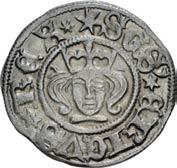

757. SWEDEN. Sten Sture den äldre (the Elder). Viceroy, 1470–1497 and 1501-1503. AR Örtug (19mm, 1.51 g, 2h). Stockholm mint. Crowned head facing / Coat-of-arms. Delzanno 378. Attractively toned. Good VF. ($500)
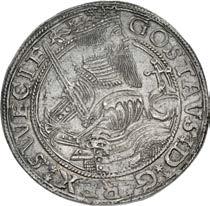
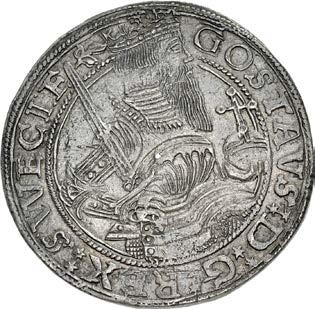
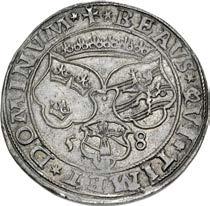
758. SWEDEN. Gustav I Vasa. 1523–1560. AR Mark (34.5mm, 11.56 g, 12h). Stockholm mint. Dated (15)58. Crowned and armored bust right, wearing ruff, holding sword over shoulder and globus cruciger / Crown over three coats-of-arms. Delzanno 63; Antell 355 var. (rev. legend). Attractive iridescent toning, minor marks. EF. Very rare variety with BEAVS rather than BEATVS. ($750)


759. SWEDEN. Erik XIV. 1560–1568. AR 2 Mark – 16 Öre (41mm, 23.89 g, 7h). Stockholm mint. Dated 1563 Crowned coat-of-arms / Legend in four lines within ornate frame with crowns on three sides. Delzanno 26; Antell 527. In NGC encapsulation 8372738-013, graded MS 63. ($1000)
From the Alexander Christopher Collection.
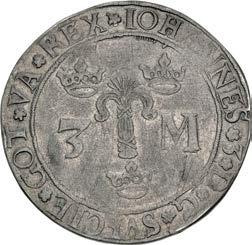

760. SWEDEN. Johan III. 1568–1592. AR 3 Mark (41mm, 18.02 g, 4h). Stockholm mint. Dated 1590. Sheaf with three crowns around; 3 M (mark of value) across field / Crowned lion rampant left; waves in background. Delzanno 39. Toned, scratches, edge marks. VF. Rare. ($1500)
From the Drewry Family Collection. Ex Charles Wyatt 14 (15 August 1986), lot 408.
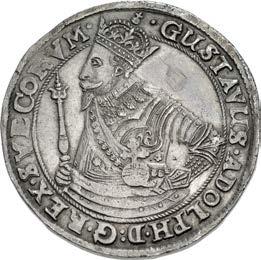


761. SWEDEN. Gustav II Adolf den store (the Great). 1611–1632. AR Riksdaler (42.5mm, 29.36 g, 12h). Stockholm mint. Dated 1632 (in Roman numerals). Crowned and armored bust left, wearing ruff, holding scepter and globus cruciger / Christ, draped but with bare chest, standing facing, raising hand in benediction and holding globus cruciger; crowned coat-ofarms to left. Delzanno 28; KM 147; Davenport 4521. Toned, divot with scratches. Near EF. ($1500)



SWEDEN. Kristina. 1632–1654. AR 1/2 Riksdaler (37mm, 13.82 g, 8h). Stockholm mint. Dated 1642 (in Roman numerals). Crowned bust facing slightly left / Christ, draped but with bare chest, standing facing, raising hand in benediction and holding globus cruciger; crowned coat-of-arms to left. Delzanno 48; KM 186. Toned, ex-mount, hairlines. Good VF. ($750)



763. SWEDEN. Kristina. 1632–1654. AR 4 Mark (39mm, 21.83 g, 8h). Stockholm mint. Dated 1648 DK. Laureate and cuirassed bust right / Crowned coat-of-arms; 4 M (mark of value) flanking. Delzanno 89b; KM 192. Toned, scratches. VF. ($750)
Ex Karl Gustaf Collection (Spink 143, 25 May 2000), lot 738.
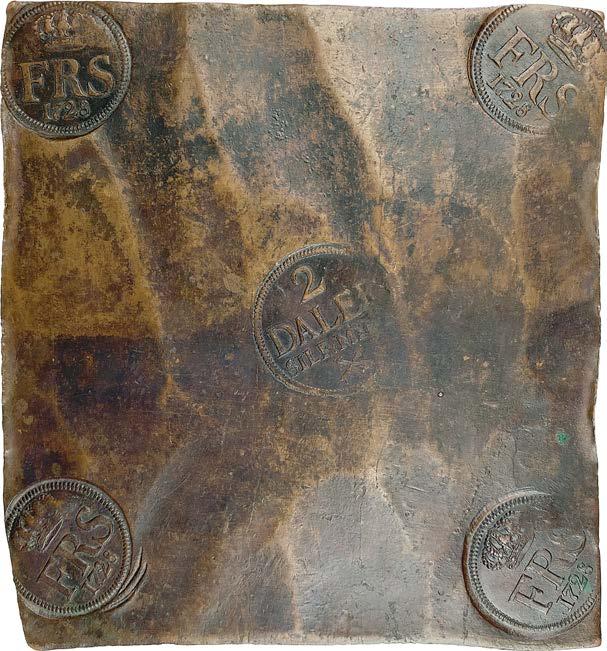
764. SWEDEN. Fredrik I. 1720–1751. CU 2 Daler Plate (164x172mm, 1.5 kg). Avesta mint. Dated 1728. Center stamp: 2/ DALER/ SILF : MY[NT] over crossed arrows. Four stamps in corners: Crowned FRS over 1728. Delzanno 233; Tingström, Plate p. 299, stamps A/9; KM PM71. Natural glossy brown patina with spot small spot of red and a few small spots of green encrustation, delamination on reverse. Near VF. Not sea salvaged. Well struck. Additional shipping costs will apply ($1000)
Sweden, though home to extensive copper mines, some of which have been worked continually for over 900 years, does not have a readily available source of precious metal. By the early 17th century, Sweden’s precious metal reserves had been exhausted by a series of expensive foreign wars, and the government responded by striking copper coins of ever increasing size. In 1644 came the first issue of the famous plate coins, a huge 10 daler piece weighing over 44 pounds. This and the equally rare 8 daler piece were too awkward for use, but the principle proved economically sound and the idea was accepted by the people. From that point until the 1750’s plate coinage was produced in denominations ranging from 1/2 to 4 daler, and remained legal tender until 1777. Many pieces then fell to the melting pot, as their usefulness as metal outweighed their intrinsic value. The most famous source for these plates has been the “Nicobar” shipwreck hoard, an East Indiaman who sank in 1783 with eight tons of copper plates as cargo and ballast, intended for the eastern trade. Most of the Swedish plate money currently on the market come from this shipwreck, and show the effects of 200 years under water.


765. SWEDEN. Gustav IV Adolf. 1792–1809. AR Riksdaler (40mm, 12h). Stockholm mint. Dated 1796 OL. Bare head right / Crowned and collared coat-of-arms. Delzanno 23; Davenport 178; KM 544. Lustrous. In NGC encapsulation 8395632009, graded MS 64. ($750)
From the Alexander Christopher Collection.



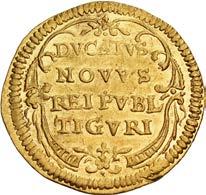
766. SWITZERLAND, Canton of Zürich. Zürich. AV Dukat (22mm, 3.47 g, 12h). Dated 1651. Coat-of-arms / Legend in four lines within cartouche. HMZ 2-1138l; KM 79; Friedberg 473. In NGC encapsulation 8383380-002, graded MS 61. Top Pop ($2000)


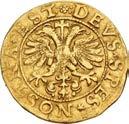
767. SWITZERLAND, Canton of Schaffhausen. Schaffhausen. AV Dukat (21mm, 3.41 g, 12h). Dated 1633. Coat-ofarms / Crowned double-headed eagle facing with wings spread; cross above. HMZ 2-760e; KM 46; Friedberg 370. In NGC encapsulation 8383380-007, graded AU Details, obverse test cut. ($1500)

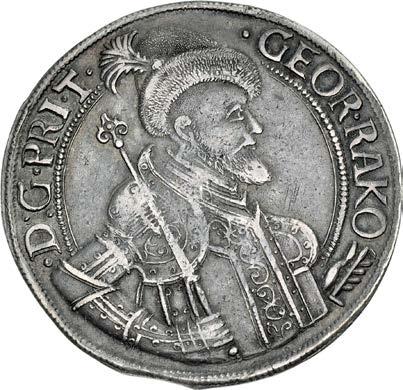
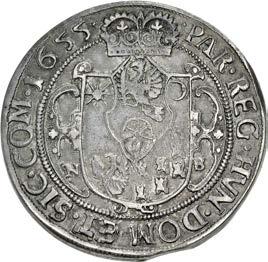
768. TRANSYLVANIA, Principality. György Rákóczi II. 1648-1660. AR Taler (44mm, 28.63 g, 12h). Nagybánya (Frauenbach / Baia Mare) mint. Dated 1655 NB. Half-length armored bust right, holding scepter over shoulder and resting hand on hilt of sword, wearing short brimmed fur cap with feather / Crowned coat-of-arms. Resch 93; MBR 2147; Davenport 4751; KM 286. Toned, minor marks. Good VF. ($2000)
Ex Alexander Christopher Collection.
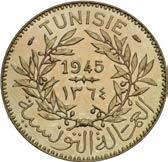

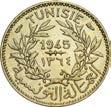


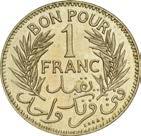
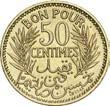
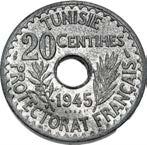
769. TUNISIA, Husaynid Beys. French Protectorate. Muhammad VIII al-Amin. AH 1362-1376 / AD 1943-1956. Set of four (4) Piedfort Essais. Paris mint; différents: cornucopia and wing. Dated 1945. Includes: AL-Æ Piedfort Essai de 2 Francs (27mm, 15.97 g, 12h). MCF 93; KM PE4. In NGC encapsulation 8375962-002, graded MS 65 // AL-Æ Piedfort Essai de Franc (23mm, 7.98 g, 12h). MCF 88; KM PE3. In NGC encapsulation 8375962-003, graded MS 66. Top Pop // AL-Æ Piedfort Essai de 50 Centimes (17mm, 3.83 g, 12h). MCF 83; KM PE2. In NGC encapsulation 8375962-004, graded MS 67. Top Pop // ZN Essai de 20 Centimes (23mm, 6.38 g, 12h). MCF 76; KM PE1. In NGC encapsulation 8375962-005, graded MS 63. All in NGC encapsulation. Each with a mintage of 104. ($500)
From the Alexander Christopher Collection.

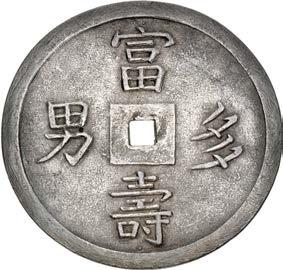
770. VIETNAM (ANNAM), Nguyễn dynasty. Hiến Tổ (Thiệu Trị). 1841-1847. AR 5 Tìên (47mm, 16.99 g, 12h). Thieu Tri Thong Bao in Han-nom characters / Phu tho da nam in Han-nom characters. Schroeder 253; BN, Vietnamiennes Supp. 446; KM 284 corr. (incorrect photo). Toned. In NGC encapsulation 2168553-001, graded AU Details, tooled. ($750)
From the Drewry Family Collection. Ex Bowers & Merena (23 January 1986), lot 4867.
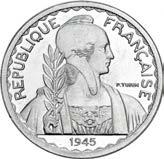
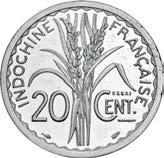
771. VIETNAM (ANNAM), Colonial. French Indochina. 1885-1949. Proof CU-NI Piedfort Essai de 20 Centimes (27mm, 4.41 g, 12h). Paris mint; différents: cornucopia and wing. Dies by Turin. Dated 1945. REPUBLIQUE FRANÇAISE, draped bust of Marianne facing, head right, wearing liberty cap and holding laurel branch; 1945 in exergue / INDOCHINE FRANÇAISE, rice plant; 20 CENT across field, ESSAI to right. Edge: plain. Lecompte 249; MCF 30; Daniel S60a2; KM PE5. In NGC encapsulation 8375924-003, graded PF 65. ($500)
From the Alexander Christopher Collection.



772. VIETNAM (ANNAM), Colonial. French Indochina. 1885-1949. CU-NI Piedfort Essai de 50 Centimes (28mm, 25.72 g, 12h). Paris mint; différents: cornucopia and wing. Dies by Barré and Turin. Dated 1946. REPUBLIQUE FRANÇAISE, Liberty seated left on throne, head facing, holding fasces; grain ears to left, anchor to right; 1946 in exergue, ESSAI to right / INDO-CHINE FRANÇAISE · BRONZE DE NICKEL ·, 50/ CENT. within wreath. Lecompte 263; MCF 33; cf. Daniel S7c1; KM PE7. In NGC encapsulation 8372843-009, graded SP 67. ($1500)
From the Alexander Christopher Collection.


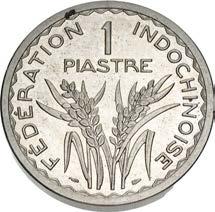
773. VIETNAM (ANNAM), Colonial. French Indochina. 1885-1949. CU-NI Piedfort Essai de 1 Piastre (35mm, 36.40 g, 12h). Paris mint; différents: cornucopia and wing. Dies by Turin. Dated 1947. REPUBLIQUE FRANÇAISE, draped bust of Marianne facing, head right, wearing liberty cap and holding laurel branch; 1947 in exergue, ESSAI to left / FÉDERATION INDOCHINOISE, rice plants; 1/ PIASTRA above. Edge: plain. Lecompte 318; MCF 38; Daniel S61a1 var. (date); KM PE8. In NGC encapsulation 8372843-010, graded SP 65. ($1000)
From the Alexander Christopher Collection.
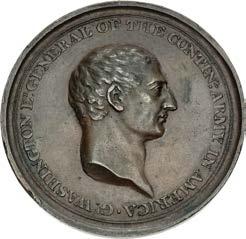
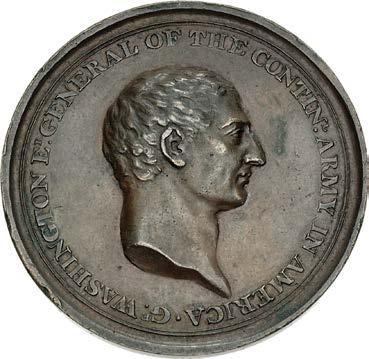
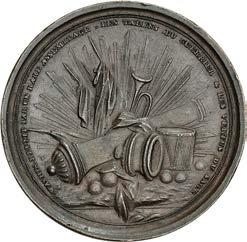
774. Washingtoniana, (Undated) The Warrior & Sage Medal. Musante GW-01; Baker 78; Betts 544. Good VF. (41mm, 20.11 g, 12h). Of uncertain English or Scottish manufacture. Struck circa 1777. · GẸ WASHINGTON EṚ GENERAL OF THE CONTINḶ ARMY IN AMERICA, bare head right / WASHIN . REUNIT PAR UN RARE ASSEMBLAGE . LES TALENS DU GUERRIER & LES VERTUS DU SAGE, assemblage of military implements set on ground; rays behind. Brown surfaces. Rare. ($500)
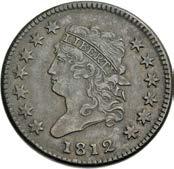


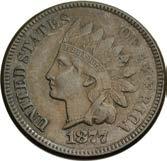




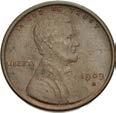
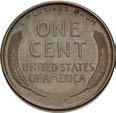


778. 1909-S V.D.B. Lincoln Cent. NGC MS 62 BN. 8388481-007. The key date in the series. Always in demand. ($1000)
From the Dr. John H. Brown Collection.
779. 1863 Liberty Seated Half Dime. Repunched Date. NGC MS 65. 8395623-004. Repunching visible on 18 in the date. This Civil War-era issue had a mintage of 18,000 circulation strikes. A very pretty example of the type. ($500)
From the Dr. John H. Brown Collection.


780. 1818 Capped Bust Quarter. B-9. High Rarity 5. NGC AU 55. 8399650-002. B-9 is the rarest of ten die marriages for the 1818 quarters. Arrowheads and denomination are boldly clashed on the upper obverse. Die mark from inner tip of star 2. On the reverse, a heavy, raised die crack from rim through N into the left wing. Dies clashed under right wing show Liberty’s cap. Diagnostics confirm this variety for the date. A Condition Census coin that would grace any advanced variety collection. Only one of this variety is graded higher by NGC. An NGC AU 58 CAC example sold in Heritage 1224 (20 September 2015), lot 3853 for $18,800. ($1000)
From the Dr. John H. Brown Collection.
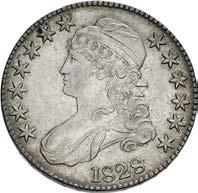


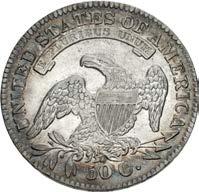
781. 1828 Capped Bust Half Dollar. Square Base 2, Small 8s, Large Letters. O-117. Rarity 1. NGC MS 62. 8388481003. Serif of C in 50 C is recut at top, confirming the Overton variety ($500)
From the Dr. John H. Brown Collection.
782. 1833 Capped Bust Half Dollar. O-108. Rarity 1. NGC MS 63. 8388481-005. Included among the diagnostics for this variety are: 50 C is very high, line 10 extends far into right wing. ($500)
From the Dr. John H. Brown Collection.


783. 1859-O Liberty Seated Dollar. OC-1. Rarity 1. PCGS MS62. 50411817. ($1000)
From the Samuel K. Clark Collection. 778
1861

Rarity

Diagnostics include: Light die lines extend from the denticles right of the date below the heel, die chip in the denticles above the O in OF. A faint die crack at the base of the date confirms Die State b. A very pretty coin framed by colorful iridescent toning. ($3000)
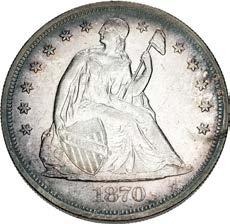
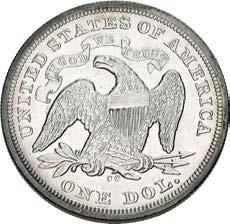
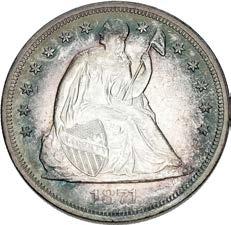







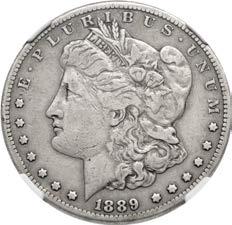





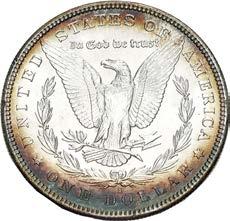




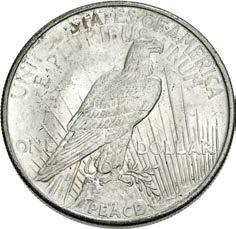




796. Fred A. Miller, Assayer. Austin, Nevada. Silver bar. Undated (1863-1865). The bar reads: FRED. A. MILLER in a pre-formed logo punch in an arc at the top of the bar / OZ. 1.07. in two lines below on the face. $.1.47./ KITTY. REED. in two lines on the back. The ingot itself measures 54mm wide, 23.5mm tall, 2mm deep, 33.13g. Extremely rare. Tell-tail signs of authenticity include: Fred A. Miller logo punch is in an arc with the periods shaped as trapezoids, and the Z in OZ is retrograde and underlined. ($3000)
From the Alexander Christopher Collection.
Fred A. Miller was “the first (and thus Pioneer) Assay Office in Austin,” Nevada, according to an article by Fred N. Holabird titled “A Silver Ingot Made for Circulating Currency.” Fred Miller opened his office in late June or early July 1863, placing his first advertisement in a local newspaper on July 1 of that year. The Reese River Reveille published an article about the region’s first bank, Paxton & Thornburg, and said: “Fred A. Miller has it in contemplation, we believe, to stamp small bars of silver to use in making change.” Miller was known as “the Chief Assayer of Austin.” It seems he sold his Austin assay business in early 1865. This important silver bar is from the early days of Austin and the Reese River silver discoveries. For more information go to Holabird’s article: https://rareingot.com/fred-a-miller-assayer/.


797. North Star Silver Mining Co. Silver Ingot. Undated (circa 1877). All stamps are on the front face: SILVERTON/ [N].S.S.M. in two lines. This small trapezoidal ingot itself measures 28.5mm wide, 19mm tall, 9mm deep, 43.69g. Cf. Heritage 1294 (26 April 2019), lot 5240 and cf. Heritage (6 January 2006), lot 6197 (price realized ($6,900). ($1000)
From the Alexander Christopher Collection.
The two examples in Heritage auctions carried the following information: “This small, trapezoidal silver ingot is suggestive of the style of John Taylor. It is most likely from the early period of this mine and was very likely made as a souvenir at the onset of production. The mine was owned by Albert Conyers, a distant relative of Buffalo Bill Cody. The North Star Silver Mining Company was most productive from 1877-1885, but remained active through the first part of the 20th century. Much more background information can be found in Holabird’s Auction # 17, page 165.”


798. North Star Silver Mining Co. Silver Ingot. Undated (circa 1877). All stamps are on the front face: SILVERTON/ N.S.S.M. in two lines. This small trapezoidal ingot itself measures 28mm wide, 16mm tall, 7.5mm deep, 30.90g. Cf. Heritage 1294 (26 April 2019), lot 5240 and cf. Heritage (6 January 2006), lot 6197 (price realized ($6,900). ($1000)
From the Alexander Christopher Collection.

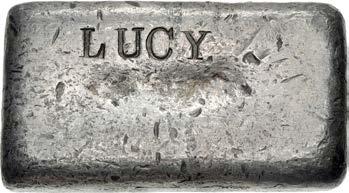
From the Alexander Christopher Collection.


From the Alexander Christopher Collection.






802. ANGLO-SAXON, Transitional/Pre-Primary Phase. Circa 665/70-670/5. Pale AV Thrymsa – Shilling (12mm, 1.24 g, 9h). ‘Pada’ series (Rigold PaIB). Mint in Kent. Helmeted bust right; upwards to right, [ upwards to left] / Standard inscribed //; flanking tufa above, upward on right, ᛈᚪᛞᚪ downward on left; cross below. Abramson p. 47; Sutherland 83; Metcalf 81; SCBI 67 (Abramson), 17-8; SCBI 63 (BM), 32; North 32; SCBC 768A. Toned, deposits. Good VF. Extremely rare and well struck. ($1000)




803. ANGLO-SAXON, Transitional/Pre-Primary Phase. Circa 665/70-670/5. Pale AV Thrymsa – Shilling (11.5mm, 1.31 g, 6h). ‘Pada’ series (Rigold PaIB). Mint in Kent. Helmeted bust right; upwards to right, [] upwards to left / Standard inscribed //; flanking tufa above, upward on right, ᛈᚪᛞᚪ downward on left; cross below. Abramson p. 47; Sutherland 83; Metcalf 81; SCBI 69 (Abramson), 17-8; SCBI 63 (BM), 32; North 32; SCBC 768A. Dark find patina. VF. Extremely rare. ($750)
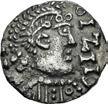


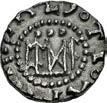
804. ANGLO-SAXON, Transitional/Pre-Primary Phase. Circa 675-680. Pale AV Thrymsa – Shilling (12mm, 1.17 g, 10h). ‘Pada’ series (Rigold PaIB/PaIIA mule). Mint in Kent. Helmeted bust right; upwards to right, upwards to left / ᛈᚪᛞᚪ (PADA in Runic), three pellets above, in beaded circle; + clockwise around from tufa on left. Abramson 1.30 var. (obv. legend); MEC 8, 15/16 (obv. rev.); SCBI 69 (Abramson), –; North –; SCBC 768A/769 (same); Elsen 150, lot 1006. Toned, some deposits, slight roughness. Good VF. Extremely rare mule. ($2000)
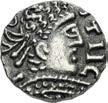



805. ANGLO-SAXON, Transitional/Pre-Primary Phase. Circa 665/70-670/5. Pale AV Thrymsa – Shilling (13mm, 1.19 g, 3h). ‘Pada’ series (Rigold PaIIA, Type 95). Mint in Kent. Diademed bust right; to right / ᛈᚪᛞᚪ (PADA in Runic), three pellets above, in beaded circle; + clockwise around from tufa on left. Abramson 1.30; MEC 8 table 3, 31; SCBI 69 (Abramson), 19; North 154; SCBC 769. Toned, traces of deposits, die rust. Good VF. Well struck. Rare. ($2000)
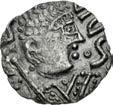



806. ANGLO-SAXON, Transitional/Pre-Primary Phase. Circa 665/70-670/5. AR Sceatt (13mm, 0.84 g, 6h). ‘Vanimundus’ series, Rigold VB, type 55. Mint in East Anglia (Mid-Suffolk). Diademed bust right; staff over right shoulder, annulet before mouth; clockwise around from lower left / Cross pattée within double beaded circle; ᛭ clockwise around from top. Abramson 2-10; MEC 8 Series VAb; SCBI 69 (Abramson), 26 (same dies); North 12/2; SCBC 774. Iridescent toning, deposits, slight obverse double strike. Near EF. ($1000)



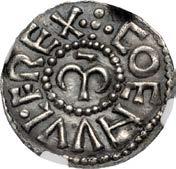
807. ANGLO-SAXON, Archbishops of Canterbury. Æthelheard. 792/3-805. AR Penny (19mm, 1.29 g, 7h). With Coenwulf as King. Canterbury mint. Struck 797/8-805. კ ¨ዞዝዢ⌦ዡf¨ʼዝ ¨ʼ , barred ⌓P in pelleted circle / კ üɭዞn⎍⎍⌦/ዟ ʼዞҟ , M in pelleted circle. Naismith 22.1m-n (same obv. die); SCBI 67 (BM) 752 (same obv. die); North 232; SCBC 886A. Toned. In NGC encapsulation 8388454-007, graded AU 58. Well struck. Very rare. ($3000)
Ex Causeway Collection (Triton XXVII, 9 January 2024), lot 1234, purchased from L. Bennett, June 2015.
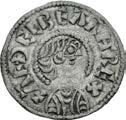
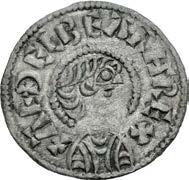
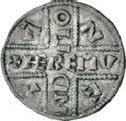
808. ANGLO-SAXON, Kings of Wessex. Æthelberht. 858-865/6. AR Penny (21mm, 1.05 g, 3h). Inscribed Cross type (BMC i). Canterbury mint; Heremund, moneyer. Struck circa 858-864. ม aዒ T ዒ⌦ዛዒaያ h ያዒҟ , diademed and draped bust right / ม ⎳ያዒ⍵ќ / ⎴ዝ ⍵ɭ / ⎴ ዞ ˶ a in and around arms of beaded cross. Naismith C190d (this coin); North 620; SCBC 1053. Toned. Good VF. Rare. ($3000)
From the Deer Creek Collection. Ex Todd Hansen Collection (Classical Numismatic Group 115, 16 September 2020), lot 1026; Property of a Gentleman - Canterbury Mint (Spink 211, 13 December 2011), lot 16, purchased from Spink, 2009; Bruun Rasmussen 674 (11 December 2006), lot 5431.



809. ANGLO-SAXON, Kings of Wessex. Æthelred I. 865/6-871. AR Penny (18mm, 9h). Lunettes type. Canterbury mint; Deneweald, moneyer. Struck circa 867-871. Diademed bust right / ዝዞnዞዩ¨⌦ዝ across central field; /Ḧ ዦɭn Ḧ/ /Ḧ
Ḧ/ in lunettes above and below. Lyons & MacKay Ae3.7 (dies C/c) = C. Anderson, Chronicles of the Parish of Croyden, Surrey: Saxon Croydon (Boston, 1877), p. 136, no. 4 (this coin); cf. SCBI 67 (BM), 1361-2 (for moneyer); North 622; SCBC 1055. Toned. In NGC encapsulation 2033805-016, graded VF Details, Environmental Damage. Extremely rare, one of only three coins known by Deneweald for this Æthelred, with the other two in the BM. ($2000)
Ex H. Walker Collection (Glendining, 18 June 1942), lot 71; A.N. Brushfield Collection (Glendining, 2 May 1929), lot 26 (part of); P.W.P. Carylon-Britton Collection (Sotheby, Wilkinson, & Hodge, 11 November 1918), lot 1643 (part of); W. Allen Collection (Sotheby, Wilkinson, & Hodge, 14 March 1898), lot 190 (part of); 1862 Croydon, Sussex Hoard.
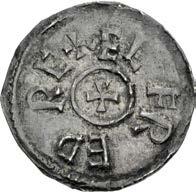


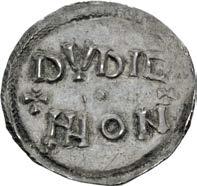
810. ANGLO-SAXON, Kings of Wessex. Alfred the Great. 871-899. AR Penny (22mm, 1.59 g, 9h). Two-line (’Guthram’) type (BMC xiv). Canterbury style; Duding, moneyer. Struck circa 880-899. ม
, small cross pattée / ĕќĕዢŭ / Ȳɭ⌱ in two lines; ม / ม between. SCBI 9 (Ashmolean), 258 (same obv. die); BMC 264; North 635; SCBC 1066. Richly toned, minor deposits, slight doubling, slight marks. Good VF. Very rare. ($2500)
Ex Grapevine Collection, purchased from J. Linzalone, 2014.


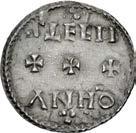
811. ANGLO-SAXON, Kings of Wessex. Edward the Elder. 899-924. AR Penny (23mm, 1.51 g, 3h). Small cross/Horizontal-Trefoil 1 (HT 1) type (BMC ii). Wessex dies; Stefman, moneyer. Late period II, struck circa 920-924. ม
, small cross pattée / Ӳ⍇e
/ ©n ዦ!ɭ in two lines; three crosses, trefoils above and below. CTCE 272ii var. (rev. legend); SCBI 26 (East Anglia), 164 var. (same); BMC –; North 649; SCBC 1087. Richly toned. Choice EF. Extremely rare moneyer. ($1000)
Ex Grapevine Collection, purchased from J. Linzalone, 2014.
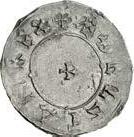


812. ANGLO-SAXON, Kings of Wessex. Æthelstan. 924-939. AR Penny (23mm, 1.59 g, 10h). Circumscription Cross type (BMC v). London mint; Ighar, moneyer. ม ®T ዞ⌦Ӳ˸²n ʼዞҟ , small cross pattée; four pellets near inner border / ม
, small cross pattée; four pellets near inner border. Blunt, Aethelstan 189; SCBI 34 (BM), –; North 672; SCBC 1093. Areas of weak strike. VF. ($1000)
Ex Dix Noonan Webb 136 (8 June 2016), lot 572; Dix Noonan Webb 135 (21 March 2016), lot 543.
Ex Mack & 1928 Vatican Hoard

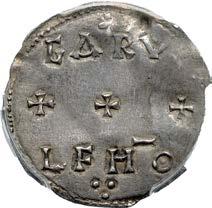

813. ANGLO-SAXON, Kings of Wessex. Æthelstan. 924-939. AR Penny (22mm, 6h). Small cross/Horizontal-Trefoil 1 (HT 1) type (BMC i). Uncertain mint; Garwulf, moneyer. ม ®T ዞ⌦Ӳ˸²n ʼዞҟ , small cross pattée / ű²ʼ⎍ / ⌦ዟ ዦ!ɭ in two lines; three cross pattée between, trefoils above and below. Blunt, Aethelstan 59 = SCBI 20 (Mack), 773 = Vatican Hoard 504 (this coin); North 668; SCBC 1089. Toned, slight chip not noted on slab. In PCGS encapsulation 36244112, graded AU 53. Very rare. The sole example of this moneyer in SCBI and EMC. ($1000)
Ex Stack’s Bowers Galleries (11 January 2019), lot 43009; R.P. Mack Collection; Glendining (13 November 1930), lot 109 (part of); 1928 Vatican Hoard.


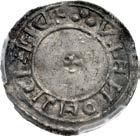
814. ANGLO-SAXON, Kings of Wessex. Eadred. 946-955. AR Penny (20mm, 1.40 g, 2h). Bust Crowned type (BMC v). Norwich(?) mint; Dredil, moneyer. ม ዞ©ዝʼዞዝ
, crowned and draped bust right /
, small cross. CTCE –; SCBI –; BMC –; North 713; SCBC 1115. In PCGS encapsulation 43252193, graded AU 55. Unpublished moneyer. Extremely rare. ($3000)
From the Deer Creek Collection. Ex Paul C. Runze Collection (Stack’s Bowers Galleries, 14 January 2022), lot 1198; CNG inventory 877713 (August 2010).

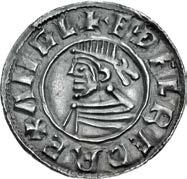

815. ANGLO-SAXON, Kings of All England. Æthelred II. 978-1016. AR Penny (21mm, 1.38 g, 12h). Last Small Cross type (BMC i, Hild. A). Lincoln mint; Reinald, moneyer. Struck circa 1009-1016. Diademed and draped bust left / ม ያ ® ዢዞnɭ⌦ዝ ዦ!ɭ ⌦ዢnù , small cross pattée. Mossop pl. XXVII, 11 (dies C/d); SCBI 65 (Norwegian), 1251 (same rev. die); North 777; SCBC 1154. Deep cabinet toning. Good VF. ($500)
From the Deer Creek Collection. Ex New Horizons Collection (Classical Numismatic Group 120, 11 May 2022), lot 1114.
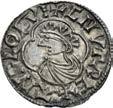
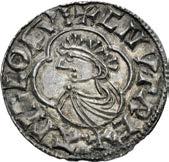

816. ANGLO-SAXON, Kings of All England. Cnut. 1016-1035. AR Penny (19mm, 1.09 g, 12h). Quatrefoil type (BMC viii, Hild. E). Bath mint; Ælfric, moneyer. Struck circa 1016-1023. Crowned and draped bust left within quatrefoil / ม ® ዟ ያዢù ɭ n ዛa T an , voided long cross with triple-crescent ends and pellet at center; all over quatrefoil. Grinsell 1; SCBI 13 (Copenhagen), 17-8 (same dies); North 781; SCBC 1157. Old cabinet toning. EF. ($750)
From the Deer Creek Collection. Ex New Horizons Collection (Classical Numismatic Group 120, 11 May 2022), lot 1116, purchased from AMR Coins.
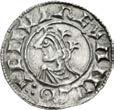


817. ANGLO-SAXON, Kings of All England. Cnut. 1016-1035. AR Penny (18mm, 1.05 g, 3h). Quatrefoil type (BMC viii, Hild. E). London mint; Eadwine, moneyer. Struck circa 1016-1023. Crowned and draped bust left within quatrefoil / ม e©ē PƩne ዝ ∂ à V ë eƩ , voided long cross with triple-crescent ends and pellet at center; all over quatrefoil. SCBI 14 (Copenhagen), 2350-3; North 781; SCBC 1157. Iridescent toning. Near EF. ($500)
Ex Andy Singer inventory 180914310; Spink 238 (27 June 2016), lot 1123; Steven W. Damron inventory LBCX0917#71ZS. Cnut the Great (1016-1035) maintained the system of Anglo-Saxon mints, striking a significant coinage of pennies (on a lower weight standard) that paid for his army and navy that maintained a North Sea Empire embracing England, Denmark, and, after 1028, Norway. Recorded levies totaled £82,500 (19.8 million pennies).

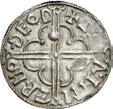
818. ANGLO-SAXON, Kings of All England. Cnut. 1016-1035. AR Penny (19mm, 0.94 g, 9h). Quatrefoil type (BMC viii, Hild. E). Thetford mint; Stanmaer, moneyer. Struck circa 1016-1023. Crowned and draped bust left within quatrefoil / ม Ӳ˶ © • nȵ ® ʽ ȵ⌴ T e⌴ē , voided long cross with triple-crescent ends and pellet at center; all over quatrefoil. SCBI 15 (Copenhagen), 3847 (same obv. die); North 781; SCBC 1157. Light iridescent toning, traces of die rust. Good VF. ($500) Ex Andy Singer inventory 20272255.

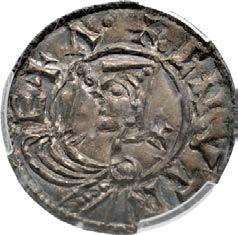
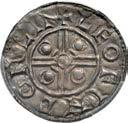
819. ANGLO-SAXON, Kings of All England. Cnut. 1016-1035. AR Penny (18mm, 11h). Pointed Helmet type (BMC xiv var., Hild. G var.). Lincoln mint; Leofing, moneyer. Struck circa 1023-1030. Bust left, wearing pointed helmet; trefoiltipped scepter before, cross to right / ม ⌦ዞɭዟዢnü ɭn ⌦ዢn , voided short cross, limbs united at base by two concentric circles with pellet in center; in each angle, broken annulet enclosing pellet. Mossop –; cf. SCBI 14 (Copenhagen), 1683-7 (for similar, no cross); North 787 var. (no cross); SCBC 1158. Toned. In PCGS encapsulation 38496432, graded MS 64. Rare variety with a cross on the obverse, apparently unrecorded for this moneyer. ($500)
From the Deer Creek Collection. Ex New Horizons Collection (Classical Numismatic Group 120, 11 May 2022), lot 1125, purchased from Atlas Numismatics.
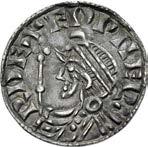



820. ANGLO-SAXON, Kings of All England. Edward the Confessor. 1042-1066. AR Penny (16mm, 0.76 g, 4h). Trefoil Quadrilateral type (BMC iii, Hild. C). London mint; Godsunu, moneyer. Struck circa 1046-1048. Diademed and draped bust left; scepter pommée to left / ม űɭዝ˞⎍ዢn⎍ ɭn ⌦⎍ ë, quadrilateral, with pellet in center and trefoils at angles, over voided short cross. Freeman 452; SCBI 54 (Stockholm), 801; North 817; SCBC 1174. Richly toned, two small cracks. Good VF. ($500)
From the Deer Creek Collection. Ex New Horizons Collection (Classical Numismatic Group 120, 11 May 2022), lot 1140; Lord Stewartby Collection (Part I, Spink 234, 22 March 2016), lot 279, purchased December 1955; Duke of Argyll Collection; T. Bearman Collection; J. Nunn Collection (Sotheby, Wilkinson & Hodge, 27 November 1896), lot 169 (part of).



821. ANGLO-SAXON, Kings of All England. Edward the Confessor. 1042-1066. AR Penny (20mm, 1.28 g, 12h). Hammer Cross type (BMC xi, Hild. G). Steyning mint; Deorman, moneyer. Struck circa 1059-1062. Crowned bust right, scepter before / ม ዝዢɭʼዦ©n ɭn ˞Ϳ ® nዢű , voided cross, arms terminating in inward-facing crescents. King 35; Freeman 8; SCBI 42 (South-Eastern), 1539 (same dies); North 828; SCBC 1182. Richly toned, slightly wavy flan. Near EF. ($500)
Ex Andy Singer inventory 109803JW605.
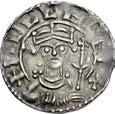
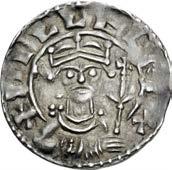
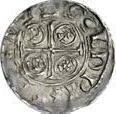
822. NORMAN. William I ‘the Conqueror’. 1066-1087. AR Penny (19mm, 1.40 g, 3h). Paxs type (BMC viii). Dover mint; Goldwine, moneyer. Struck circa 1083-1086. Crowned facing bust, holding scepter; annulet on right shoulder / ม Żɭ⌦ዝዩዢnዞ ɭn ዝɭዟ , cross pattée; letters of ʖ a ҟ ˨ in annulets within quarters. SCBI 20 (Mack), 1420; BMC 368-9 var. (crown type); North 850; SCBC 1257. Toned, reverse slightly double struck. VF. ($1000)
From the Deer Creek Collection. Ex Causeway Collection (Classical Numismatic Group 120, 11 May 2022), lot 1175, purchased from AMR Coins, July 2012.
The Battle of Hastings, fought on 14 October 1066, is one of the decisive events in English history. The death of Harold II, felled famously by an arrow in the eye, marked the end of some 500 years Anglo-Saxon rule and civilization. On Christmas Day 1066, the victor, William, Duke of Normandy, was crowned in Westminster Abbey and by the 1070 the Norman conquest of England was effectively complete. In his new realm William found a highly efficient monetary system that he wisely retained.
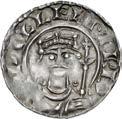


823. NORMAN. William I ‘the Conqueror’. 1066-1087. AR Penny (19mm, 1.38 g, 9h). Paxs type (BMC viii). Stafford mint; Godwine, moneyer. Struck circa 1083-1086. Crowned facing bust, holding scepter; pellet on right shoulder / ม ű∂ዝዩዢnዞ ∂n S˸ዟʼ , cross pattée; letters of ዩ a ҟ S in annulets within quarters. SCBI 20 (Mack), 1449 var. (legends); BMC 981 var. (same); North 848; SCBC 1257. Deep golden toning, usual areas of weak strike, slight double strike. Good VF. ($1500)
Ex Haddenham Collecton, purchased from T. Matthews, 1984.


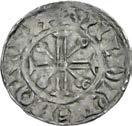
824. NORMAN. William II Rufus. 1087-1100. AR Penny (22mm, 1.41 g, 12h). Cross Voided type (BMC iii). Canterbury mint; Ealdræd, moneyer. Struck circa 1092-1095. Crowned facing bust; stars flanking / ม ዢዢ⌦ዝʼዢዞዝ ɭn ùn˶ , voided cross pattée, with annulet at center; all over cross annulettée. SCBI 48 (Northern), 1135; BMC 176; North 853; SCBC 1260. Richly toned, worn dies. VF. ($1500)
From the Deer Creek Collection. Ex Maxwell Collection (Classical Numismatic Group 115, 16 September 2020), lot 1083; Richard Cyril Lockett Collection (English Part I, Glendining’s, 6 June 1955), lot 1021.
William II Rufus, the second son of William I and Queen Matilda of Flanders, succeeded to the throne of England, while his older brother Robert Curthose inherited the Duchy of Normandy. When William died mysteriously in a hunting accident, Henry Beauclerc, the third son of William the Conqueror, seized the throne.

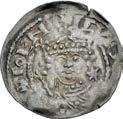

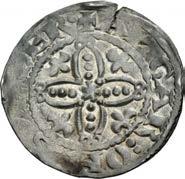
825. NORMAN. Henry I. 1100-1135. AR Penny (21mm, 1.39 g, 10h). Pellets in quatrefoil type (BMC xiv). Southwark mint; Algar, moneyer. Struck circa 1123. Crowned facing bust, holding scepter; star to right / ม ²⌦Ż²ʼ
quatrefoil with central star and three pellets in each limb; lis in each quarter. SCBI –; EMC 2014.0065 (same rev. die); BMC 170; North 870; SCBC 1275. Toned, small edge split, slightly off center. Good VF. ($750)
From the Deer Creek Collection. Ex Allan Williams Collection (Classical Numismatic Group 115, 16 September 2020), lot 1088, purchased from M.R. Roberts, May 1991.
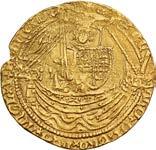


826. PLANTAGENET. Richard II. 1377-1399. AV Half Noble (16.5mm, 3.78 g, 6h). Third issue, Type 3a. Tower (London) mint. Richard, holding sword and shield, standing facing in ship; ornaments -1-1[-], ropes 3/1, quatrefoils 4/4; pellet in first quarter of shield / Voided short cross potent over cross fleurée; in each angle, crown over lion passant over trefoil; at center, r within quadrilobe; all within polylobe, with trefoils in spandrels. Cf. Schneider 165; cf. North 1312; cf. SCBC 1667. Lightly toned, rough, edge split. VF. Very rare. ($2000)
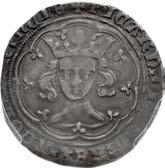
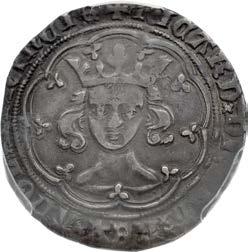

827. PLANTAGENET. Richard II. 1377-1399. AR Groat. Type III. Tower (London) mint. Crowned facing bust within tressure of arches; fleurs on cusps / Long cross pattée; triple pellets in quarters. North 1321; SCBC 1680. In PCGS encapsulation 43252198, graded XF 45. ($1000)
From the Deer Creek Collection. Ex Paul C. Runze Collection (Stack’s Bowers Galleries, 14 January 2022), lot 1225.




828. LANCASTER. Henry V. 1413-1422. AV Quarter Noble (18mm, 1.72 g, 1h). Class CVs/Vr-s. Tower (London) mint. Coat-of-arms within tressure of eight arches, annulets at points of arcs; lis above shield; broken annulet to left of shield, cinquefoil to right / Ornate cross fourchée, with lis in center and each fork; in quarters, lion passant left above triple pellets. Schneider 243; North 1382; SCBC 1756 var. (mullet to right of shield). Hint of deposits, light roughness, evidence of having been placed in a bezel. VF. ($750)
Ex Thomas Bentley Cederlind Estate (Classical Numismatic Group 102, 18 May 2016), lot 1508; Cederlind BBS 172 (18 December 2013), lot 367.
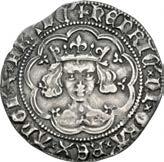
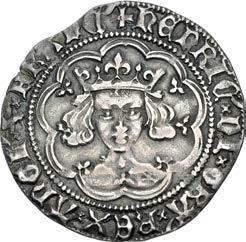

829. LANCASTER. Henry V. 1413-1422. AR Groat (27mm, 3.40 g, 10h). Class C. London (Tower) mint; im: cross pattée with pellet center. Crowned facing ‘frowning’ bust within tressure of nine arches; mullet on breast / Long cross pattée; triple pellets in quarters. Potter VI; North 1387a; SCBC 1765. Toned, slightly irregular flan, minor porosity. VF. ($1000)
Ex Lord Stewartby Collection (Part IV, Spink 242, 29 November 2016), lot 1234, purchased from E.J. Harris, November 2005.

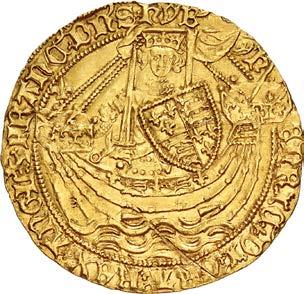

830. LANCASTER. Henry VI. First reign, 1422-1461. AV Noble (33.5mm, 6.96 g, 6h). Annulet issue. Calais mint; im: lis. Struck 1422-1427. Henry standing facing in ship, holding sword and shield; annulet to left of hand; ornaments: 1-1-1; quatrefoils: 3/3; lis above stern / Cross fleurée over voided short cross potent; at center, ƌ within quatrefoil; in each angle, crown above lion passant; all within double polylobe, with annulet in one spandrel and trefoil in all others. Schneider 302A; North 1416; SCBC 1804. Toned, slightly creased. Good VF. Rare. ($2500)
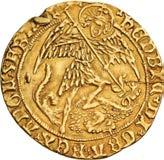


831. LANCASTER (Restored). Henry VI. Second reign, 1470-1471. AV Angel (38mm, 4.94 g, 10h). Tower (London) mint; im: –/restoration cross. Archangel Michael slaying the dragon to lower right with spear terminating in cross crosslet / Ship bearing shield and cross, ƌ and lis flanking cross. Allen dies F/j; Blunt & Whitton 3/8; Schneider 438 (same dies); North 1613; SCBC 2078. Toned, edge fold over on obverse, ex jewelry. VF. Rare. ($2000)
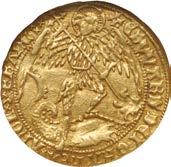


832. YORK (Restored). Edward IV. Second reign, 1471-1483. AV Angel. Struck 1471-1472. Archangel Michael slaying the dragon to lower right with spear terminating in cross crosslet / Ship bearing shield and cross, Ě and rose flanking cross. Webb Ware dies 30/57; Blunt & Whitton type XVIIIb, variant 3; Schneider 464 (same dies); North 1626; SCBC 2091. In NGC encapsulation 1521253-001, graded AU 55, incorrectly attributed to Edward VI on label. ($2500)
The restoration of Edward IV to the English throne was one episode in the thirty-year dynastic conflict known to history as the “Wars of the Roses” (1455-1485). So-named because of the roses employed by the competing houses – a red one for the Lancastrians and a white one for the Yorkists – the war was the result of the conflict that occurred between the sons of Edward III and their respective descendants in competition for the English throne. Beginning with the deposition in 1399 of Richard II by Henry Bolingbroke (subsequently Henry IV), the Lancastrian branch became the ruling family. The untimely death of Henry’s successor, Henry V in 1422, left the throne to the infant Henry VI. Until 1437, when he achieved his majority, the country was ruled by regents; after this, Henry’s own inability to rule effectively, as well as his personal insanity, created a volatile political instability the allowed for the rise of the Yorkists. In 1461, Henry VI was deposed by Edward, Duke of York, who became Edward IV. Edward, through the support of his cousin, Richard Neville, Earl of Warwick (“The Kingmaker”) consolidated his position as king, but the two fell out over Edward’s marriage to Elizabeth Woodville, the widow of a Lancastrian sympathizer. Warwick rebelled, capturing Edward, but subsequently being compelled by the nobles to release him. In 1470, Warwick again rebelled, restoring Henry VI (who had been in the Tower since 1465) again briefly to the throne. Following the decisive Battle of Tewkesbury on 4 May 1471, Edward IV was restored as king and Henry VI, deposed for the final time, was re-imprisoned in the Tower, where he died a little over two weeks later. Edward and the House of York now ruled unopposed, since direct Lancastrian opposition had been checked. Only Henry Tudor, the great-great grandson of John of Gaunt, remained – an exile in France.

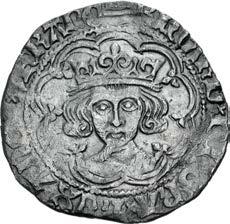
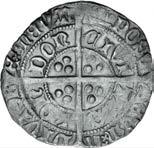
833. YORK (Restored). Richard III. 1483-1485. AR Groat (26mm, 2.96 g, 12h). Type 2b. Tower (London) mint; im: boar’s head 2. Struck 20 July 1483 to June 1484. Crowned facing bust within tressure of arches; fleurs on cusps / Long cross pattée; triple pellets in quarters. MEG type 2b; North 1679; SCBC 2156. Find patina, cleaning scratches. VF. ($1500)
Ex Grapevine Collection, purchased from J. Linzalone, 2013.



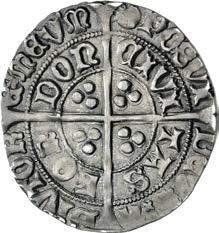
834. YORK (Restored). Richard III. 1483-1485. AR Groat (26mm, 3.18 g, 10h). Type 3. Tower (London) mint; im: sun and rose 2. Struck circa June 1484–22 August 1485. Crowned facing bust within tressure of arches; fleurs on cusps / Long cross pattée; triple pellets in quarters. Winstanley 12; North 1679; SCBC 2157. Toned with a trace of underlying luster. Near EF. Bold portrait of the king. Rare. ($3000)
From the Deer Creek Collection. Ex Geoffrey Cope Collection (Numismatica Ars Classica 145, with Classical Numismatic Group & Numismatica Genevensis SA, 8 May 2024), lot 1186.
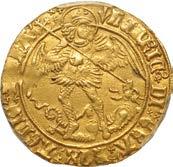


835. TUDOR. Henry VII. 1485-1509. AV Angel. Type V. Tower (London) mint; im: pheon. Struck 1504-1509. Archangel Michael slaying the dragon to lower right with spear terminating in cross crosslet / Ship bearing coat-of-arms; above, cross between ƌ and rose. Cf. Schneider 542 (for type); North 1698; SCBC 2187. In PCGS encapsulation 81299710, graded AU 53. ($2500)
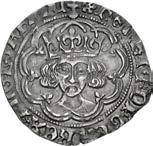


836. TUDOR. Henry VII. 1485-1509. AR Groat (26mm, 2.74 g, 5h). Facing bust issue, type IIa. London (Tower) mint; im: cinquefoil/–. Struck 1489-1493. Crowned facing bust within double polylobe with fleurs at cusps, nothing on breast; two plain arches in crown / Long cross pattée; three pellets in quarters. P&W type IIa and p. 273-4 (this coin cited); SCBI 23 (Ashmolean), 197 (same rev. die); North 1704; SCBC 2195. Toned. Good VF. ($1000)
Ex James P. Rosen Collection (Classical Numismatic Group Keystone Sale 14, 12 June 2024), lot 41 (hammer $2750); New Horizons Collection (Classical Numismatic Group 123, 23 May 2023), lot 966; Lord Stewartby Collection (Part V, Spink 243, 28 March 2017), lot 1479; W.J. Potter Collection; Richard Cyril Lockett Collection (Part II, 11 October 1956), lot 1705c.

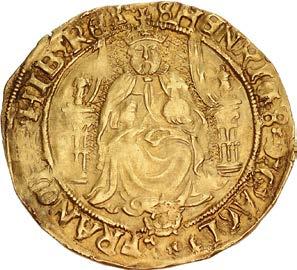

837. TUDOR. Henry VIII. 1509-1547. AV Half Sovereign (32mm, 6.13 g, 4h). Third coinage. Southwark mint; im: S. Struck 1544-1547. Henry enthroned facing, holding scepter and globus cruciger; rose below / Crowned coat-of-arms with dragon and lion supporters standing on crown. Whitton IIb; Schneider 621; North 1828; SCBC 2297. Lightly toned, areas of deposits, some weakness. Good VF. Excellent portrait. ($3000)
Ex Classical Numismatic Review 18.3 (1993 Third Quarter), no. 17; Richard Cyril Lockett Collection (English Part II, Glendining, 15 October 1956), lot 1793.

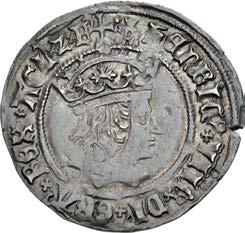

838. TUDOR. Henry VIII. 1509-1547. AR Groat (28mm, 3.05 g, 2h). First coinage. London (Tower) mint; im: castle. Struck 1509-1526. Crowned bust right with features of Henry VII (Laker A); pellet to left of im / Coat-of-arms over long cross fourchée. Whitton (ii), 2; North 1762; SCBC 2316. Deep iridescent toning, light scratch behind crown. Good VF. ($750)
From the Deer Creek Collection. Ex James P. Rosen Collection (Classical Numismatic Group Keystone Sale 14, 12 June 2024), lot 64, purchased from Bruce Lorich.
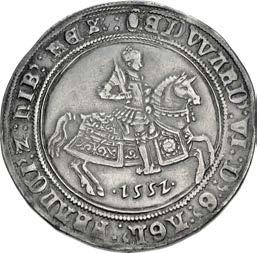


839. TUDOR. Edward VI. 1547-1553. AR Crown (41mm, 30.98 g, 8h). Third period; Fine Silver issue. Tower (London) mint; im: tun. Dated 1552. Edward, armored and holding sword, on caparisoned horse right / Coat-of-arms over long cross fourchée. Woodbridge dies A/13; North 1833; SCBC 2478. Lightly toned, slight double strike in obverse legend. VF. Horseman well struck up. Rare. ($4000)
From the Deer Creek Collection. Ex Eton Collection (Classical Numismatic Group 120, 11 May 2022), lot 1234.
By the middle of 1551 the silver coinage of Edward VI was at its intrinsic worst. Beginning with the last issues of Henry VIII, the silver coinage had become steadily more debased to stretch the ever-dwindling silver resources available to the crown. The poor quality coinage of Edward’s early reign was reflective of the troubled political situation. The son of Henry VIII by his third wife, Jane Seymour, Edward was a sickly youth who ascended the throne while still in his minority. Consequently, he was subject to a regency under his uncle, Edward Seymour, 1st Duke of Somerset as Lord Protector. A devout Protestant, Seymour and his allies worked to continue the Reformation in England begun under Henry VIII. Numerous problems, however, caused Seymour’s unpopularity to increase dramatically. He was eventually replaced by the Duke of Northumberland, John Dudley, and executed soon after.
Dudley believed that to combat England’s problems at home and abroad, the king had to declare his majority as soon as he turned 16. Moreover, the poor quality coinage had to be replaced with that of a higher quality silver. For the next three years, issues such as this crown were struck in an attempt to bolster the young king’s government. However, Edward died in 1553 and such fine quality coinage came to an end under his sister and successor, Mary.
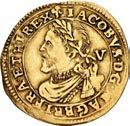
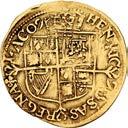
840. STUART. James I. 1603-1625. AV Quarter Laurel (20.5mm, 2.17 g, 4h). Third coinage, crown gold. Tower (London) mint; im: trefoil. Struck 18 June 1624-7 July 1625. Laureate, draped, and armored bust left; V (mark of value) to right; wire-line inner and outer circles / Crowned coat-of-arms over long cross fourchée; wire-line inner circle. Cf. Schneider 100; North 2119; SCBC 2642A. Toned, deposits in devices, reverse double struck. Near VF. ($500)
Ex Spartan Numismatics BBS 19 (27 February 2001), lot 4.
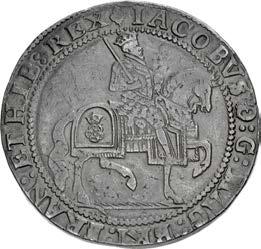


841. STUART. James I. 1603-1625. AR Crown (42mm, 30.31 g, 10h). Third coinage. Tower (London) mint; im: lis. Struck 1623-1624. James on horseback left, holding reins and sword / Coat-of-arms with plume above. Cooper, English, dies X/XIX (this coin illustrated for rev. XIX); North 2121; SCBC 2665. Richly toned, two light marks in obverse field, with traces of luster around devices. Good VF. ($3000)
From the Deer Creek Collection. Ex Eton Collection (Classical Numismatic Group 120, 11 May 2022), lot 1249; Andrew Wayne (Classical Numismatic Group 72, 14 June 2006), lot 2607; T. Zimmer (Sotheby’s, 23 September 1982), lot 131; F.R. Cooper (Glendining’s, 8 November 1978), lot 34; Glendining’s (14 April 1965), lot 157.
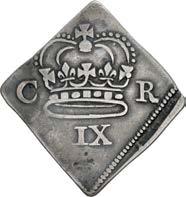
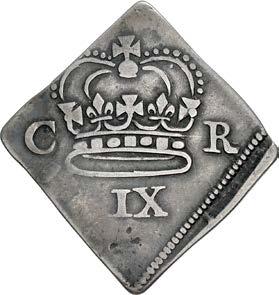

842. STUART, Siege money. Newark. 1645-1646. AR Ninepence (25x27mm, 4.15 g, 12h). Dated 1645. Crown; C R across field, IX (mark of value) below / O[BS:]/N[E]WA[RKE]/1645 (date) in three lines across field. Brooker 1226 (same obv. die); Hird 260 var. (date; same obv. die); North 2641; SCBC 3145. Toned, reverse weakly struck. Near VF. ($750)
In addition to defeating Royalist forces in the field during the English Civil War Period (1642-1651), Parliamentarian commanders also at several points during this same period besieged those strategically important and heavily fortified Royalist centers. Among these centers, the most important was the city of Newark-on-Trent (commonly shortened to Newark). Located between the rivers Trent and Devon, and at the intersection of the Great North Road and the ancient Fosse Way, the city was a mainstay of the Royalist cause. Because of this, it was the subject of three attacks. The first attempt occurred in February 1643 when Major-General Thomas Ballard, at the head of 6,000 Parliamentarians, tried to take the town, but, realizing his force was insufficient for success, withdrew after a battle of only one day. Following this event, the city repaired its existing castle and medieval walls, and a new circuit of earthwork banks and ditches was constructed. Combined with the natural barrier offered by the River Trent, Newark became an impregnable fortress.
In early March 1644, a force of Parliamentary troops, this time under the command of Francis, Lord Willoughby of Parham and Sir John Meldrum, laid siege to Newark. Seizing control of the level area to the northwest of the city – an area known as “the Island” – the Parliamentarians attempted on 8 March to break through, but were repulsed by the city defenders; at the same time, a Royalist force, sent from nearby Belvoir Castle to relieve the city, was beaten back. Under the direct order of King Charles I, Prince Rupert on 12 March, hurried toward the city. Along the way, he acquired what Royalist forces he could. Rather than simply relieving the siege of Newark and allowing the Parliamentarians the opportunity to withdraw and return at a later time, Rupert’s plan was to destroy the besieging army. Beginning in the early hours of 21 March, Rupert’s forces advanced upon the Parliamentarians and forced them to become hemmed in on “the Island”. Now, surrounded by the Royalists and with no recourse for either maneuver or withdrawal, the besieging Parliamentarians began to mutiny. Calling for a parley, the Parliamentarians were allowed to march away, but without their artillery, firearms, and ammunition. Upon Rupert’s departure, the surrendered ordinance was incorporated into the city’s defenses, while the Parliamentarian command center during the siege was demolished and in its place was constructed a massive defensive earthwork.
The relief of Newark in March 1644 allowed the city to become a staging area for Royalist raids throughout the Midlands for the rest of that year. The events of 1645, however, were to contribute to this vital stronghold’s undoing. In May 1645, Sir Richard Willys, an ally of Prince Rupert, was appointed new governor of Newark. In mid-June, however, the main Royalist force under Charles I was soundly defeated at Naseby by the Parliamentarian New Model Army of Oliver Cromwell and Lord Thomas Fairfax. Following a second Royalist defeat at Rowton Heath in late September and his subsequent withdrawal from Chester, Charles withdrew to Newark in October 1645. Now, with his command structure beginning to disintegrate because of a conflict with Prince Rupert and the removal of Sir Richard Willys as governor of Newark, and the Parliamentarian forces hot on the king’s heels from Chester, Charles, in early November, withdrew to Oxford. In place of Willys, Charles appointed Lord Belasyse as governor of Newark. Anticipating an imminent attack, Belasyse ordered the city to be resupplied, as well as the construction of additional earthwork defenses – including a ditch around the entire town and the destruction of all buildings outside the perimeter. Beginning at about the same time Charles was departing, the Parliamentarian forces under the command of Sydenham Poyntz moved up from the south, massacring and plundering their way toward Newark. The siege of the city itself began in earnest on 26 November 1645 with the arrival of the main body, consisting of Parliamentarians and Scottish Covenanters, under the command of Alexander Leslie, the Earl of Leven. Over the next five months and with a defensive force of less than 2,000 men, Belasyse conducted a vigorous defense. At times, the defenders even conducted raids against the besiegers; in one raid, Sydenham Poyntz himself was almost captured. By the spring of 1646, however, the tide had begun to turn against the defenders. The Parliamentarian besiegers began contracting their siege lines while the Scottish Covenanters established a fortress – Fort Edinburgh – on “the Island”. By mid-March, Newark was entirely surrounded and cut-off from access to the outside. In April, the Scots captured a Royalist work called Sandhills Sconce, which they converted into a battery from which they could bombard the town. Through all of this, however, Belasyse refused to surrender.
While Newark was close to being stormed, diplomatic negotiations, led by the French, had been ongoing to secure an end to the war and the surrender of the king to the Scots, rather than Parliament. In early May 1646, with the New Model Army closing in on Oxford, Charles fled to the Scottish camp outside of Newark, where he surrendered himself to Lieutenant-General David Leslie, acting commander of the Covenanter army. Eager to transport the king to Newcastle-on-Tyne, a place which was more secure and closer to the Scottish border, but unwilling to appear as if he had abandoned his Parliamentarian allies, Leslie urged the king to order the immediate surrender of Newark on reasonable terms. Although Lord Belasyse is said to have wept when he received the order, he had no choice but to obey. Newark surrendered on 6 May 1646 and Belasyse marched out with his much-reduced garrison. On 8 May, the Scots broke camp and marched north, taking Charles I with them in semi-captivity.

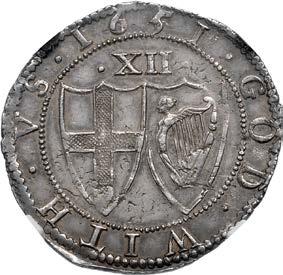
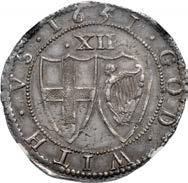
843. COMMONWEALTH. 1649-1660. AR Shilling (30mm, 5.92 g, 2h). Tower (London) mint; im: sun. Dated 1651. Coat-of-arms of England within wreath of palm and laurel / Coat-of-arms of the Commonwealth; · XII [·] (mark of value) above. ESC 984; North 2724; SCBC 3217. In NGC encapsulation 6062177-003, graded MS 61. Sharp details on the sun mintmark. ($1500)
From the Deer Creek Collection. Ex Triton XXVI (10 January 2023), lot 1264; Long Island Collection (Heritage 61255, 30 January 2022), lot 97142.

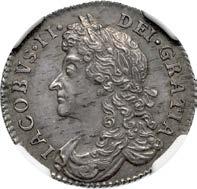

844. STUART. James II. 1685-1688. AR Sixpence. Dated 1686 (68 over 66). Bull 774; ESC –; SCBC 3412. Toned. In NGC encapsulation 4700163-002, graded MS 62. Rare overdate. ($750)
From the William B. Porter Collection.



845. STUART. James II. 1685-1688. AR Crown (40mm, 30.05 g, 6h). Dated 1687 and TERTIO. Second bust. Bull 743; ESC 78; SCBC 3407. Iridescent toning, a couple of minor die breaks and contact marks on obverse, some light hairlines, lustrous. EF. ($2500)
From the Deer Creek Collection. Ex Gainsborough Collection (Classical Numismatic Group 121, 6 October 2022), lot 1374.



846. STUART (ORANGE). William III & Mary. 1688-1694. AR Sixpence. Dated 1693. Bull 869; ESC 1529; SCBC 3438. Toned. In NGC encapsulation 1880258-009, graded AU 55. ($600)
From the William B. Porter Collection.

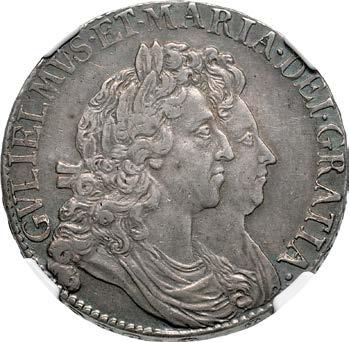

847. STUART (ORANGE). William III & Mary. 1688-1694. AR Crown. Dated 1692 (over inverted 2) and RY QVINTO. Bull 824; ESC 85; SCBC 3433. Toned. In NGC encapsulation 6909359-005, graded AU 53. ($2000)
From the Deer Creek Collection. Ex Alexander Christopher Collection.


848. STUART (ORANGE). William III. 1694-1702. AR Crown. Dated 1695 and SEPTIMO. First bust, first harp. Bull 990; ESC 86; SCBC 3470. In PCGS encapsulation 49128949, graded AU 58.
From the Deer Creek Collection.
From
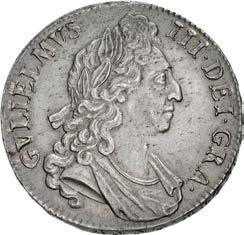




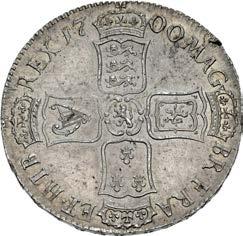
850. STUART (ORANGE). William III. 1694-1702. AR Crown (40mm, 30.05 g, 6h). Dated 1700 and DVODECIMO. Third bust, third harp. Bull 1010; ESC 97; SCBC 3474. Toned with considerable luster, minor metal flaw on rim. AU. ($1500)
From the Deer Creek Collection. Ex Gainsborough Collection (Classical Numismatic Group 121, 6 October 2022), lot 1379.

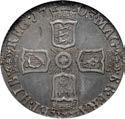
851. STUART. Anne. 1702-1714. AR Sixpence. Dated 1703 VIGO. Pre-Union issue. Bull 1446; ESC 1582; SCBC 3590. Toned. In NGC encapsulation 1729548-009, graded MS 62. ($750)
From the William B. Porter Collection.
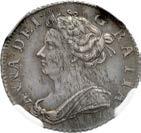

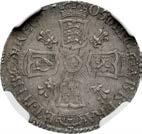
852. STUART. Anne. 1702-1714. AR Sixpence. Dated 1705. Pre-Union reverse, plumes, early shields. Bull 1448; ESC 1584; SCBC 3592. In NGC encapsulation 2118483-002, graded MS 62. ($500)
From the Deer Creek Collection. Ex Mildenhall Collection (Classical Numismatic Group Keystone Sale 5, 13 October 2021), lot 72; Spink 109 (4 July 1995) lot 192.
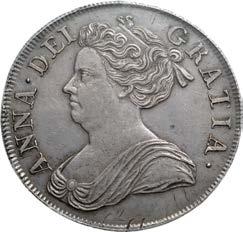


853. STUART. Anne. 1702-1714. AR Crown. Dated 1713 and RY DVODECIMO. Post-Union. Roses & plumes in angles. Bull 1349; ESC 109; SCBC 3603. Richly toned. In PCGS encapsulation 49128950, graded AU 58. ($3000)
From the Deer Creek Collection.

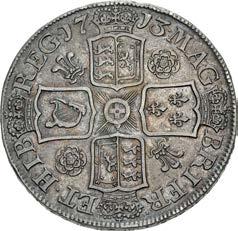
854. STUART. Anne. 1702-1714. AR Crown. Dated 1713 and RY DVODECIMO. Post-Union. Roses & plumes in angles. Bull 1349; ESC 109; SCBC 3603. Richly toned, edge scrape. VF. ($500)
From the Deer Creek Collection. Ex Malthouse Collection (Classical Numismatic Group 123, 23 May 2023), lot 1028.


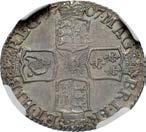
855. STUART. Anne. 1702-1714. AR Sixpence. 1707 E. Post-Union reverse. Bull 1464; ESC 1588; SCBC 3620. Richly toned, Lustrous reverse. In NGC encapsulation 2118483-003, graded MS 62. Top Pop. Only a proof specimen has received a higher grade. The single highest graded commercial issue at NGC. ($500)
From the Deer Creek Collection. Ex Mildenhall Collection (Classical Numismatic Group Keystone Sale 5, 13 October 2021), lot 74, purchased from Spink, November 1997.
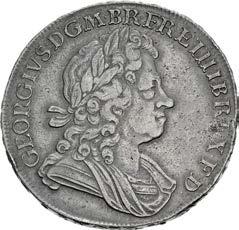
George

and


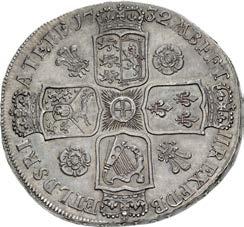
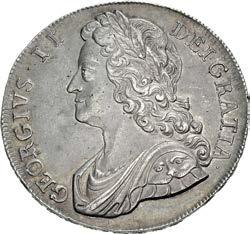
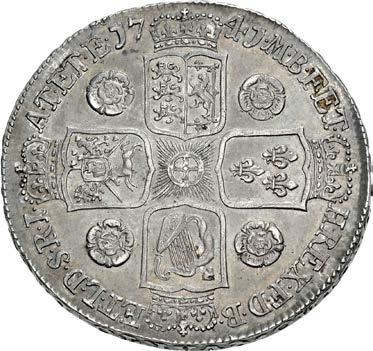

858. HANOVER. George II. 1727-1760. AR Crown. Dated 1741 and DECIMO QVARTO. Young head. Roses in angles. Bull 1666; ESC 123; SCBC 3687. Minor cabinet friction on obverse. Toned with considerable luster. Near EF. ($1500)
From the Deer Creek Collection. Ex Gainsborough Collection (Classical Numismatic Group 121, 6 October 2022), lot 1393.
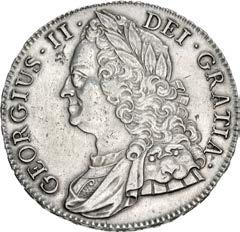

859. HANOVER. George II. 1727-1760. AR Crown. Dated 1743 and RY DECIMO SEPTIMO. Old head. Roses in angles. Bull 1667; ESC 124; SCBC 3688. Iridescent toning, slightly worn obverse die. Good VF. ($750)


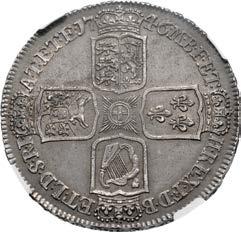
860. HANOVER. George II. 1727-1760. AR Crown. LIMA issue. Old bust. 1746 and RY DECIMO NONO. Bull 1668; ESC 125; SCBC 3689. Deeply toned with flashes of luster. In NGC encapsulation 2118473-011, graded AU 55. ($2000)
From the Deer Creek Collection. Ex Mildenhall Collection (Classical Numismatic Group Keystone Sale 5, 13 October 2021), lot 87, purchased from Spink, December 1992.



861. HANOVER. George III. 1760-1820. AV Guinea (25.5mm, 8.36 g, 6h). Early coinage. Fourth laureate head. Tower (London) mint. Dated 1777. Bull, Gold 695; MCE 382; SCBC 3728. Toned, a few light marks, traces of underlying luster. Near EF. ($500)
Ex Classical Numismatic Group Keystone Sale 11 (3 March 2023), lot 625.
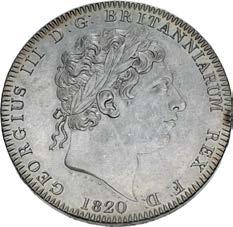

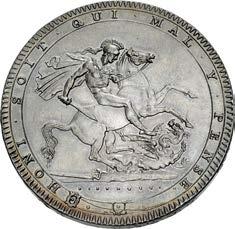
862. HANOVER. George III. 1760-1820. AR Crown (38mm, 28.08 g, 6h). Dated 1820 and RY LX. Last coinage. Bull 2016; ESC 219; SCBC 3787. Attractive iridescent toning. AU. ($750)
From the Deer Creek Collection. Ex Davissons E-Auction 29 (24 April 2019), lot 114.
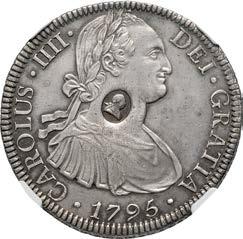

863. HANOVER. George III. 1760-1820. AR Dollar. Struck 1797. Oval countermark on a Mexico City Portrait-type 8 Reales dated 1795 Mo FM. Bull 1852; ESC 129; SCBC 3765A. Toned. In NGC encapsulation 6898697-001, graded AU 53, c/s: AU Standard. ($500)
From the Deer Creek Collection. Ex Alexander Christopher Collection; Coin Galleries (23 May 1990), lot 1755.


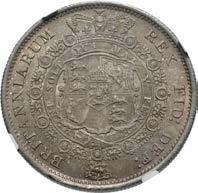
864. HANOVER. George III. 1760-1820. AR Halfcrown. Bull head type. Dated 1816. Bull 2086; ESC 613; SCBC 3788. Two small spots in obverse field. Light iridescent tone. In NGC encapsulation 2118482-001, graded MS 65+. Top Pop. An iconic portrait coin. The single highest graded by NGC. ($750)
From the Deer Creek Collection. Ex Mildenhall Collection (Classical Numismatic Group Keystone Sale 5, 13 October 2021), lot 110, purchased from Spink, March 1998.
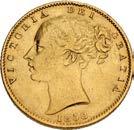
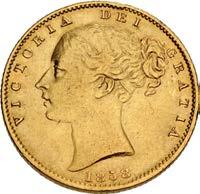
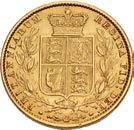
865. HANOVER. Victoria. 1837-1901. AV Sovereign (22.5mm, 7.96 g, 6h). London mint. Dated 1858. Young head coinage, second larger young head. Incomplete 5 and barred As. Marsh –; Bull, Gold –; Bentley 424 var. (As unbarred); MCE –; cf. SCBC 3852D. Attractively toned, circulation marks. Good VF. Very rare variety with the incomplete 5. ($750)
From a New Zealand Collection.
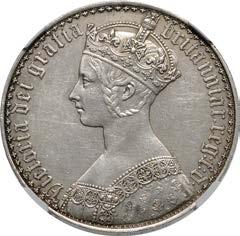
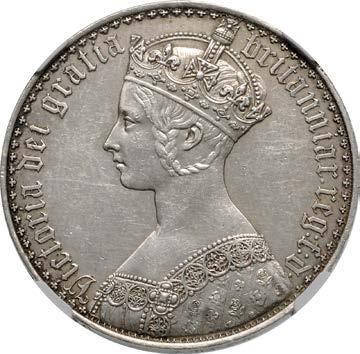
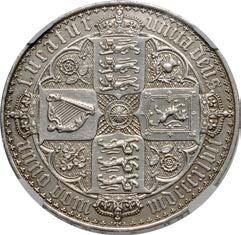
866. HANOVER. Victoria. 1837-1901. Proof AR Crown. Dated 1847 and RY UNDECIMO. Gothic type. Edge lettering, struck en medaille. Bull 2571; ESC 288; SCBC 3883. In NGC encapsulation 6889970-002, graded Proof AU Details, cleaned. ($2000)



867. HANOVER. Victoria. 1837-1901. Proof AR Crown (39.5mm, 28.25 g, 6h). Gothic type. London mint. Dually dated RY undecimo and mdcccxlvii (1847). Bull 2571; ESC 288; MCE 1158; SCBC 3883. Light iridescent toning, hairlines, polished, whizzed. Impaired proof. ($1500)
Ex M. Louis Teller inventory.


From the Deer Creek Collection. Ex Alexander Christopher Collection.

From the Alexander Christopher Collection.

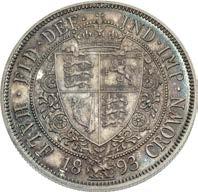

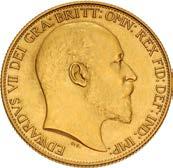

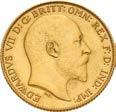

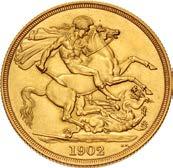

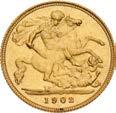
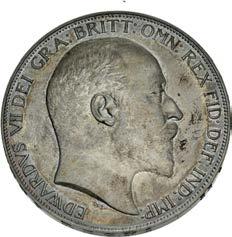
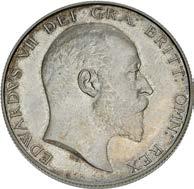





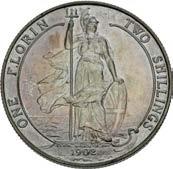

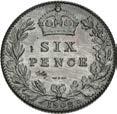
870. SAXE-COBURG-GOTHA. Edward VII. 1901-1910. Partial Matte Proof Coronation Set. Special Royal Mint issue. London mint. Dated 1902. Set consists of the following AV and AR denominations: AV Five Pounds. In NGC encapsulation 6890874-008, graded PF 61 Matte // AV Two Pounds. In NGC encapsulation 6890874-006, graded PF 62 Matte // AV Sovereign. In NGC encapsulation 6890874-007, graded PF 61 Matte // AV Half Sovereign. In NGC encapsulation 6890874-008, graded PF 61 Matte // AR Crown. In NGC encapsulation 8372843-011, graded PF 64 Matte // AR Halfcrown. In NGC encapsulation 8372843-012, graded PF 64 Matte AR Halfcrown. In NGC encapsulation 8372843-012, graded PF 64 Matte // AR Florin. In NGC encapsulation 8372843-014, graded PF 63 Matte // AR Shilling. In NGC encapsulation 8372843015, graded PF 62 Matt // AR Sixpence. In NGC encapsulation 8372843-016, graded PF 62 Matte. SCBC PS9 (for complete set). All coins PF Matte. Includes original case of issue. ($4000)
From the Alexander Christopher Collection.

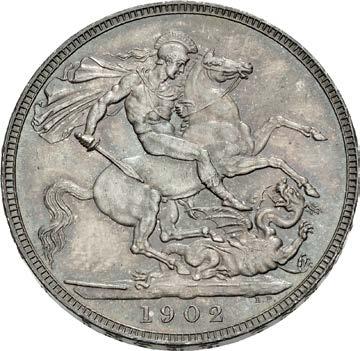
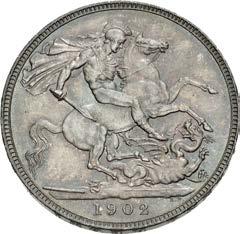
871. SAXE-COBURG-GOTHA. Edward VII. 1901-1910. AR Crown (39mm, 28.23 g, 12h). Dated 1902. Bull 3560; ESC 361; SCBC 3978. Exquisite toning, some very faint bag marks. UNC. ($500)
From the Deer Creek Collection. Ex Malthouse Collection (Classical Numismatic Group 123, 23 May 2023), lot 1100.



872. JERSEY. temp. George III. 1760-1820. Proof AR Eighteenpence Token (27mm, 6.34 g, 12h). Dated 1813. Coatof-arms / Denomination within wreath. Dalton 3; KM TN5. In NGC encapsulation 3808812-017, graded PF 64. ($750)

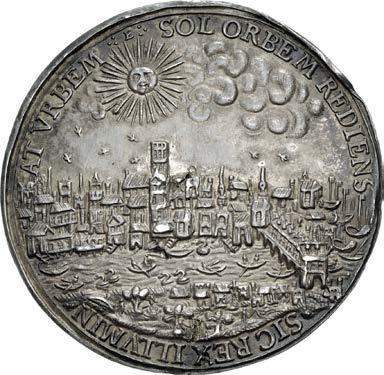

873. STUART. Charles I. 1625-1649. Cast AR Medal (41mm, 14.32 g, 11h). Return to London from Edinburgh. By N. Briot(?). Dated 1633. CAROLVS AVGVSTISS’ · ET INVICTISS’ · MAG’ · BRIT’ · FRAN’ · ET HIB’ · MONARCHA, Charles on horseback rearing left, holding baton and reins; rayed Eye of Providence above, plumed helmet below; ·:1633:· in exergue / SOL ORBEM REDIENS SIC REX ILLVMIN AT VRBEM (as the sun [illuminates] the world, returning thus the King illuminates the city), personification of the sun shining over the London cityscape. MI 266/62; Eimer 124b. Dark toning, lightly chased in fields as usual, scrapes/digs, edge bumps. EF. ($2000)
From the Deer Creek Collection. Ex Classical Numismatic Group 120 (11 May 2022), lot 1290.
End of Session 3
Banti
Please refer to our online bibliography at www.cngcoins.com for a complete listing of specialized and general references used, and abbreviations.
A. Banti. I grandi bronzi imperiali. 9 Vols. Florence. 1983-1986.
BMC Various authors. Catalogue of Greek Coins in the British Museum 29 Vols. London. 1873-1927.
BMCRE
BN
Bodenstedt
Boehringer
H. Mattingly et al. Coins of the Roman Empire in the British Museum. 6 Vols. London. 1932-1962.
J. Giard. Bibliothèque Nationale, catalogue des monnaies de l’empire romain. 3 Vols. Paris. 1976-present.
F. Bodenstedt. Die Elektronmünzen von Phokaia und Mytilene. Tübingen. 1981.
E. Boehringer Die Münzen von Syrakus. Berlin and Leipzig. 1929. Bopearachchi
O. Bopearachchi. Monnaies Gréco-Bactriennes et Indo-Grecques. Paris. 1991. Calicó
CNS
CPE
Crawford
CRI
Depeyrot
X. Calicó. The Roman avrei catalogue. 2 Vols. Barcelona. 2002.
R. Calciati. Corpus Nummorum Siculorum: la monetazione di bronzo. 3 Vols. Italy. 1983-87.
C.C. Lorber Coins of the Ptolemaic Empire. 5 vols. in 2 parts. New York. 2018 and 2025.
M. Crawford. Roman Republican Coinage. 2 Vols. Cambridge. 1974.
D. Sear The History and Coinage of the Roman Imperators 49-27 BC. London. 1998.
G. Depeyrot. Les monnaies d’or (Diocletian à Constantin I, Constantin II à Zenon). Wetteren. 1995-1996. Fischer-Bossert
Hendin
HN Italy
W. Fischer-Bossert. Chronologie der Didrachmenprägung von Tarent 510-280 v.Chr. Berlin 1999.
D. Hendin. Guide to Biblical Coins. 6th Edition. New York. 2021.
N.K. Rutter, ed. Historia Numorum. Italy London. 2001.
Kumar S. Kumar. Treasures of the Gupta Empire. A Catalogue of Coins of the Gupta Dynasty. San Francisco. 2017. Meshorer Y. Meshorer. A Treasury of Jewish Coins from the Persian Period to Bar Kokhba. Jerusalem. 2001.
MK R. Göbl. Münzprägung des Kušanreiches. Vienna. 1984.
MIR R. Göbl, et al. Moneta Imperii Romani. 5 Vols. Vienna. 1984-present.
Price
M.J. Price. The Coinage in the Name of Alexander the Great and Philip Arrhidaeus London. 1991. Prieur M. Prieur A type corpus of the Syro-Phoenician tetradrachms and their fractions from 57 BC to AD 253. Lancaster. 2000.
RIC H. Mattingly, et al. The Roman Imperial Coinage. 10 Vols. London. 1923-1994.
RPC A. Burnett, et al. Roman Provincial Coinage 10 Vols. London and Paris. 1992-present.
RSC D. Sear, et al. Roman Silver Coins. 5 Vols. London. 1978-1987.
SC A. Houghton & C. Lorber. Seleucid Coins: A Comprehensive Catalog. 2 Parts. Lancaster. 2002 and 2008. Sellwood D. Sellwood. An Introduction to the Coinage of Parthia 2nd edition. London. 1980.
SNG ANS Sylloge Nummorum Graecorum, American Numismatic Society. New York. 1969-present.
SNG BM Black Sea Sylloge Nummorum Graecorum, British Museum, 1: The Black Sea. London. 1993.
SNG Copenhagen Sylloge Nummorum Graecorum, Danish National Museum. Copenhagen. 1942-1979.
SNG BN Sylloge Nummorum Graecorum, Cabinet des Médailles, Bibliothèque Nationale. Paris. 1993-2001.
SNG Kayhan Sylloge Nummorum Graecorum, Turkey 1: The Muharrem Kayhan Collection Istanbul. 2002.
SNG Levante Sylloge Nummorum Graecorum, Switzerland; E Levante - Cilicia. Bern. 1986.
SNG Lloyd Sylloge Nummorum Graecorum, Lloyd Collection. London. 1933-1937.
SNG Lockett Sylloge Nummorum Greacorum, Lockett Collection London. 1938-1949.
SNG München Sylloge Nummorum Graecorum, München Staatlische Münzsammlung. Berlin. 1968-present.
SNG von Aulock Sylloge Nummorum Graecorum, Sammlung Hans Von Aulock. Berlin. 1957-1968.
Starr C. Starr Athenian coinage 480-449 BC London. 1970. Svoronos J. Svoronos. Τὰ
. Athens. 1904-08. Traité E. Babelon. Traité des monnaies grecques et romaines. 9 Vols. Paris. 1901-1932.
Weidauer L. Weidauer. Probleme der frühen Elektronprägung. Fribourg. 1975.
Album S. Album. A Checklist of Popular Islamic Coins. 3rd ed. Santa Rosa. 2011. Biaggi E. Biaggi. Monete e zecche medievali italiane dal seculo VIII al seculo XV. Torino. 1992. Bitkin V. Bitkin. Composite Catalogue of Russian Coins. 2 vols. Kiev. 2003.
BMC Vandals W. Wroth. Catalogue of the Coins of the Vandals, Ostrogoths and Lombards and of the Empires of Thessalonica, Nicaea and Trebizond in the British Museum. London. 1911. (Reprinted as Western and Provincial Byzantine Coins in the British Museum.) CIS S. Goron and J.P. Goenka. The Coins of the Indian Sultanates. New Delhi. 2001. CNI Corpus Nummorum Italicorum. 20 Vols. Rome. 1910-1943. Davenport J.S. Davenport. Various works on European crowns.
ESC H.A. Seaby & P.A. Rayner. The English Silver Coinage from 1649. London. 1992. Friedberg R. Friedberg. Gold Coins of the World. 8th ed. Clifton. 2009.
KM C.L. Krause & C. Mishler Standard Catalogue of World Coins Krause Publications. Iola. Levinson R.A. Levinson. The Early Dated Coins of Europe. Clifton, NJ. 2007. Lunardi G. Lunardi. Le monete delle repubblica di genova. Genoa. 1975.
MEC P. Grierson & M. Blackburn. Medieval European Coinage Cambridge. 1986.
MIB W. Hahn. Moneta Imperii Byzantini. 3 Vols. Vienna. 1973-81.
MIBE W. Hahn and M.A. Metlich. Money of the Incipient Byzantine Empire. Vienna. 2000.
MIR Various. Monete Italiane Regionali. 5 Vols. Pavia. ND.
NM G. Depeyrot. Le numéraire mérovingien. 5 vols. Wetteren. 1998-2001. North J.J. North. English Hammered Coinage. 2 Vols. London. 1963, 1975.
SB D. Sear, et al. Byzantine Coins and Their Values. 2nd edition. London. 1987.
SCBC Standard Catalogue of British Coins. London. Annually.
SCBI Various authors. Sylloge of the Coins of the British Isles.



